The Technological History of Broadcasting
This web page supplements the book, Grass Valley; How a small town changed television and tells the story of television, broadcasting, and video (and audio), or media as it is generally known today, before Grass Valley came along.
The book itself tells the story of how a small company, named after a small town, greatly changed the trajectory of media.
The book answers two questions
- Why do most people who work in the television industry know the name of this small town in California, even though most do not know it is a place?
- Why did a fairly large international company, based in Montreal Canada take the name of a small town in northern California?
Anywhere you see this symbol there is a reference in the book to that subject.

Click on the symbol to find the next instance.
There are links throughout the page to take you to more information on the topic. Some section titles also send you to additional information on that subject.
Here is the story of broadcasting, leading up to a gold mine owner, an early electronic and Silicon Valley pioneer, and finally another electronic entrepreneur serendipitously putting a small town at the center of TV development.
The story told on this web page could have the title
To No One In Particular.
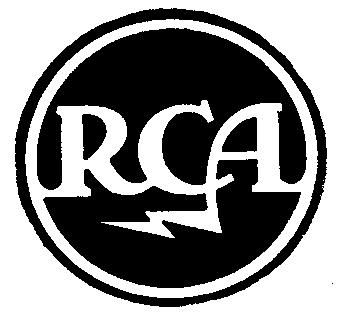
If RCA does not make it, we don't need it!
Television development had been going on for 80 years when the Group started toying with the idea that there was room for a new upstart to get into television. The industry in the 1960's had an 800 pound gorilla, the Radio Corporation of America, RCA. Many a Chief Engineer in a TV station at the time literally had a "If RCA doesn't make it, we don't need it" mentality. As we will see even though RCA had the heft to mold the industry, it also had a problem with many in the industry. We will look at that in a bit.

Anywhere you site this link, click on it and it takes you to a great RCA Television archive site. Since RCA plays a predominant part in this story you will find this link in a number of places throughout this page.
Along with this link there are a number of other links on this page that go to different pages on the
oldradio.com
website
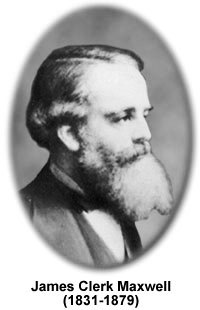
Vacuum tube development, which would also produce the cathode ray tube (CRT) started in the 1870s. Earlier than that, during the later days of the American Civil War, an English scientist, James Clerk Maxwell worked out a series of recursive equations that predicted the propagation of radio waves through space.
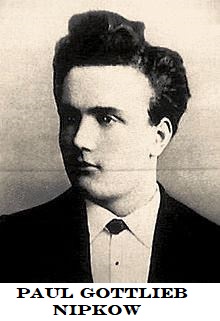
In 1884 Paul Gottlieb Nipkow, a 20-year old university student in Germany, patented the first electromechanical television system which employed a spinning disk with a series of holes spiraling toward the center, that scanned a scene for
rasterisation.
Very crude, but a line of television research which would continue for almost 50 years. Spinning disks made a final appearance as late as the early 1950s in an early approach for producing color television, as we will see.
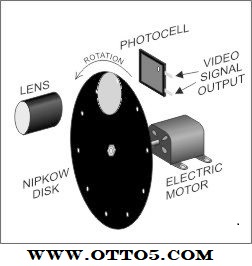
Nipkow spinning ("flying") disk
Radio was in the laboratories in the 1880s, with Marconi famously deploying it out into the world in the 90s. By 1902 he had successfully broadcast radio signals across the Atlantic.
Talking motion pictures, which would come to be an important phase of television was first demonstrated in 1910 by Thomas Edison. Before that in 1899 Valdemar Poulsen invented the first magnetic recordings - using magnetized steel tape as recording medium. A technology that Dr. Hare
 would not get involved with for another 50 years.
would not get involved with for another 50 years.
A couple of years after Marconi's trans-Atlantic transmission, in 1904
Nikola Tesla
wrote that a receiving device "will be very efficient in enlightening the masses, a cheap and simple device which might be carried in one's pocket" and set up to catch signals in the atmosphere. This was the year that
Charles Litton
 was born, three years before
Donald Hare's
birth, two important characters in the Grass Valley story.
was born, three years before
Donald Hare's
birth, two important characters in the Grass Valley story.
U.S. Early Radio History
The U.S. early on was assigned several letters as the start of their radio call signs by the international organizations of the day. Two of those were K and W. Since ship radio communications took hold a little sooner it was soon settled on that the shore stations, which were west of ships in the Atlantic would start with W. When broadcast radio stations started signing on, they also received call letters starting with W, such as WABC, WEWS, WBZ, etc. So, it was decided that the KApos;s would be assigned to stations in the west. Thus, ships in the Pacific were also assigned W's. Today stations east of the Mississippi start with W's, and west starts with K's. Yes, there are exceptions as the K and W border was originally closer to the Rocky Mountains before being moved east to the river. Other exceptions are due to stations moving and simply mistakes when the call letters were handed out. Noticeable ones include one of the first radio stations,
KDKA
in Pittsburgh.
(Everything you could possibly want to know about call letter history)
Before broadcasters became dominant on the radio landscape, it was not only ships that looked to use this new technology. One early pioneer of radio was
United Fruit Company, as they found radio to be a more reliable way of communicating with their plantations in South America.
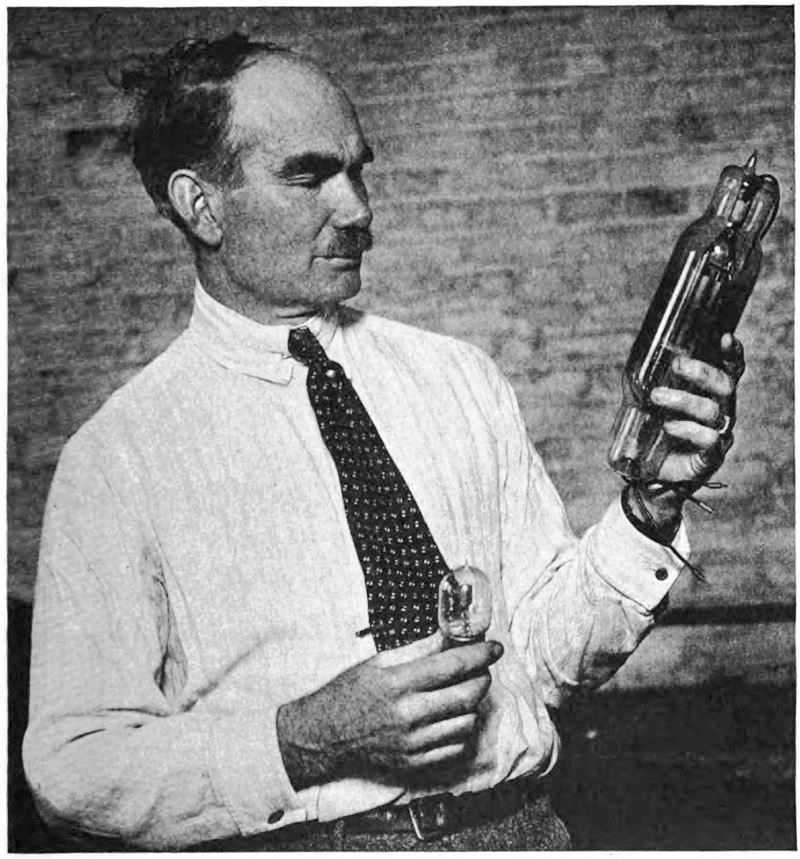
Lee de Forest
The inventor admiring an example of a vacuum tube, known as an
Audion
at the time.
While thermionic emission, the basic principle of the vacuum tube was known in the 1870s, it was not until 1907 when Lee de Forest is credited with the invention of the
Triode tube
. This could take very weak signals and amplify them.
An early experimenter, known as the "Highbridge station", was an experimental station located in New York City and licensed to the De Forest Radio Telephone and Telegraph Company from 1915-1917, interrupted by the war and started up again after the war. So, others were developing the concept also.
In 1916 the Highbridge station became the first radio station employing a vacuum-tube transmitter, instead of the spark-gap or alternator types, to make news and entertainment broadcasts on a regular schedule. On November 7, 1916, it became the first to broadcast U.S. presidential election returns by spoken word instead of Morse code.
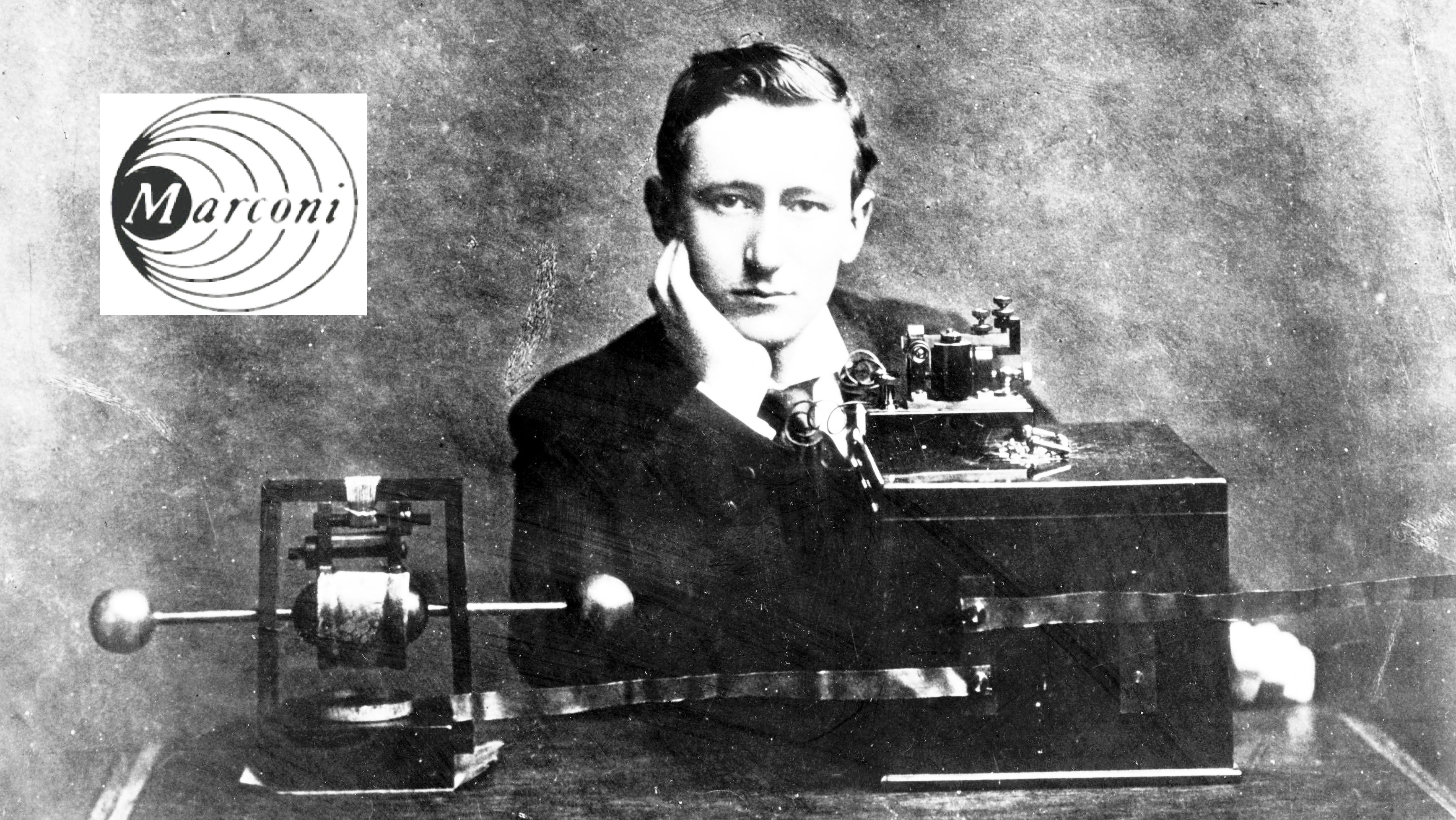
Guglielmo Marconi
The inventor with an early transmitter of his design. His company's logo is in the upper left.
Having been born into a wealthy family, Marconi studied privately with a series of tutors instead of attaining a formal education in science. One of his mentors was physicist Augusto Righi, who taught Marconi about German physicist Heinrich Hertz's early research confirming the existence of electromagnetic waves, a.k.a. radio waves. He got his first radio patent in Britain in 1897. He was only 22.
In 1903 Marconi on behalf of President Theodore Roosevelt sent a message across the Atlantic to King Edward VII of England. This was the first successful transmission of a complete message. In 1909 he shared the Nobel Prize with German physicist Karl Ferdinand Braun, who is widely credited with inventing the cathode ray tube, the basis for television displays in the future.
Marconi's company, headquartered out of Britain, had a subsidiary in the U.S. After the end of the war the US government, pushed by future President, then Assistant Secretary of the Navy, Franklin D. Roosevelt, claimed that radio was too critical to the countries defensive effort to let the American subsidiary of a foreign country control as much of the technology as American Marconi did. The US forced Marconi to divest itself of its US subsidiary in 1919.
Thus, the Radio Corporation of America, or RCA originated as a reorganization of the Marconi Wireless Telegraph Company of America. It was made a subsidiary of GE, Westinghouse, and a couple other companies. RCA retained most of the American Marconi staff. The RCA Corporation was to become a major American electronics company.
After World War I Marconi became enamored with
Benito Mussolini. Mussolini appointed Marconi President of the Royal Academy of Italy, which had a nationalist, anti-Semitic bent. He dutifully would not allow any Jewish scientists to become members of the academy.
When Marconi died in 1937 from a series of heart attacks at the age of 63, the Italian government gave him a state funeral. Regrettably, many in the crowd raised their arms in the fascist salute as the horse-drawn hearse went by, acknowledging Marconi's political leanings.
In October 1920 with the gaining popularity of a station on top of Westinghouse's plant in East Pittsburgh,
Westinghouse
starts to think about broadcasting. Westinghouse wonders if radios biggest liability, its lack of secrecy, could be its biggest asset. At that time Westinghouse backs the vision of a station that broadcast regularly scheduled programs. Westinghouse decided that the cost of operating the station was more than made up by its sales for a stepped-up demand for radio parts that they made.
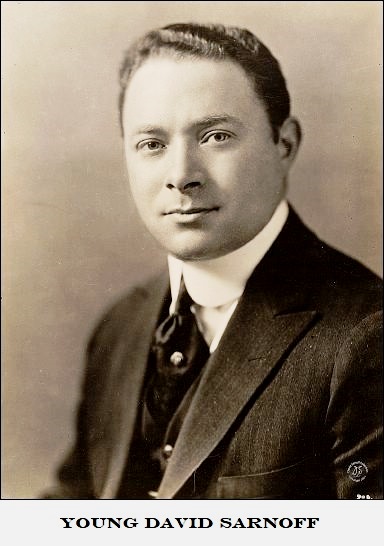
David Sarnoff
David Sarnoff was another prolific mover and shaker when it came to the development of television. His hand touched many of the technologies that were invented and implemented that shaped how the industry developed. He worked for what became RCA his entire adult career, starting as an office boy with Marconi America, soon moving up to a telegraph operator. He appeared to have a central role in monitoring and passing messages on during the Titanic disaster. He kept climbing the RCA latter as the company grew and eventually became its long serving president. He never owned a share of RCA stock.
He claimed that in 1914 when he was only 23 years old, he had started pushing his "Radio Music Box" as his distractors would come to call it. He was one of several people in the industry endorsing the idea of using radio to entertain and educate the masses. Up until then radio was used for point to point, one on one communications, mainly for ship to shore messaging, using Morris code at first.
To No One in Particular
Radio to Sarnoff was not just for point to point, a wired path substitute, but for everyone to listen in on, with its inherent lack of privacy. He predicted that radios for the home could be sold for $75 apiece. Not affordable to many at the time though, as that would be worth almost $1,900 today.
He was not one to needlessly give anyone else publicity and tended to let people think all the ideas he presented were his. He continued to push the idea within the halls of Marconi America (before it became part of RCA). WWI interrupted any thought of such a device.
At the beginning of RCA's formation out of Marconi not a word was said, forthrightly, about broadcasting; even at the end of 1919 its business potential was underrated or ignored, except by Sarnoff. In 1920 Sarnoff again pushed his Radio music box idea. But imminent as it was, with several stations experimenting with broadcasting their own signal, few within the company could discern its value yet. The internal push back continued and soon this idea comes to be known as "Sarnoff's Folly." Still Sarnoff pushed. In a letter he wrote to E.W. Rice Jr, the president of GE at the time, he predicted a million units sold in the 1st three years.
Even at the end of 1920 RCA continued to concentrate on its telegraphy messaging business as it then was handling a million words a month in overseas traffic. Still that year Sarnoff asks the RCA Technical Committee for $20,000 to build a Music box prototype, he is given $2000.
At one-point RCA felt that Sarnoff was pushing the concept entirely too enthusiastically. Sarnoff was called in to RCA's President E.J. Nally's office and told to drop his "music box" concept, claiming that the wireless music box had no imaginable commercial value, and who would pay for messages sent to no one in particular?
GE, abetted by people in Westinghouse, commissioned a study by an academic business specialist on broadcasting's potential. After a few months, the study's recommendation was that the expectations aroused by broadcasting were madly exaggerated, and that it was crawling with economic bugs and would never pay off. The final recommendation was that Sarnoff be fired. Sarnoff surmised that it was Westinghouse and GE's attempt to stop RCA from reaping most of broadcasting's benefits. Sarnoff met with Owen Young, chief consul and soon to be GE's President, at Delmonico's on Wall Street, in a private room and from 8 pm to midnight Sarnoff made his case. Supposedly Young tossed the report when he got back to his office.
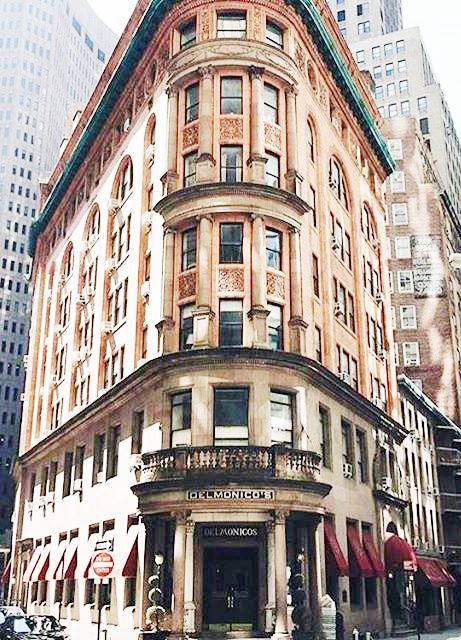
Delmonico's on Wall Street
Where Sarnoff pleaded his case for his "music box" and his job.
That next year, in 1921, RCA radio set apparatus sales were $1.5 million. In retrospect, given the speed with which consumer radio receiver sales spread across the U.S. beginning in 1922, Sarnoff's reference in the memo to about 7% of U.S. families buying radio receivers turned out to be extremely conservative. In 1922 RCA sells $11 million worth of radio sets, mainly their "Radiola." The year after sales doubled, and the year after that it did so again. By the end of 1923, 2.5 million receivers were tuned to 523 stations in the U.S. By 1924 RCA had 9 broadcast radio stations under its direction. By 1929 RCA had sold $176 million of radio sets and netted a profit of $15.8 million. By the end of the 20s total radio industry revenue equaled $1 Billion, and 40% of American homes had a radio. The adoption of radios in the home would rival any tech adoption since.
RCA is Created out of Marconi America
History of RCA


The Radio Group
In 1921 the Radio Group consisted of GE, who owned 30% of RCA, Westinghouse with 20%, AT&T 10%, United Fruit Company 4%, and remaining 36% owned by others. Westinghouse's success with KDKA and the fact that they had bought up many radio patents made them an attractive partner.
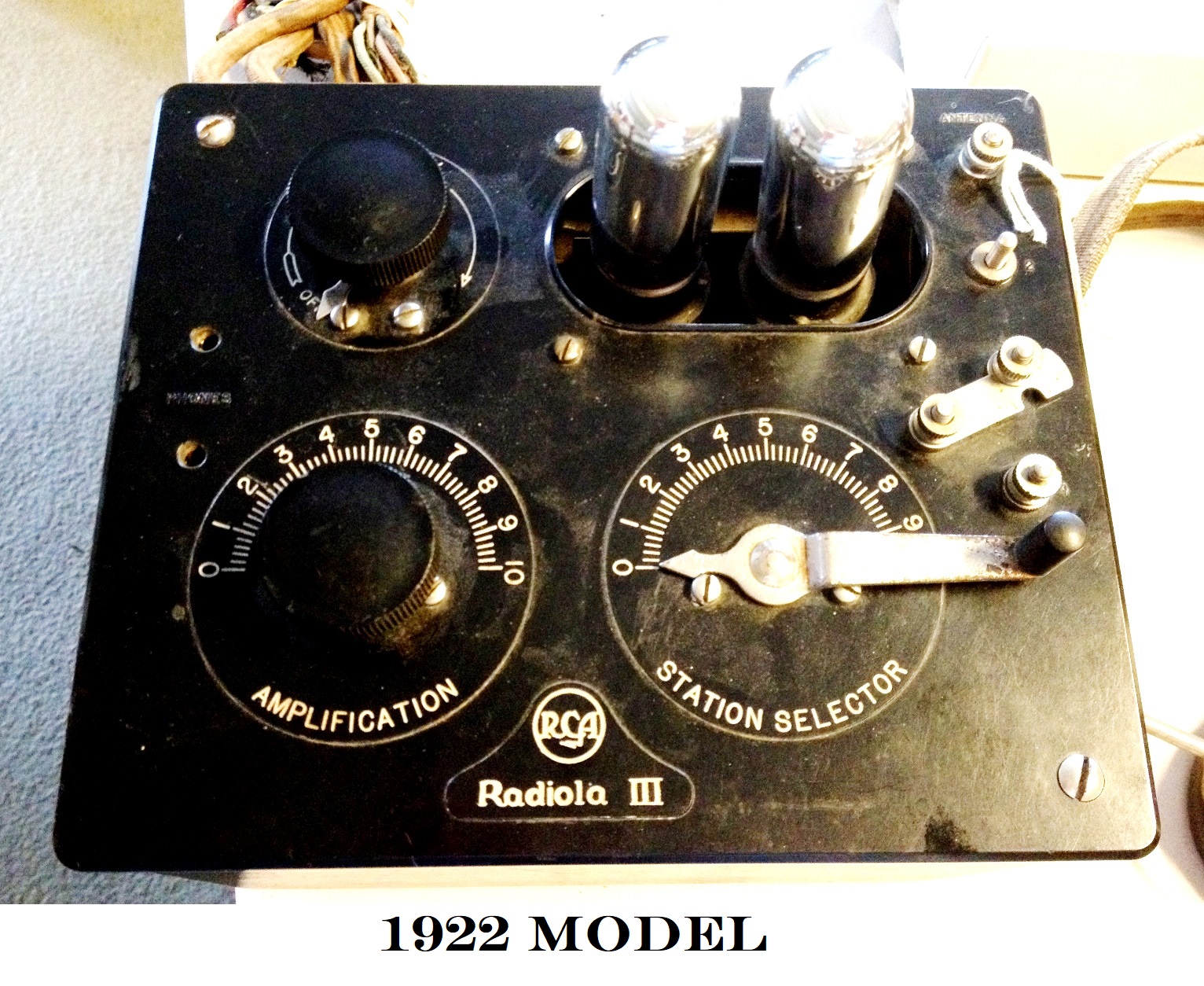 Early RCA Radio Broadcasting Receiver
AKA: "Music Box"
Early RCA Radio Broadcasting Receiver
AKA: "Music Box"
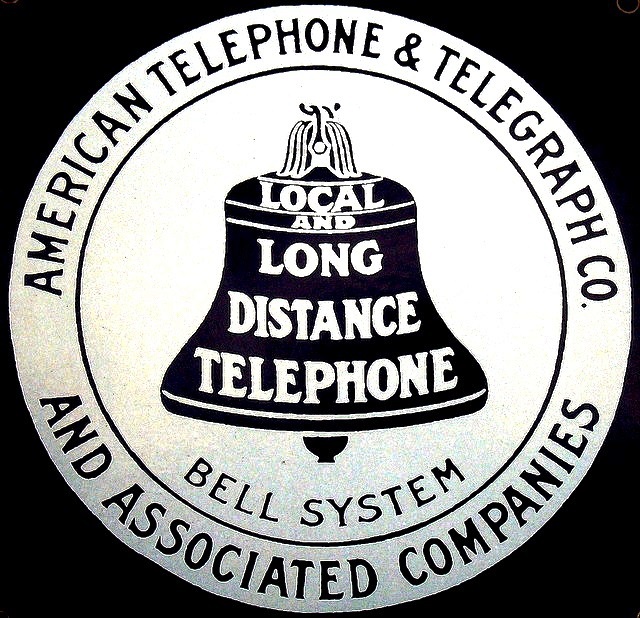 In July of 1926 AT&T and RCA signed an agreement in which, for one million dollars, the Bell system turned over its radio facilities (including station WEAF in NYC) to RCA and withdrew from broadcasting. It also gave up its rights to manufacture receiving sets to RCA. In return RCA agreed to use the Bell wires exclusively and not compete with the telephone company for telephone business.
In July of 1926 AT&T and RCA signed an agreement in which, for one million dollars, the Bell system turned over its radio facilities (including station WEAF in NYC) to RCA and withdrew from broadcasting. It also gave up its rights to manufacture receiving sets to RCA. In return RCA agreed to use the Bell wires exclusively and not compete with the telephone company for telephone business.
Now a very convoluted period occurs between RCA and its partners. In October 1927, the RCA board of directors, at the request of Sarnoff, had recommended that RCA be provided with its own separate manufacturing unit to which GE and Westinghouse Electric would transfer elements of their radio facilities and staff. A joint committee between the companies in April 1928 recommended the consolidation in principle but put a ceiling of $25 million on RCA production.
To get around this limitation Sarnoff convinced RCA in 1929 to buy Victor Talking Machine Company of Camden, New Jersey for $154 million. The purchase not only entailed the vast manufacturing plants in Camden that Sarnoff had long coveted but also principle interest in the Victor Talking Machine Company of Japan and the Gramophone Co Ltd of Great Britain which had affiliated with the Victor company. Victor also had a well-organized system of distributors and dealers. Sarnoff became a director of Gramophone in March of 1929. Now the various partners started cross assigning each other's patents. It was believed that this would facilitate growth across the whole industry.
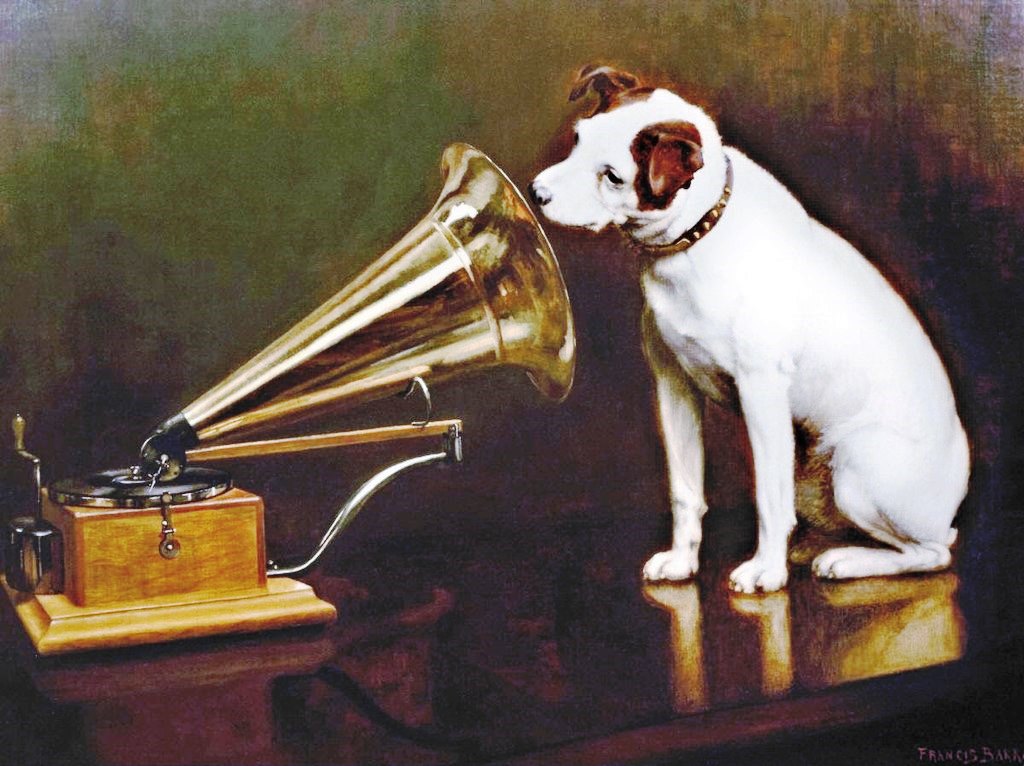
His Master's Voice
In England, artist Francis Barraud (1856-1924) painted his brother's dog Nipper listening to the horn of an early phonograph during the winter of 1898. Victor Talking Machine Company began using the symbol in their trademark, His Master's Voice, in 1900, and Nipper joined the RCA family in 1929.
Victor Camden Campus which became RCA's main campus
Victor building today (Condos)-but not all campus buildings have fared so well
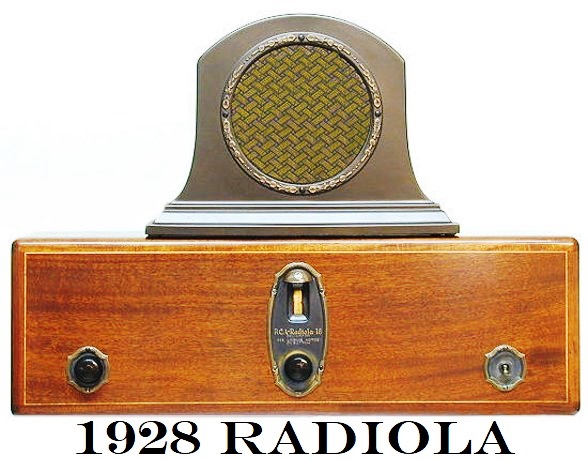
While Sarnoff had little interest in the Victor's talking machine, he made immediate plans to begin the manufacture of RCA radio sets at Victor's Camden facilities. The Victor company became the "Victor" part of RCA Victor, for those of you old enough to remember the full name.
1930 was monumental for RCA. Sarnoff, an immigrant from Russia at a young age, had started at the bottom of the American Marconi company, had carried on his meteoric rise in RCA and that year became the 3rd CEO of RCA and NBC at age 39.
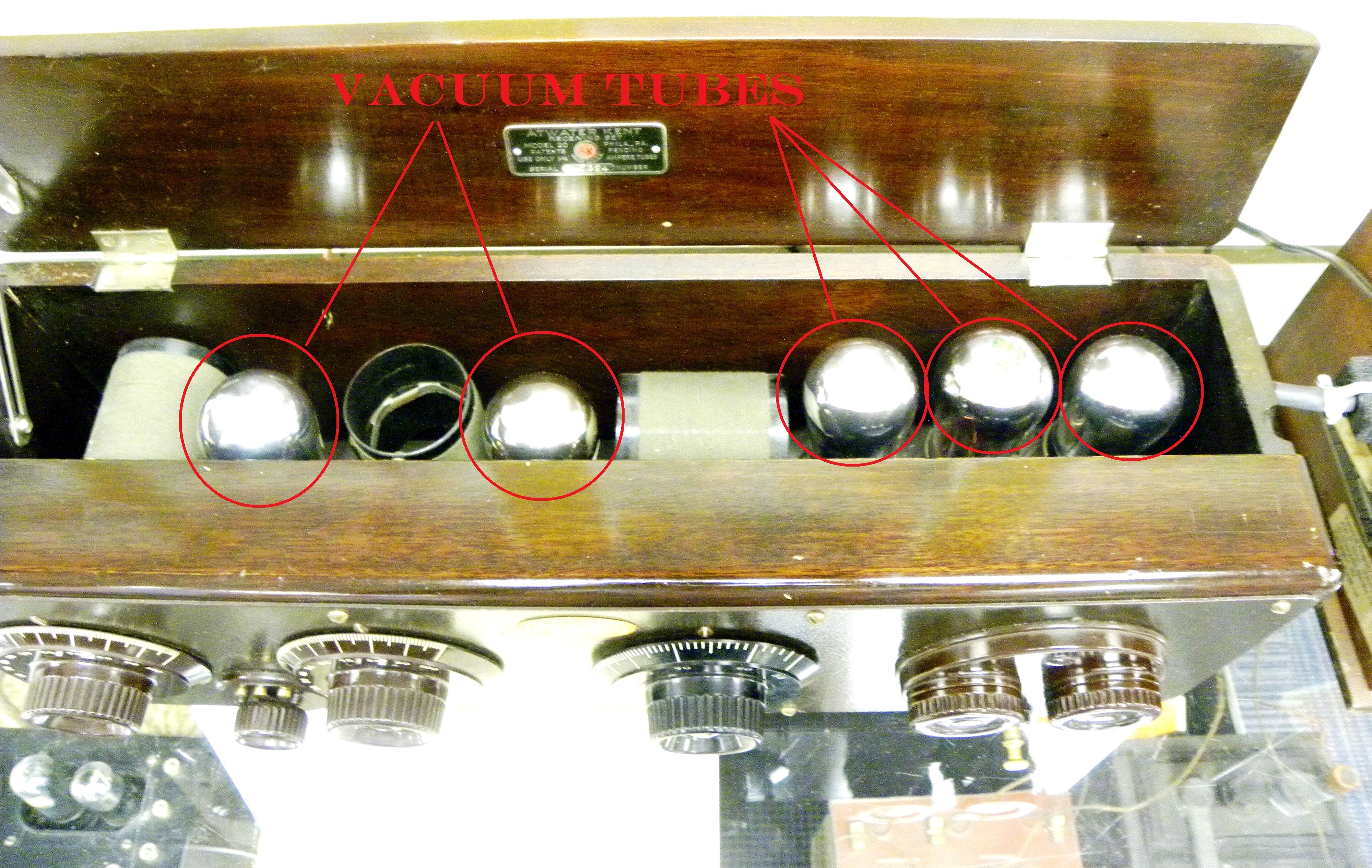
By May 1930 the unification of RCA was under way. Westinghouse and GE were reduced to partners, having large stock ownership and powerful representation on the Board of Directors. But Sarnoff's desire for complete independence came unexpectedly with the aid of the US government. That month the Department of Justice filed an antitrust suit against RCA, GE, Westinghouse, and AT&T. It wanted the prior agreements scrapped, the patent pools the companies had compiled disassembled and all exclusive contracts, both home and abroad made nonexclusive. Furthermore, the DOJ required that the four corporations compete with each other in the production and sales of radio and other electrical equipment.
With the depression deepening this could have been fatal to RCA. As a testament to his negotiating ability, Sarnoff was able to reach a satisfactory agreement with the government. In November 1932, the parties agreed to a consent decree in the government's antitrust suit. RCA kept everything it gained through unification while winning complete freedom from GE and Westinghouse. However, GE's influence was still strong as most of the RCA executives and managers had come from GE.
The year 1930 had another major impact on RCA's direction. The earnest development of all-electronic television got underway. Sarnoff was initially assured that a working system could be delivered for $1 million. Nine years later when the system was being introduced to the public that cost was 50 times that amount. But RCA's bread and butter product, AM radio still needed additional refinements. Sarnoff called Edwin Armstrong (more on him shortly) into his office and told him to fix the noise problem that AM naturally presented.
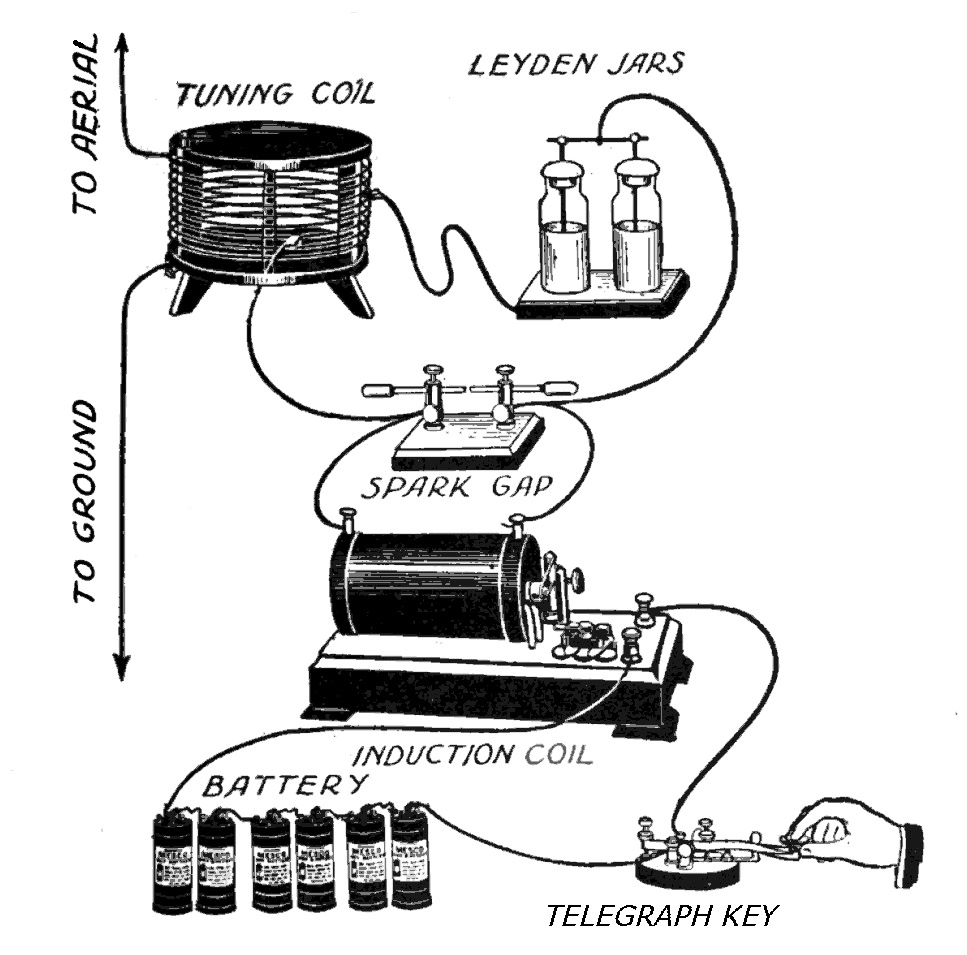
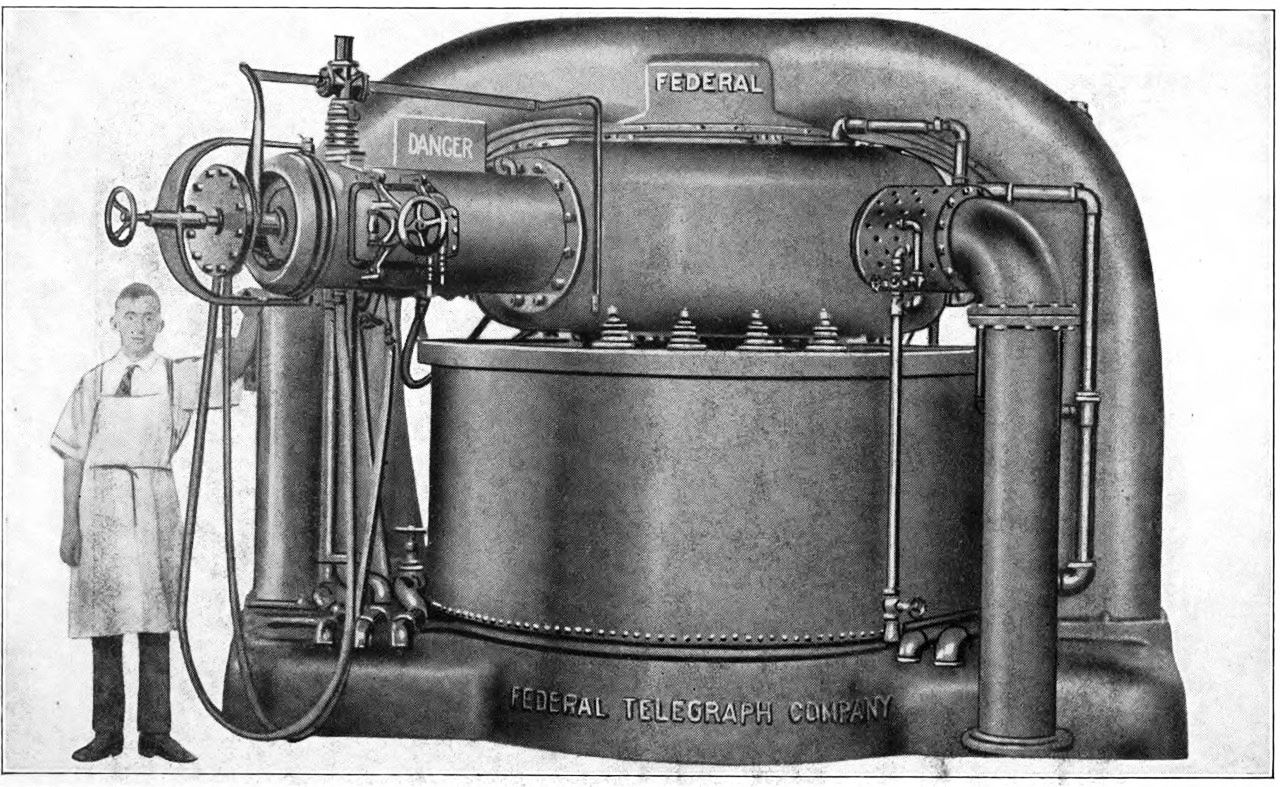
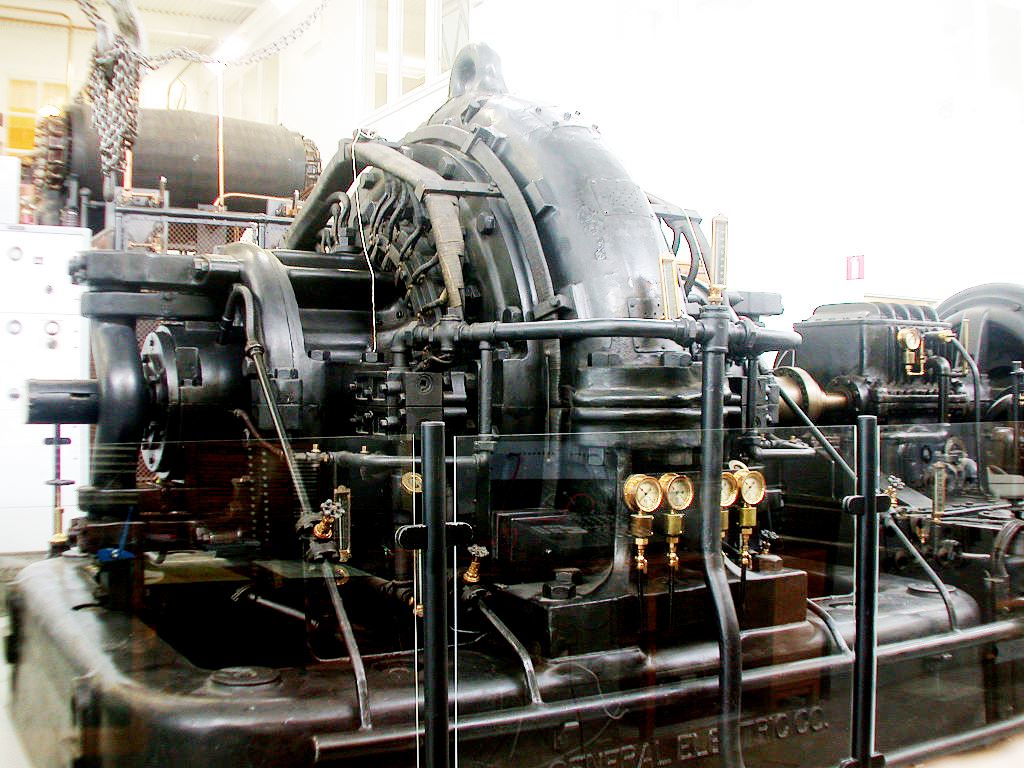
Early Radio Transmitters
Early radio transmitters were not really electronic, and actually more electrical. The one on the left was the earliest approach. A telegraph key, or switch, would be closed by the operator and the closed circuit would allow an inrush of current to build up a magnetic field around the coil, and also charge the Leyden Jars (capacitors) until an arc is produced which shorts the circuit. The capacitors then discharge and the magnetic field collapses in the coil. When all is discharged the process starts again. This process would occur thousands of times a second. This would generate a continuous wave carrier. The frequency of the carrier is based on the values of the coil and Leyden jar, and the width of the gap. This cyclic process results in a carrier being induced into an aerial.
The other two devices are electro-mechanical in nature. They are actually large alternators or power generators that are designed to output very high frequencies instead of the 50 or 60 cycle that generators in power plants do. Again the output from these devices were not fed into power lines but sent to an antenna.
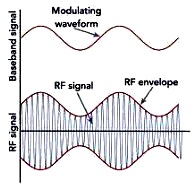
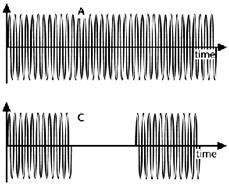
CW - Continuous Wave
Soon, as we will see, beside continuous steady waves technology allowed sound
to modulate the amplitude. AM!

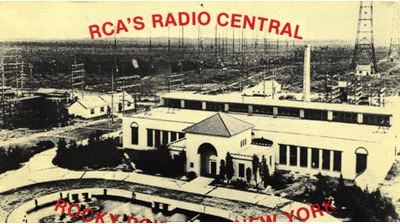
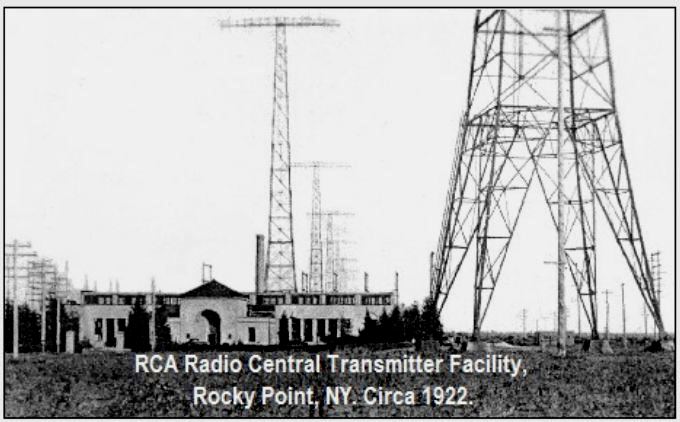
RCA Radio Central - Rocky Point on New York's Long Island - Early 20s
While never completely built out as depicted on the left, never-the-less, what was built was huge! It was opened in 1921. The transmitting facility at
Rocky Point, the world's most powerful transoceanic radio facility at the time, was connected to a receiving facility in Riverhead,
which was about 24 kilometers away near the tip of Long Island through a system of relays using existing telephone lines. The two locations worked with the Central Traffic Office in New York City to send and receive messages.
Why were the transmit and receive sites so far apart? Receive technology was such that at the time the transmit signal would totally swamp any incoming signals.
The towers extended out from the central transmitter building in connected rows, connected together, and looked like giant electric high voltage power transmission lines. The rows pointed towards the direction that the signal was intended to be concentrated towards.
On 5 November 1921, U.S. President Warren G. Harding sent a historic radio message using Radio Central's transmitters. His message was sent via telephone lines from the White House to the facility. Acknowledgments of the message were received from Australia, Japan, and 15 other countries.
Armstrong
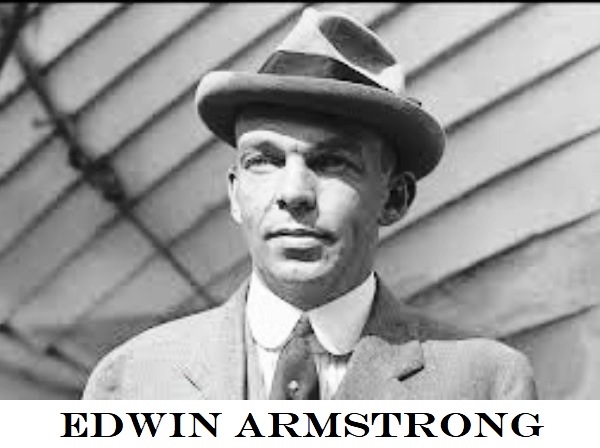
One of the most prolific American inventors in broadcasting was Edwin Howard Armstrong. Born towards the end of 1890, at the age of eight, he got rheumatic fever, which lead to Sydenham's chorea, a serious neurological disorder. From then on he was afflicted with a physical tic exacerbated by excitement or stress. Due to this illness, he withdrew from public school and was home-tutored, which led him to become socially withdrawn.
Early on Armstrong showed an interest in electrical and mechanical devices. He also developed a taste for heights, and even constructed a makeshift backyard antenna tower. He even had a boson's chair for hoisting himself up and down its height, often to the consternation of the neighbors. He had a workshop in the attic of his parents' house.
In 1909, Armstrong started attending
Columbia University
in New York City. Armstrong challenged conventional wisdom and was quick to question the opinions of both professors and peers. Here he concentrated on subjects that interested him and was sometimes indifferent to his other studies. He came to value the practical over the theoretical, reasoning that experimentation produced more results than pure mathematical and physics calculations.
Armstrong graduated from Columbia in 1913, with a degree in electrical engineering. The following year he was appointed for one year as a laboratory assistant at Columbia for $600. There after he worked as a research assistant for the college, for a salary of $1 a year. He used his position and the school's facilities to his advantage. He never worked for an outside company. He self-financed his research and development laboratory at Columbia. Many of his patents he owned outright.
Before he graduated he was instrumental in developing a "
regenerative circuit
." This used feedback to greatly increase the amplification possible using vacuum tubes. Enough so that a radio could use speakers instead of only headphones. While de Forest had invented the three element vacuum tube (triode) known as a Audion at the time, he did not understand how it worked very well. Armstrong performed demonstrations and wrote papers on the circuit's operation the year he graduated. It was at this time that Armstrong met Sarnoff.
While de Forest initially dismissed Armstrong's findings, in 1915 he filed a series of competing patent applications that largely copied Armstrong's claims, claiming he had discovered regeneration first. This resulted in an interference hearing to discover the true inventor. After the war ended a long legal battle commenced and Armstrong began selling license to his patent to finance the effort. A series of court cases ensued, at times supporting Armstrong, and in the end siding with de Forest. The Institute of Radio Engineers continued to believe that Armstrong was the actual inventor.
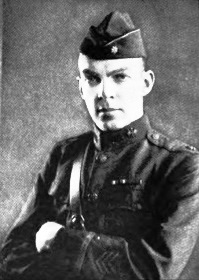 Armstrong served in the Signal Corps during World War I, initially commissioned as a captain and left as a major. During both world wars, Armstrong gave the US military free use of his patents. In 1934, he received an appointment as a Professor of Electrical Engineering at Columbia, a position he would hold the remainder of his life.
Armstrong served in the Signal Corps during World War I, initially commissioned as a captain and left as a major. During both world wars, Armstrong gave the US military free use of his patents. In 1934, he received an appointment as a Professor of Electrical Engineering at Columbia, a position he would hold the remainder of his life.
Between the end of the "great" war and his appointment at Columbia, he greatly influenced RCA. Armstrong took a keen interest in the "
super-heterodyne
" receiver circuit. This was based on frequency mixing to convert a received signal to a fixed intermediate frequency. This would greatly simplify radio design. But once again the patent he was awarded was challenged by Lucien Levy of France who had been awarded French patents in 1917 and 1918, covering some of the same basic ideas used in Armstrong's superheterodyne receiver. Again Armstrong eventually lost the battle.
But RCA did not find Armstrong's battle with Levy after he approached RCA about superheterodyne a hindrance. That was because of extensive cross-licensing agreements signed in 1920 and 1921 between RCA, Westinghouse and AT&T which meant Armstrong could freely use the Levy patent on behalf of RCA. The patent battle dragged on until 1928, when the courts determined all Armstrong's claims were invalid.
That aside, Armstrong's knowledge became very useful to RCA. While early Superheterodyne sets were considered complicated and hard to setup, Armstrong guided RCA engineers in getting receivers using this circuitry to market, which launched in 1924.
In fighting the Superheterodyne patent suits, Armstrong stumbled upon the super-regeneration phenomena, where, by rapidly "quenching" the vacuum-tube oscillations, he was able to achieve even greater levels of amplification. Like the initial regenerative circuit, it used positive feedback also, but in a way that the gain is controlled so that the circuit does not break out into oscillation.
This invention was not contested by others, and in 1922 he sold it to RCA for $200,000, plus 60,000 shares of RCA stock (another 20,000 were thrown in for consulting services). RCA originally thought that this circuit could be used to power receivers until the Superheterodyne approach could be developed enough to be put to use. But as it turned out the super-regeneration circuitry was not selective enough to be used in radio receivers, and as mentioned Armstrong and company ironed out the Superheterodyne issued first.
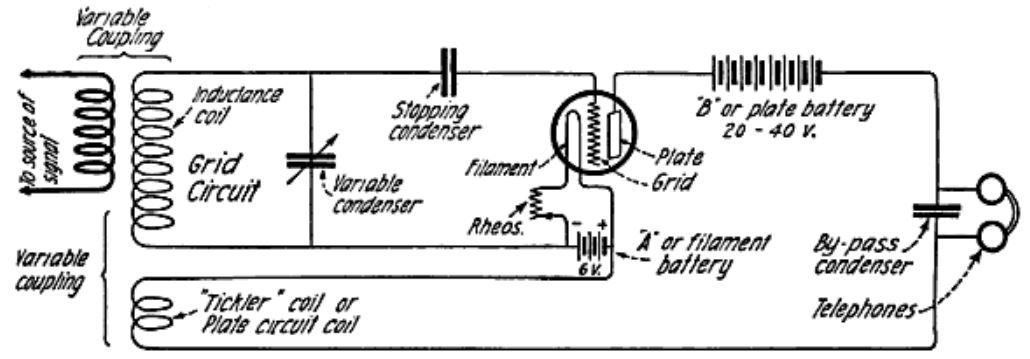
Super-regeneration
Super-regeneration uses the positive feedback of regular regeneration but Armstrong added a second oscillator circuit at a higher frequency to the signal to be recovered. This second signal interrupts the normal amplified signal or quenches it. This provides an extra kick in initial amplified signal strength for the desired signal and provided gain of over a million times. Low pass filtering eliminates the desired signal's interruptions.
How about FM instead?
Toward the end of the roaring 20s, and as AM was becoming entrenched in many American households, a couple other new things were gaining momentum. One was the concept of all-electronic television. Up until then the efforts were a combination of mechanical, and electronic (actually more electrical) contraptions. We will take this up shortly.
Also becoming more than a laboratory curiosity was FM.

AM verses FM
AM, which is short for Amplitude Modulation, describes how information, sound, is impressed on the carrier signal. FM, or Frequency Modulation changes the frequency,
not amplitude, of the audio signal.
Up until that time it was thought that FM would not provide much more resistance to atmospheric noise than AM did, and it was at this time that Sarnoff called Armstrong in and said he wanted him to fix the "noise" problem with AM. It was also about this time, 1928, that Armstrong took an interest in FM.
While Armstrong did not conceive of FM, he had an insight that most others up until that point did not. An AM station occupied only 10KHz of bandwidth, as they still do today. It was initially thought that FM channels would be the same. Armstrong advocated for "wideband" FM. That is a channel much wider in bandwidth. Today FM stations have 20 times the bandwidth of a comparable AM station. This makes FM much less susceptible to atmospheric noise. Originally FM stations were 40KHz apart.
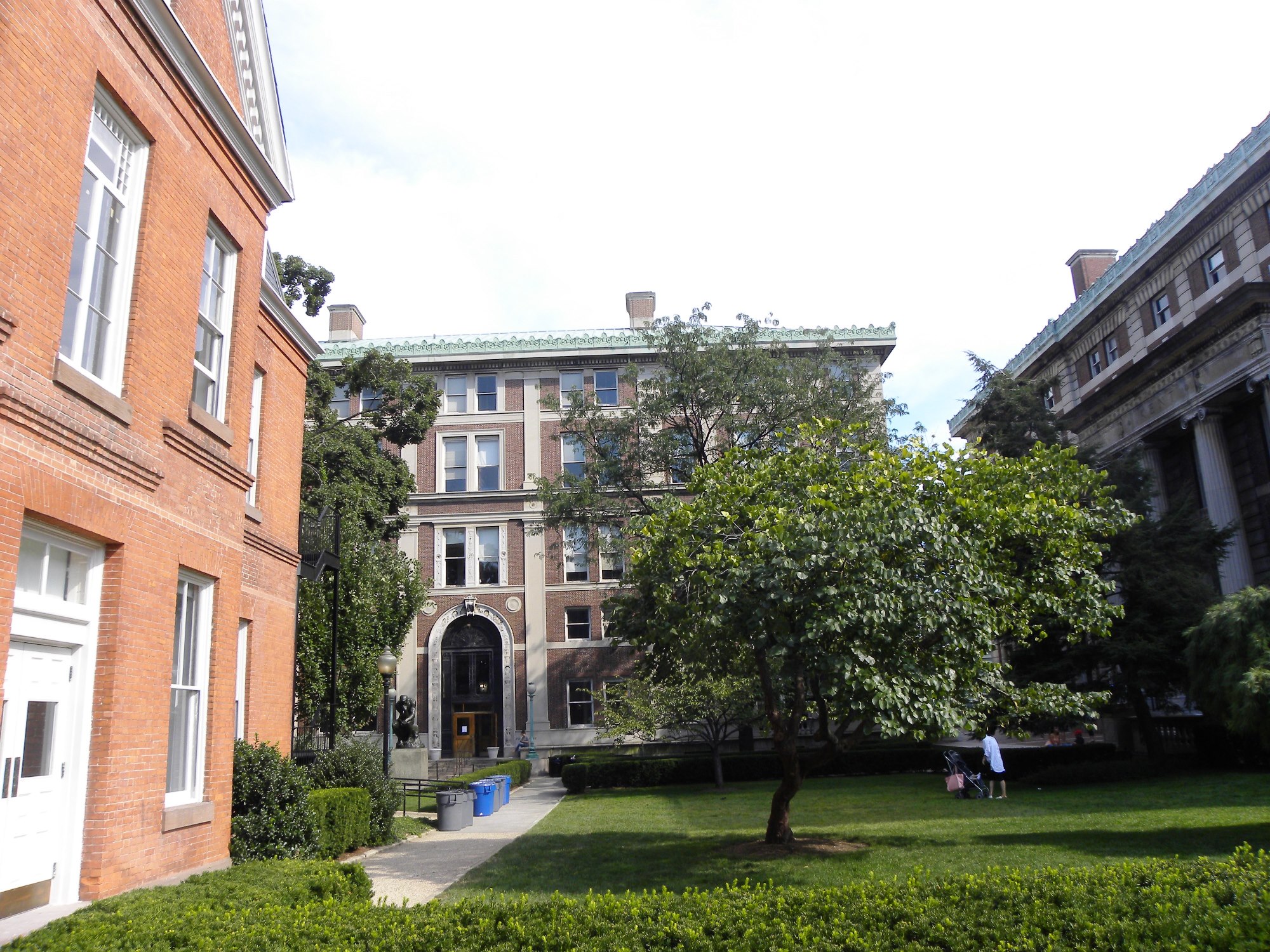
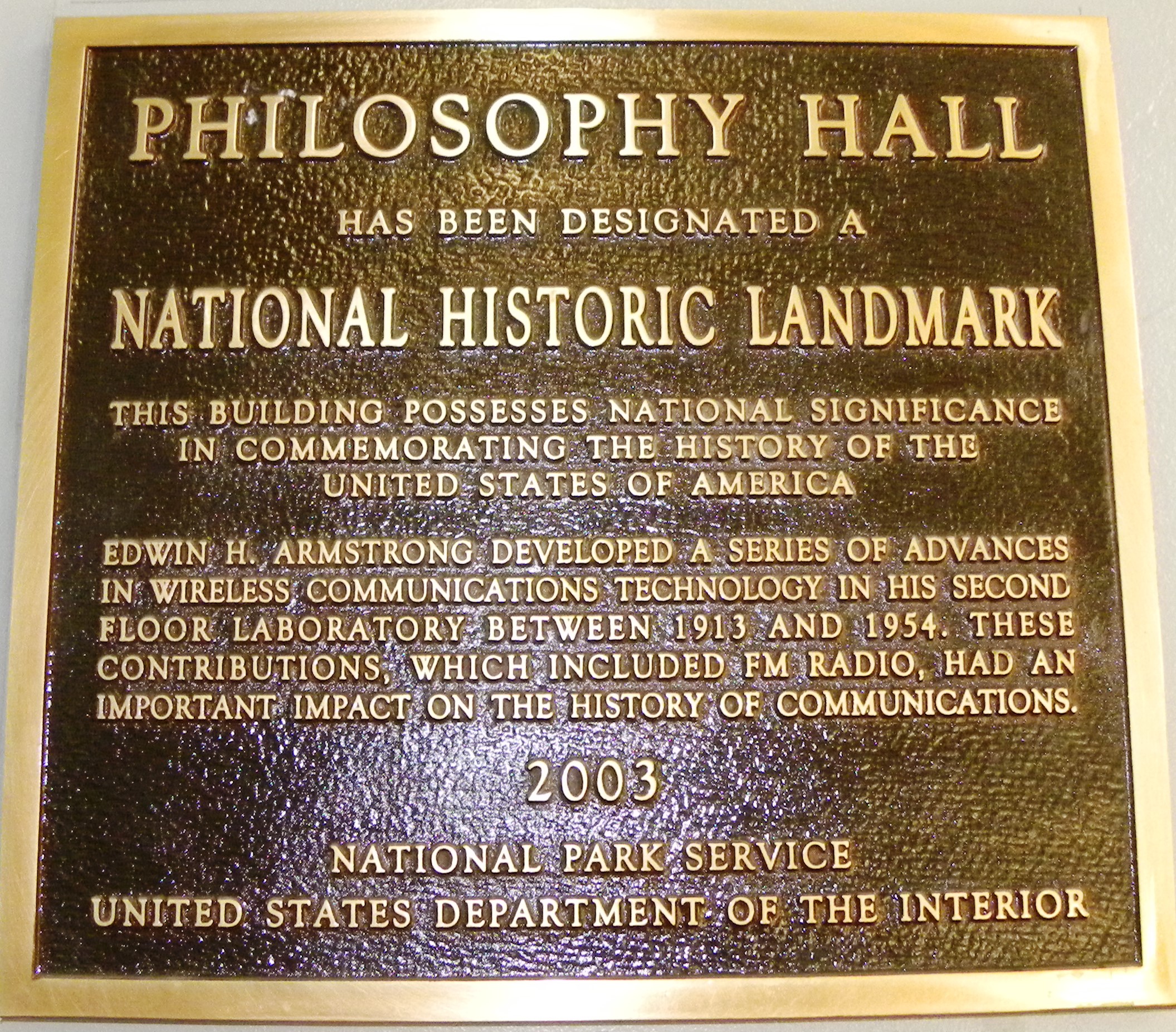 He worked on "wide-band" FM in secret in the basement laboratory of Columbia's Philosophy Hall.
He worked on "wide-band" FM in secret in the basement laboratory of Columbia's Philosophy Hall.
Philosophy Hall
is the center building. He ran antennas between it and the nearby buildings for many of his projects.
By the end of 1933 he had received five patents for his FM research. The next year he demonstrated to Sarnoff what he had come up with. It was not an improvement to AM, but all new technology. The world was in a economic depression, RCA already had a fortune sunk into AM, and TV development was about to start consuming amounts of money that by an order of magnitude dwarfed anything to date.
This was the start of a falling out between Sarnoff and Armstrong. When the two first started collaborating together in the early 20s, Sarnoff was moving up the corporate ladder, and he often championed Armstrong's ideas. At that time Armstrong would often stop by Sarnoff's house in the morning for coffee. Sarnoff's sons would refer to Armstrong as the "coffee" man. One of those sons, Robert would eventually take over the reins of RCA, much to its detriment many claimed.
RCA had the right of first refusal to Armstrong's patents, and reluctantly stopped TV testing from the Empire State Building and let Armstrong use the perch to do FM testing. That lasted from May 1934 to October 35, when Sarnoff decided that TV would take full precedence over FM development and ordered Armstrong out of the building.
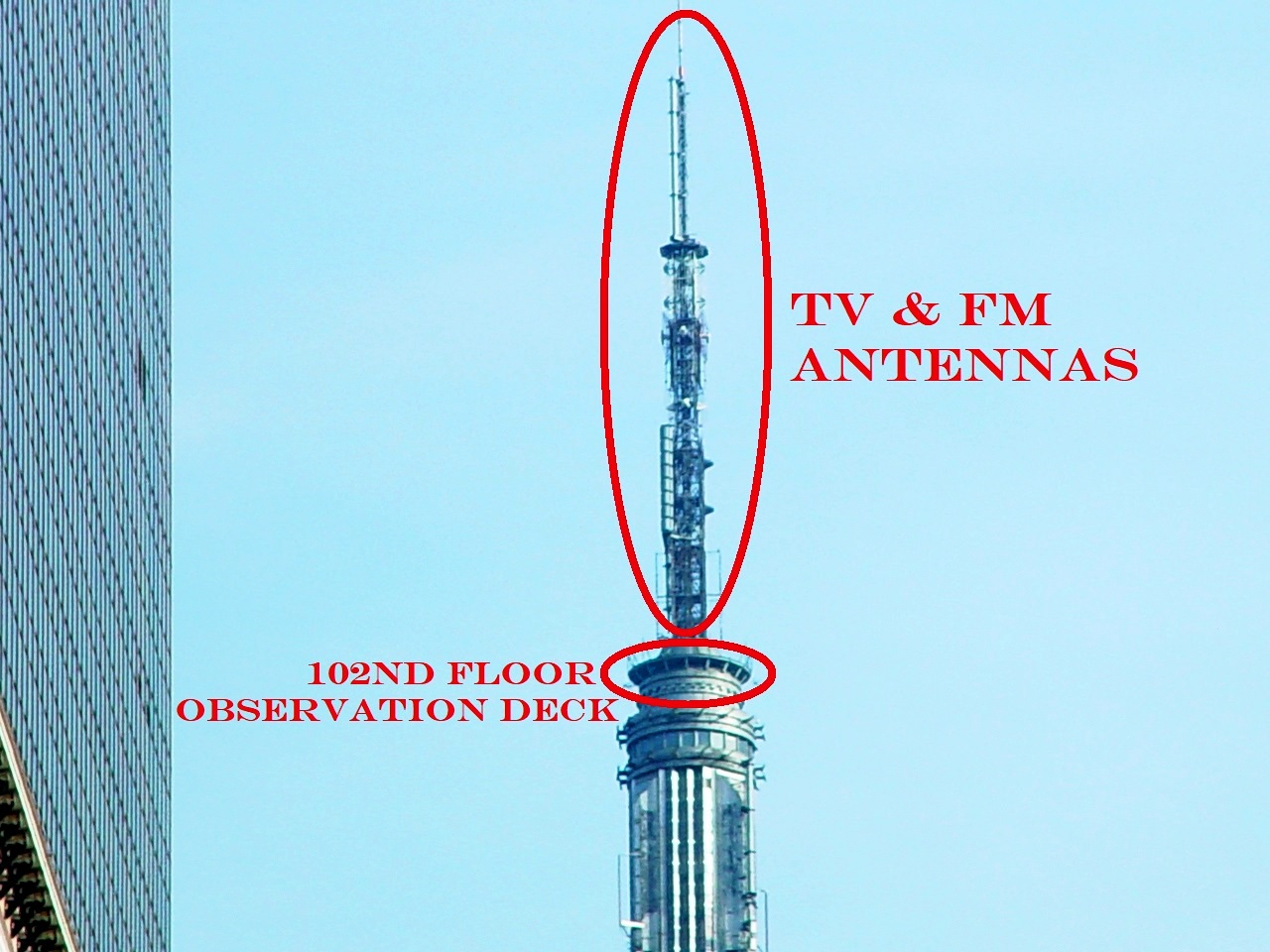
Empire State Building Today
Armstrong's original FM transmitter was installed
here
in 1934
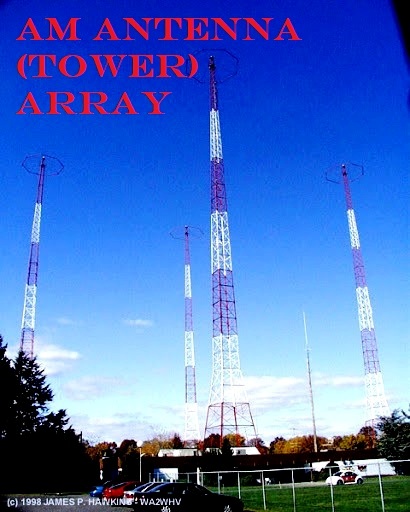
AM and FM are very different beasts. To start with, AM is at frequencies centered around 1MHz. The low end of the FM band is located up at 88MHz today, right above the historical TV channel 6 slot. Above FM there is some aircraft and other bands before TV takes over again at channel 7 at 174MHz. Because of the frequency different AM towers are generally the antenna. Whereas FM and TV towers are simply platforms to get the antenna as high as possible. That' why TV & FM towers are found in high places; tall towers, high buildings, mountains. Whereas AM, again because of where it is located in the spectrum, is generally on flat ground, with good ground radiation characteristics. That is why you find them in swamps, marshes, near water.
Originally FM stations were located between 41 and 44 MHz. At the end of WWII the FCC, at the urging of RCA, moved the band to where it is today. Armstrong felt that RCA wanted to blunt and delay the impact of FM by obsoleting existing FM transmitters and receivers, to stretch out its AM investment. FM didn't really take hold until the 1960s.
Armstrong, now denied RCA's engineering and marketing heft, turned to other companies like Zenith and GE to license his technology. RCA came back in 1940 and offered Armstrong $1,000,000 for a non-exclusive, royalty-free license to use his FM patents. He refused as he felt it unfair to the other licensed companies, which had to pay 2% royalties on their sales. RCA went to work undermining Armstrong, like the frequency change just mentioned.
RCA developed what it claimed was a FM system that did not infringe on Armstrong's patents. In 1948 he filed suit against RCA. The suits drove on for the rest of his life. His primary patents expired in 1950, and with RCA offering a competitive system his finances took a dive.
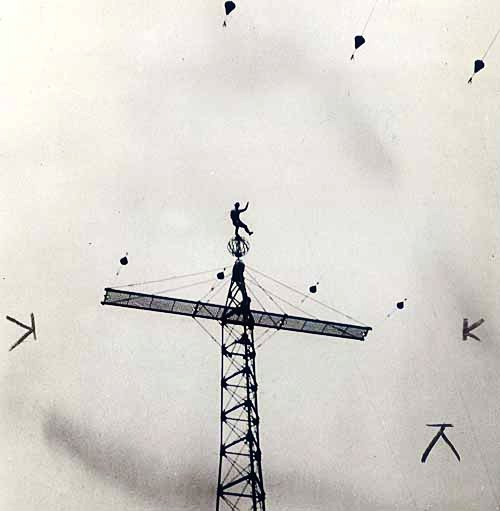
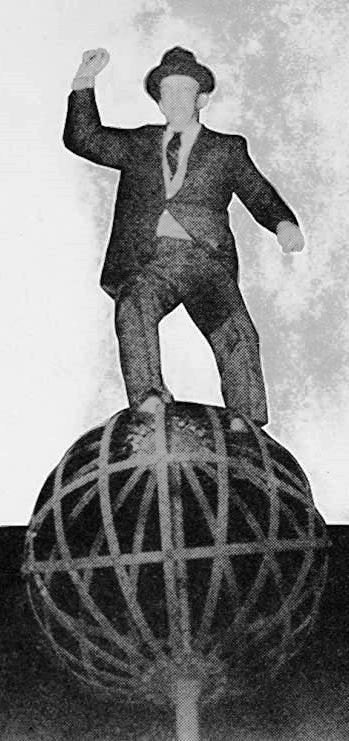
Man of Heights
Armstrong was fearless when it came to heights. The photo on the left was part of a stunt he did to impress his future wife, who happened to be Sarnoff's secretary.
 Radio on the beach! The radio was a wedding gift to him and his wife Marion. Many radios ran on batteries back then, a bank of batteries. The term B+ for the main voltage found in electronic gear came from battery voltage before internal power supplies took over.
Radio on the beach! The radio was a wedding gift to him and his wife Marion. Many radios ran on batteries back then, a bank of batteries. The term B+ for the main voltage found in electronic gear came from battery voltage before internal power supplies took over.

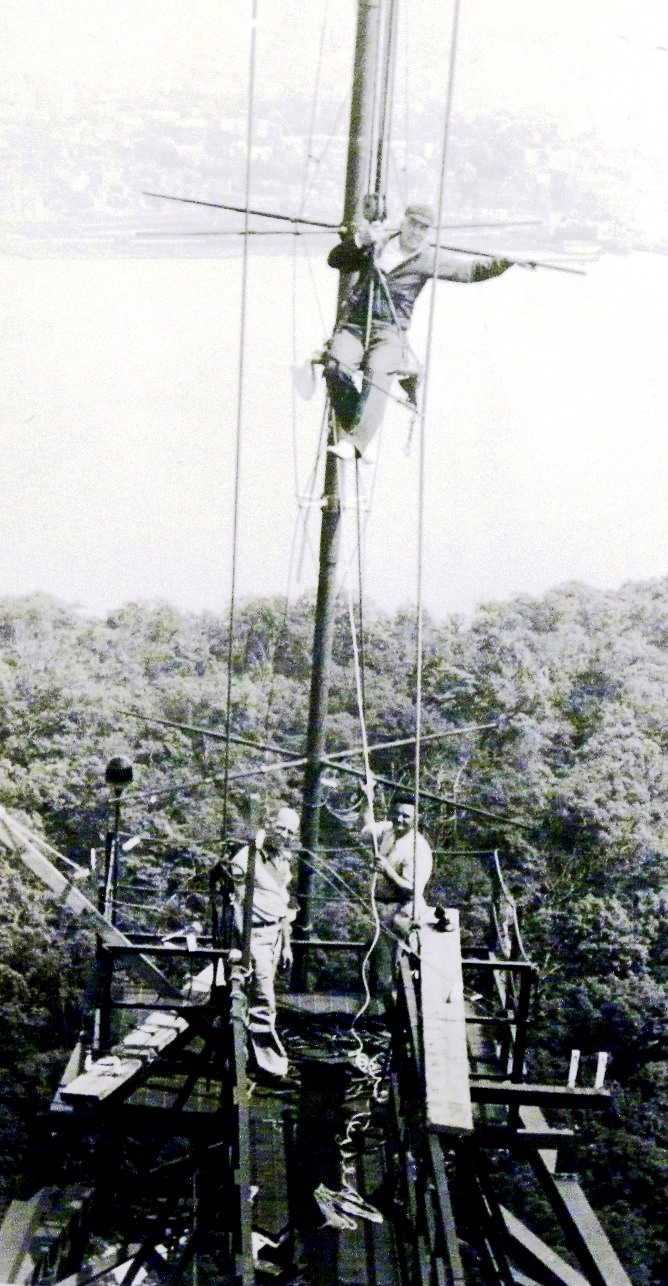
Armstrong Tower
After Sarnoff threw Armstrong and his FM project out he ended up building a tower in 1938 to test FM across the Hudson and a bit north in the Palisades of New Jersey. The tower is 425 feet tall and is in the small town of Alpine. Armstrong loved to climb and rove around the tower.
After 911 with the loss of the World Trade Towers a number of television & FM radio stations moved their transmit antennas over to this tower for a few years.

Armstrong tower as seen from the Empire State Building on Manhattan. The George Washington Bridge is in the foreground.
The years of fighting RCA over FM, which was estimated to consume almost all his time in later years, along with the earlier run-ins with de Forest, left Armstrong bitter and broken. Senator Joseph McCarthy of the infamous hearings also claimed that Armstrong was concerned about radar secrets being passed to the Russians. The cumulation of all this resulted in him lashing out at his wife and striking her on the arm with a fireplace poker in frustration in November of 1953. She left for Connecticut to stay with her sister. At the end of January 1954, he jumped from their 13th floor apartment to his death. In his lifetime he created or was involved with four major advancements in communications technology.
His wife took up the litigation fight and through arbitration forced RCA to pay $1,000,000 to his estate. Other infringement lawsuits continued until 1967.
He held 42 patents and received numerous awards, including the first Medal of Honor awarded by the Institute of Radio Engineers (now IEEE), the French Legion of Honor, the 1941 Franklin Medal and the 1942 Edison Medal.
RCA had by now become the dominant communications firm in the United States. It would hold that title through most of the 60s and start to wain in the 70's. RCA was so prevalent for so long that as was already mentioned, more than one broadcast station chief engineer would state that if RCA did not make it, they did not need it.
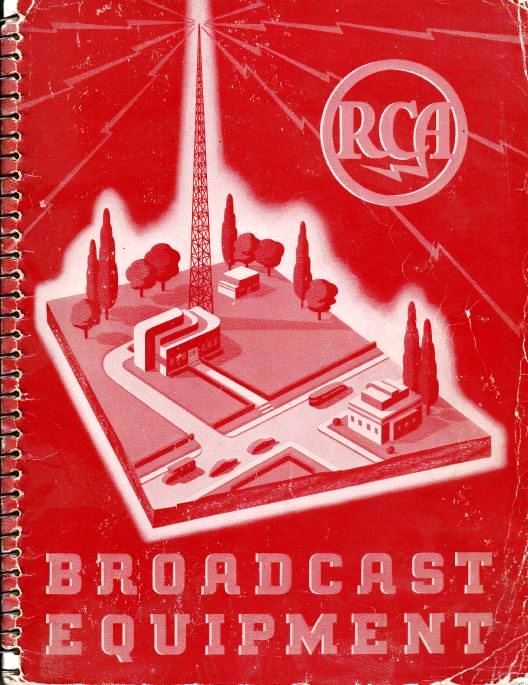
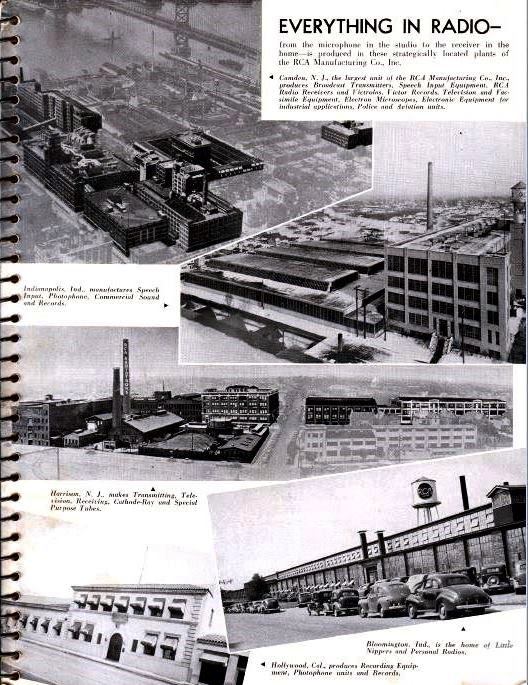
1941 RCA Equipment Catalog
RCA had competition
Rockefeller Center
By 1929, RCA was doing well enough that GE, which still owned part of RCA, commissioned the building of a 50-floor (640 foot tall or 200 m) stylized Gothic octagonal brick tower. It had elaborate Art Deco decorations of lightning bolts showing the power of electricity. RCA instead moved into Rockefeller Plaza midway through construction, and the new building at
570 Lexington Avenue
was conveyed to GE as part of an agreement with the feds when the two companies were forced apart. GE used the building as its headquarters between 1933 and 1974, and retained ownership until 1993, when the building was donated to Columbia University.
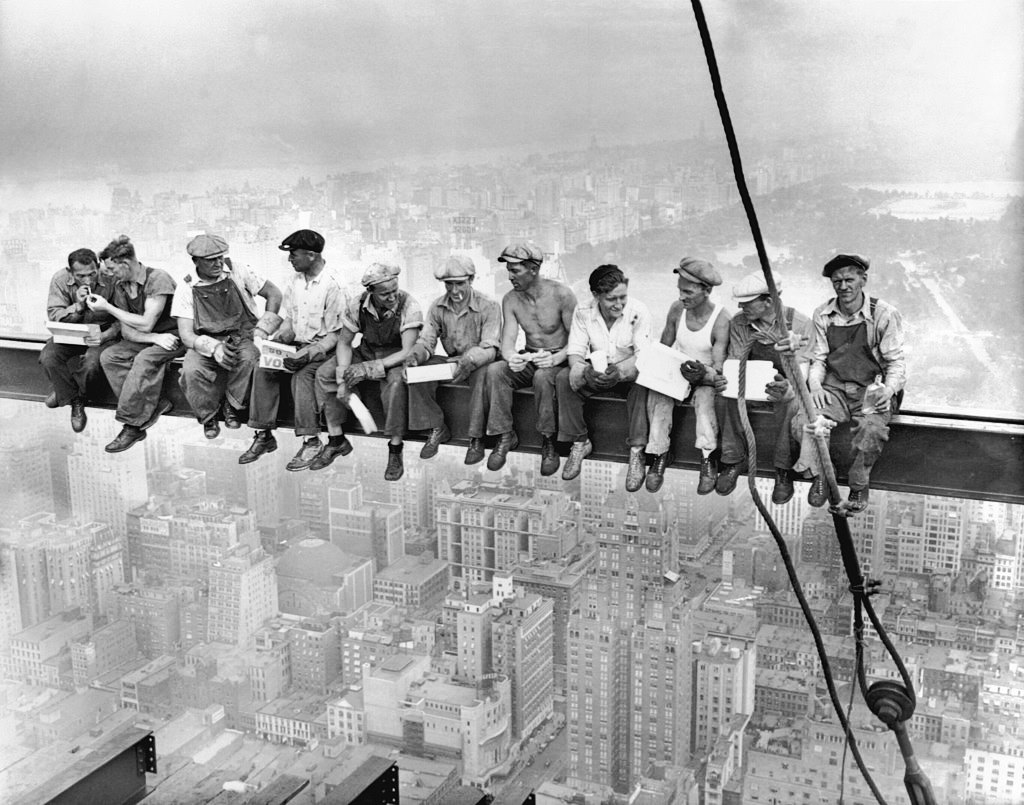
Rockefeller Plaza was five blocks away, and RCA became its major tenant. In 1926, the Metropolitan Opera started looking for locations for a new opera house. The new design turned out to be too expensive for the Met to fund itself. John D. Rockefeller Jr. decided to support the project. Rockefeller convinced Columbia University, who owned the land, to lease him the land for the project for 87 years at a cost of $3 million per year. The initial cost for building out the project was $250 million.
An iconic photograph by Charles Clyde Ebbets of the Washington Post, depicts workers having lunch atop
30 Rockefeller Plaza
during its construction.
The complex was the largest private building project ever undertaken in contemporary times. Eleven buildings had been completed by 1937, and by fall 1939, the complex had 26,000 tenants and 125,000 daily visitors. It spanned 22 acres in total when completed. By 1944, the complex's existing rent-able area totaled 5,290,000 square feet. By the time that the project neared its existing state it had 17,000,000 square feet (1,600,000 m2) of office space.
NBC stuck in the center of the complex got their landlord to let them use the then little used Center Theater for extra broadcasting space in 1951. Eventually NBC would expand into space that Sinclair and Esso formerly occupied in the original complex, and they moved out of the Center Theater. This happen after the Sinclair Oil Company moved into its own tower in the complex.
The current complex is a combination of two building complexes and a standalone building. The original 14 Art Deco office buildings from the 1930s, one building across 51st Street built in 1947, and a set of four International-style towers built along the west side of Avenue of the Americas during the 1960s and 1970s.
The complex
spans both sides of the Avenue of the Americas and to 5th Avenue (east to west) and between 47th and 51st Streets (north and south).
The Radio Networks
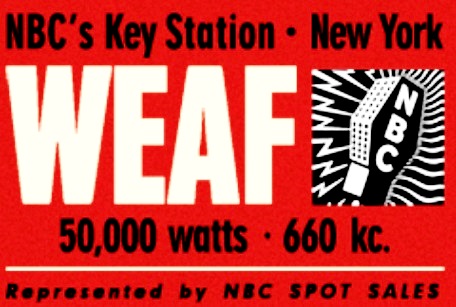
WEAF signed on in 1922 in NYC. It was the first commercially licensed radio station in New York City. Western Electric Company, a subsidiary of AT&T, was interested in exploiting its collection of radio patents, which it believed would allow it to corner the market in the exploding field of radio broadcasting. The year it signed on, WEAF broadcast what it later claimed to be the first radio advertisement, which was a roughly 10 minute talk regarding apartments in Jackson Heights, Queens.
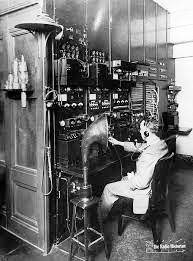 In 1946, WEAF changed its call sign to WNBC and became the flagship station of the NBC Red network (more on that in a bit). This station is now known as WFAN (AM) as GE, which bought RCA and NBC sold off its radio operations in 1988. WFAN which already existed took over WNBC's frequency (660 KHz) and vacated its old one.
In 1946, WEAF changed its call sign to WNBC and became the flagship station of the NBC Red network (more on that in a bit). This station is now known as WFAN (AM) as GE, which bought RCA and NBC sold off its radio operations in 1988. WFAN which already existed took over WNBC's frequency (660 KHz) and vacated its old one.
WEAF Control Room 1927
Early on it was AT&T that was in the best position to put together a radio network of AM stations. It owned the "long lines" on which to connect the networked stations and refused to lease the higher quality voice lines to any broadcasting competitors, only lower quality lines used for telegraph.
Early on RCA and the rest of the "radio group's" efforts at forming a radio network, centered on WJZ (now WABC), a Newark, New Jersey station which RCA acquired in 1923 from Westinghouse and moved it to New York City. RCA in 23 also put WRC (now WTEM) in Washington, D.C. on the air. Much of its early efforts involved linking these two stations, which were stymied by AT&T.
None-the-less the first RCA network broadcast occurred in December 1923, when a WJZ program was received off air and rebroadcast by WGY, Schenectady, New York, which was owned by General Electric. The "WJZ chain" saw little growth compared to AT&T. President Coolidge's March 1925 inaugural speech was sent over a growing AT&T transcontinental network of 23 stations, while the WJZ chain's broadcast of the speech was carried by only four stations, all located in the East.
(Map)
Then in 1926 AT&T had a change of heart. AT&T centralized its radio operations in a subsidiary known as the Broadcasting Company of America. This was done in anticipation of selling the radio network, as the management of the company decided that the radio broadcasting was incompatible with the company's primary role as the leading U.S. supplier of telephone and telegraph services.
A few weeks after AT&T created the Broadcasting Company of America subsidiary, it sold its assets to RCA for approximately one million dollars. This sale transferred ownership of WEAF to RCA. AT&T also agreed to make its telephone lines readily available for RCA's network. RCA then announced the formation of the National Broadcasting Company, Inc. Up until then AT&T asserted that through the various cross licensing agreements among vendors earlier that only it was permitted to sell advertising. As part of the sale NBC was also permitted to accept advertising.
NBC's network operations were officially launched with a gala broadcast on November 15, 1926. Carl Schlegel of the Metropolitan Opera opened the inaugural broadcast, which also featured Will Rogers and Mary Garden. The broadcast, which even included a remote link from KYW in Chicago. Twenty-two stations, located as far west as WDAF in Kansas City, Missouri carried the broadcast originated through WEAF studios.

 Soon NBC formally divided its programming into two networks, called the Red and the Blue. On January 1, 1927, they went into separate operations. WEAF originated the Red Networks programming, while WJZ originated Blue's. It is claimed that the two networks got their names from the color of the patches used by AT&T long lines to route the programming out to the network.
Soon NBC formally divided its programming into two networks, called the Red and the Blue. On January 1, 1927, they went into separate operations. WEAF originated the Red Networks programming, while WJZ originated Blue's. It is claimed that the two networks got their names from the color of the patches used by AT&T long lines to route the programming out to the network.
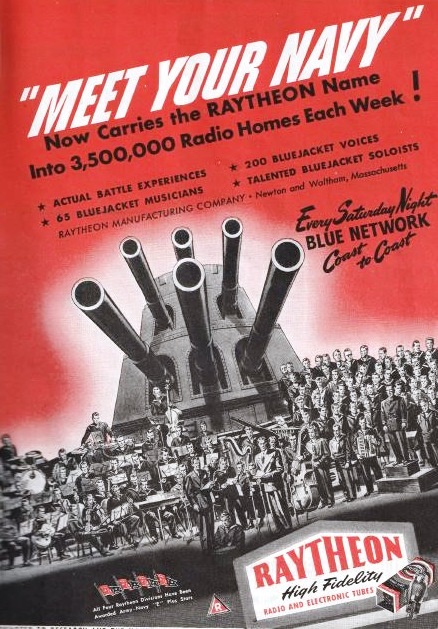
Equipment vendor support for show on the Blue Network
At first the two NBC networks did not have distinct formats. The NBC Red Network had a stronger line-up of affiliated stations, so it generally broadcast the more popular, "big budget" sponsored programs. The Blue Network with a smaller line-up of often lower-powered stations carried more obscure and experimental programming, or for more niche markets. Thus it sold airtime to advertisers at a lower cost. Successful Blue Network programs often were "moved up" to the Red Network. Blue carried more news, cultural and educational programs. In many cities in addition to New York, the two NBC affiliated stations (Red and Blue) were operated as duopolies, having the same owners, and sharing the same staff and facilities.
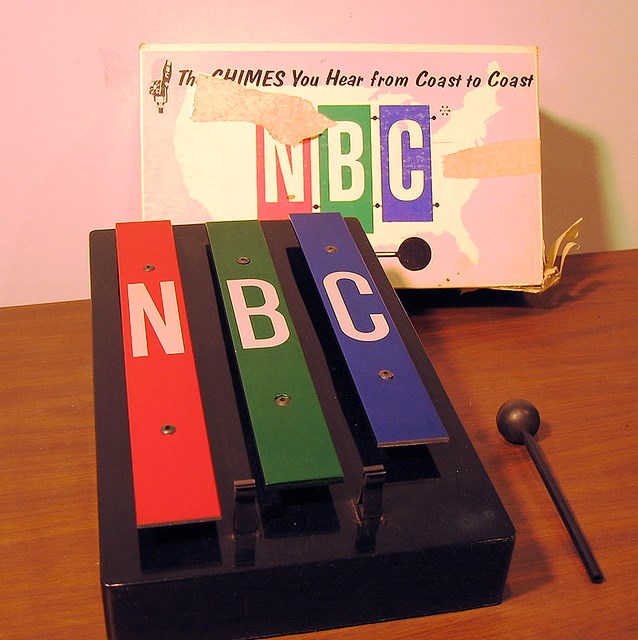
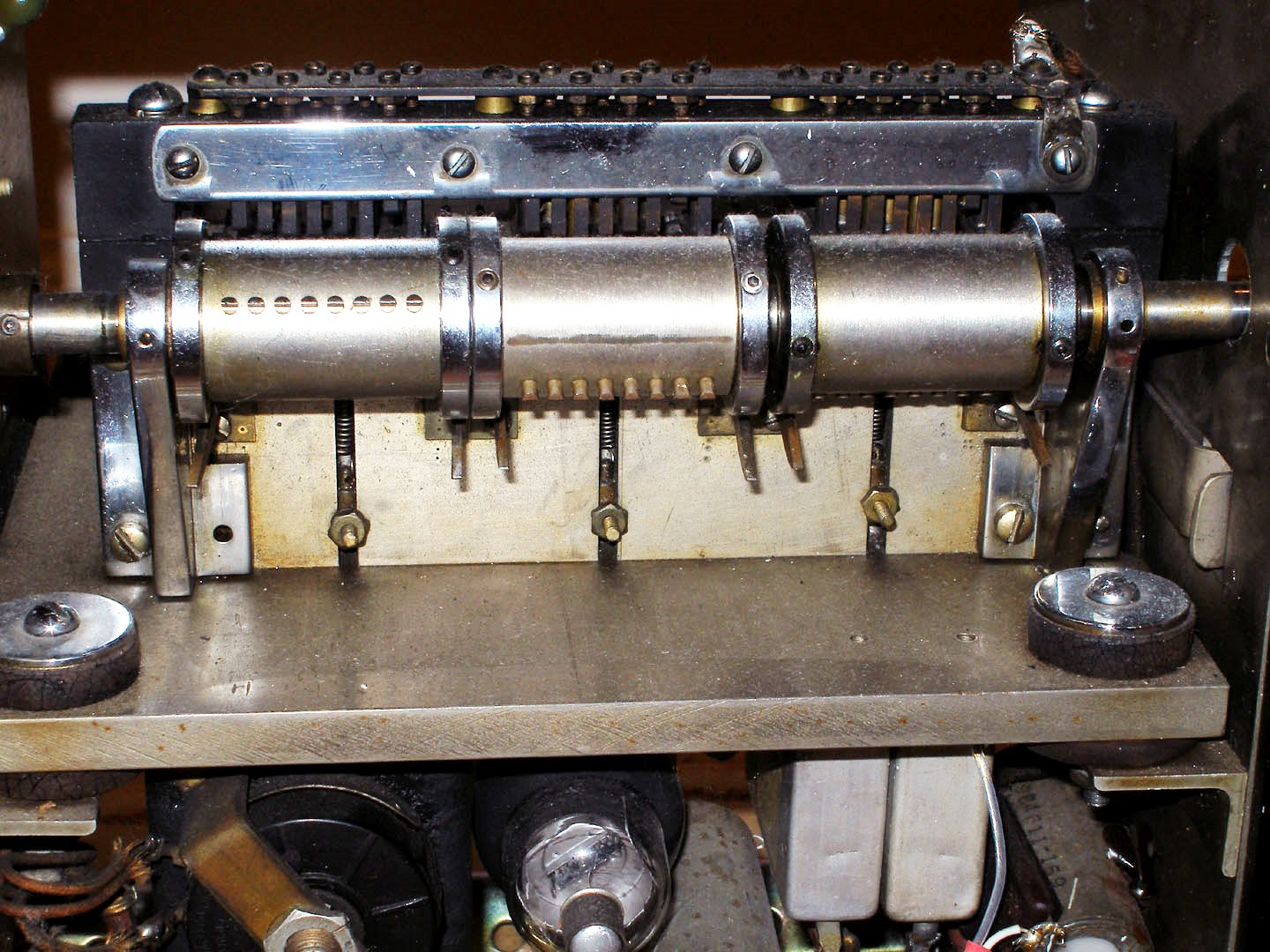
NBC Chimes
Manual and mechanical versions
Beginning in 1929, both networks shared use of the distinctive three-note "NBC chimes." The chimes were originally employed as an audible programming cue, used to alert network control engineers and the announcers at NBC's radio network affiliates.
They were in the key of C and sound the notes G, E, C, the 'G' being the one just below middle C, the 'E' the one just above middle C, and the 'C' being middle C
Some have claimed that "G-E-C" sequence comes from the initials of the General Electric Company. Robert C. Wright, in 1987, then president and C.E.O. of NBC, testified before the U.S. Congress that "Not everyone knows that GE was one of the original founders of RCA." GE was part of the original "radio group" and when RCA was made a standalone company, a large part of its management came from GE.
Ironically GE bought RCA in 1986, re-acquiring NBC.
Listen
Back then almost all network programs were owned by their sponsors and produced by their advertising agencies. The advertisers bought available time periods and chose which stations would carry the program. Networks basically sold blocks of time and rented out studio facilities. The only network-produced programs were unsponsored programs used to fill unsold time periods. In many cases the affiliated stations had the option to not "clear," that is not air the network unsponsored show and air a local program during those periods. But the network could take back the time period if the network sold the time.
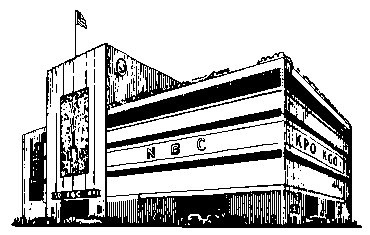
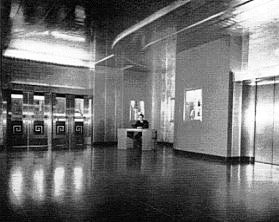
1941 NBC West Coast Operations - KGO/KPO
On April 5, 1927, NBC reached the West Coast by launching the Orange Network, which rebroadcast Red Network programming. Its flagship station was KGO in San Francisco. On October 18, 1931, the Blue Network programming was introduced to the west on the Gold Network, which broadcast from San Francisco's KPO. In 1936 the Orange Network's name was dropped and affiliate stations became part of the Red Network, while the Gold Network took the Blue Network's name.
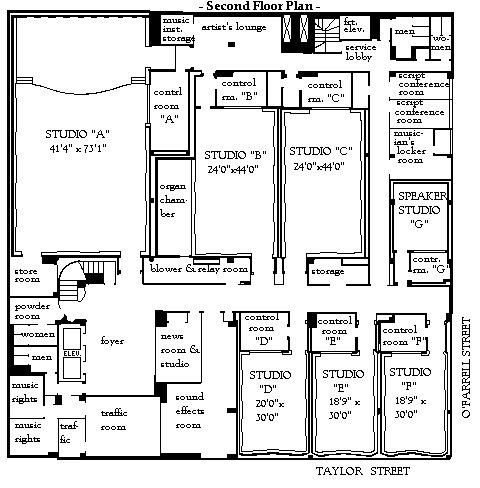
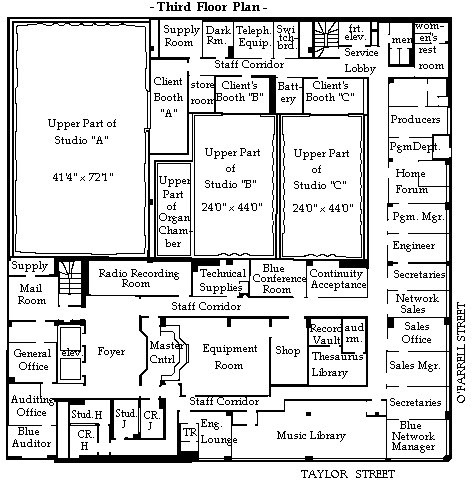
Bay Area Radio Museum
NBC/KNBR Studios and Technical Areas
In 1941 NBC built "Radio City" at 420 Taylor St, San Francisco. The facility contained ten studios, A through J, plus a news studio with no letter designation. Soon after this facility went operational, west coast network control moved to Los Angeles.
The Federal Communications Commission decided in May 1941 that NBC's control over two national radio networks gave it too much power over the industry, and that it would force NBC to divest one of them. While RCA fought the divestiture order, it did divided NBC into two companies in case it lost its appeal. The Blue network became the "NBC Blue Network, Inc." while the NBC Red became the "NBC Red Network, Inc." effective January 10, 1942. On September 1, 1942, NBC Red Network simply became NBC. The U.S Supreme Court upheld the ruling and on October 12, 1943, the Blue network was sold to candy magnate Edward J. Noble for $8,000,000, and was called "The Blue Network, Inc." In 1946 the name was finally changed to the American Broadcasting Company.
As a result in 1943 NBC sold KGO and the (NBC) Blue Network Suddenly KPO and KGO became competitors, which continued to share the same building. When KGO received a television license in 1949, Studio C was converted into a television studio. KGO remained at Radio City until 1954. KPO became KNBR in 47 and continued on in the Taylor building until 1967 when they moved out as another broadcaster was moving in. NBC sold KNBR with the rest of its radio operations in 1988.
In the late 60s the Kaiser company, which already had a large presence in the area, Kaiser Shipbuilding, Cement, and their hospital system, started five UHF stations across the country; Boston, Philadelphia, Cleveland, Detroit, and San Francisco. The San Francisco station, with call letters KBHK for a long time, used these facilities. Most UHF facilities were modest in appearance at that time. Not this station, it still alluded a network feel.
The building has long since been converted to other uses with Reddit as a major tenant.
Map
CBS
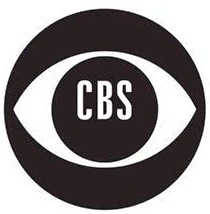 CBS started on January 27, 1927, as the United Independent Broadcasters network. It was started in Chicago by New York City talent agent Arthur Judson. Three months later the Columbia Phonograph Company, manufacturers of Columbia Records, invested in it. The network's name became the Columbia Phonographic Broadcasting System. The network's original flagship station was WOR in Newark. The network had 15 affiliates. The network lost money, especially because of the high rates AT&T charge to use its landlines. By the end of 1927, Columbia Phonograph wanted out.
CBS started on January 27, 1927, as the United Independent Broadcasters network. It was started in Chicago by New York City talent agent Arthur Judson. Three months later the Columbia Phonograph Company, manufacturers of Columbia Records, invested in it. The network's name became the Columbia Phonographic Broadcasting System. The network's original flagship station was WOR in Newark. The network had 15 affiliates. The network lost money, especially because of the high rates AT&T charge to use its landlines. By the end of 1927, Columbia Phonograph wanted out.
Judson sold the network in early 1928 to the owners of the network's Philadelphia affiliate WCAU,Isaac and Leon Levy, who were brothers. They also had a third partner. None of the three were interested in running the network, so they hired the son of a Philadelphia cigar makers family, who was also an in-law of the Levy's, wealthy 26-year-old William S. Paley as president. One of Paley's initial acts was to simplify the corporate name. The company became the "Columbia Broadcasting System". After Paley had convinced his elders to advertise on radio and the sales of his family's La Palina cigars had doubled he truly believed in the power of radio advertising. By September 1928, Paley bought out the third partner's share, and had 51% ownership of the business.
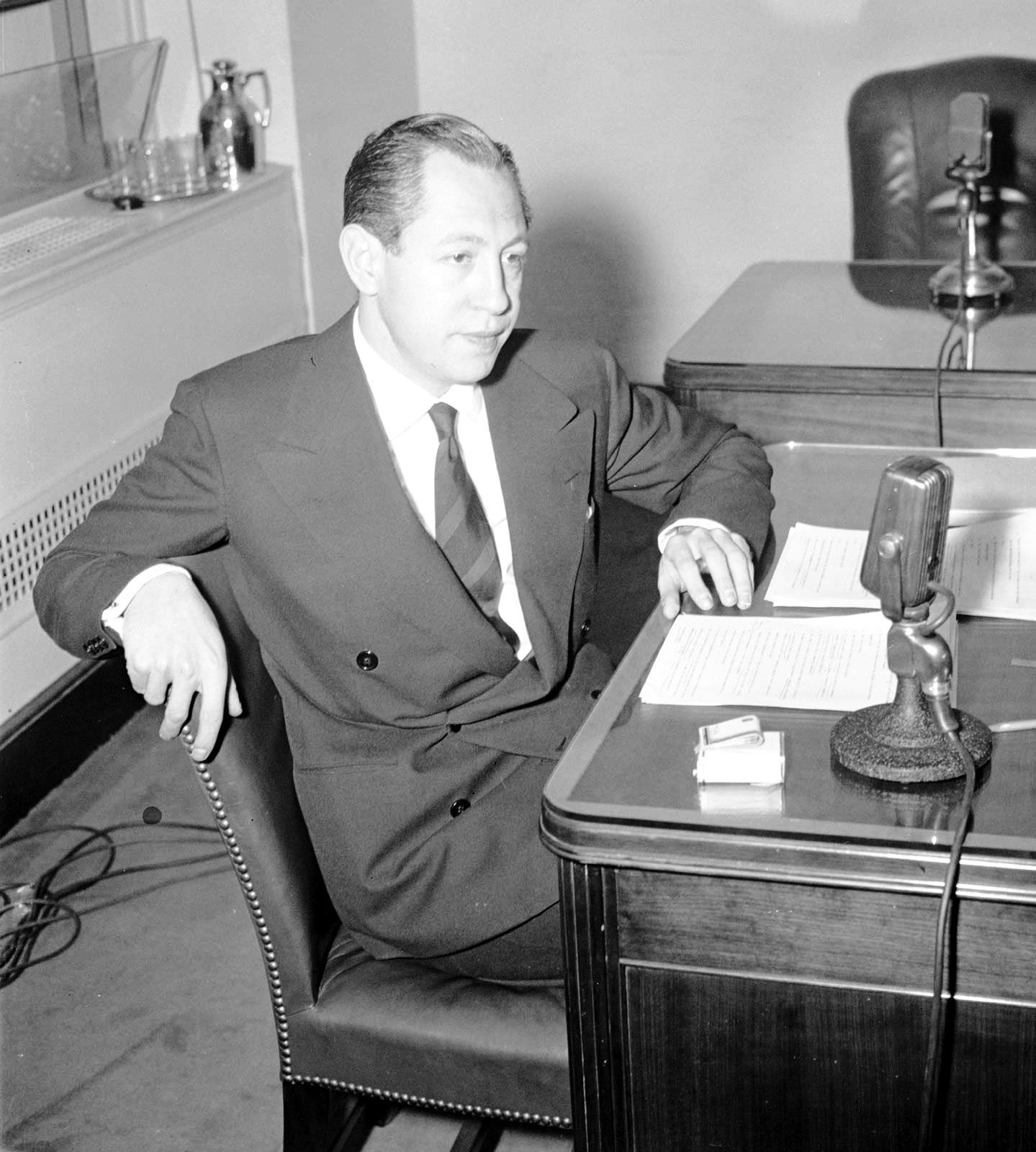
William Paley
In September 1929 Paramount Pictures, who planned to move into radio in response to RCA's forays into motion pictures with the advent of talkies acquired 49% of CBS in return for a block of Paramount's stock worth $3.8 million at the time. The deal was that Paramount would buy that same stock back for a flat $5 million by March 1, 1932, provided that CBS had earned $2 million during 1931 and 1932. The following month the stock market crashed. It galvanized Paley. Paley's first year saw CBS's gross earnings more than tripled, going from $1.4 million to $4.7 million. Paley was able to keep the terms of the Paramount agreement.
By the turn of 1929, the network had 47 affiliates. Those numbers quickly grew, as Paley took much care to improve affiliate relations. NBC paid affiliates for every sponsored show they carried, and charged them for every sustaining (unsponsored) show they ran. This was tough on small and medium stations and resulted in limited clearance of sustaining programs. Paley took a different tack. Unlike RCA he gave sustaining programs away for free, provided the station would run every sponsored show. CBS soon had more affiliates than either NBC Red or NBC Blue.
In 1929, the company also moved to
485 Madison Avenue, right in the heart of the advertising community.
Whereas Sarnoff, running RCA and NBC both, had split motives, supply programming and sell equipment, which led at times to affiliates doubting his sincerity to their interests, Paley had no such problems. It was said that Paley had "a gift of the gods, an ear totally pure" He knew "what was good and would sell, what was bad and would sell, and what was good and would not sell, and he never confused one with another." Whereas Sarnoff tended to go "highbrow" when he could. Paley wanted more to entertain, than enlighten the masses.
He concentrated on building a stable of talent. A who's who of contemporary talent at the time. Jack Benny, Al Jolson, George Burns and Gracie Allen, and Kate Smith, among others. Paley heard a recording of Bing Crosby while Paley was on a mid-ocean voyage, he managed to get a cable to New York to sign Crosby immediately to a contract for a daily radio show. Crosby was young, and not widely known at the time.
While CBS prime time radio was full of music, comedy and variety shows, Paley understood what daytime programming needed to consist of, shows that appealed to the then stay-at-home wife, to win the "heart and minds" of American woman. From astrologers and others who offered advice and consul to listeners mailed in problems, the network thrived to become daily companions to the woman listeners. Being the good salesman that he was, he would often make the listener send in a box top, or label of the shows sponsor to have request be addressed on air.
Soon the serial drama soap operas, named for the products that usually sponsored them, became programming staples. These started as quarter-hour long episodes and became a mainstay in the mid-30s. By 1937, the network had $28.7 million in revenue and had 114 affiliates. Its rating were generally higher than NBC's helped by the high rate of clearances by its affiliates.
NBC radio's Red Network broadcast its first news program on February 24, 1930. The announcer was Floyd Gibbons, one of the best known newspaper correspondents at the time. On September 29, 1930, CBS responded with broadcaster Lowell Thomas, who hosted the first CBS radio daily news program. They were five-minute summaries taken from reports from the United Press. Between time spent at CBS and NBC, Thomas would host radio, and then television news shows until 1976.
Like his other attributes of running his network, Paley wanted to do news better than his competitor. In December 1930 Paley hired journalist Paul W. White away from United Press as CBS's news editor. Paley put the radio network's news operation at the same level as entertainment, and authorized White to interrupt programming if events warranted. At the time the wire services prevented radio from broadcasting their news bulletins until they were in print by newspapers. CBS disregarded the embargo when it broke the story of the Lindbergh kidnapping in 1932. The radio networks also scooped print outlets with news of the 1932 presidential election.
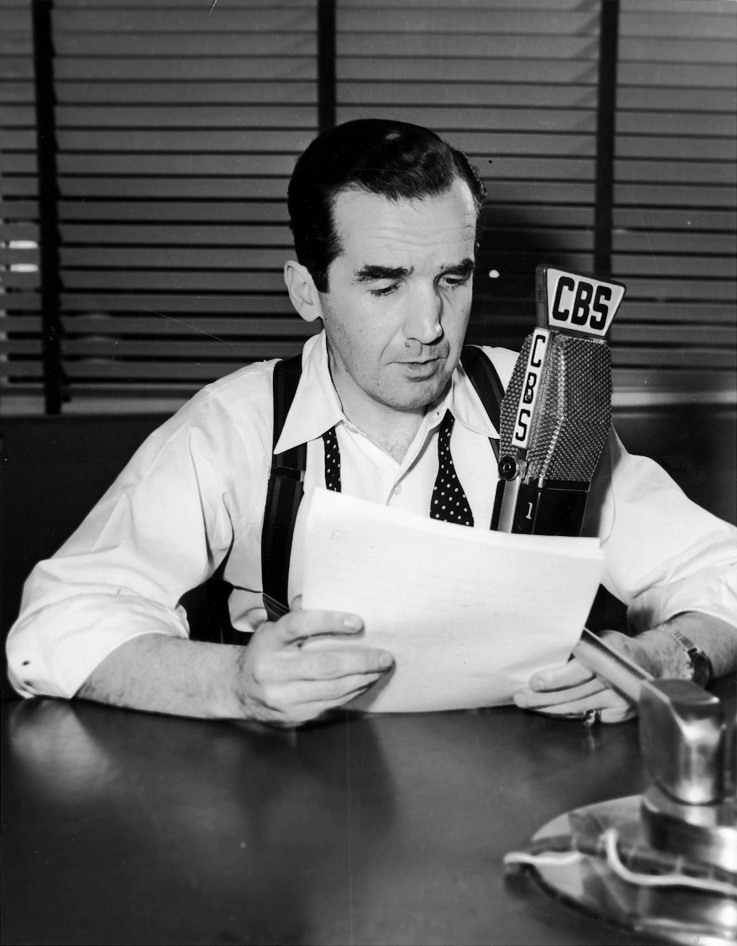
Edward R Murrow, late 1940s
In March 1933, White was named vice president and general manager in charge of news at CBS. Paley set his mission as the first head of CBS News, to build an organization that soon established a legendary reputation. As the 30s rolled on CBS came to realize that it could not match the entertainment programming that NBC had, so it cleared more time for news and thus built up its news division. In 1935, White hired Edward R. Murrow, and sent him to London in 1937 to run CBS Radio's European operation. White built a staff that would become known as the Murrow boys, with Murrow becoming the long time face of CBS news. Many would be on-air icons into the early 80s.
Mutual Broadcasting System
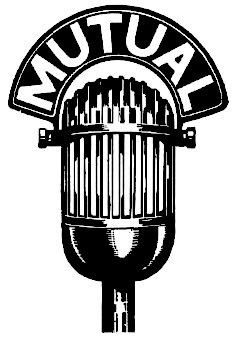
Attempts at establishing a cooperatively owned radio network was tried a couple times. In 1934, a group of stations founded the Mutual Broadcasting System. Mutual's original participating stations were WOR Newark, owned by the Bamberger Broadcasting Service, which ended its relationship with CBS. Bamberger was a division of R.H. Macy and Company. The other stations were WGN Chicago, a subsidiary of the Chicago Tribune, WXYZ Detroit, and WLW Cincinnati. The network began operation in September with the members contracting for telephone interconnect facilities and agreeing to collectively enter into contracts with advertisers for their networked shows. WOR and WGN, the two stations in the largest markets provided the bulk of the programming.
The network produced many radio shows that became iconic. The Lone Ranger from WXYZ was an early one. The network managed to add affiliates. By the end of 1938, Mutual had 74 exclusive affiliates. Mutual shared another 25 affiliates with NBC and 5 with CBS, for a total not two far behind the two bigger ones. At its height the network had around 560 affiliates, almost three times as many as its more powerful competitors. The problem was that a lot of the better stations, the ones with more powerful transmitters and thus better coverage were already spoken for. As an example in the postwar era CBS and NBC covered all of North Carolina each with only four affiliates, while Mutual needed 14 affiliates to deliver comparable statewide coverage. Because of that kind of coverage NBC often took in more than 10 times as much revenue as Mutual.
Early performers such as Orson Welles, Kate Smith, Alan Ladd, Steve Allen, Perry Como, and shows like The Shadow, The Green Hornet, The Adventures of Superman, Queen for a Day, and Sergeant Preston of the Yukon aired on the network. Sporting events like the Indianapolis 500, and major league baseball were also aired. At one point the network won exclusive broadcast rights to the World Series. To limit Mutual's success the other two networks prohibited their affiliates from airing those games. This action eventually led to lawsuits by Mutual.
Mutual also managed to start a respected news operation with tiny budgets compared to the other two. But that would not be enough. Many of the shows that became hits on Mutual ended up moving up to the larger networks who could afford to buy them out from under Mutual. At times it appeared that the network was a farm club for others. The other bigger problem was that the network did not have the finances to move into television as the others were doing in the late 40s. A lot of the advertising money was starting to move to TV. There was a mass desertion of network radio talent, management and technicians for television taking their shows with them. After a couple of sales of the company to inattentive owners, and some questionable legal shenanigans by those owners by the 60s the network had retreated back to being a network only when it came to news and sports. Entertainment was all but abandoned.
In 1985 Westwood One bought the network for $39 million, partially for the news operations that Westwood lacked. Mutual also helped Westwood attain a broad demographic sweep, in that Mutuals audiences with adult and older listeners where larger, while Westwood's skewed younger.
Television
By the turn of the century, a couple decades before AM broadcasting got going, television, let alone color TV, was being thought about. In 1904 a color television patent is applied for. It used a rotating sectored filter (red, blue, yellow) wheel with two small mirrors for dissecting the image. At the receiver a vibrating wire and a platinum point which formed a spark gap became the light valve. This was a very early application of a form of sequential color television.
Early TV really got its start in 1884 when Paul Gottlieb Nipkow invented his scanning system. Television historian Albert Abramson calls Nipkow's patent "the master television patent." While the approach was eventually abandoned as all electronic systems evolved, it allowed a lot of early experimenting in capturing video and transmitting it. As we will see as video moved towards being all electronic, it was easier to perfect all-electronic at the receiving end before the transmitting end.
Mechanical Television
Visit to the Early Television Museum
How the Nipkow disk works
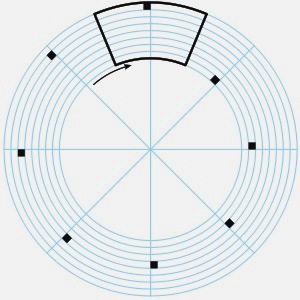
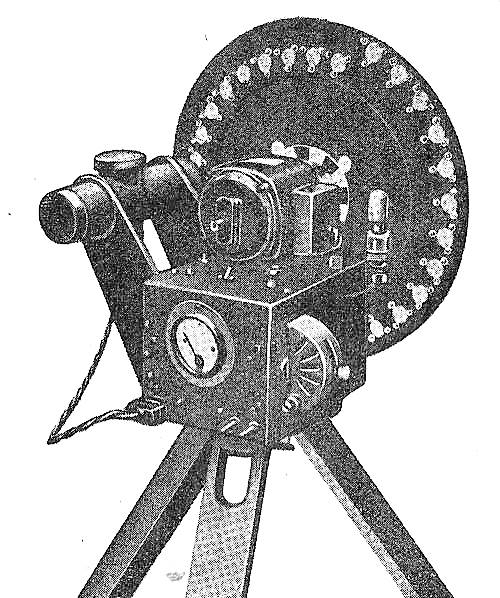
The Nipkow Camera
The rotational speed of the disk would determine how many pictures per second would be sent. Early on that rate was quite low, 6 to 12 pictures or frame rate. Eventually the rpms were up in the 20s. The number of slots or holes was eventually increased to 100, producing 100 scan lines per picture at 24 frames a second. Compare that to today, where many watch video that has 1080 lines at 60 frames a second. In addition, the amount of picture information or horizontal resolution, per line has gone up over 10-fold.
Early on television, was highly mechanical with some electrical parts, not electronic, but electrical. But cathode ray tubes (CRT) were already being experimented with. The CRT is an offspring of the vacuum tube we saw earlier. In 1906 the first patent using a cathode ray tube as a display device was applied for. But the mechanical approaches would stay front and center for quite a while. By 1907 more TV patents using revolving discs, and some vacuum tube technology at the receiving end were awarded. Also discs at both transmission and receiving ends that are synchronized were developed. Until the late twenties the receiving or display end of the television path saw much more electronic approaches evolve, while the camera or transmission end was almost exclusively mechanical.
Highly Mechanical
In 1908 a patent for a "flying spot" system was applied for. This system used a beam of light from a source, which was sent to a rotating mirror drum, which then scanned the image to be transmitted. The reflected light went to a selenium cell. The patent mentioned the use of motion picture film as the item to be scanned. The first instance of a "film chain." We will see more about those later. At the receiving end a light source went through a Nicol prisms and involved a transparent plate surrounded by the magnetic coils and passed and finally to a rotating mirror drum, which was turned by synchronized motors and reconstituted the picture on a viewing screen. Highly mechanical system at both ends. Minimal electric circuitry.
In 1908 the first suggestion of using a CRT type device for scanning at the transmitting end is presented. At the end of 1908 A.C. Anderson and L.S. Anderson of Copenhagen apply for the first British patent under the heading of Television. It was a color system and it also used rotating discs. The effect of using these rotating discs was the image was not scanned as a square raster but rather in a circle.
In 1911 Boris Rosing applied for two patents. These two were more interesting than most. Again while both used rotating discs, the first varied the length of a pulse by the brightness of the received light as the disc scanned the scene. This avoided the lagging effect due to resistance. It was known as a light-chopper. The second was the use of variable speed scanning. A slow moving beam will be brighter than a faster moving one. By varying the speed of the scan he could dispense with beam modulation. This was known as "variable-velocity" scanning. These made mechanical television more practical. For Rosing's experiments he wasn't using sluggish selenium but special cells he devised. The cell consisted of a glass bulb containing rarefied hydrogen or helium and sodium, potassium, cesium or rubidium amalgam.
One of Rosing students was Vladimir Zworykin, who was studying electrical engineering at the St. Petersburg Technological Institute. Zworykin studied under Rosing from 1910-1912 and took part in his experiments. Zworykin gives Rosing credit for introducing him to the idea of using CRTs. Zworykin will become a major player in this story.
In 1911 Alan Archibald Campbell Swinton became president of the Rontgen Society of London. Swinton first suggested using CRTs at the transmit and receiving end of a TV system in 1908. In 1911 he describes an all-electronic system with electromagnetic deflection and the deflection circuits at both the receiving and transmitting ends would be driven by the same two dynamos. The electromagnetic deflection coils where to be mounted at right angles to one another, one for horizontal and the other for vertical deflection.
Already by 1911 the first book containing a history of television is written by professors Arthur Korn and Bruno Glatzel. In a 1915 article in Wireless World, Marcus J. Martin says that wired television could possibly work but that wireless television was "absurdly impossible.' As film technology was advancing faster than television in 1916 C. Francis Jenkins founded the Society of Motion Picture Engineers. Way off in the future a T was added (SMPTE) for television. The society's purpose was the "advancement in the theory and practice of motion picture engineering and the allied arts and sciences, the standardization of mechanisms and practices therein."
Some electronics, but the mechanical part is still Rube-Goldberg
GE applied for a patent in 1917 for a gaseous conduction lamp. This was a lamp that could glow at low voltages. This patent appears to be the bases for early neon bulbs that were used in later mechanical disc systems. At the end of 1917 Alexander M. Nicholson of Western Electric applied for a TV patent where the image was to be picked up by a single oscillating mirror moved by means of wires in a magnetic field. It would have two harmonic motions, fed by a single frequency, with a phase difference of 90 degrees providing for horizontal and vertical deflection.
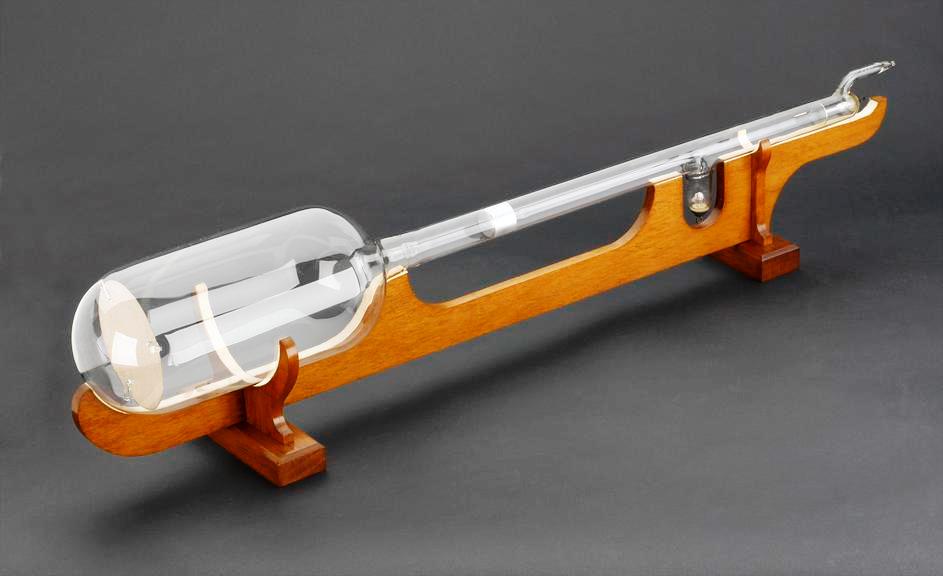
Thus the image would be scanned in a spiral path. This meant that the scanning velocity was continuously changing as it neared the center of its travel. To allow for this a special compensating piece of glass or quartz (which became less transparent at its center) was inserted between the mirror and the object being scanned. As the mirror oscillated in the magnetic field, it supplied synchronizing signals of about 1000 cycles with 18/20 scans per second.
The most important part of this patent was the use of a special CRT. This Braun tube had a hot cathode and a grid which had a negative potential to control the beam. It used magnetic focus, which focused the beam by means of a coil around the neck of the tube. This appears to be the first TV patent to specify the use of a hot cathode to emit a stream of electrons with a modulating grid to control the flow of electrons to the screen. It also specified the use of vacuum tubes for amplification, detection, modulation, and oscillation. This patent had all the necessary ingredients for a practical CRT, but there's no evidence that it was ever built.
1920 H.C. Egerton of Western Electric applied for the first "interlace scanning" patent in 1920. This will become important for video for the next 80 years. While still using mirrors, but the main feature is for two scans per picture to minimize flicker. Getting closer to electronic scanning of a source, in 1922 a Russian, Boris Rtcheouloff, filed a patent for a CRT that scanned by using oscillating springs inside the tube under the influence of external magnetic coils. He also filed for the first known method of recording TV signals via a wire recorder.
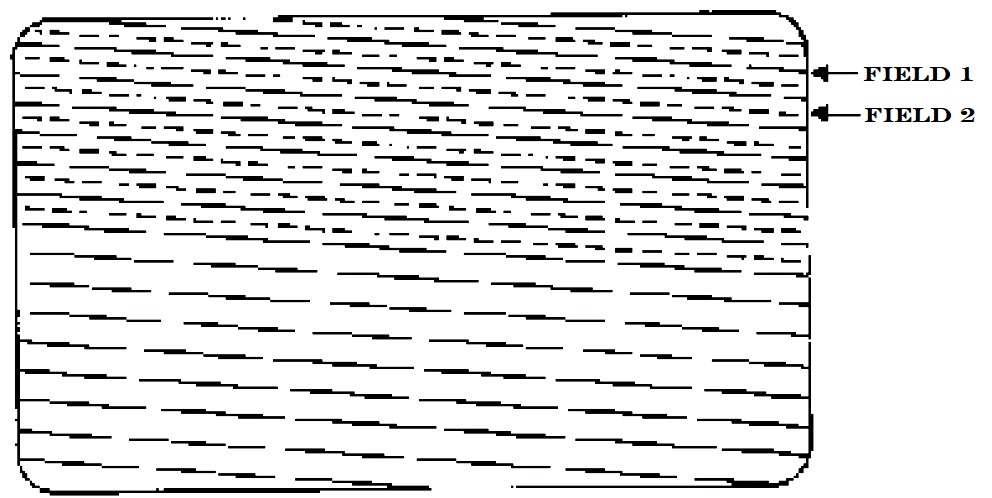
Interlaced Scanning
At the receiving end, the number of scan lines had an additional limiting feature. The phosphors that coated the inside front of the screen in a CRT would only stay visible for a truly short time once scanned by the internal electron beam. That would limit the number of vertical scan lines before the viewing experience would become distracting because of image flicker. As early as 1920 Western Electric applied for the first "interlace scanning" patent. The main feature is for two scans per picture to minimize flicker. The result is the odd lines and then the second scan is adjusted down so that the even lines scans in between where the odd lines were scanned.
Before electronic image scanning using a spinning disk system used a tiny mirror that moved each scan so that a slightly different area of the image was seen by the odd lines, and then the even lines.
1923 found DeForrest making progress in recording sound on film. He called it Phonofilm. Also that year Jenkins, founder of the SMPE, sent the image of a woman's face against a window illuminated by sunlight, via wireless to his laboratory five miles away. While it is a mechanical system, it is the first transmission of TV by radio ever reported.
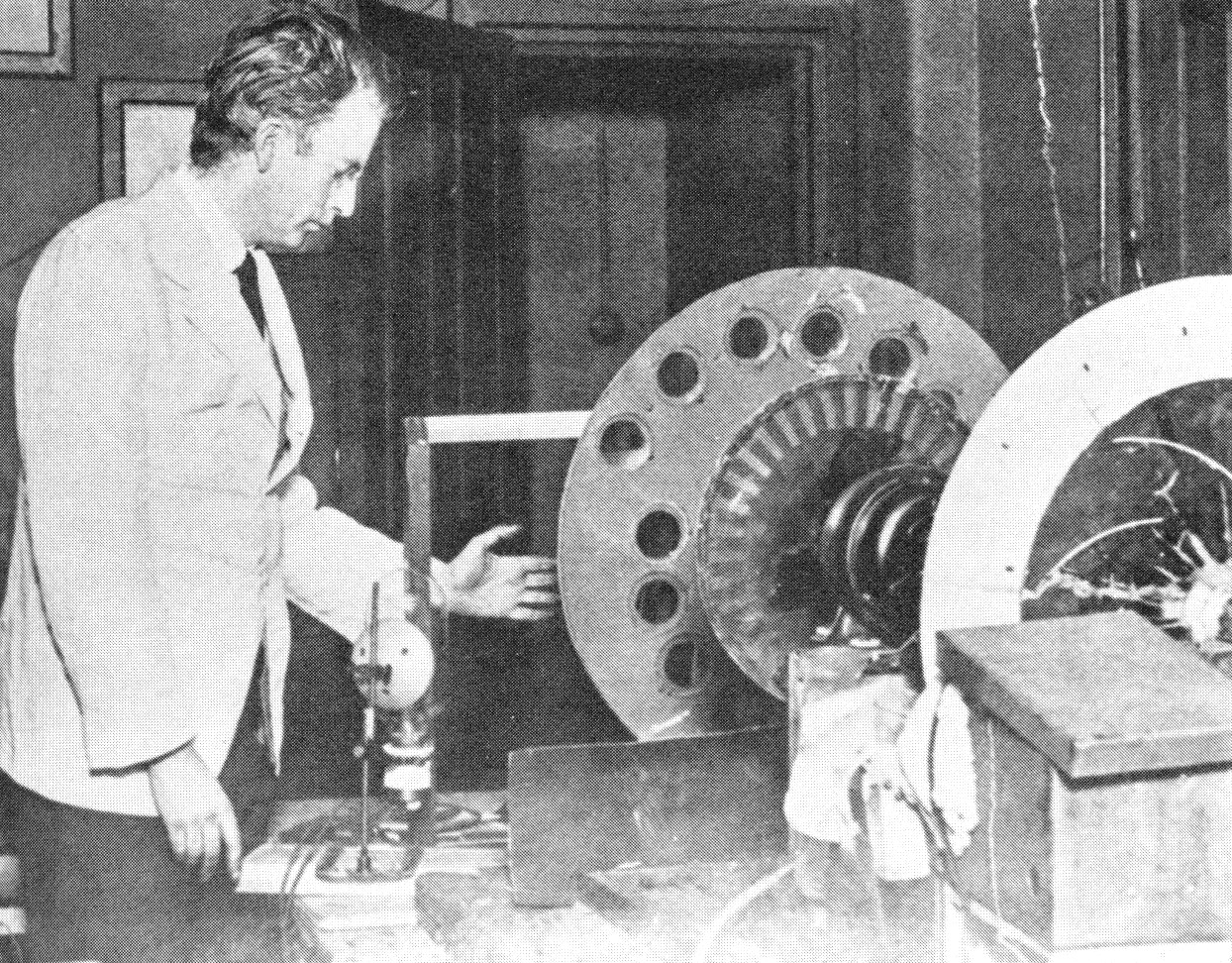
John Baird demonstrating his Nipkow disk type TV receiver in 1925
A few important milestones for television happened in 1923. Maurice de Broglie, a French physicist, and brother of the theoretical physicist, Louis de Broglie, presented a paper indicating that a stream of electrons wavelength, being inversely proportional to the electron velocity. One of the earliest papers covering "electron optics."
Also, a young Scotsman, John Logie Baird, decided he would devote his life to the development of TV, after having failed in several other ventures. He decided that the use of the Nipkow disc combined with modern photocells and a thermionic amplifier could produce a workable TV system. After several attempts he finally advertised for help in June of that year in the London Times. He received a offer of some technical equipment and attracted the attention of Wilfred E.L. Day, a motion picture entrepreneur who saw in Baird an opportunity to invest in the new field of TV. With the financial backing of Day, Baird was able to set up a lab at 22 Frith St in London. Baird filed for his 1st TV patent a month later. It used a simple Nipkow disc arrangement at the transmitter. At the receiver, the image was to be displayed on a bank of lamps arranged to form a screen. There was to be an arm moving synchronously with the disc, moving over a series of contacts to complete the circuits of the successive lamps. Baird soon took out a number of patents.
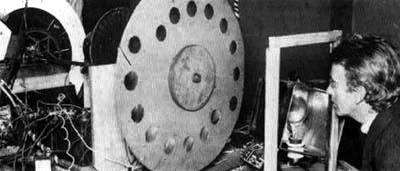
Baird with his apparatus in 1925
His system used the Nipkow disc with 4 sets of 5 holes which revolved at nearly 2000 rpm. Behind it was a serrated disc that fed a selenium cell. The receiver consisted of a disc with lamps arranged in a staggered formation similar to that of the disc at the transmitter.
Additionally, John Hammond, Jr of Gloucester, Mass applied for the first patent describing the "flying spot" scanning of live objects. One variant called for the projection of a light beam, which would be caused to travel in a predetermined path by the use of vibrating mirrors. The light was reflected from the object to a photoelectric system. The subject was in a dark room surrounded by dull black, light-absorbent walls. At the receiver a similar light beam would pass through a pair of Nicol prisms, a polarization cell, and a lens system to a set of mirrors similar to those at the transmitter and in synchronization with them. The modulated light passed to a screen for viewing. It was planned to send 200 line pictures at 16 frames/sec.
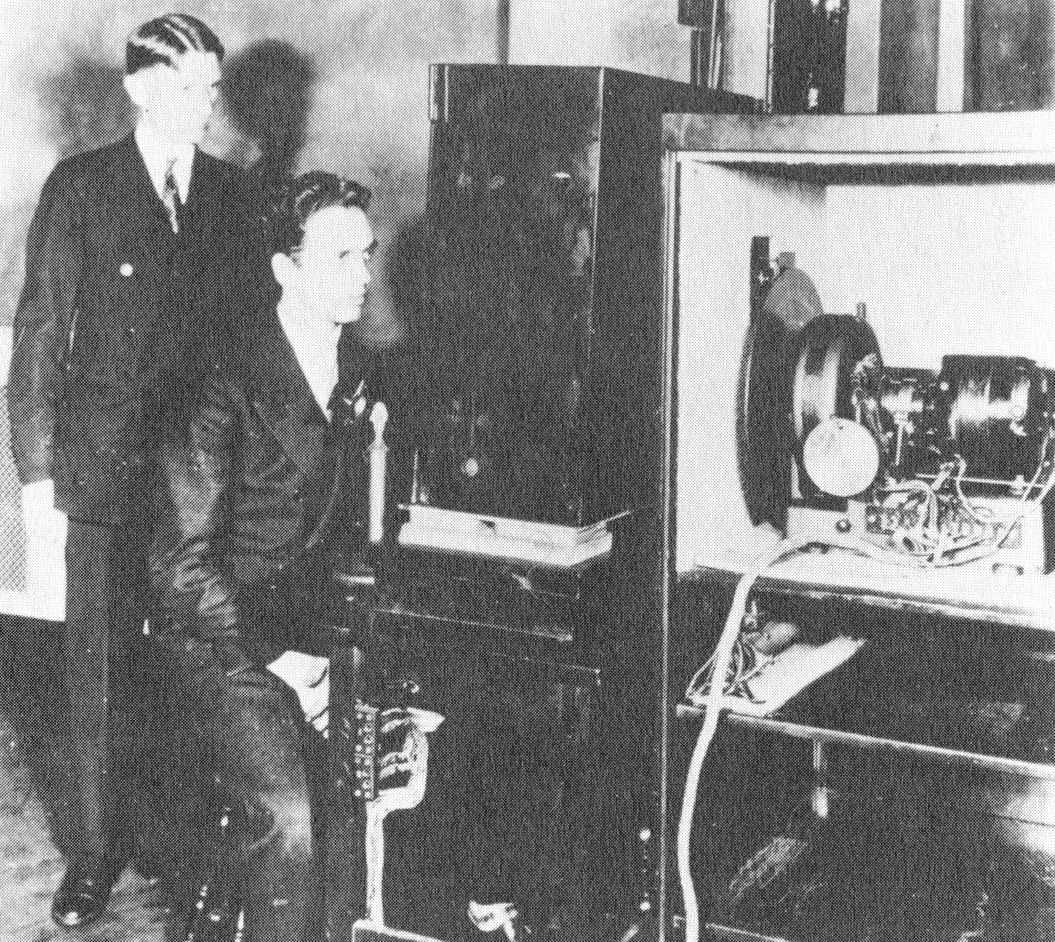
Early Flying Spot Scanner 1927
Most mechanical flying disks in use up until this point simply captured light emulating from the scene by means of a spinning disc that would sequentially allow light through from all parts of the scene. The light hit a photocell that converted that varying light into a signal.
A opposite approach was also tried where a light from the camera scanned the scene and the photocell captured reflected light variations. This approach also used the Nipkow disk to produce the "flying spot" that scanned the scene.
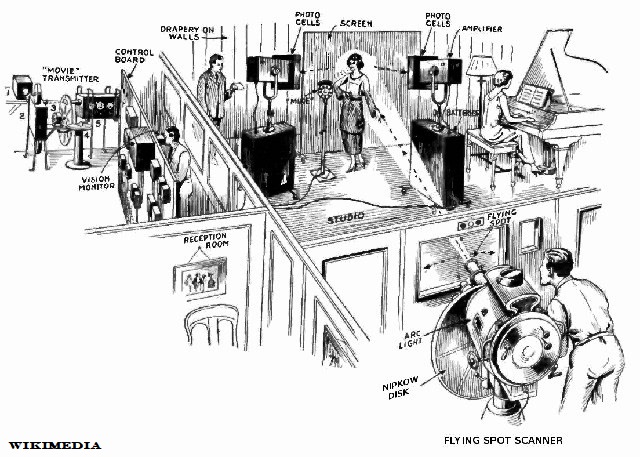
Flying Spot Scanner Studio Infrastructure
Here you can see that the "camera" is actually only the light source that scans the scene, and it is the photocells near the talent that captures the changes in light levels.
At the end of 1923, another prolific inventor in the television realm, Vladimir Zworykin of Westinghouse in Pittsburgh, applied for a patent covering an all-electric television system. The camera tube portion was the subject of 11 patent interferences, and thus caused many delays in the patent process. Zworykin had left Russia and arrived in the U.S. in 1919. He joined Westinghouse in 1920 but left for C & C Development Co of Kansas City. He returned in 1923 with an agreement regarding his TV patents; he retained certain rights to his prior inventions while Westinghouse acquired an exclusive option to purchase his patents at a later date.
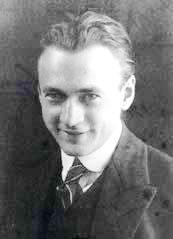
Zworykin's camera tube patent application was patterned much like Swinton's plan in 1911. It differed in that Swinton had disclosed a mosaic made of rubidium cubes, and Zworykin disclosed a plate covered with a layer of photoelectric material. The plate was made of aluminum foil so thin that it could be penetrated by a cathode beam. This plate supported a layer of aluminum oxide that insulated the photoelectric material. This was preferably potassium hydride deposited in a layer. The entire tube was to be filled with a low pressure gas such as argon. There was much controversy that the tube would actually work as Zworykin described it.
Vladimir Zworykin
The next year George J. Blake and Henry D. Spooner of London applied for a patent that covered a TV system that used a camera tube that had a plate covered with selenium. The electron beam impinged on the same surface and since light would change the resistance of a given spot on the surface, the amount of beam current would change as it scanned across the plate.
Also that year Westinghouse applied for a patent where an oscilloscope tube would deflect electron beans at low velocity and then accelerate the beam to high velocity to hit the target, which made for a brighter result. That same year saw Dr. Ernst Alexanderson of GE get interested in TV. GE produced a mechanical system and was able to send a very crude image over WGY, GE's radio station in Schenectady, NY. Towards the end of that year RCA transmitted a facsimile of a photo from New York to London. Took 20 minutes. In January of the next year AT&T sends still photos over phone lines.
1925 saw Frank Gray of AT&T working on the flying spot system, which was soon adopted for motion pictures. They actually transmitted motion pictures in July of that year. Dr. Herbert E. Ives, who ran the AT&T development group proposed the use of motion pictures as a means of "chemical amplification" where the film is exposed and rapidly developed and fed to a projector with only a few second's delay. Ives felt that this was the most feasible way of increasing the sensitivity of the video transmission end.
Zworykin stayed busy in 1925, applying for a color TV patent. His proposed picture tube was made up of red, blue, green squares. It was claimed that each square would be absorbed in such a manner that a corresponding display screen with corresponding squares would reproduce the color scene.
During this time, there was evidence that Zworykin built and actually operated an all-electronic television system. It used modified Braun tubes at both transmitting and receiving ends. It was claimed that the receiver was built using parts of a Western Electric cathode ray oscilloscope.
The pickup tube consisted of a metal screen with an insulating layer and photosensitive substance on top of the insulation. Glass cloth gave the most promising results, except for the matter of electric leakage due to sealing of the tube. Cloth made of quartz or Pyrex glass would prove to be more suitable, but no supplier could be found. His image capture tube was the first electronic tube ever actually produced. Zworykin gave a demo to Harry P. Davies (VP of Westinghouse), Sam M. Kintner (head of research laboratories), and Otto S. Schairer (director of the patent department). But the demo was poor. His superiors left with the admonition that he goes to work on something more useful. He was told to work on better photocells, sound movies or something that had more commercial promise. So the work was stopped temporarily in order to work with the mechanical method of picture transmission that was progressing.

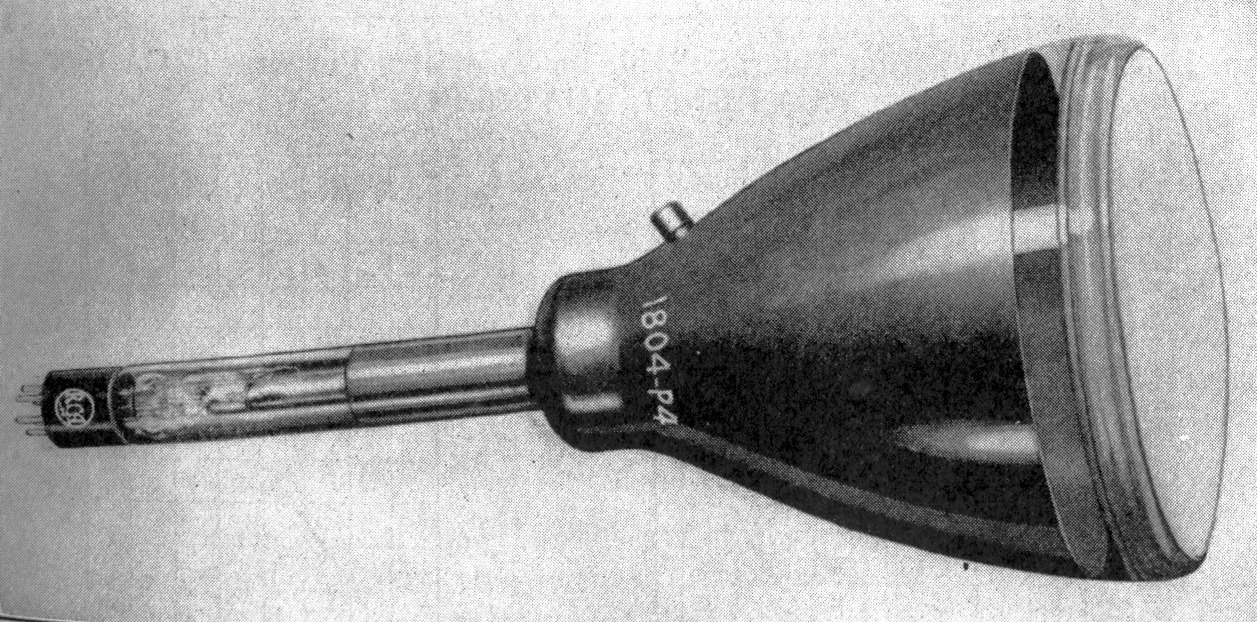
Early Display Cathode Ray Tubes
Beginning of 1926 Baird also applied for a patent on a flying spot system. At this time Baird had gone as far as he could with his crude insensitive equipment, so he reversed the scanning process, the same as Dr. Gray of Bell Labs did. Baird had no interest in using film like Bell as he thought television should be instantaneous. The flying spot method allowed for the capture of more grayscale information. Baird started demonstrating his latest system. It was said that Baird invented a super sensitive photocell which he kept secret. He always kept his transmitter under cover and used the excuse that the system wouldn't work if light seeped inside. There were many wild stories about how his system worked, one was something called "visual purple" and other such nonsense. Others claimed exotic use of transformers or other circuits. The secrecy was really just to hold off competition to his simple but effective methods. It was soon realized that while the flying spot could be patented, it could not be protected.
Soon many systems were made by others for publicity purposes, and some were repackaged and masked to hide the fact that they were someone else's contraption. Even the British Admiralty Research laboratory and the Air Ministry Laboratory, and the Imperial College started investigating TV for military use. These were mechanical systems. Reginald S. Clay filed a patent for synchronization that uses straight line scanning (Nipkow disk scanning was slightly arced) with quick return with the addition of a pulse at the end of each scan for synching the receiver.
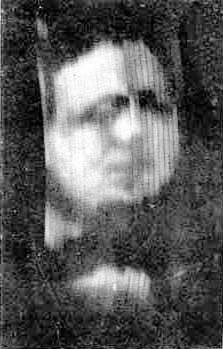
Eventually Baird went back to his original approach and gave up on the "flying spot" method. In 1926 he gave the first public demonstration of his television images for members of the Royal Institution and a reporter from The Times. In August of that year Baird obtained the first license to transmit television over station 2TV, from the BBC. The transmitter operated on 200 meters with 250 watts of power. It was soon reported that faces were perfectly distinguishable, with smooth gradations of shade, bright highlights, dark shadows and were perfectly recognizable.
The first known photograph of a moving image produced by Baird's "televisor"
The next year Baird transmitted a long-distance television signal over 438 miles of telephone line between London and Glasgow. Baird set up the Baird Television Development Company Ltd, which in 1928 made the first transatlantic television transmission, from London to Hartsdale, New York, and in 1929 the first television programs are officially transmitted by the BBC.
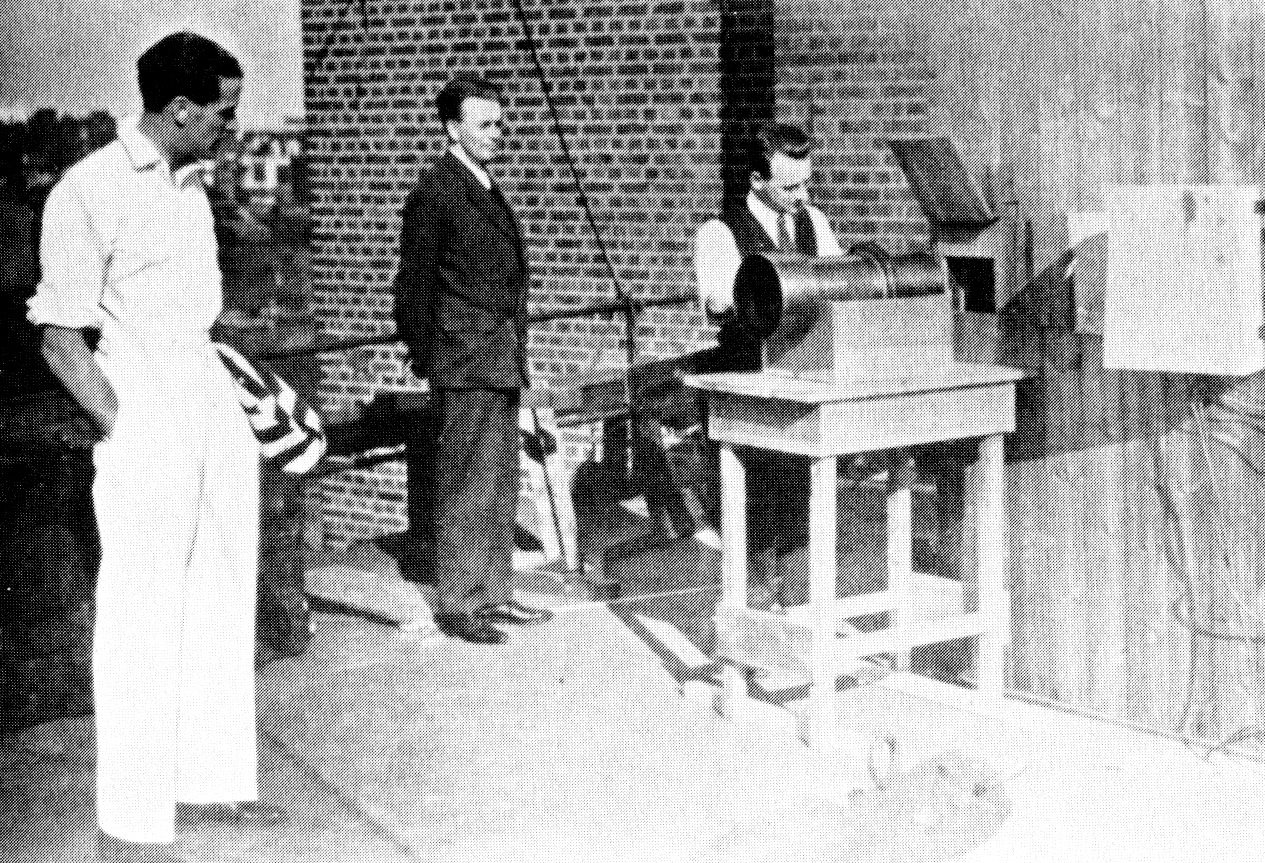
1928 outdoor demostration by Baird
Actually only the lens is outside, with his penchant for secrecy, the spinning disk camera is indoors on the other side of the opening.
Philo Farnsworth was another prolific television engineer and inventor. For a while it appeared that his efforts might supplant RCA's and the Radio Group's efforts. He was born in 1906 and was the eldest of five children. When he was 12 his family moved to a relative's ranch near Rigby, Idaho. Farnsworth's new home was wired for electricity, with a generator providing power. He quickly mastered the basics of mechanical and electrical technology. He repaired the generator when needed and repaired other motors and devices he found around the ranch. He even converted his mother's hand-powered washing machine into an electric-powered one.
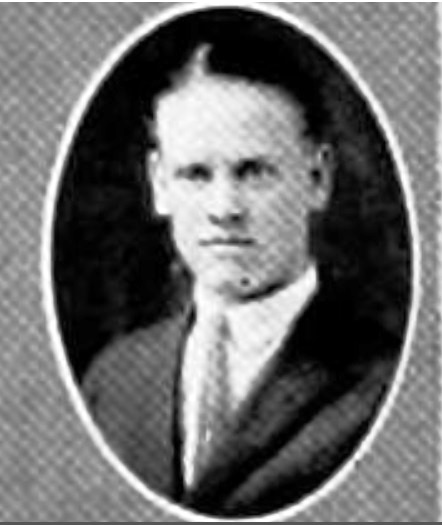 Farnsworth excelled in science in high school. In high school he started contemplating a television system of his design and asked his science teacher for advice. One of the drawings that he did on a blackboard for his chemistry teacher was recalled and reproduced for a patent interference case between Farnsworth and RCA later.
Farnsworth excelled in science in high school. In high school he started contemplating a television system of his design and asked his science teacher for advice. One of the drawings that he did on a blackboard for his chemistry teacher was recalled and reproduced for a patent interference case between Farnsworth and RCA later.
Farnsworth's 1924 High School yearbook photo
When he was 17, the family moved to Provo, Utah, and Farnsworth attended Brigham Young High School. When his father died of pneumonia in January 1924 young Farnsworth assumed responsibility for supporting the family while also finishing high school. After graduating in June 1924, he applied to the United States Naval Academy where he earned the nation's second-highest score on academy acceptance tests.
As a budding inventor when he learned that the government would own his patents if he stayed in the military, he managed to obtained an honorable discharge before actually joining, invoking a provision in which the eldest child in a fatherless family could be excused from military service to provide for his family. Instead he enrolled in Brigham Young University. He secretly attended upper division science classes when he was not considered qualified to do so and made use of the university's research labs.
He developed a close friendship with his future brother-in-law, who shared his interest in electronics, and the two moved to Salt Lake City to start a radio repair business, which soon failed. While his partner went back home Farnsworth stayed in Salt Lake City. He met Leslie Gorrell and George Everson, a pair of San Francisco philanthropists, who agreed to fund his early television research with an initial $6,000 in backing and set up a laboratory in Los Angeles for Farnsworth to carry out his experiments.
After Farnsworth married in 1926, they moved to Berkeley, California, and he soon applied for his first television patent, which was not granted until 1930. They eventually moved across the bay to San Francisco, where Farnsworth set up his new lab at
202 Green Street.
Everson and Gorrell agreed that Farnsworth should apply for patents for his designs, a decision that proved crucial in later battles with RCA. As we have seen up until this time almost all television systems used "Nipkow disks." Farnsworth, like Zworykin, recognized the limitations of the mechanical systems, and that an all-electronic television system would be needed to reach the required resolution.
On September 7, 1927, Farnsworth's image dissector camera tube produced its first video. It was reported by Farnsworth's wife many years later that he said, "There you are-electronic television!" Farnsworth's image dissector had a major weakness though. It was not vary sensitive and required a lot of light. An extremely bright source was required. The source of the image that day was a glass slide, back-lit by an arc lamp. But at that time Farnsworth had the only operating camera imaging tubes in the world
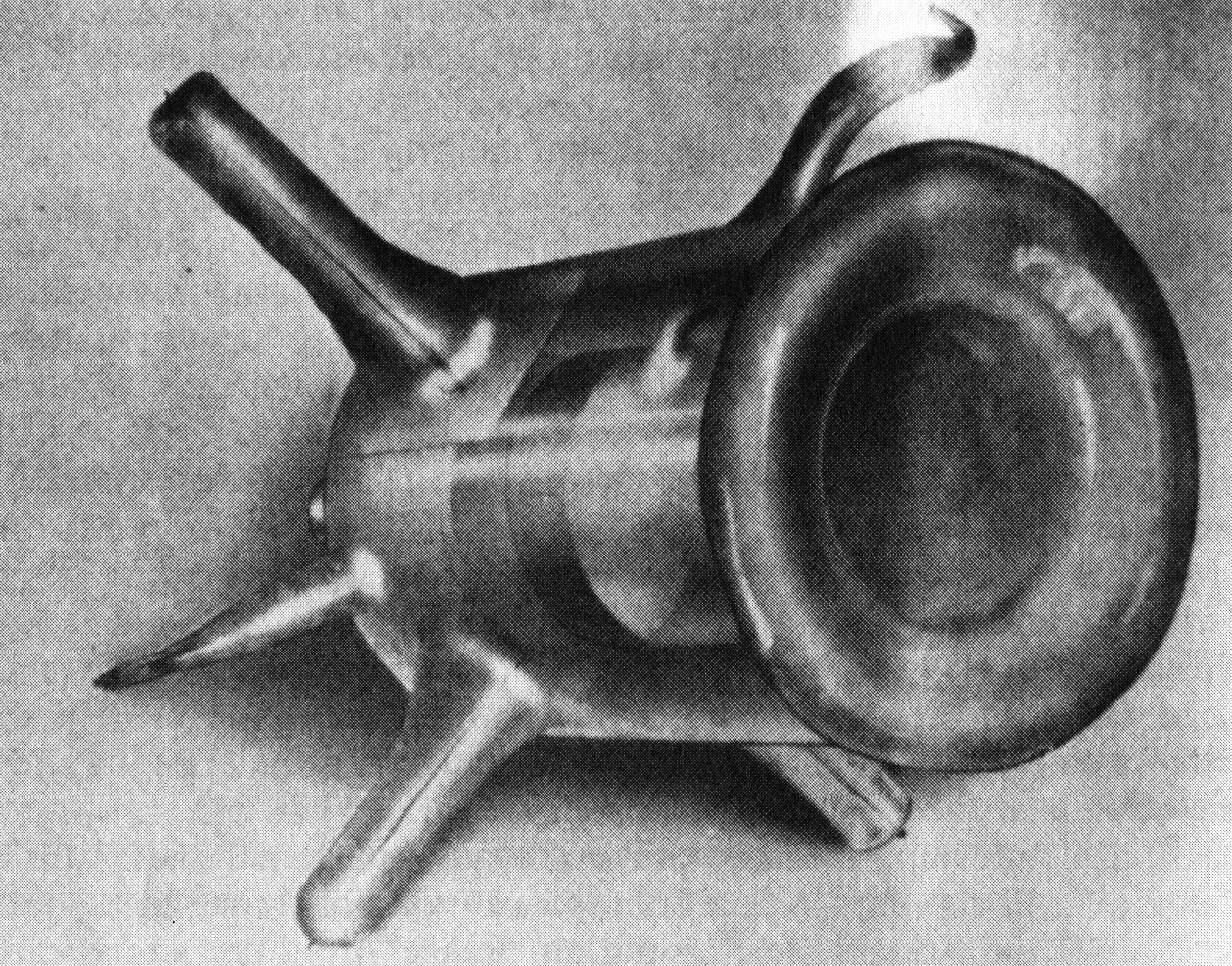
Early Camera "Pickup" Tube
Philo Farnsworth, was most likely the first to develop an all electronic system. Here is a early "Image Disector" tube that captured an image (formed by a lens in front) on the "target" area of the tube.
By 1928, Farnsworth had developed the system sufficiently to hold a demonstration for the press. His backers had demanded to know when they would see monetary return from the invention. Of course the first image shown was a dollar sign. Also that year Farnsworth applied for a patent for a synchronizing system which involved a shadowed border around the picture being transmitted, which was generated by a motor-generator. The shadow consisted of 1500 cycle signals. As we will see in 1929, the design would become truly all electronic, when that motor-generator to generate synchronizing pulses for the receiver is eliminated and electronic circuits take its place. That year Farnsworth also transmitted the first live human images using his system. That image, of his wife Pem, was displayed on a three and a half-inch CRT.
Already Farnsworth was battling with RCA and the Radio Group, as in 1928 Farnsworth lost a couple of patent interference claims against Zworykin.
At the beginning of 1928, another member of the radio group, GE, demonstrates TV from its research laboratories station in Schenectady under the supervision of Dr. Alexanderson. The picture was transmitted from station 2XAF on 37.8 meters. The sound was sent on WGY's regular AM radio frequency of 379.5 meters. The picture was 48 lines at 16 fps. A flying spot system was used at the studio. Receiving quality was claimed to be good. The receivers used a neon lamp. The image was 1.5 inches tall, and 1 inch wide. A magnifying glass was used to make the picture about 3 inches in size. This was the first demonstration of television by radio using "home receivers" instead of laboratory instruments. The receivers were in the homes of Alexanderson and GE execs E.W. Allen and E.W. Rice, Jr. Shortly after Ray D. Kell, also of GE applies for his first patent covering color TV. It was a two color system, and it was a disk based system.
RCA was permitted that same year to operate W2XBS, on 2000-2100 KC (142.8 meters). It used 48 line, 16 frames/sec receivers, which were furnished by GE. It was located at
411 5th Ave
in New York City, the home of RCA Photophone.
1928 was a busy year in television development. In July Baird demonstrates color TV to the press and a party of scientists. It used 3 sets of spirals. Similar discs were at the receiver. In August, Westinghouse's KDKA demonstrates a system of "radio movies." This was done under the auspices of Harry P. Davis a VP of Westinghouse, who gave credit to Dr. Frank Conrad for bringing the device to its present state. The test sent a video and audio signal two miles. The composite signal operated on three frequencies: pictures on 150 meters, sound on 63 meters, and a special synchronization signal on 90 meters. It was 60 lines at 16 frames/sec. A special 35mm film projector was scanned with a 60 hole rotating disk. The film projector used with these systems were continuous movement, not intermittent like most projectors are, and the disk with holes captured each frame.
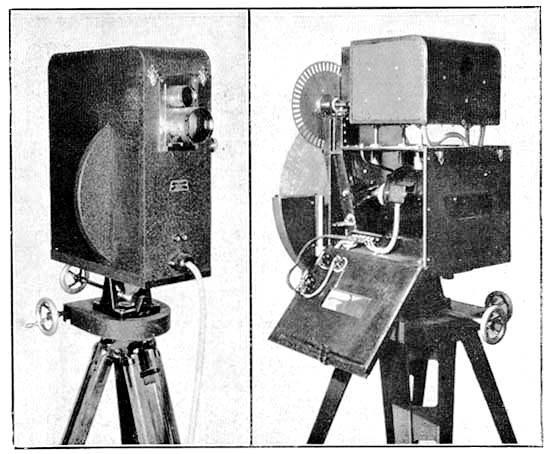
Nipkow Disk camera at it's Zenith
Also by 1928 Mechanical cameras were getting to a size to be considered "portable." GE and AT&T provided outdoor demonstrations.
Other 1928 television firsts, August again, Baird demonstrates stereoscopic TV at his lab. He used a scanning disc with two sets of spiral holes, each had its own light source. Also in August, GE attempted the 1st outside remote broadcast, it was a Governor Al Smith speech at the capitol in Albany for the Democratic nomination for the presidency. The "camera" was a new portable flying spot scanner of GE. It was a simple box in which the light from a 1000w bulb was projected through a 24-hole scanning disc. This box was accompanied by two tripod-mounted photoelectric cells, which were to pick up the reflected light from the subject and convert it into electric signals. Technically, although it was a daylight pickup, the main source of light came from the camera, the same as used indoors with a flying spot scanner. This was sent 18 miles away by wire to station WGY. The rehearsals went well, but the real event was spoiled when the enormous arc-lights of the newsreel cameras overwhelmed the light emitting from the GE camera.
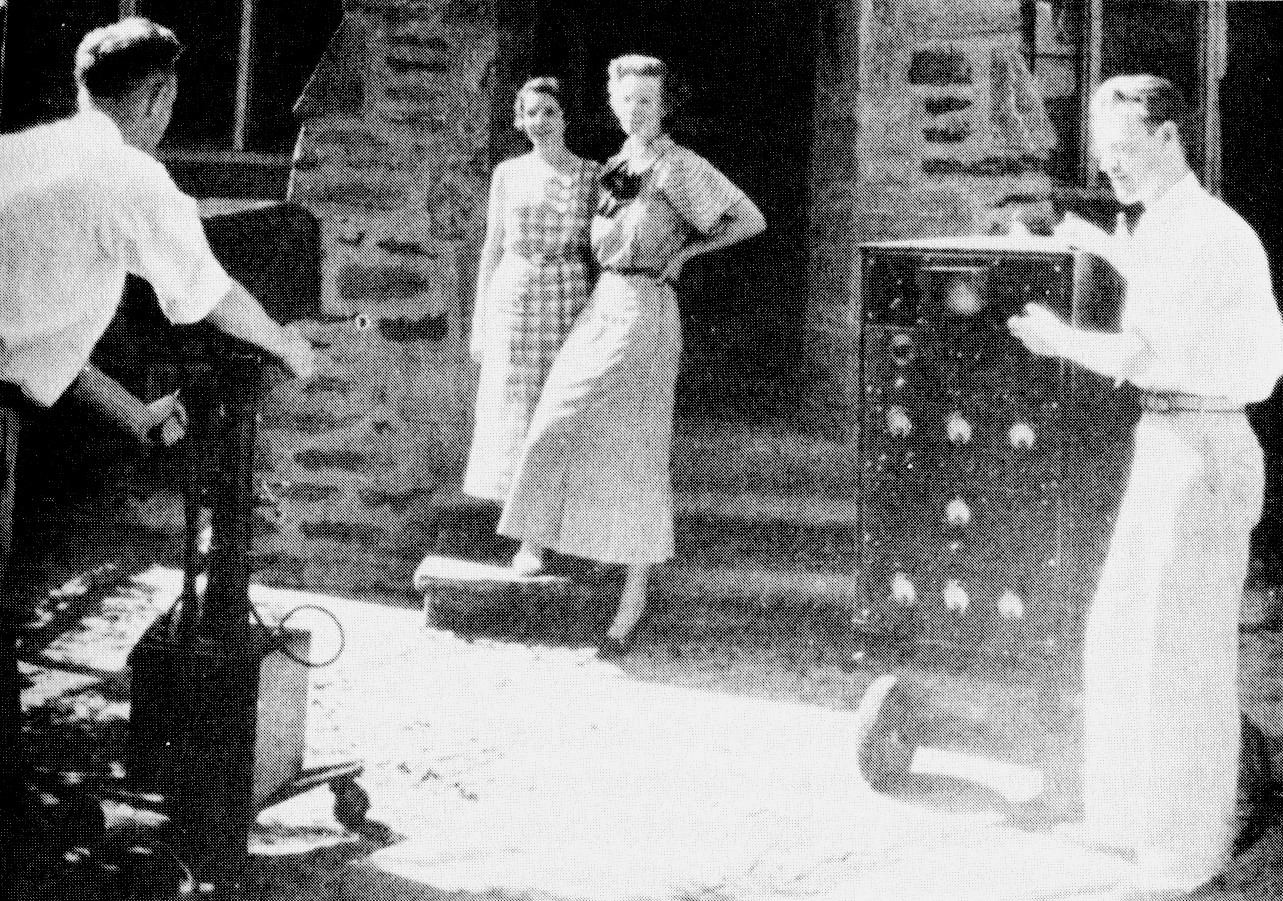
August 1928 also saw Farnsworth give a private demonstration of his TV system to the Pacific Telephone Co. It was reported that the picture was rather low intensity on a screen 1.25 by 1.5 inches big. Images were hard to identify, but motion was easily followed. The phone company was impressed by the photoelectric transmitter tube (the dissector) and that all scanning was done electronically. He also did a demonstration for the San Francisco Chronicle at the beginning of September. It was 60-line 20 frame/sec video with about 8000 elements of resolution. It was reported that the image was 1.25 inch square with a "queer looking little image in bluish light now, that frequently smudges and blurs." The Chronicle's article claimed that the basic principle had been achieved and that perfection was a matter of engineering. It mentioned the lab was at 202 Green St and that the financial backers were W.W. Crocker and Roy N. Bishop. At this time Farnsworth still had the only operating camera tubes in the world.
Demonstration of Farnsworth all-electric camera system
Also in September GE's WGY Schenectady "telecast" the first TV drama, "The Queen's Messenger." The picture and sound were broadcast over separate channels. Three flying spot cameras were used, each containing a 12in, 24-hole scanning disc driven by a small synchronous motor. Behind the disk was a 1000w lamp, the light was concentrated by a lens. Another lens on the outside of the box projected the light onto the subject.
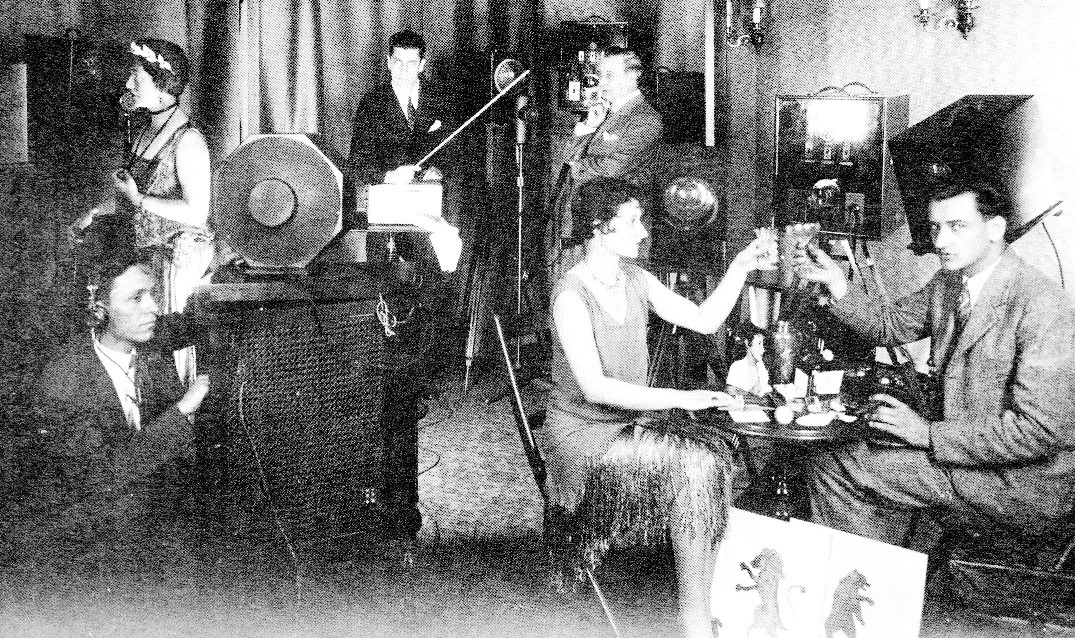
These were the same cameras that attempted the Albany "remote" pickup. The director had a monitor screen to watch the progress of the program and controls for fading from one camera to another. The program was witnessed by a group of newspapermen and scientist gathered in one of GE's buildings. It was reported that the pictures were small, sometimes blurred and confused, not always in the center of the screen and hard on the eyes because of the flicker. One of these cameras would be on display at the Radio World's Fair held in New York City later that month. It was part of the GE exhibit, which also included a demonstration of a large-screen TV projector. This "large" projected picture was 12 x 12 inches onto a silver screen by a 5 inch projecting lens.
Toward the end of 1928 there were about 12 stations actually broadcasting pictures in the US at some time during the day or were planning to. Six were using 48-hole scanning, 3 were using 24-hole scanning, and one each using 60, 45, and 36 holes. The number of pictures/sec varied from 7 one-half to 21. On top of these at the end of October Bell Labs reported work progressing on 72-hole disk to replace there then current 50-hole disk. It would require a bandwidth twice the 50-hole system. The system was demonstrated right before Thanksgiving. As a result of all these incompatible systems, the Radio Manufacturers Association (RMA) formed a "Television Standards Committee" on October 9th, to try and standardized to a single system.
In order to slow the spread of TV in the broadcast band, stations were only allowed to broadcast only one hour per day and forbidden to do so between the hours of six and 11 pm to minimize interference with AM stations. The Federal Radio Commission restricted the hours of all still-picture transmission and television until the end of 1928. After that date all TV would be in a special band above 1500 kc.
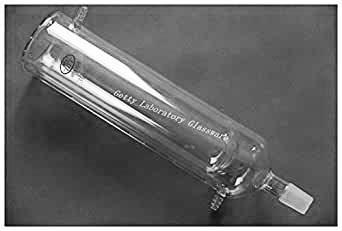
Continuing on in the year, Zworykin tried, but was unsuccessful, to get Westinghouse to build an improved version of his idea for the CRT. He decided on separation of the function of beam modulation, deflection of the beam while at low electron velocities, and finally, electron beam acceleration for high brightness by means of a high-voltage second anode in the form of a metallic coating on the inside of the glass bulb. This would provide a path for the electrons to return to the electron gun, thus preventing the screen from charging up. As true of many great inventions, while all these elements were in existence, it took Dr. Zworykin's genius to put them together.
Then at the end of 1928 Zworykin visits Sarnoff. Sarnoff was then the executive VP of RCA and was about to go to Europe to participate in the German Reparations Conference from 2-1-29 through 6-29. Sarnoff asked Zworykin how much it would cost to produce a workable TV system. Zworykin said that "it could be done in two years at a cost of one hundred thousand dollars." Zworykin told Sarnoff that the "basic instrument was already operative but required extensive and expensive development." There have been inferences that a crude camera tube was the instrument referred to by Zworykin, but it was known that Zworykin had no camera imaging tube either being built or working at this time. He did have a crude picture tube built from the Dewar flask operating in his laboratory. Sarnoff was convinced and had Westinghouse give Zworykin additional financing, staffing, and equipment. Soon an order was given for a shipment of glass picture tube blanks from the Corning Glass Co.
In January 1929 Farnsworth hires Harry L Lubcke, a young EE from University of California whose main project was to help Farnsworth develop a completely electric scanning generator. Farnsworth had been using 500-cycle motor generators to generate his sine-wave scanning currents. Sine-wave scanning produced double images as it was impossible to keep the two-half cycles in exact phase, and it produced "shaded" pictures as a result of the variable speed as it scanned the picture. Farnsworth had turned to tuning forks as a means of synchronization and finally to vacuum tubes to produce his scanning pulse.

By July of that year Farnsworth and Lubcke had developed an electric scanning generator that produced sawtooth currents and special pulses to eliminate return scan lines. This was the first all-electric TV system in the world. He had his dissector tube all-electric camera, a magnetically focused high vacuum CRT for viewing, and a vacuum tube scanning and pulse generator. There were absolutely no moving parts in the system.
Earlier that year actual work on another all-electric system got going. The Zworykin TV system began in earnest on February 1st, 1929, with the first shipment of glass bulbs from the Corning Glass Co. Zworykin did not have a working camera tube at the time so he decided to use a standard Simplex movie projector that had had its intermittent removed as a source of picture signals. An oscillating mirror was to scan the motion picture frame as it rolled by. A relay lens system focused the beam onto one part of the photocell. It was planned to use sine-wave scanning for the horizontal scan as it simplified the scanning process with both the oscillating mirror and the scanning coil being fed by the same simple sine-wave generator. Vertical scan was a linear process, however, with a toothed wheel driven by the film to indicate the start of each frame. A contact on the wheel would discharge a condenser circuit, indicating a new picture frame. The patent applied for regarding this was mainly concerned with the synchronization of film frames and had little to say about the receiving tube.
As promised by Sarnoff there were several engineers on the project assisting Zworykin. Among them were an optical engineer, picture tubes designers, along with engineers for video amplifiers, deflection circuits and high voltage supplies. By April of that year they had a satisfactory display picture tube. The image tube simulator, the film projector was completely assembled by the end of April.

1929 was shaping up to be a monumental year also. About the time that Zworykin's project was ramping up Dr. Frank Gray and John R. Hofele of Bell Labs applied for patents first revealing the spectral distribution of the video signal. They proved that information in the signal was bunched at certain intervals, leaving huge gaps with relatively little information.
While this is the spectrum of a modern analog color video signal, the concept is the same. The farther right you go, the higher the frequency. Higher frequencies relate to high resolution. The middle peak is where the color information is in a modern analog signal. The peak all the way to the right is the audio carrier.
Also at the beginning of February of that year, GE transmits both the pictures and the accompanying program sound from their studios in Schenectady to Los Angeles via their short wave station W2XAF, for video, operating on 31.48 meters, and the voice was carried on station 2XO at 22.5 meters. That appears to be the first nationwide telecast of both light and sound.
On February 11th of the same year Bell Labs reveals that they had produced "flying spot" equipment suitable for the "real time" recording of TV images on 35mm film. This was done using a special quartz, mercury lamp, and a special rotating disk with a series of slots, that formed a beam of light in successive parallel lines across a piece of continuously moving film. Gray claimed that they were actually recording 50-line TV images at 18 images/sec. Samples of these recordings have survived. Thus TV recording was essentially born. This apparatus was considered to be part of the Bell Labs scheme for the projection of TV images on a large screen almost simultaneously with their reception as mentioned earlier.
In March RCA completes installation of television equipment at 411 Fifth Ave. At that time RCA had decided to go with the Westinghouse standard of 60 lines at 20 frames/sec, instead of GE's 48 lines at 16 frames/sec. In April RCA presented a paper calling for some tentative standardization of the TV signal. All the while, while RCA appeared to move forward with the development of television, it was quite careful to follow General J.G. Harbord, president of RCA, and V.P. Sarnoff's policy not to interfere with the highly successful radio operation of NBC. That said it was still reported that not only was "conservative RCA" broadcasting TV on a regular schedule but there were rumors of impending RCA TV receivers. Some of this was coming due to the fact that in June RCA TV station W2XBS was then telecasting two hours a day, from 7 to 9 pm.
When Sarnoff finally got back from Europe in June he was not happy that a new plan involving the Victor Company that perpetuated the old system of having multiple sets of engineers and managers, from RCA, GE, and Victor, each going its own way in the Camden plant. Sarnoff objected strenuously and offered to resign if the plan was not changed to have a single, united management under his control. At the beginning of October his demand was satisfied, and on the day after Christmas a new entity, the RCA Victor Company, was incorporated. RCA owned 50% of the company, GE owned 30% and Westinghouse, 20%. The new arrangement had two obstacles, the deepening depression, and the filing of an antitrust suit by the DoJ, which we previously discussed.
The pace of working towards practicable television continued at a breakneck pace through the rest of 1929. Advances in interlace scanning, and synchronization continued. While, with the exception of Farnsworth's camera, the transmission end was still mostly a mechanical affair. In July of that year Zworykin, and his Westinghouse team, demonstrated his latest system to a group of RCA and GE engineers. The next month the system was shown to Dr. Alfred Goldsmith, who had set up RCA Labs, which was rapidly becoming one of the most important corporate research laboratories in corporate history. He and other RCA management were so pleased that they asked for nothing to be changed except to package the parts into six home receivers to be sold by Christmas, 1929.
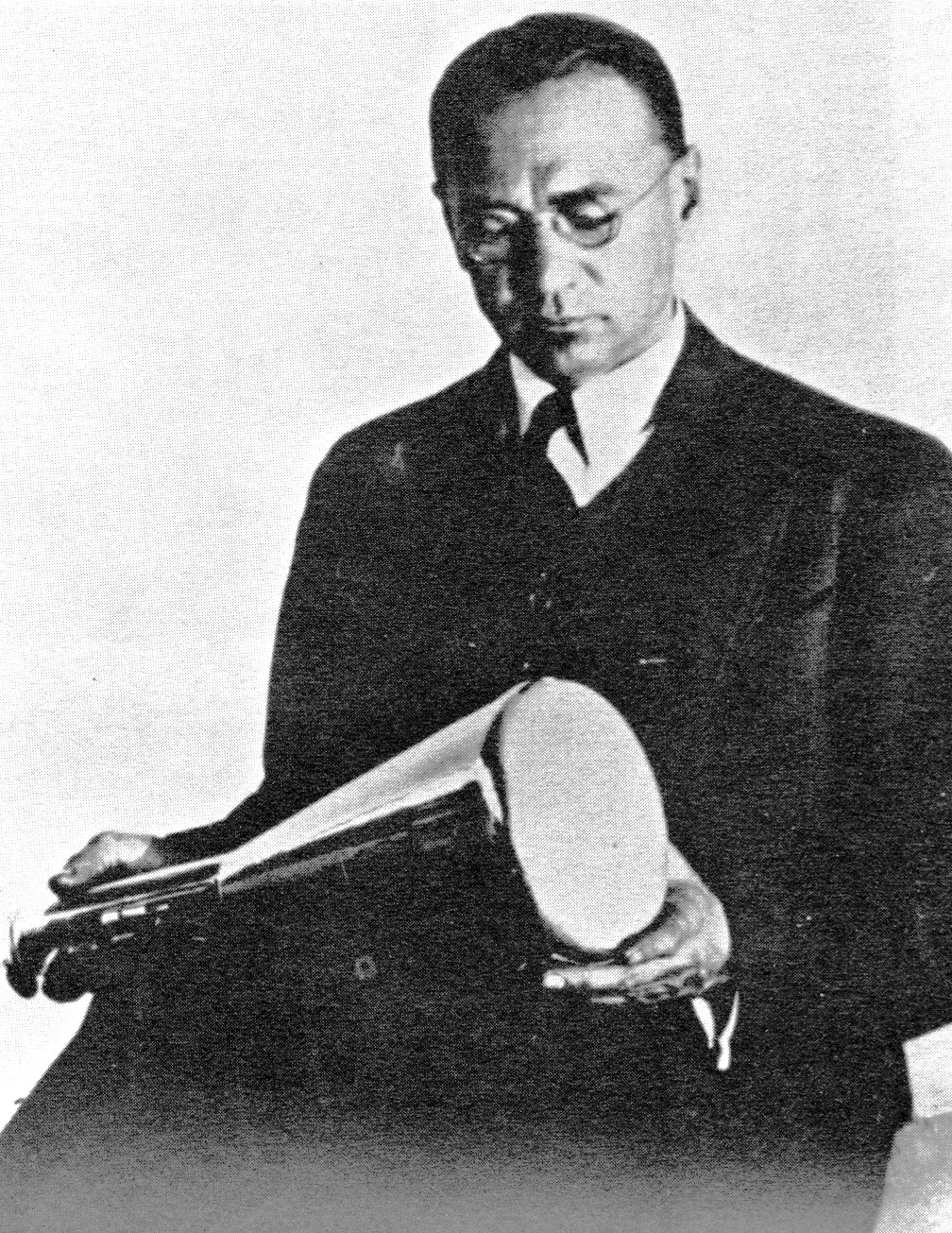
Zworykin with an his kinescope or CRT 1929
About this time Zworykin, having considerable success with his new picture tube, now decided to develop a CRT for the transmitter as well. The advances in focusing and controlling display CRTs helped in the replacing of a phosphorous raster for displaying images, into a photosensitive target for scanning an image.
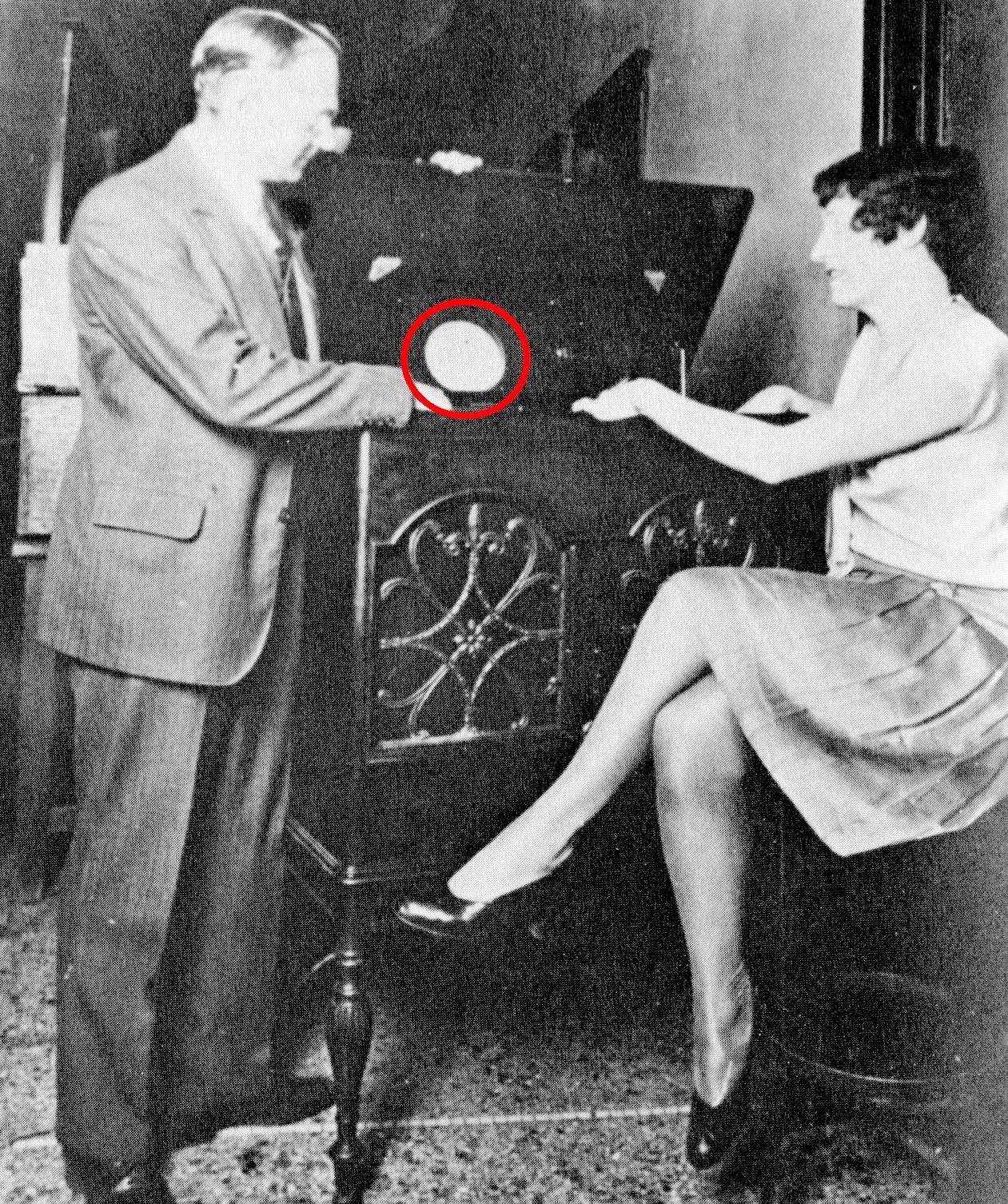
In August Westinghouse's KDKA began broadcasting motion pictures daily using the Conrad TV system. Zworykin used the Westinghouse transmitter between 2-6 am three times a week. KDKA was on 150 and 90 meter wavelength. Zworykin claims that film of 60-line at 12 frames/sec was quite well received at his home.
Zworykin with a Westinghouse television receiver in his home.
The actual display is circled
Many doubted Zworykin's claims do to the limitation's others knew about the CRT. Also the secrecy that descended upon the Kinescope didn't help.
In November GE applied for a patent for a camera imaging tube. At the end of 1929 all-electronic television systems are being worked on at GE also.
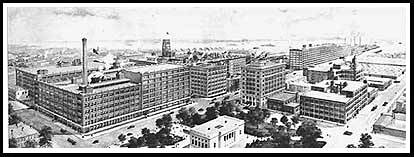
Victor Co. facilities in Camden
now the center of RCA research activity
At the start of 1930 Sarnoff became president of RCA. At this time all TV activities of RCA were to be concentrated in the new facilities at Camden. In addition GE was to turn its Harrison Tube plant and Westinghouse its Lamp Works at Indianapolis over to RCA. Dr. W.R.G. Baker of GE became the chief engineer of RCA Victor. Two engineering groups were set up at Camden, the Advanced Development Division, which had Radio Receivers, Acoustics, and Television. The television group was head by Zworykin. There was also a General Research Group. A separate Technical and Test Department, continued to run the RCA transmitter from 411 5th Ave.
1930 Jenkins TV company actually offered TV receivers for sale. To support sales the company had two transmitters in operation, W3XK in D.C. and W2CXR in Jersey City. RCA was also offering an extremely limited number of sets. 1930 also saw a number of long distance television transmission tests. In February GE made two long-distance tests of TV images from Schenectady to Australia and back, and a second to California and back. The image was a simple rectangle drawn on white paper. The received image alternated from single to multiple images and at times was quite sharp. The California test gave better results.
Also in February Alan Archibald Campbell Swinton died. He was the first person to document a proposed all-electronic television system. He was never to know that at this time camera tubes similar to the ones he described in 1911 were being built by Zworykin in Camden. It was claimed that Zworykin started work on two-sided tube "targets" for camera tubes as soon as he moved into the new laboratories in Camden. He had moved from Pittsburgh as his activities were now being done under the RCA tent.
In March Farnsworth applied for a patent covering an electron multiplier. This was done by modulating an electron stream and using a pair of opposed surfaces to liberate electrons by secondary emission. This would greatly increase the sensitivity of his pickup tubes, which up until then were poor.
Then in early April Zworykin was invited by the firm of Carroll W. Knowles Co, which had acquired an option to buy the stock of Farnsworth TV Company to come and visit the Green St Farnsworth labs. This was done without Farnsworth's knowledge. The early effects of the deepening depression had some of Farnsworth's stockholders anxious to sell out. However Farnsworth found out and it is reported that he was delighted and prepared to show Zworykin all he had accomplished. Farnsworth knew of Zworykin's work due to the patent interferences between them and had a very high regard for Zworykin. As a result he welcomed Zworykin as a future ally or at least as a source of much needed financing.
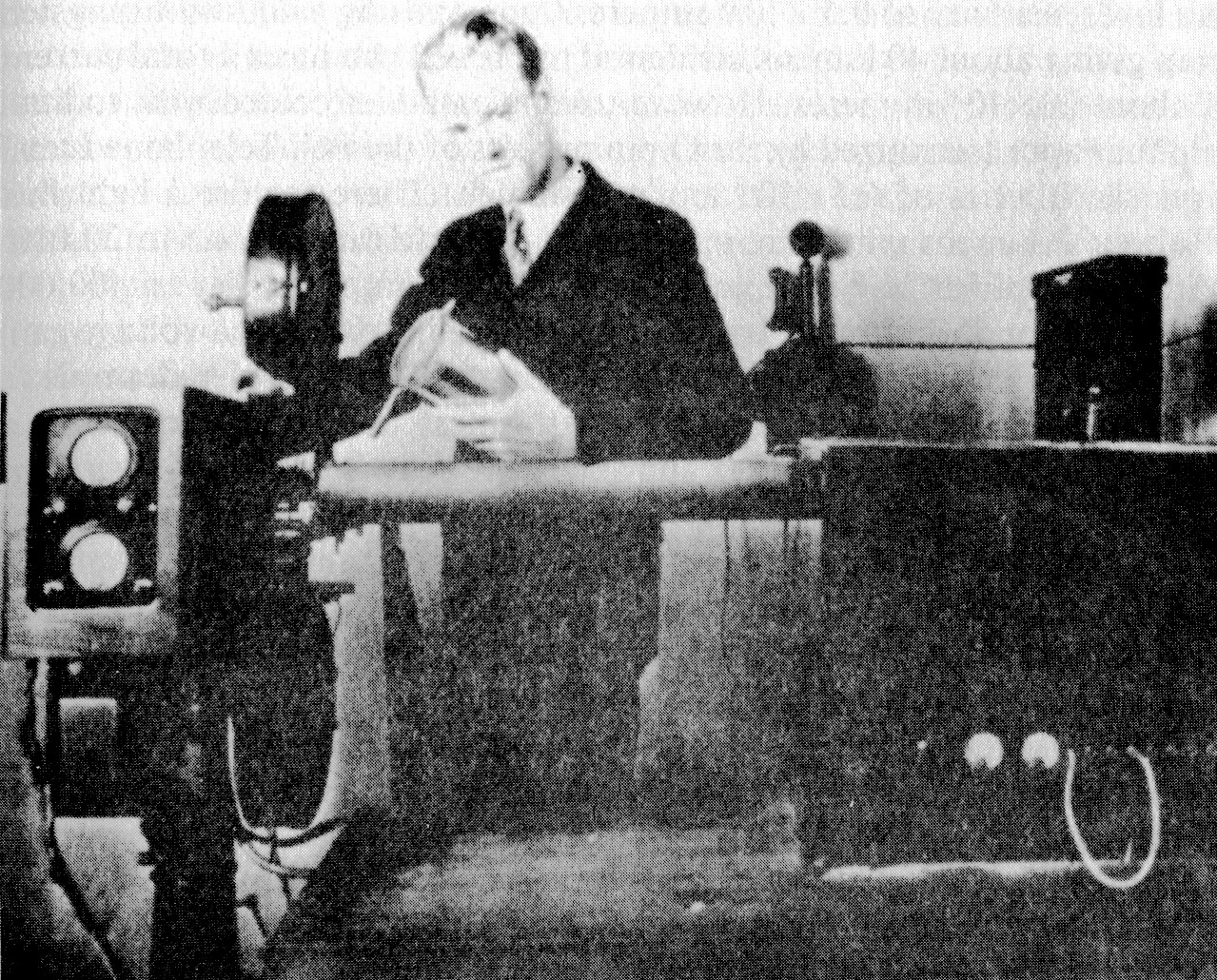
Farnsworth and his camera in 1930
Farnsworth also felt that Zworykin would understand his language and would have the proper appreciation of what he had obtained. On April 16 Zworykin arrived and spent three days at Farnsworth's lab. He was gracious in his praise of Farnsworth results and seemed tremendously impressed with what he saw. Zworykin examined Farnsworth's dissector tube and was quoted as saying "This is a beautiful instrument; I wish that I might have invented it." Later he was showed the success they had had in sealing an optically clear disk of Pyrex glass onto the end of the dissector tube. Zworykin had been assured at both Westinghouse and RCA that such a seal could not be made. Zworykin seemed to be very impressed with the simple and straight forward design of the dissector tube. With sufficient light it was an excellent imager that had no shading problems (uneven distribution of electrical charges making up the picture), and it delivered a clear distinct picture.
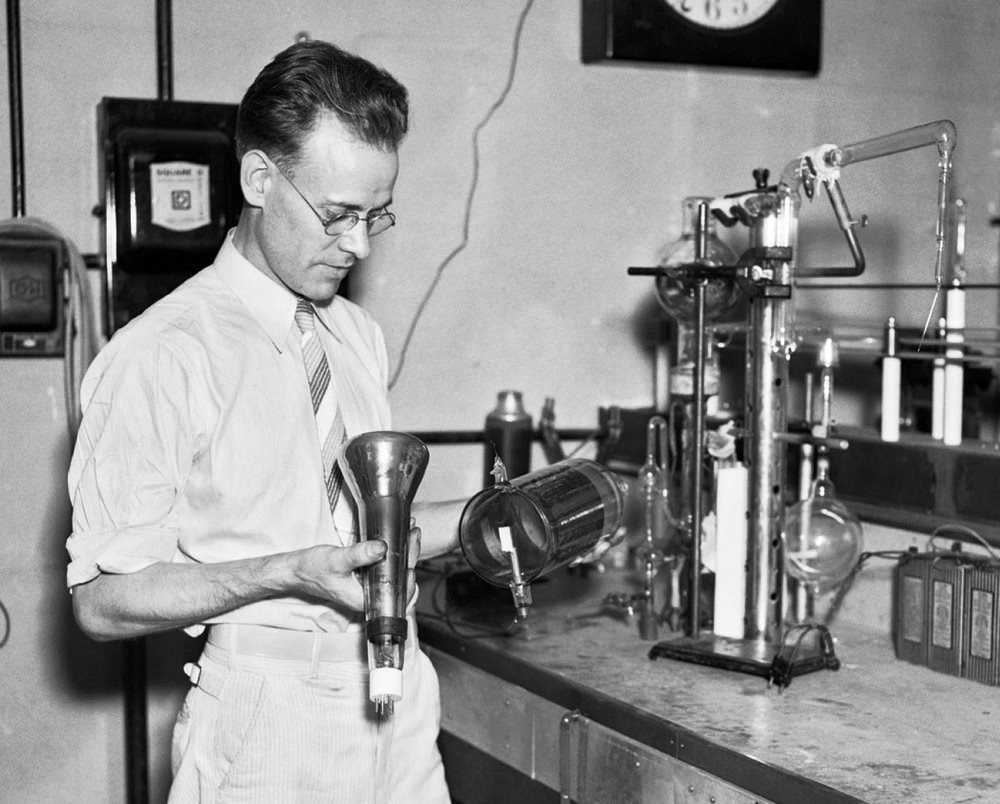
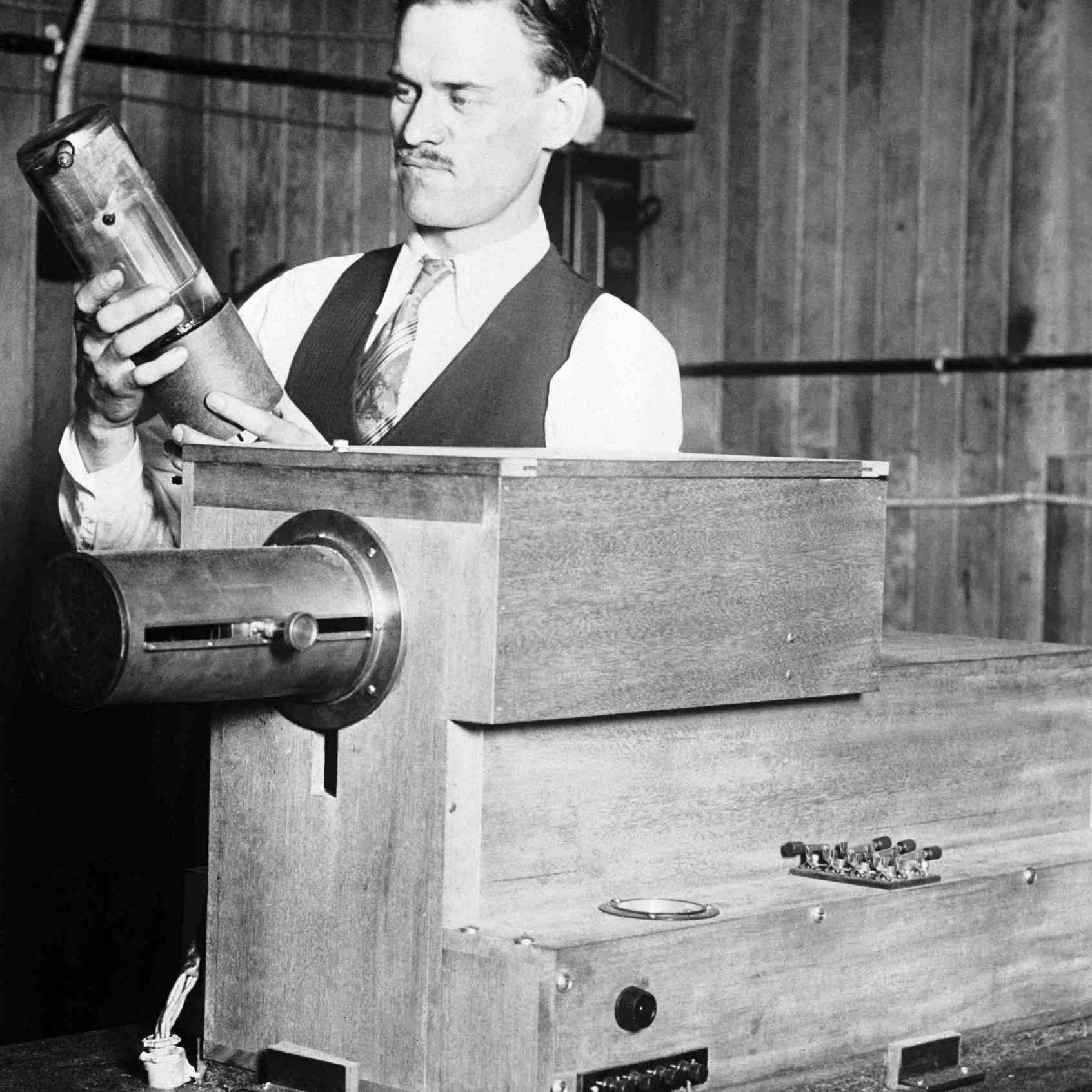
Farnsworth's Progress
Farnsworth with his camera prototype in a wooden structure (left)
Him holding his dissector pickup tube in his left hand and his display CRT in his right hand.
On the display end Zworykin was not impressed with Farnsworth's CRTs, as they could only produce small images. Zworykin wired Dr. E. Wilson of Westinghouse, they had developed the cesium-magnesium photocell together, and requested him to make up several dissectors for future experimentation. This was a standard practice, one lab to build or construct devices of another lab, in order to verify or challenge its findings. Several were built and operated. Zworykin wrote a report on the Farnsworth system. He couldn't admit the dissector tube was much superior to the crude, two-sided experiment camera tubes he was building, but he could comment on how his Kinescope was far superior to the Farnsworth tube.
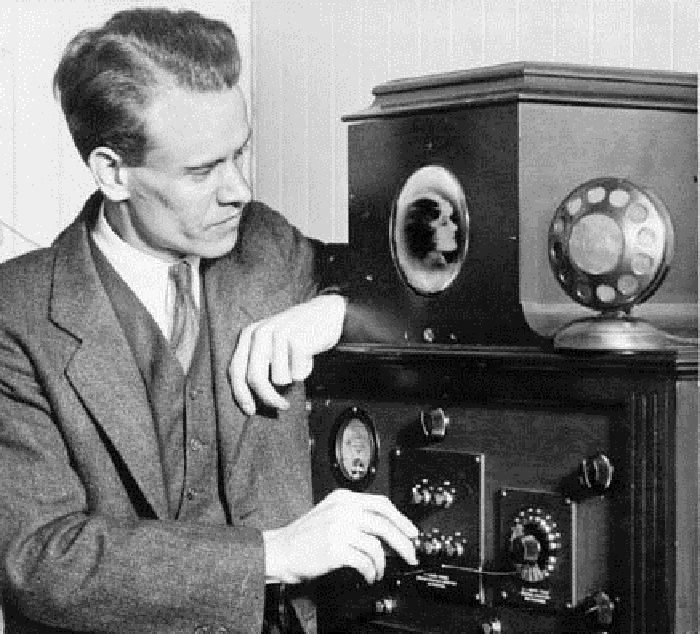
Farnsworth with an early receiver of his
Dr. Alexanderson's reaction to the report was "Farnsworth had evidently done some very clever work, but I don't think that television is going to develop along those lines. I think that Farnsworth can do greater service as a competitor to the Radio Corporation Group, provided he has financial backing. If he should be right, the Radio Corporation can afford to pay more for his patent than we can justify now." It was known that Alexanderson was not in favor of any cathode ray system at this time, including Zworykin's. But RCA sent a couple patent attorneys, out to San Francisco to investigate the Farnsworth patent applications.
Farnsworth was using some form of potassium hydride as his photoelectric element for his tubes. The advanced look at Farnsworth system spurred Zworykin to improve his system. RCA started using new cesium surfaces that had been developed by both GE and Westinghouse, and as a result produced much more sensitive tubes.
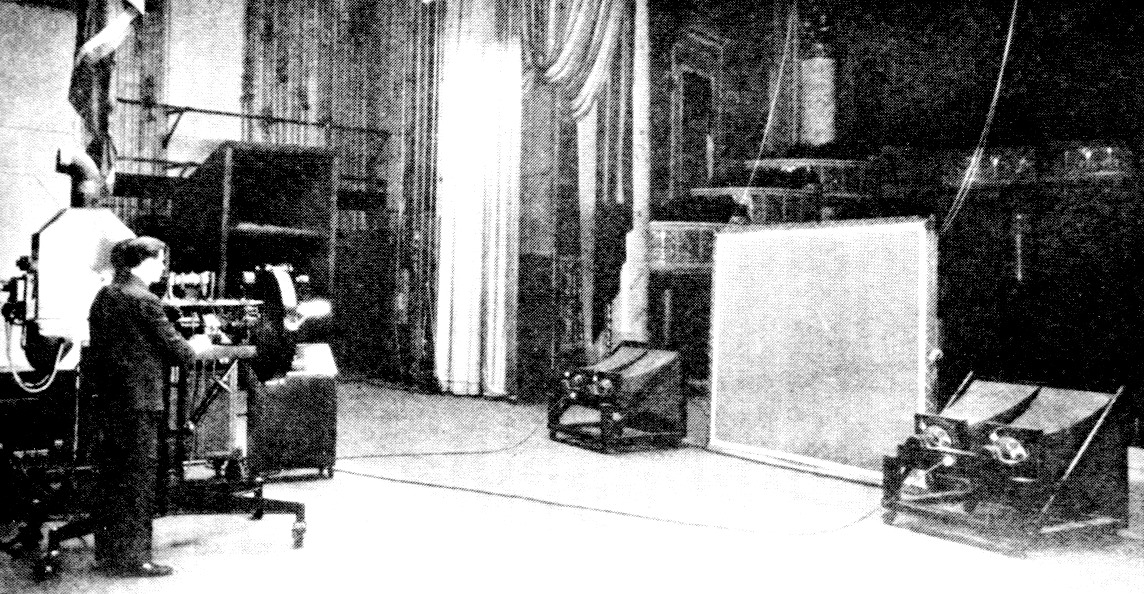
1930 GE Large Screen Demonstration
This was a waning attempt to prove mechanical systems were better, at least when displayed on large screens. This demonstration was done at RKO Theater in Schenectady.
In May, even though all RCA TV research was now being concentrated in Camden under the direction of Zworykin, the GE group led by Alexanderson decided to publicize their research efforts with a demonstration of large screen TV. This took place at the Proctor's Theater (RKO) in Schenectady. They were able to present TV images on a 6 foot square screen. The picture was about one-half as bright as that of a regular motion picture. The projector was a standard 175-amp motion picture machine. The scene was picked up in the GE studio at Schenectady by a regular 48-hole disk flying spot camera. The picture was transmitted to an antenna on top the theater a mile away from the studio. The 48-line, 16 frames/sec picture showed many defects, including a slight swaying of the image. However, the large size of the screen proved startling. The sound came from a pair of speakers carried over a second radio link. The program consisted of an introduction by a GE official, a series of vaudeville acts, and the finale, an orchestra number.
July saw much dissension at Zworykin's TV research lab in Camden. Westinghouse alumni, now at RCA were for all-electronic TV, and the GE people insisted that mechanical scanning had merit. It was decided to evaluate the two systems. The GE group had at this point an 80-line imaging that used a Nipkow disk as a flying spot camera shooting film. At this time Zworykin was using the two-sided experimental camera tubes for slides and film only. These tubes didn't have enough sensitivity for "live" pickups at this time. Even the "image dissector" copies that Zworykin had made, which were operating well, didn't have enough sensitivity for use in the studio. There would be no all-electronic studio camera for at least another year. The tests and evaluation showed that Zworykin's cathode ray system was superior. But the GE people continued to insist that the GE system had merit. It was decided to allocate 90% of the funds to the Zworykin system and 10% to the GE system. It was decided to abandon mechanical scanning as soon as the Zworykin camera tube attained a higher degree of perfection. While some maintained that the system was ready for public use, but generally it was realized that a larger and more detailed picture was essential for a telecasting service to the home.
July also saw the Technical and Test Laboratory of RCA turn over operation of the RCA TV transmitter at 411 5th St to NBC, and at the test lab under it was dissolved. That month Zworykin applied for his first patent for RCA. It is an improvement on his CRT imaging tube. The imaging tubes had improved to allow the scanning rate to be raised from 80 to 120 lines at 24 frames/sec.
At the end of 1930, Farnsworth presented a paper to the Federal Radio Commission where he claimed he could reduce TV bandwidth to about 7-10kc by using a single-side band-carrier and filters to eliminate the high frequencies. This he claimed would allow the picture and sound to fit down a standard phone line. He applied for a patent on this approach the next day. Farnsworth calculations were checked and approved by the Naval Research Labs, but they turned out to be not practical. This paper caused a great deal of harm to his reputation among radio engineers.

Early Empire State Building television transmitter installation
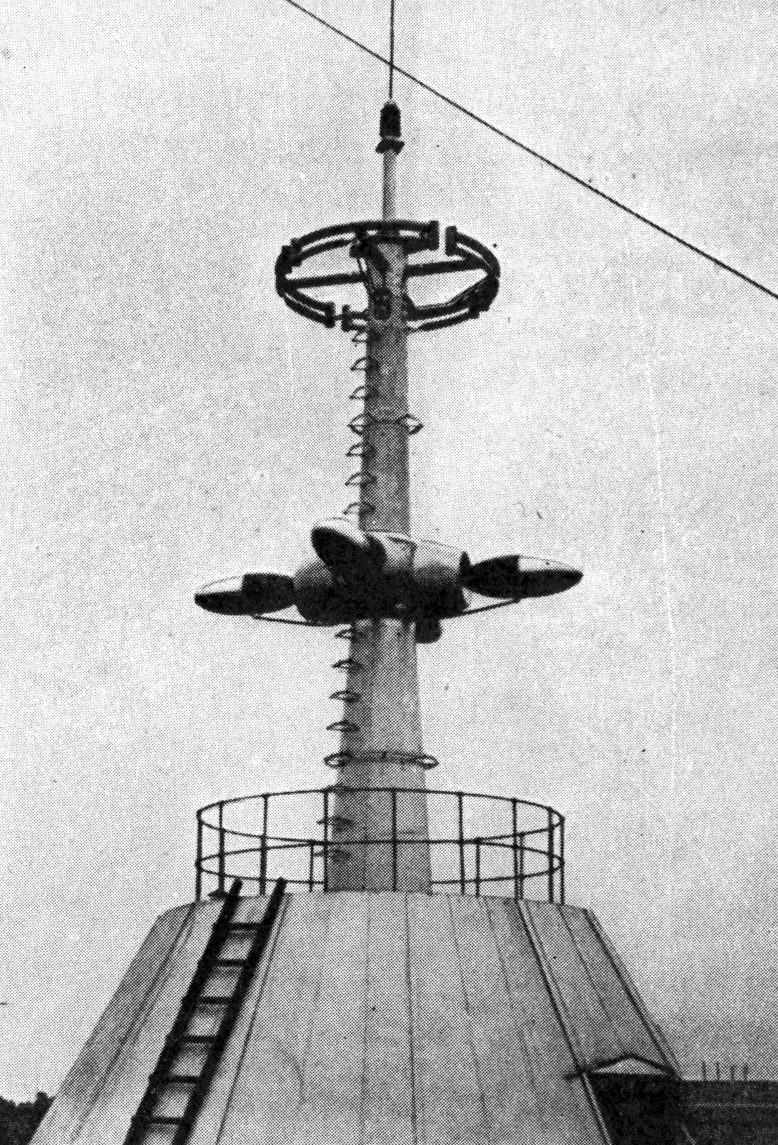
TV Transmit Antenna on top
of the Empire State Building
In July of 1931 the first television transmitter was installed in the Empire State Building.
By the beginning of 1931, Zworykin's group had gotten its version of Farnsworth image dissector to be sensitive enough that it was possible to get pictures outdoors by "direct vision" in bright daylight. Thus the first "direct vision" pictures ever produced came from an RCA Image Dissector. Farnsworth himself was not able to accomplish such pictures until August of 1933.
But work on Zworykin's imaging tube was not having much success with his two-sided tubes. So in May of 1931 he decides to investigate a single-side target. According to his notebook by June 12th, several tubes had been built that were giving quite promising results and he decided to proceed along these lines. These early single-side camera tubes had a target consisting of a mica surface on which silver was deposited.
While Farnsworth was originally ahead when it came to all-electronic TV, by the early 30s RCA was just massively outspending him, and not only did they out improve the image capture technology over Farnsworth, but Farnsworth also had another disadvantage, his display CRT technology was never better than what RCA had.
In May of 1931 Farnsworth's labs were still in desperate need of new financing. Most of the staff had been laid off, and new sources of money were being sought. Sarnoff went to visit Farnsworth's lab. He wanted to see what Farnsworth had accomplished for himself, and perhaps buy up Farnsworth work to insure RCA had possession of a viable camera tube. Sarnoff was aware of the problems Zworykin was having with his tubes. If nothing else Sarnoff could buy it up so that no one else could.
But he arrived too late. Farnsworth was already in Philadelphia negotiating a contract to continue funding Farnsworth's efforts by Philco. Sarnoff was shown through the labs by George Everson, who claimed that Sarnoff seemed quite impressed with what he had seen but indicated that he felt that the Zworykin receiver avoided any of the Farnsworth's patents. However Sarnoff certainly had an interest in Farnsworth's dissector tube. He offered $100,000 for the enterprise, including the services of Farnsworth himself. At the depth of the depression it was quite a generous offer. Sarnoff was assured that such a deal was impossible. Sarnoff left saying "There's nothing here we'll need." From this time forward the rivalry between RCA and Farnsworth became quite intense.
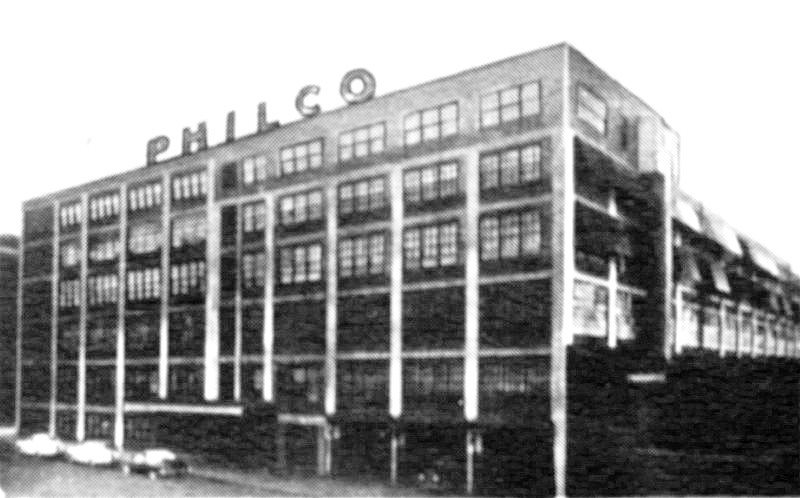
The Philadelphia Storage Battery Company of Philadelphia (Philco) beat Sarnoff to the punch. Philco was the largest manufacturer of radio sets in the US at the time. As such it was very dependent on the RCA patent structure. It was very anxious to break away from its subservient position to RCA in the new field of TV. Farnsworth TV system was the only alternative to RCA/Zworykin system at the time. Philco proposed to pay his research expenditures which were to be credited as prepaid royalties, leaving Farnsworth in control of his inventions. On June 30th an agreement between Farnsworth and Philco was signed. He kept the Green St lab open with one or two employees and moved his equipment amidst great secrecy to the penthouse lab in Philly. In December of that year Philco applied for a TV station license. Farnsworth went to Philly where a research lab was set up atop the Philco plant.
One of the first things Farnsworth did at Philco was to apply for a patent in July which was a method of supplying high voltage to the anode of a display CRT. The HV was generated by rectifying sync pulses and using them to charge a condenser. This condenser was connected to the anode. He also used the pulses to generate the scanning signals. It is the process that is still used in CRT receivers.
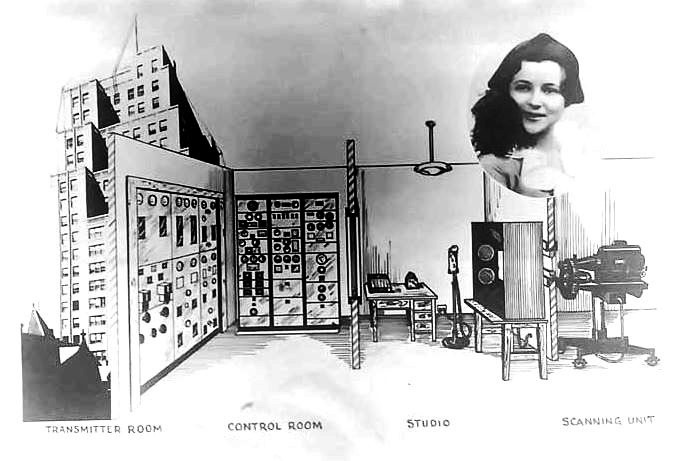
CBS Station W2XAB
Also in July, CBS inaugurated TV station W2XAB in New York City. It was claimed that this was the first occasion of an American network to inaugurate a regular schedule of sound and visual programs. Amid a gala ball on the guests were shown images on a "standard" Jenkins shortwave and TV receivers. New York Mayor Jimmy Walker was the honored guest. The images were easily recognizable but at times they would become distorted. Scanning was at the then RCA standard of 60 lines at 20 frames/sec. The sound was transmitted by WABC, the New York City CBS radio station, and the entire CBS radio network. After the inauguration the sound was transmitted by station W2XE, the CBS shortwave station. The station was on the air for some 7 hours a day, from 2 to 6pm and 8 to 11pm. This schedule continued until the end of February 1933 when CBS halted all TV transmission until "better equipment becomes available."

In October 1931 Zworykin added a new claim to a still pending December 1923 patent application, that "a photo-electric layer over which said electron beam stream is deflected is adapted to pass and upon which the picture is adapted to be focused, and a circuit connecting the photo-electric layer and cathode." The design of the new single-sided camera tube was finalized and on October 23rd it was named the Iconoscope. Although many tubes were built and tested the first really successful tube was tested on November 9th. This was probably tube number 16, which was the first Iconoscope to give a reasonably good picture. A new patent applied for on November 13th, which showed a camera tube in which the target was single-sided and therefore both the light from the scene and the scanning electron beam impinged on the same surface. It had a thin sheet of mica deposited with a thin film of platinum on the back side. The front surface consisted of individual photo-sensitive elements made by placing a suitable mask against this side and in vacuum evaporating cadmium to cause individual elements to be deposited through the openings.
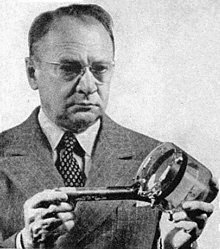
Zworykin holding his Iconoscope imaging tube
They also found that an alternative method was to apply a continuous film of cadmium to the mica sheet and scratched through the use of a ruling machine. Instead of cadmium, they also found that uranium, thorium, cerium, or other materials sensitive to ultraviolet light might be used. Also alkalis such as lithium or sodium might be used, in either pure form of similar to the cesium-oxide photocell. Zworykin's research group designed, built, and operated the first camera tubes in the world using high velocity electron beams. Even through their first two-sided tubes were crude and had limited success, they gave the group much important data to later create more practical camera tubes.
Interestingly, at about that time Baird declares that he saw "no hope for television by means of cathode ray bulbs."
In March of 1932 RCA applies for a patent to improve the beam focus of Farnsworth's dissector tube. This showed how important Farnsworth's tube was still to RCA. RCA was trying to gain control of the dissector. Eventually the patent office ruled that RCA could not incrementally gain control of the dissector tube. This victory gave Farnsworth complete control of the dissector. But it gave RCA great impetus to improve the Iconoscope and eliminate its many deficiencies.
Sarnoff had set a goal earlier to have an operating system on the air by Autumn of 1932. While getting closer to being let loose from the lab, it still was not quite ready for the public. In a demonstration of over the air television to a group of RCA licensees and manufacturers' representatives in May of 32 it was clear to Sarnoff and anyone who saw the demonstration that his goal would not be met. This was the last demonstration of the RCA TV system for the next four years. Although the radio industry had weathered the depression so far with a minimum of damage, the depth of the depression at this point couldn't have helped the prospects of TV. At this point RCA slowed down the field tests from the Empire State Building.
Also that year, on November 31st, 1932, RCA agreed to a consent decree in the antitrust suit brought by the DoJ back in May of 1930.
Early in 1933 RCA built and operated a complete TV system at Camden which used Zworykin's new camera tube at 240-lines sequential (not interlaced) at 24 frames. The picture was transmitted on 49 MHz and sound on 50 MHz. A mechanical sync generator was used, but otherwise the system was all electronic. They carried out experiments with a remote camera about one mile from the studio which was relayed back via radio. It allowed for "direct vision." Also during 1933 RCA received many patents for refining the televising of film. Also RCA applied for patents that refined electron optics. This made beams much sharper and brighter. They generally involved using thin coils for electromagnetic instead of electrostatic focusing.
At this time Philco decided to end its relationship with Farnsworth. It had become apparent that Philco's aim of establishing a broad patent structure through research was not bearing enough fruit. Philco, as a licensee of RCA, knew of the TV research at Camden. So in May of 1933 Philco hired Albert F. Murray, who had been the director of the Advanced Development Division at RCA. As such he had full knowledge of what Zworykin's group was doing. Murray became Engineering in Charge of Philco's TV research department and brought with him a half-dozen key RCA people from Camden.
After Farnsworth left Philco, he decided to remain in the Philly area rather then return to San Francisco. Farnsworth TV was reorganized, and it appears that it received much new financing from Russell Seymour Turner, whose wealthy father had a great amount of Farnsworth TV stock.
With the departure of Albert Murray to Philco, it was apparent that RCA's secrets were out and so RCA decided to reveal the Iconoscope to the 8th annual convention of IRE in Chicago. In June Zworykin presented a paper where he explained how mechanical scanners could not get enough light to produce an outdoor picture. Early pickup tubes had a lack of red response that caused faces to look unnatural. The tube was claimed to be as sensitive as film, and that some tubes were good to 500 lines of resolution or more. It was claimed that this marked the age of electronic TV. Only an electronic time-base and blanking generator were missing. He had his camera tube to go with his Kinescope picture tube.
Bell labs realized in early in 1933 that their 72-line two-way TV system was not "the most advanced state of the art." The tremendous lead that Bell Labs had had since 1925 was now dissipated. The lack of a suitable CRT receiver had diluted all their early experimental successes. RCA, Farnsworth, most of the British, German and Japanese TV labs had long since passed Bell labs in terms of number of lines and quality of images. By the middle of the year Bell labs was convinced that mechanical TV was no longer viable, and the company decided to try and build a practical camera tube of their own design.

1933: Very early Iconoscope camera prototype.
Down-sloped section under the lens was to fit the shape of the image tube.
The two cases to the left where the camera's power supply, and the other held the majority of the video processing circuitry.
It was also in 1933, just as RCA had an all-electronic TV system, that Sarnoff decided not to start a TV service in the US, as he thought it would of hurt the thriving radio industry. While the camera tube worked in the lab, it wasn't yet ready for everyday use. The Iconoscope was still wanting, mainly it was "noisy." It was discovered that this was mainly because of the disturbance of the target as the high-velocity scanning beam used disturbed nearby electrons as the beam landed.
Zworykin went to London and visited EMI in September of 1933. After the visit EMI took an interest in the Iconoscope and started building their own. They had collaborated earlier with Zworykin on CRT displays. Soon EMI was working to improved RCA's imaging tube. The next year they had working the first fully functional low-velocity scanning beam tube, which they called the CPS Emitron. In 1934 EMI filed for patents for television transmitting systems where a charge storage plate was shielded by a pair of special grids, a negative grid that lay very close to the plate, and a positive one was placed further away.
The velocity and energy of the electrons in the scanning beam were reduced to zero by the decelerating electric field generated by this pair of grids, and so a low-velocity scanning beam tube was obtained. EMI slowly found additional improvements that could be made to the tube. Then in 1936 it was discovered that a sharper image could be produced if the trajectory of the low-velocity scanning beam was nearly perpendicular (orthogonal) to the target. The Iconoscope' scanning beam approached its target from an angle.
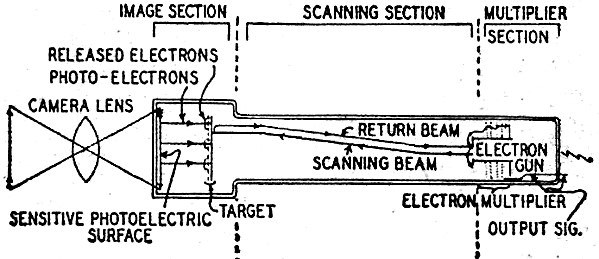
Orthicon Camera Pickup Tube Schematic
Beam scanning current verses return current
This led an RCA team led by Albert Rose in 1937, to begin work on a low-velocity scanning beam device they dubbed the Orthicon, as it also had its scanning beam hitting the target perpendicularly. RCA solved the problem of guiding the beam and keeping it in focus by installing deflection plates and coils near the target. The Orthicon was showing up in cameras by 1938. A problem the Orthicon had early on was it would become unstable under sudden flashes of bright light, producing "the appearance of a large drop of water evaporating slowly over part of the scene."
Farnsworth had not given up, but was rapidly falling behind what RCA and others were doing. In 1936, he managed to attract the attention of Collier's Weekly, which was still amazed with his work. The magazine stated "One of those amazing facts of modern life that just don't seem possible, namely, electrically scanned television that seems destined to reach your home next year, was largely given to the world by a nineteen-year-old boy from Utah. Today, barely thirty years old he is setting the specialized world of science on its ears." Farnsworth's pioneering work in television imaging was coming to an end. But his groundbreaking engineering accomplishments would continue.
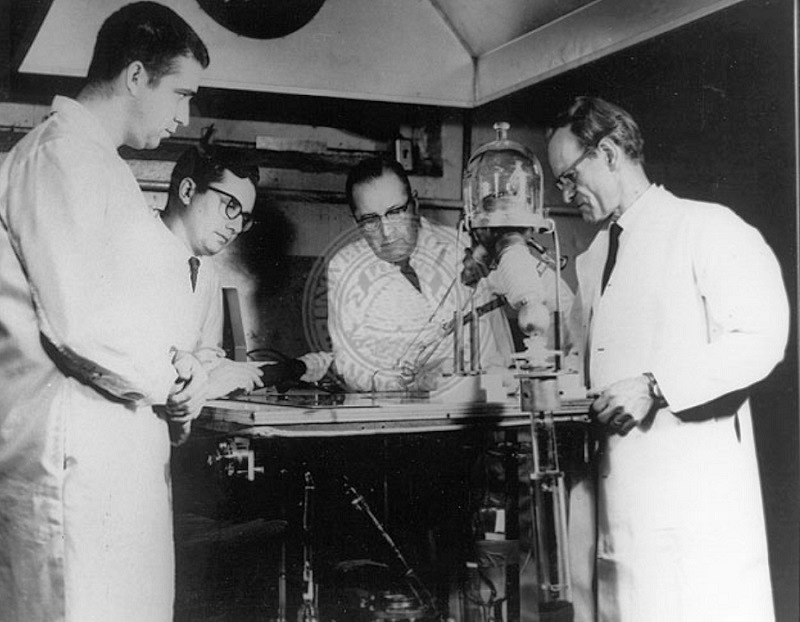
Farnsworth (far right) with "Fusor" and engineers,
Courtesy of the J. Willard Marriott Digital Library, University of Utah
In 1938, Farnsworth established the Farnsworth Television and Radio Corporation in Fort Wayne, Indiana, with E. A. Nicholas as president and himself as director of research. In September 1939, RCA finally conceded to a multi-year licensing agreement concerning Farnsworth's 1927 patent for television. RCA paid $1 million so that it was free, to showcase all-electronic television at the New York World's Fair on April 20, 1939.
Farnsworth's company was purchased by International Telephone and Telegraph (ITT) in 1951. Working for ITT he developed a number of defense related systems, including a defense early warning signal, submarine detection devices, radar calibration equipment and an infrared telescope. Farnsworth also engaged in nuclear fusion research.
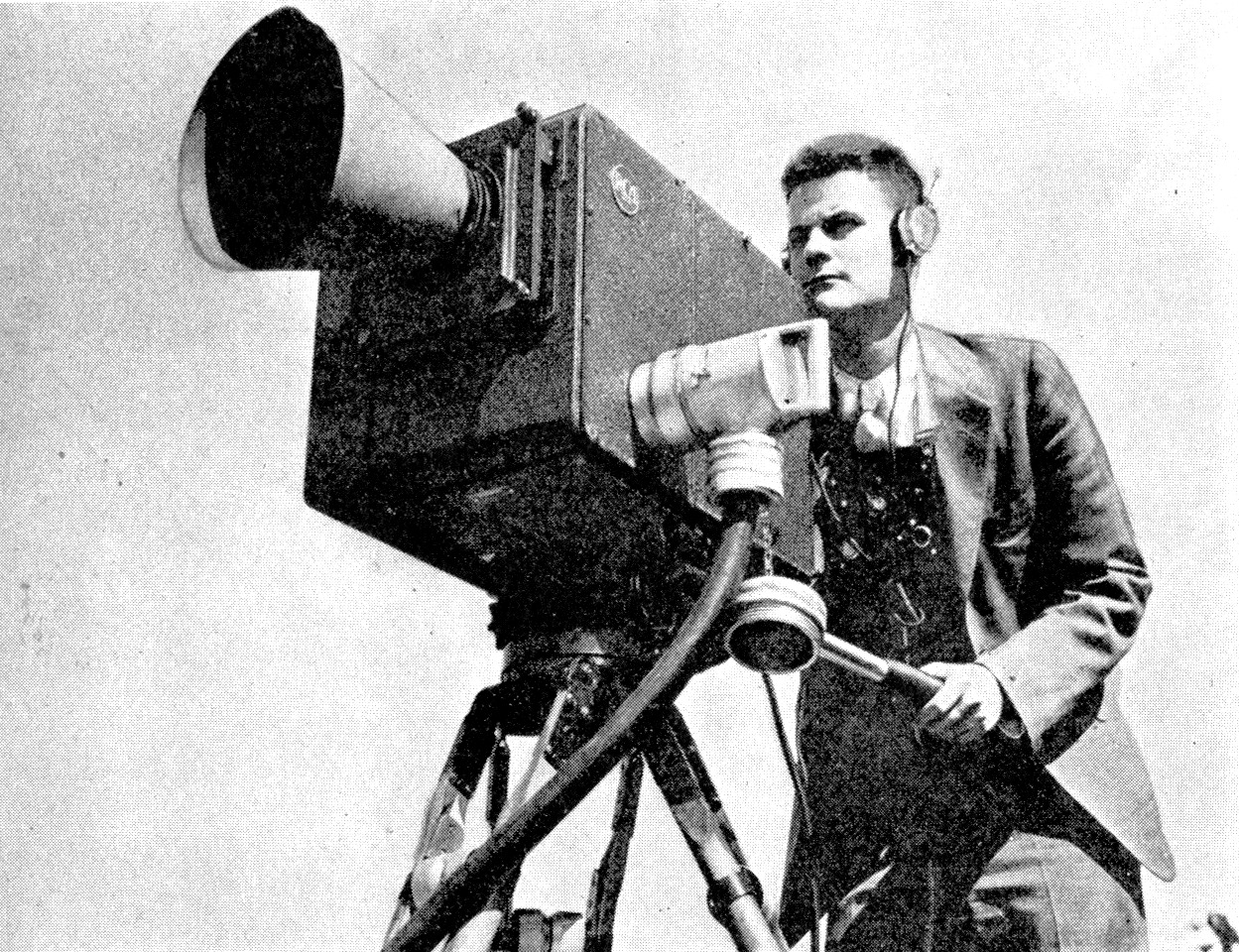
Early RCA All-Electronic Camera
It still did not have an electronic viewfinder, just a gun sight.
It was not until July 7th, 1936, that RCA finally thought it was time for all-electronic TV to leave the lab and demonstrate it to the public once again. They transmitted from the Empire State Building to several TV receivers on the 62nd floor of the RCA building. The program started with a two-shot of Major General J. G. Harbord, chairman of the board of RCA, and Sarnoff talking about their grand invention. It then had Sarnoff and other prominent players in TV's development do walk-ons. Intermixed in the show where film clips, ranging from newsreels to dance scenes, finally ending back in the studio with a fashion show. Right after this CBS decided it needed to get back into the game and so the next year, they resumed their TV experimentation.

1936 RCA TV Demonstration
David Sarnoff is on the right
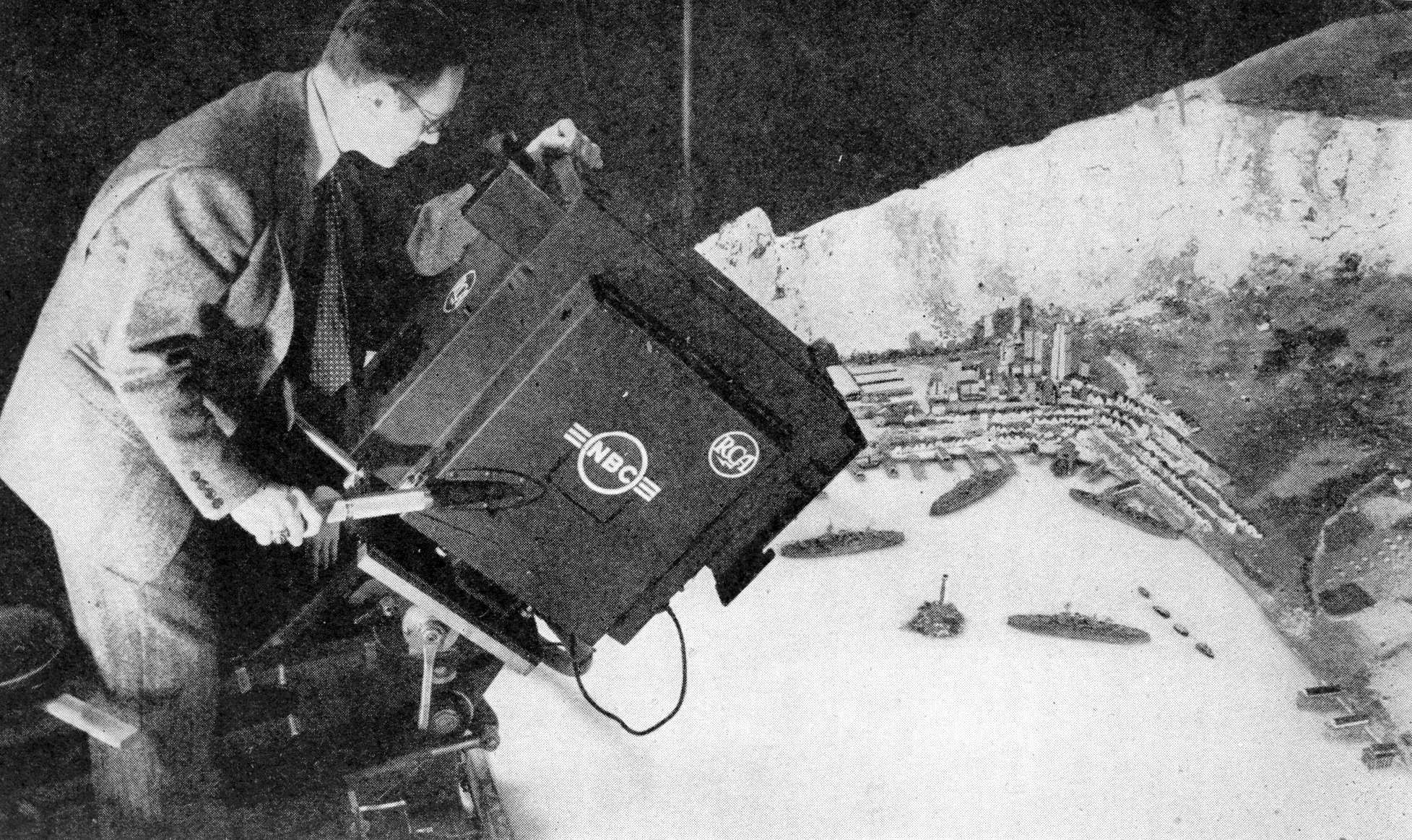
1936 441 line, 60 field TV camera in tests at NBC
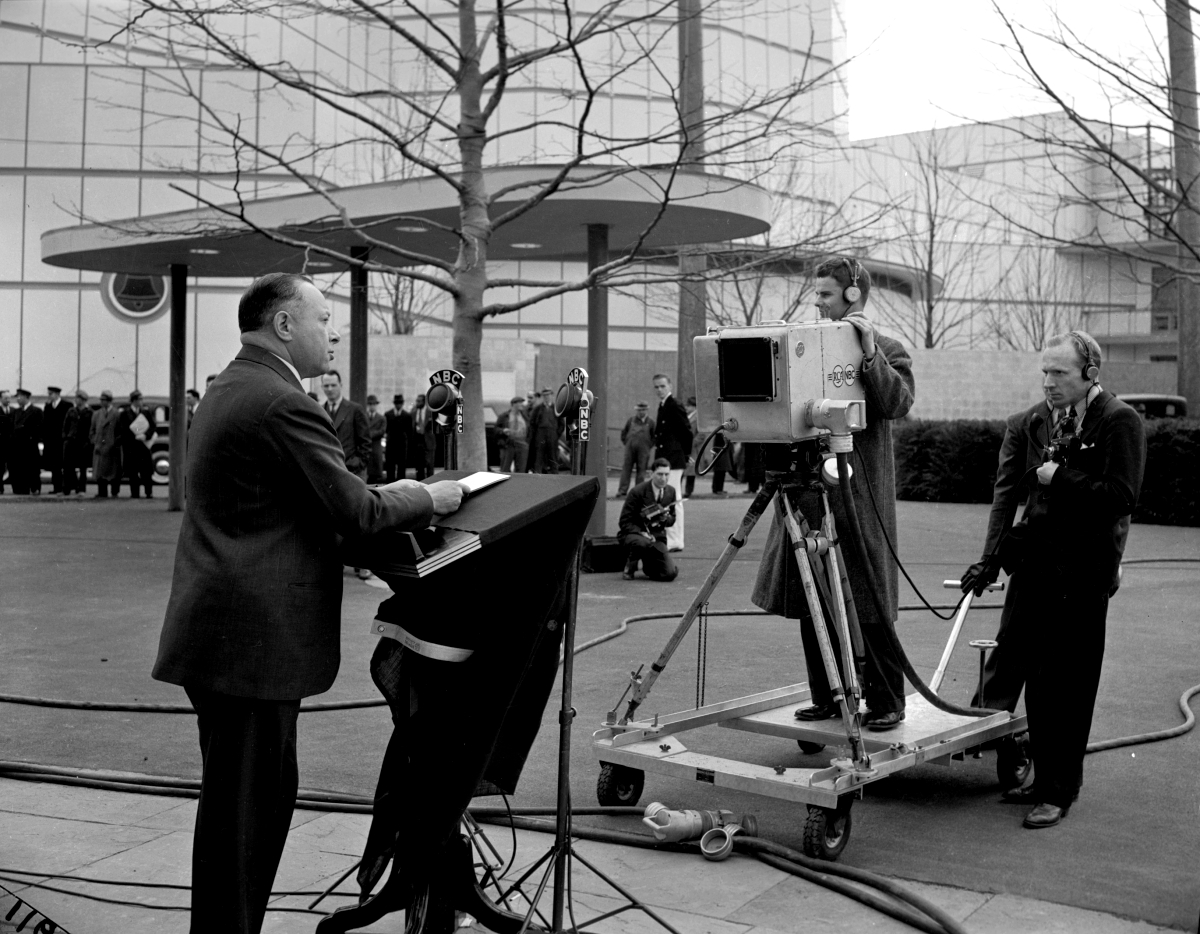
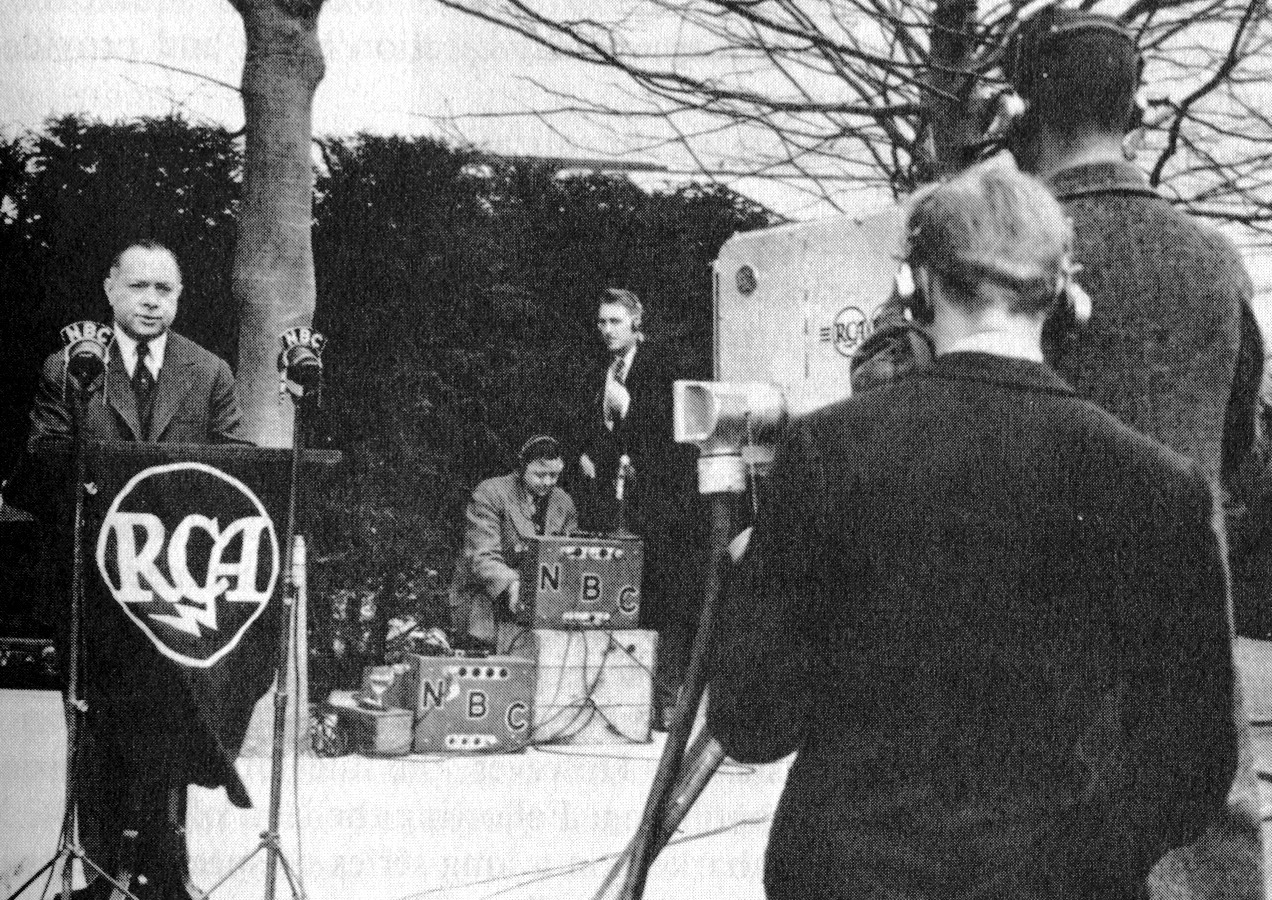
Sarnoff at the 1939 World's Fair
The next major public unveiling happened at the 1939 World's Fair. Sarnoff was televised dedicating the RCA exhibition building at the fair. The RCA exhibit had numerous tv receivers. One in a transparent case so the public could see the inner workings as some still thought TV was some sort of trick. The receivers shown at the display were modified, their high voltage circuits were increased, so that the displays were brighter.
To most of the public, TV was still such a novelty that folks could stand in front of a camera, and they would then receive a certificate saying that they had been televised at the World's Fair.
But TV was far enough along that now competitors also showed their TV offerings. GE, Westinghouse, and Dumont demonstrated their own sets. But the Westinghouse set it displayed was manufactured by RCA. Dumont also showed their own camera. It appeared that widespread TV was on the cusp.
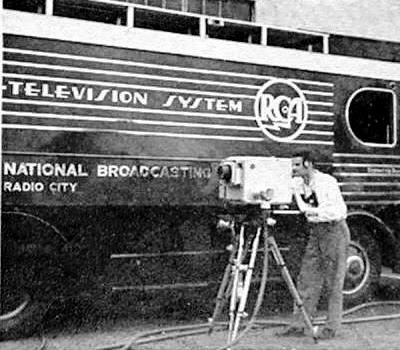
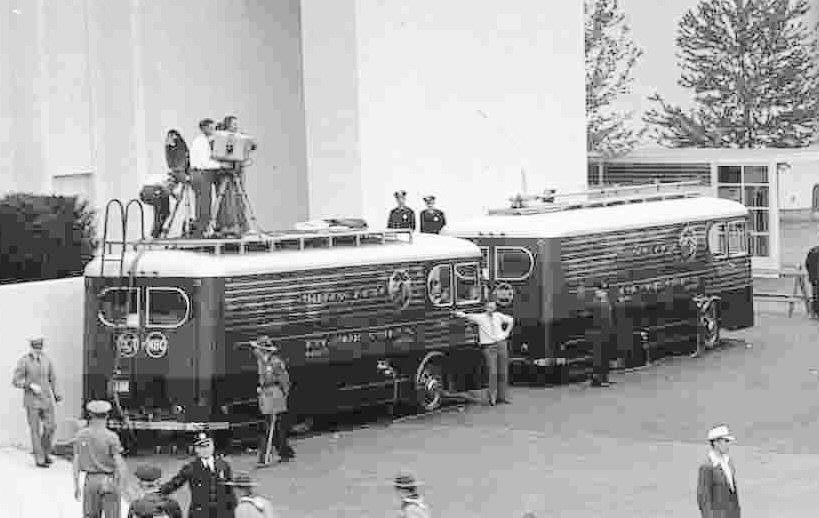
(L) Simple on the street remote at the end of 1937. (R) More complex remote in 1939.
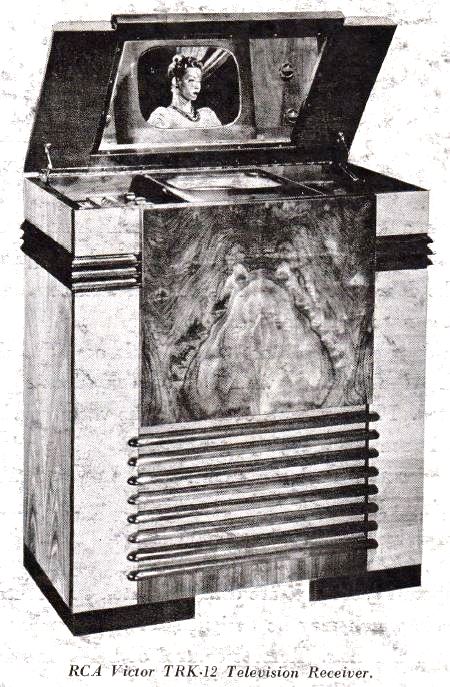
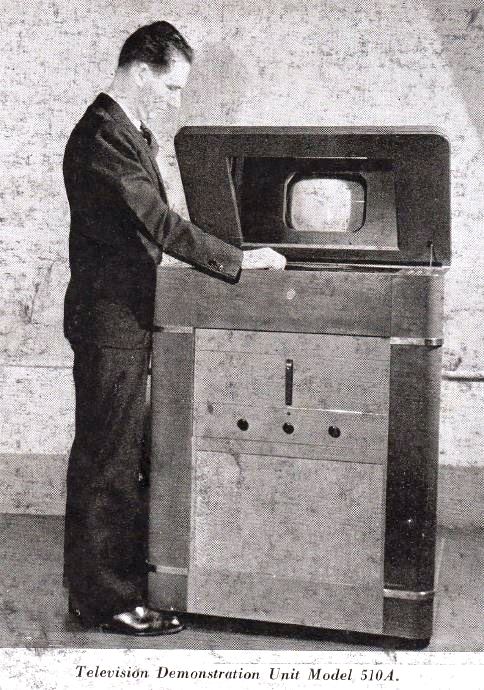
TV Receivers available from RCA in 1939
Notice that both had the CRT pointed up at a mirror
At this time RCA offered its first tv receiver to the public, which had a 12-inch CRT. While the first sets had continuous tuning, they soon had 12 position detent tuners. The sets also had seven additional control knobs, several which would be quite foreign to people under 35 today. Such as horizontal and vertical hold adjustments. These receivers, and the signals that they received were not as stable and uniform as today and so often the viewer would have to make an adjustment or two to see a stable picture.
For the next few years TV transmissions were very sporadic, and most the sets sold went to what today would be called early adopters. During that time, the entire system was undergoing small continuous improvements. But the main impediment was the economic depression that was still hampering mass public adoption of the new medium.
By early 1942 there were about 5000 sets in use, almost all clustered around the New York area. But with the U.S. now in the war, just like the gold mines in our Grass Valley story
 , TV watching by civilians was not an essential industry and so all set manufacturing for the public and TV transmission ceased, for the most part. Although some transmissions deemed necessary for the war effort continued, such as to TVs in hospitals in the New York area for injured servicemen. Besides RCA stations in New York, Philco had one in Philadelphia, Schenectady had a GE test station, along with a couple independent stations in Los Angeles, and Chicago.
, TV watching by civilians was not an essential industry and so all set manufacturing for the public and TV transmission ceased, for the most part. Although some transmissions deemed necessary for the war effort continued, such as to TVs in hospitals in the New York area for injured servicemen. Besides RCA stations in New York, Philco had one in Philadelphia, Schenectady had a GE test station, along with a couple independent stations in Los Angeles, and Chicago.
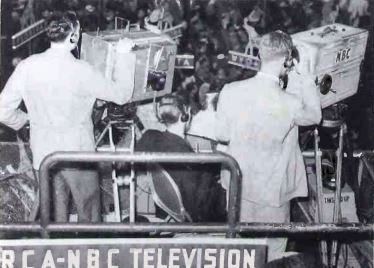
Early NBC experiments with televising on-the-spot news events provided invaluable technical and artistic experience which paved the way for the post-war television boom.
Engineers who had been developing television technology now directed their expertise toward designing radar and communications systems for the military. Also, the development of television guided bombs was undertaken. Around the world others used television. An early British TV developer, John Logie Baird, devised a system that was installed on planes that shot film of the ground passing below, which was rapidly developed on the plane and then using a special camera that looked at the lens of a film projector, the resulting video was transmitted to the ground. The British also used their transmitted TV signals to jam German aircraft navigation frequencies.
The Germans used television for propaganda purposes throughout the war, even transmitting from the Eiffel Tower. Perhaps the most interesting use of TV was by Russia. They mounted a camera above an early radar screen looking at Leningrad in 1941 and transmitted the signal to receivers at anti-aircraft sites in the area to help them locate enemy planes.
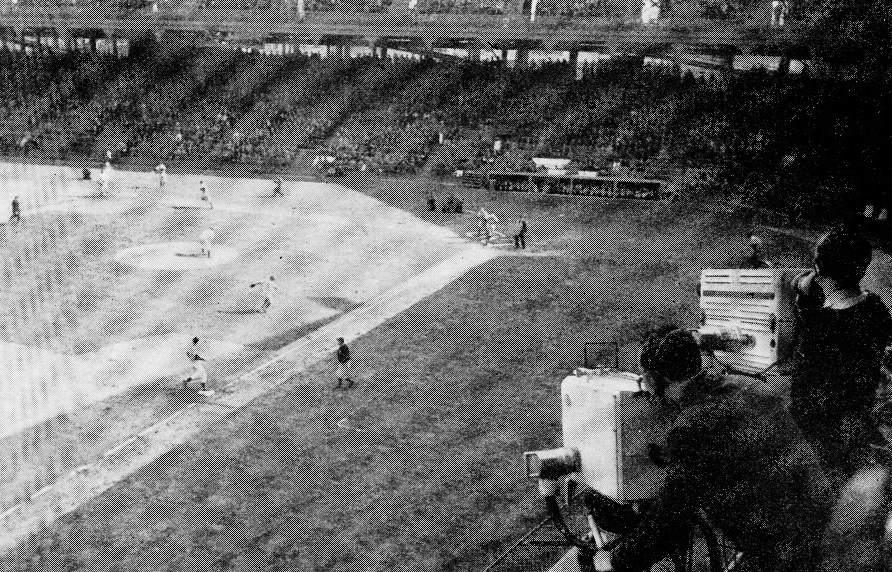
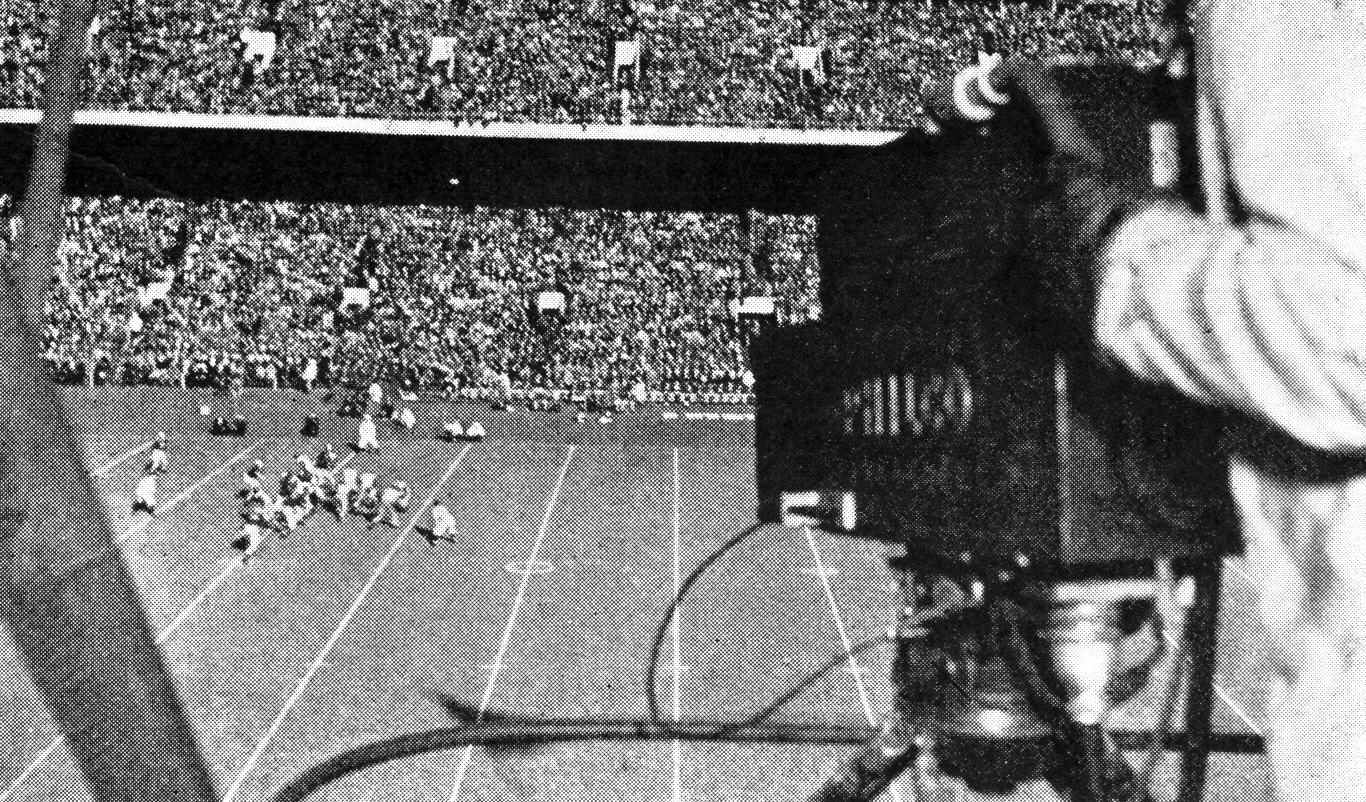
During the war some commercial TV development continued. Both these events were covered in 1944.
Notice the camera on the left (baseball game) does not have an electronic viewfinder, only a optical site.
The camera seen covering the football game is at Franklin Field at the University of Pennsylvania in Philadelphia. The camera is one offered by Philco. which was also located in Philadelphia. As you recall this was the company that sponsored Farnsworth for awhile.
Post War Take Off
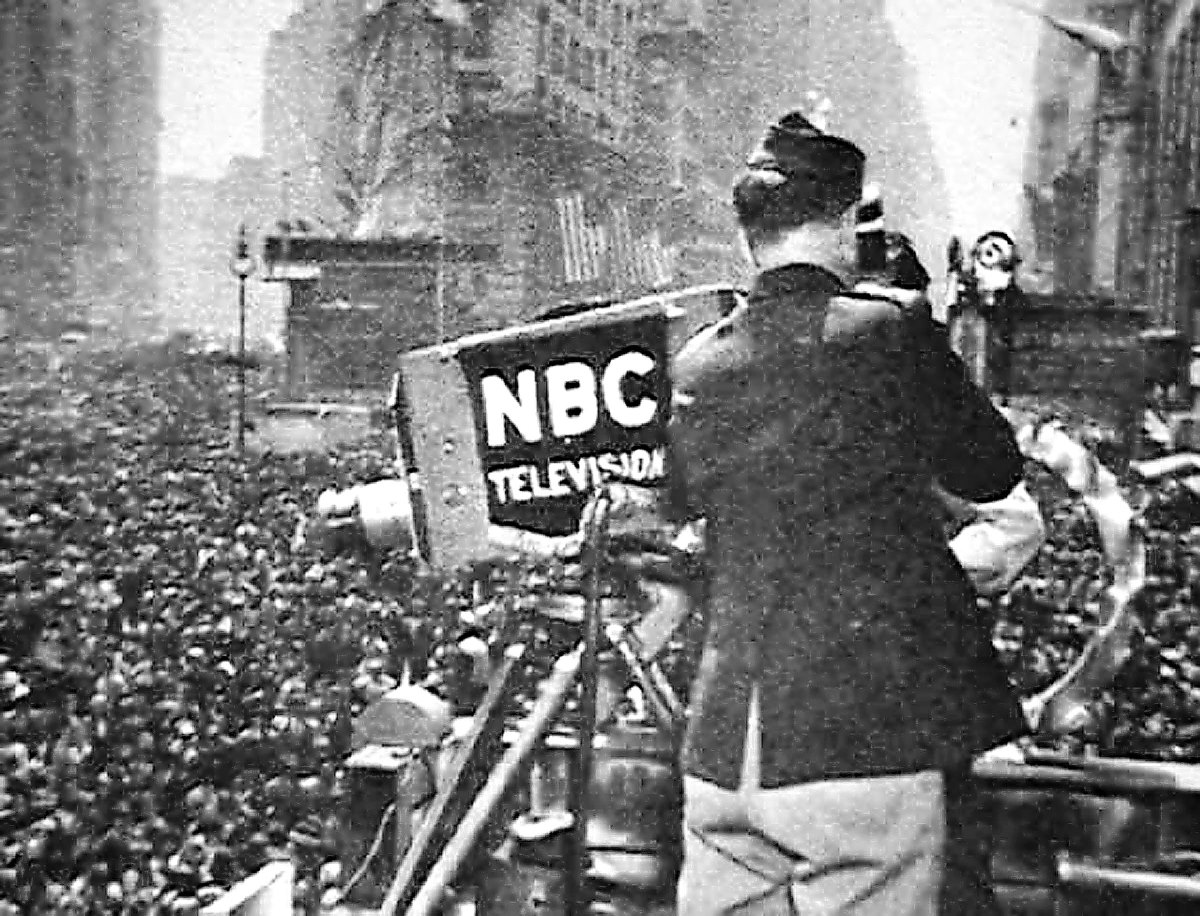
Times Square Celebration Television Coverage at the end of the War
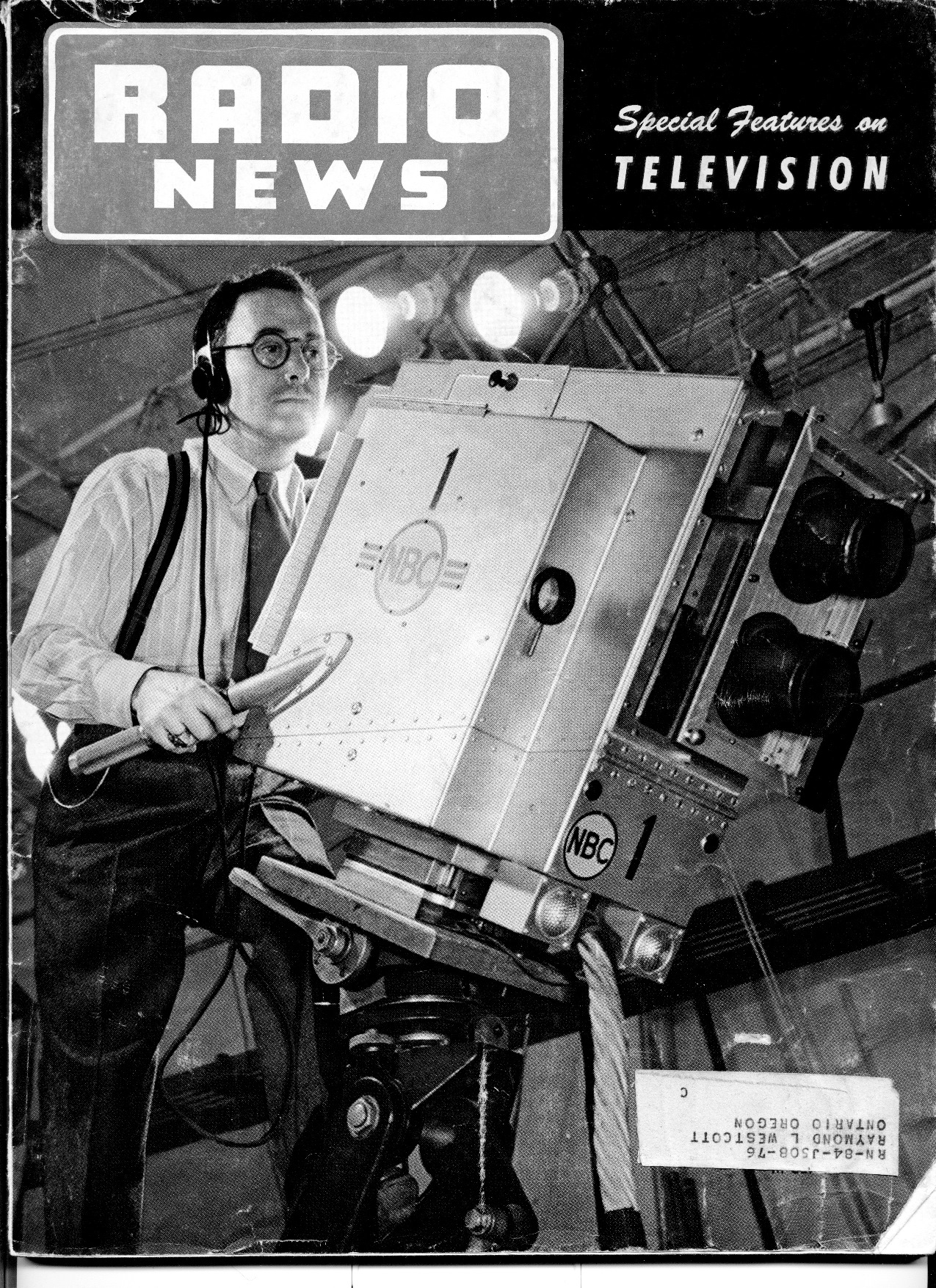

Post War Sets for Sale
Before the war television was something few had heard of. But four years later, most Americans had heard of television and wanted one. The deprivation that people went through in the 12 years of the depression and then another four during the war had produced a vast ocean of pent up demand for things beyond basic necessities. While unemployment was pushing 25% at the depth of the depression, it had dropped to just under 15% in 1939, and at the height of war and with the munitions production to support it, it was at an historical low of just over 1%.
While there was some initial concern about what all those returning GIs would do for work, it soon became apparent that was not a problem as all the factories and manufacturing facilities that had supplied Roosevelt's "arsenal of democracy" quickly reinvented themselves as producers of civilian industry again, and more importantly, suppliers of consumer goods.
Postwar Television
Americans responded to this prosperity by buying those goods. This started great economic growth and cemented the U.S. as the world's richest country, more than doubling the gross national product by 1960. Most Americans began to think of themselves as middle class. Car production quadrupled in the decade after the war. The rapid adoption of television into the American home occurred as the TV receiver became a household appliance that was finally affordable, and it provided hours of entertainment for what now seemed like a reasonable price.
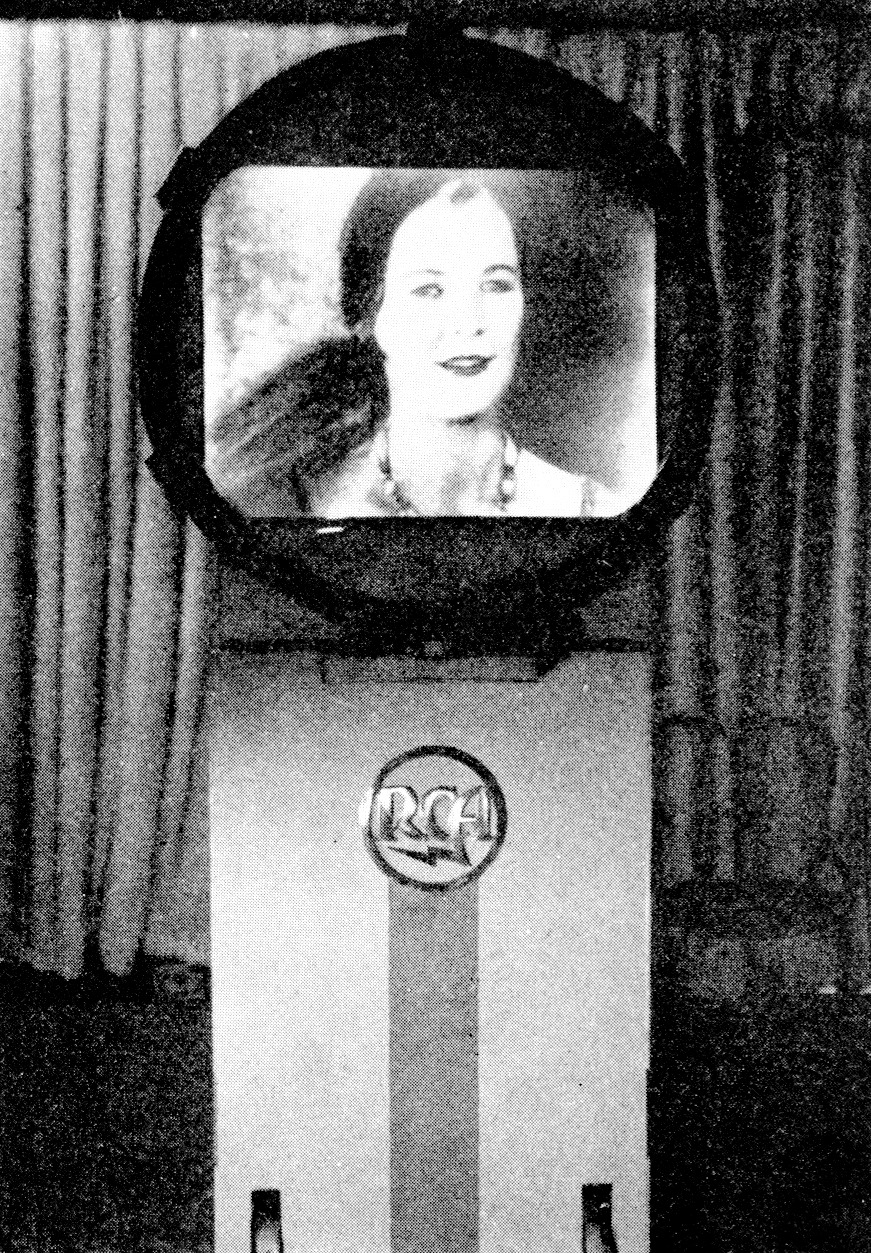
Soon sets had much larger displays
This model actually had a demountable CRT that could be set away from its stand, which housed the electronics.

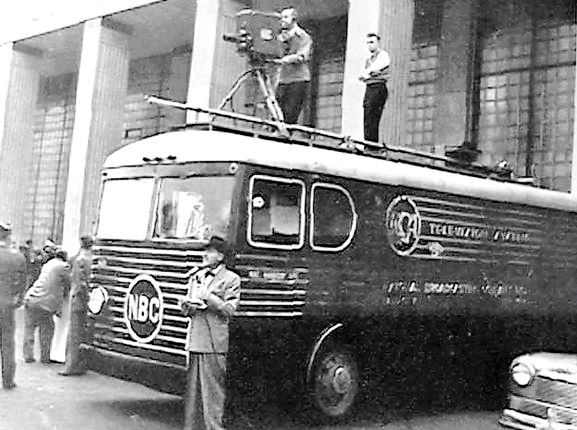
Early Remote Production trucks for "Outside Broadcast" (OB) as the Europeans would say.

Late 40s vintage black & white cameras
Americans had been crowded together during the war, now they wanted some space, and to be left alone. TV satisfied that urge. Soon theater and restaurant owners noticed a collapse in business on the nights that popular shows aired. TV immediately started reshaping not only when people went out, but how people consumed entertainment. The medium started as an observer of events, but soon events began to reshape themselves to accommodate TV. In many cases the people covering events and stories, since they were center stage, often came to overwhelm what they were there to cover. A trait we very much see today. Before TV, a sports event was witnessed as a spectacle, an event with competitors. Now it started to evolve to be as much about the personalities involved, then the sport being played.
TV was soon offering entertainment and insights that radio could not. In 1947, President Harry Truman's state of the union address and the baseball World Series were televised. Now you had a person, with all their gestures and mannerisms to contemplate, and not just the tone of their voice. A year later, CBS and NBC networks started 15-minute nightly newscasts. By 1949, prices of TV sets had dropped enough that Americans were buying 100,000 sets every week. The first family in the neighborhood to get a TV would invite friends and neighbors to come over and watch. This even though TV receivers usually only had picture screens between 10 and 15 inches wide diagonally, inside large, heavy cabinets.
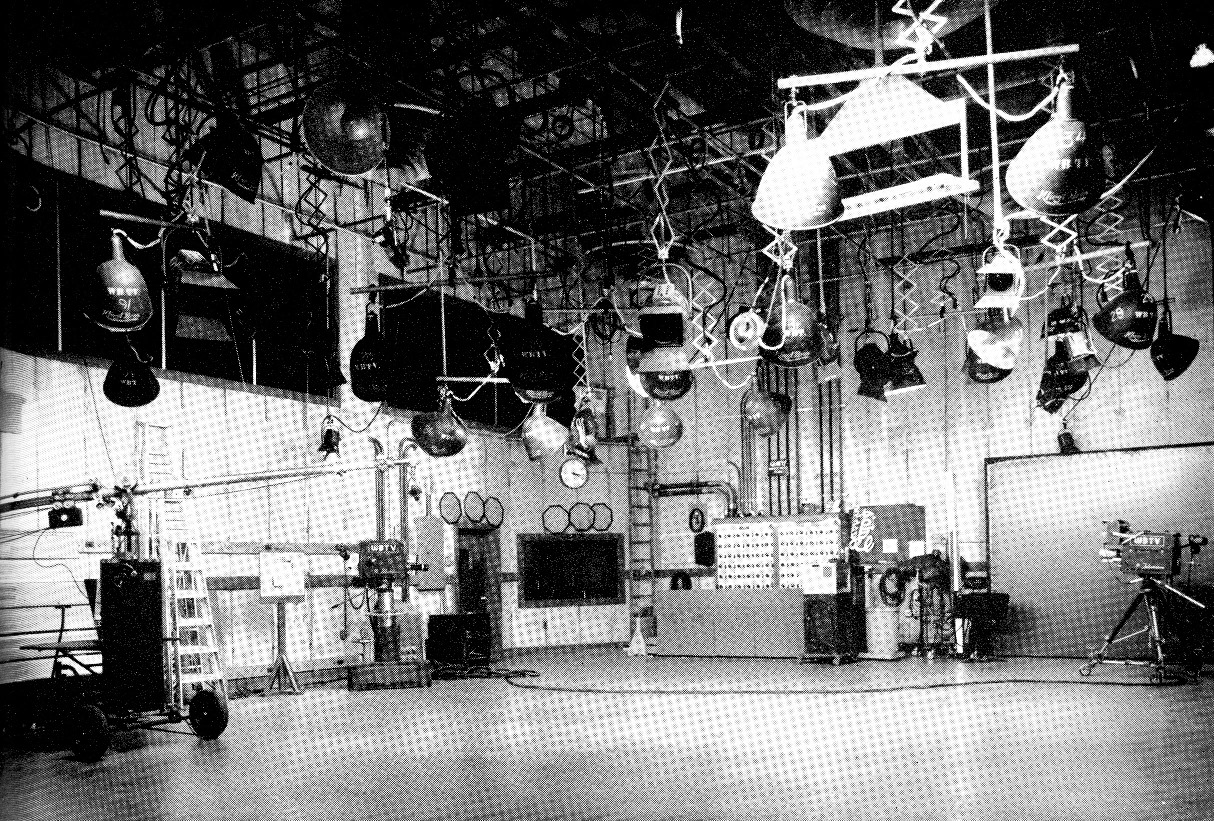
Even though cameras had become much more sensitive to light, it still too a lot of it in a studio to produce usable video.
Before 1950, before many had a TV, people listened to radio an average of nearly five hours a day. Within nine months after they bought a TV they still listened to radio, but only for two hours a day. They were now watching TV five hours a day. In 1950 Baltimore became the first city to watch more TV than listen to the radio.
Right after the war there four stations in New York City ramped up their program offerings. The were also stations on air in Schenectady, Philadelphia, a couple in Chicago, and Los Angeles. Immediately there was a deluge of applications to build stations in all the major, and many minor markets. In just two years there were 108 stations on the air, of which 98 were commercial television stations in 50 large cities, when the FCC and others realized that many stations were on the air using the same channels, and they were too close to each other causing interference. At the time there where only 12 VHF channels available for TV broadcasting. So, in 1948 the FCC enacted a ban on new channels.
Over the next four years re-allocation maps where debated, along with the use of the UHF channels to alleviate the congestion. On top of this, there was talk of color TV, and discussions started on how to incorporate it. Using the UHF band would make available another additional 60+ channels. In 1952 licenses for new stations were handed out again. Many received UHF licenses, especially fledgling television networks like ABC, and Dumont.
UHF
New high-frequency vacuum tubes were developed immediately prior to World War II by Philips
 .
These were used in experimental television receivers in the UK in the 1930s and became widely used during the war as radar receivers. After the war as television hit the market, another monumental television breakthrough was about to happen. Television was only black and white until then, but color was soon to hit the market. As we will see this caused quite a bit of more infighting. Since color was originally seen as an incompatible transmission scheme compared to black and white, the FCC set aside a block of the then unused and now practical UHF frequencies for color television use. The fact that color ended up being backward compatible led to these channels being released for any television use in 1952.
.
These were used in experimental television receivers in the UK in the 1930s and became widely used during the war as radar receivers. After the war as television hit the market, another monumental television breakthrough was about to happen. Television was only black and white until then, but color was soon to hit the market. As we will see this caused quite a bit of more infighting. Since color was originally seen as an incompatible transmission scheme compared to black and white, the FCC set aside a block of the then unused and now practical UHF frequencies for color television use. The fact that color ended up being backward compatible led to these channels being released for any television use in 1952.
Early receivers were generally less stable at the UHF band, and the signals are also subject to more environmental interference. UHF generally had more interference. Since VHF was at the time inherently more desirable to broadcasters, smaller broadcasters who could not afford to bid on the more expensive VHF allocations would often settle for UHF.
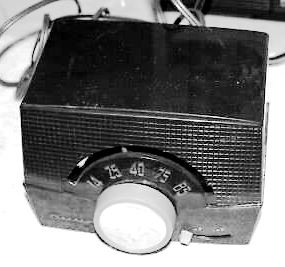
Early tube powered UHF to VHF converter box
So UHF broadcasting, until technology resolved many of the drawbacks over the next 30 years, was problematic. In early 1953 when UHF stations started hitting the air, only 35% of receivers could see those signals, and unlike the VHF tuners, which generally had detents as you tuned from one channel to the next, UHF tuners were continuously tuned like old radio dials. This made it easy to sub-optimally tune in a UHF channel with undesirable results. It was not until Congress passed the All-Channel Receiver act in 1962 that all receivers sold had to have built in UHF tuners in addition to VHF.
Besides the tuning issues, the band of UHF frequencies are much higher than the VHF band of frequencies. As frequencies become higher the signal does not refract around obstacles as well as lower frequencies do. Also, the higher the frequency, the less distance the signal will travel for a given transmit power. This meant that often without a direct line of site path from the transmit antenna to the receive antenna, UHF reception could be problematic.

UHF reception issues are a reason why local community antennas sprung up, which eventually grew into the cable utility/communications industrial complex they are today. These community antennas co-ops would be formed by small towns or communities in hilly and mountainous areas. The first were in locations like Arkansas, Oregon, and Pennsylvania. The co-op would band together the finances to erect receive towers, generally 100 feet or less in height on top of mountains, or hills to receive signals in problematic receive areas, and distribute it to members over coax cable. How those modest beginnings became your 1000 channel entertainment and Internet provider is a story for another time.
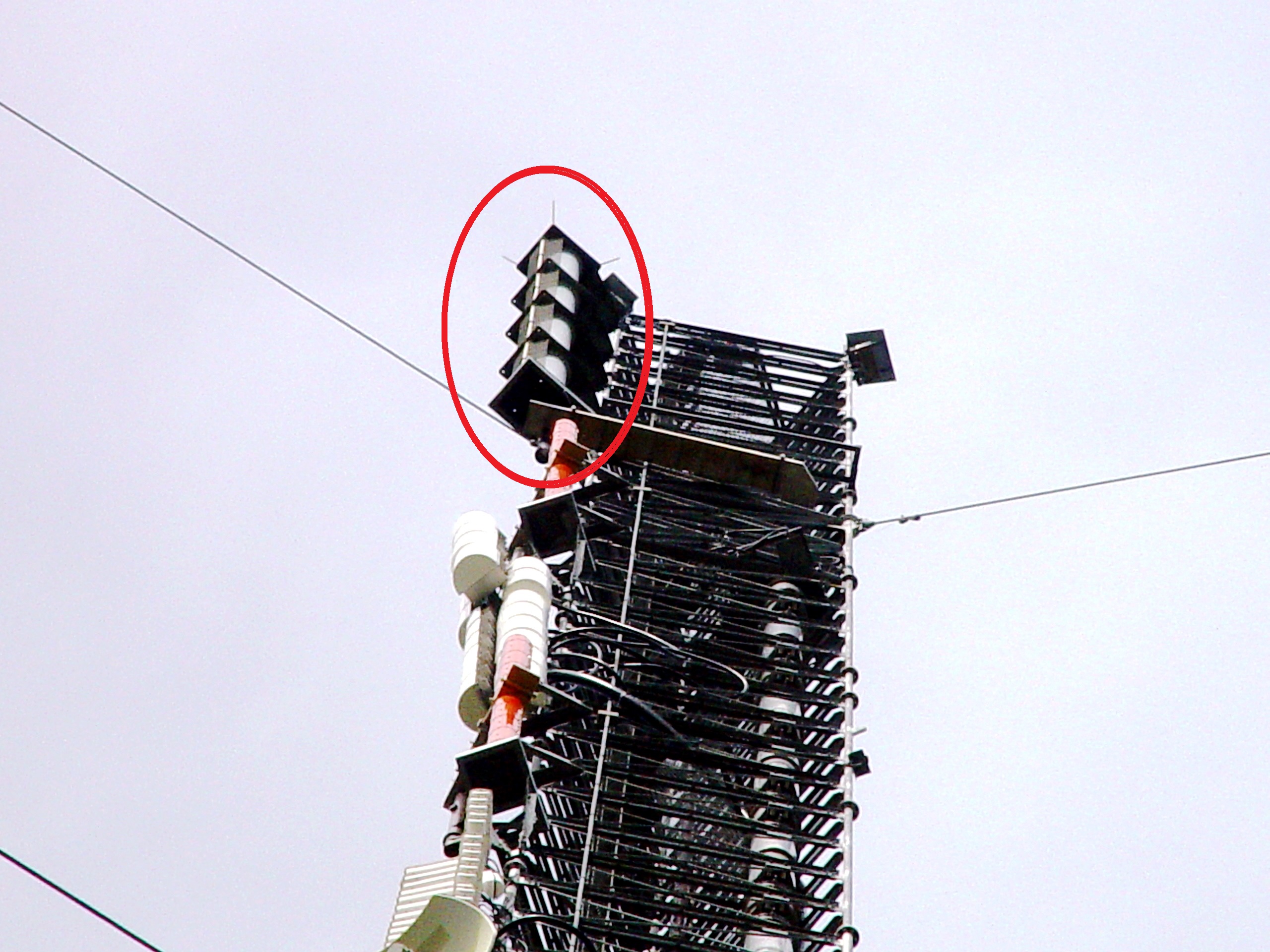
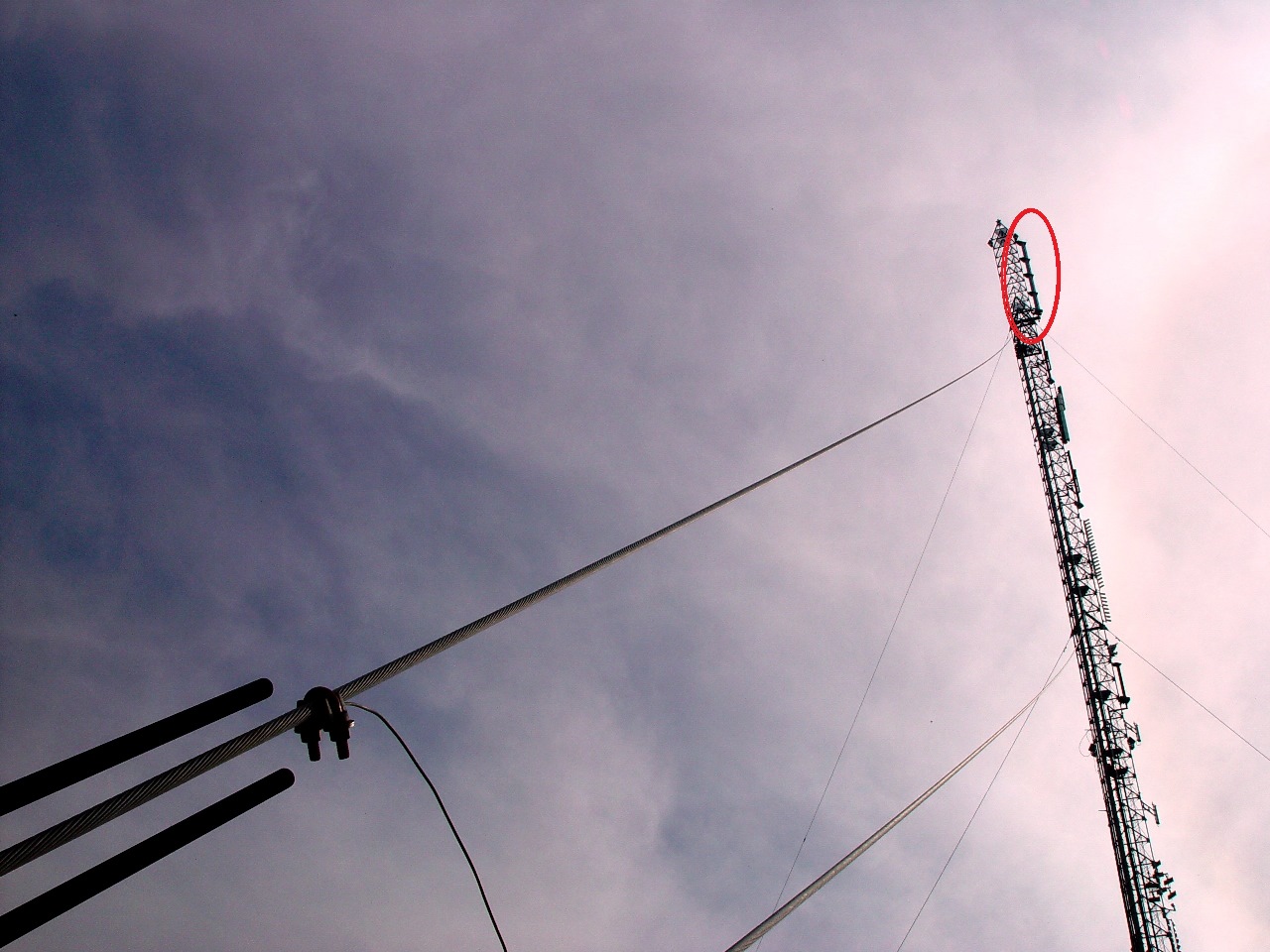
UHF Transmit antenna on a tall tower from two angles
There is an old RF adage; given a choice between height or power - always take height!
The antenna is circled. Where it comes to high frequencies, TV and FM included, the tower is simply a platform to get the transmit antenna as high off the ground as possible.
Plus that antenna is nothing like the old receive antennas you use to find on roofs. Because of the high RF power they handle, they need mass. They can weigh over 30 tons!
Being a UHF broadcaster was not easy. Because of the inherent lack of early viewers, many UHF stations signed on, lasted two or three years and went dark, that is off-the-air, because of financial hardships. As more and more people started using cable TV services, those systems continued to pop up across the country. Soon they started up in areas where reception wasn't a problem, and many opted to not fight with their own antenna on the roof or in the house and let someone else take care of the reception issues. UHF stations still faced a problem here for over 20 years. Early cable systems were quite crude in many cases, and they did not have the bandwidth to carry many channels. The first stations they left off their channel package were lowly UHF stations running old reruns, and other low-budget local public affairs shows. It was not until the late 70s that cable systems were forced to carry all local channels no matter how many viewers they had.
The basic economics of early UHF television did not make a lot of sense. Besides running programs that generally got low ratings, which resulted in lower advertising revenue, these stations generally had the same expenses, at least equipment wise, as the VHF stations had. Early on black and white cameras were tens of thousands of dollars. When color cameras became available, they were around $100K a piece. The UHF broadcaster would often be forced to do with black and white cameras early on while the better financed VHF had color. Or if the UHF wanted to offer color studio programs they might have only one or two of them, while their larger brethren had three or four.
Now on to the biggest financial elephant a UHF station faced. Transmitting the signal. A VHF station could cover a given area with what was referred to as a city grade signal, that is one that is received easily and clearly, to leave out all the other technical jargon, with 1/10th to 1/50th the amount of power that a UHF station would need to use to cover the same area. A few pages back we mentioned the early RCA transmitter used for the 1931 tests. The physics involved then were the same now. The transmitter only converts a small percentage of the power fed it into a usable transmitted signal. Early ones were often about 20% efficient. That means only 20% of the power fed into it will be transmitted. Today, with vastly new technology that value is still only around 40%.
UHF broadcasters that wanted to be a "blow torch" as very high-powered transmitters are referred to, would find their monthly power bills being several hundred thousand dollars. For many stations that by far was their largest line item, often consuming over half the stations cash flow. It took about 25 years for UHF stations to start to make money.
TV Networks
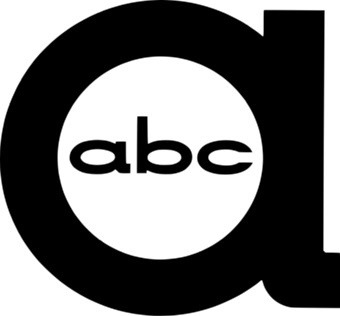
As we will see the third network was very important to Grass Valley 
On the VHF side things were brighter, but pitfalls still abounded. Right after the war the two big radio networks, CBS and NBC rapidly ramped up their television operations and programming. While ABC, a recent spinoff of the NBC Blue Network, which we covered earlier, waited a couple years before launching into television, because of the three it was in the weakest financial position.
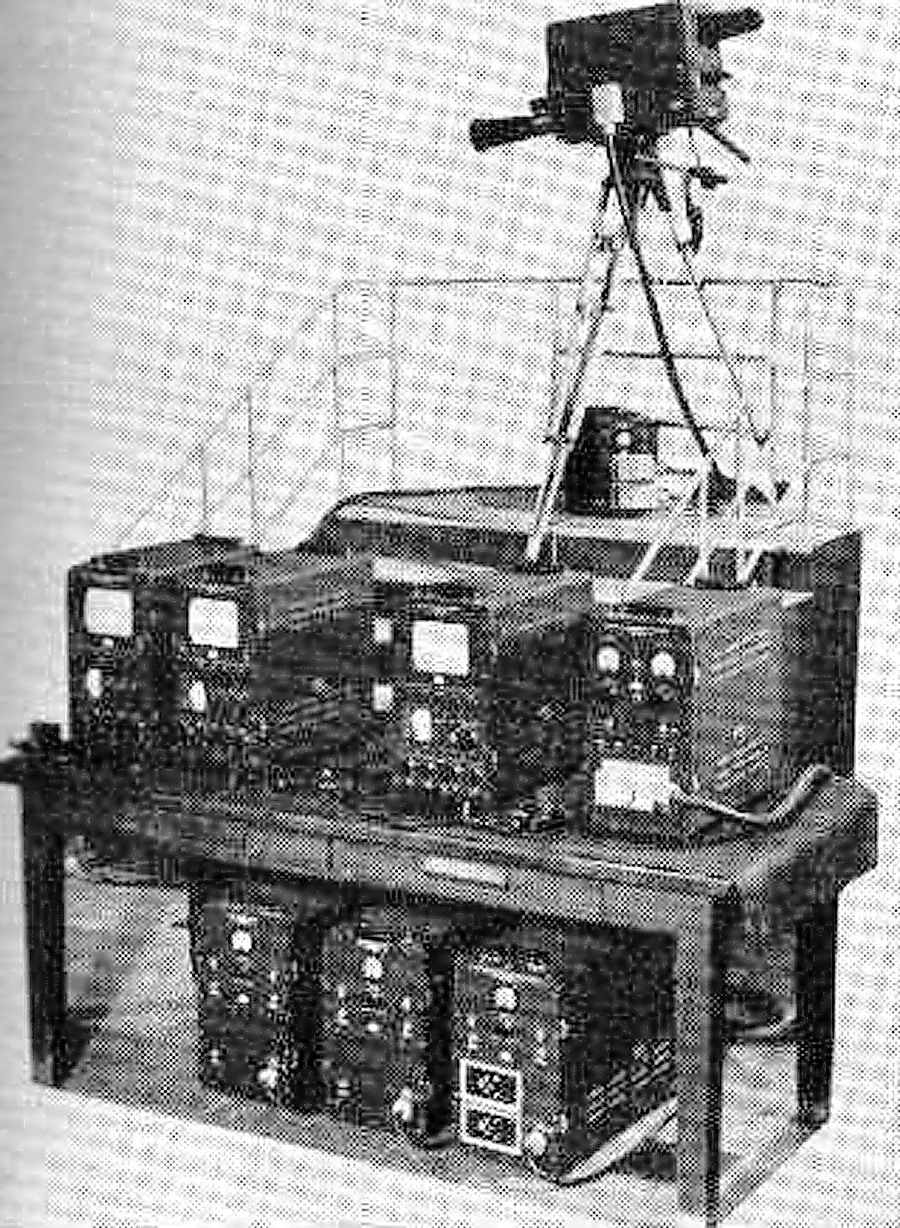
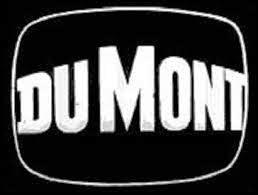
Dumont television camera equipment
Dumont started as an equipment vendor, originally supplying oscilloscopes. It also started producing television cameras, before it started it's fledgling television network.
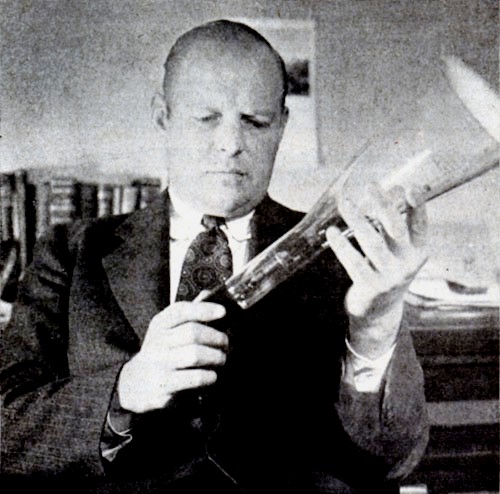
Allen Dumont with one of his CRTs
Dumont started as an equipment vendor, originally supplying oscilloscopes. It also started producing television cameras, before it started its fledgling television network.
In 1946 Dumont Network was founded as a subsidiary of Dumont Electronics. The Dumont Network always faced a major problem, how to make a profit without the benefit of an already established radio network as a base. The FCC' freeze on new stations helped doom the new network. The network lasted 10 years before shutting down. What was left of the network, mainly the stations it owned were sold, eventually becoming Metromedia, which sold the stations to the Fox Television Stations Group in 1986, when the Fox network was formed.
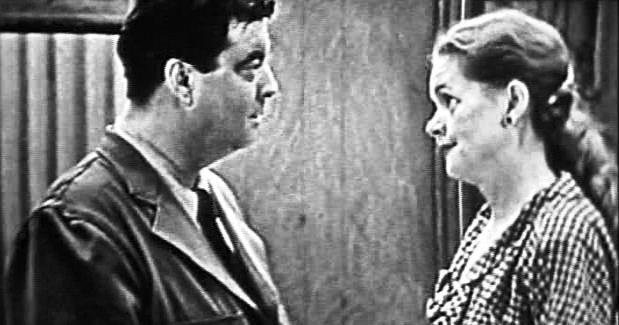
Dumont helped launch the career of Jackie Gleason on a show called Cavalcade of Stars in 1950. Gleason was wowed to CBS in 1952. Dumont also helped another well-known comic of the era, Ernie Kovacs, launch might have been the first late night show in 1954. Despite this, and a number of other popular and successful shows, including the first network-televised game show, the network today is often referred to as the forgotten network.
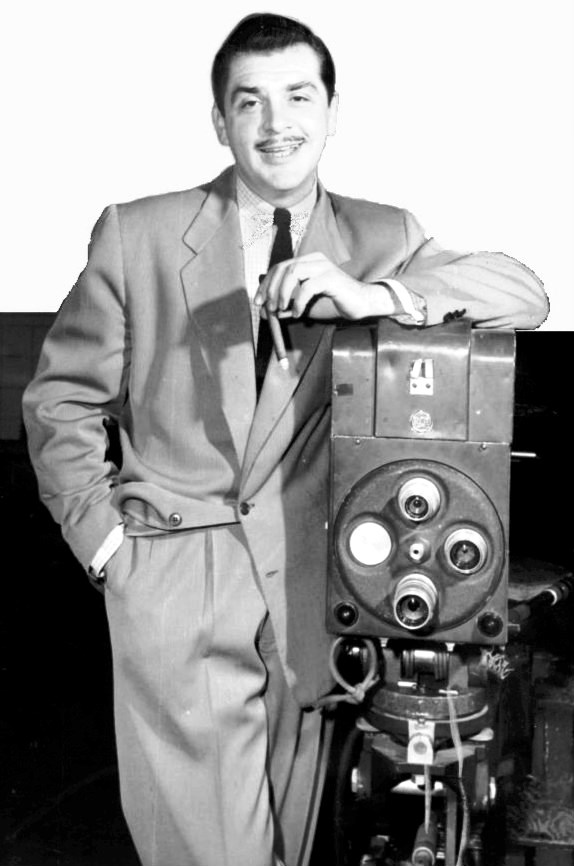
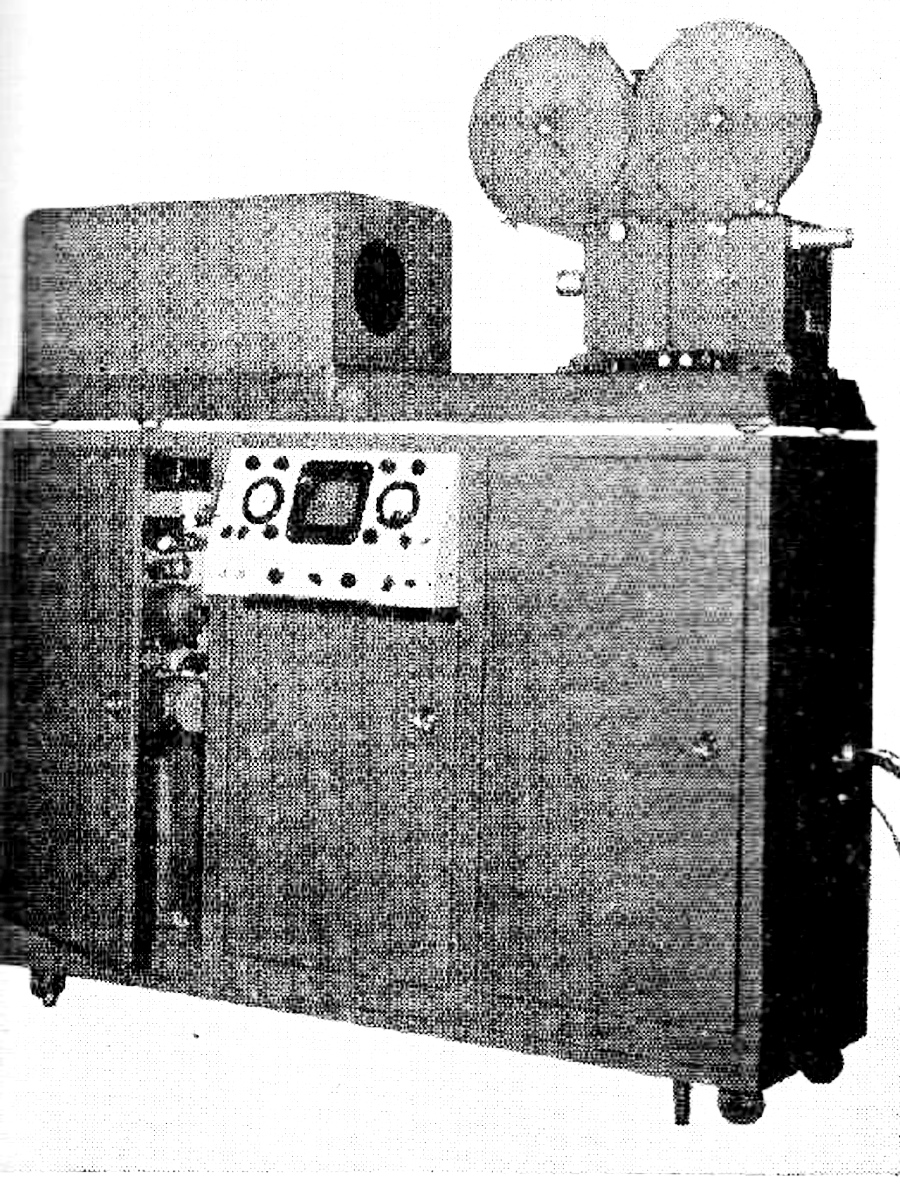
How video was recorded until the late 50s
Video tape recording was not perfected until the year Dumont closed shop, so many of Dumont's programs were archived using a process called Kinescope. This was a large machine that consisted of a mounted film camera which looked at a very bright CRT. The live program was film recorded off the CRT. The process provided a usable, but not stellar film rendition. Much of this Dumont film library was destroyed by 1958 to recover the silver content of the film prints. In the mid-70s most of the surviving copies were unceremoniously dumped into New York Harbor.
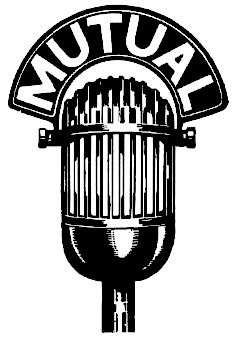
The other big radio network of the day was Mutual, which we have already discussed as a radio network. While it discussed on several occasions about moving into television, as a network it never did, although many of its affiliates did on their own. A lot of this might have been the nature of the network's organization, being a cooperative instead of a centrally run network. This even though, like CBS and NBC, it had many popular radio shows that could have been converted to television shows, as the other two networks were doing, re-purposing much of their radio lineup to port over to television.
But the term network, way back when it was first applied to radio and television, was also referred to as chain broadcasting. A central facility or station would send out programming that would be linked from one city to the next, feeding the local affiliates. By 1928, using dedicated lines from the AT&T, NBC had linked, or chained, their radio stations from the east to the west coast. To handle more audio traffic, at the time a path could only handle 240 separate calls, and to be able to handle later additional television traffic, Bell Labs patented what resembles today's coax cable in 1929 and started to install it throughout their system. An early path was from New York to Philadelphia with experimental television transmission commencing in 1937.
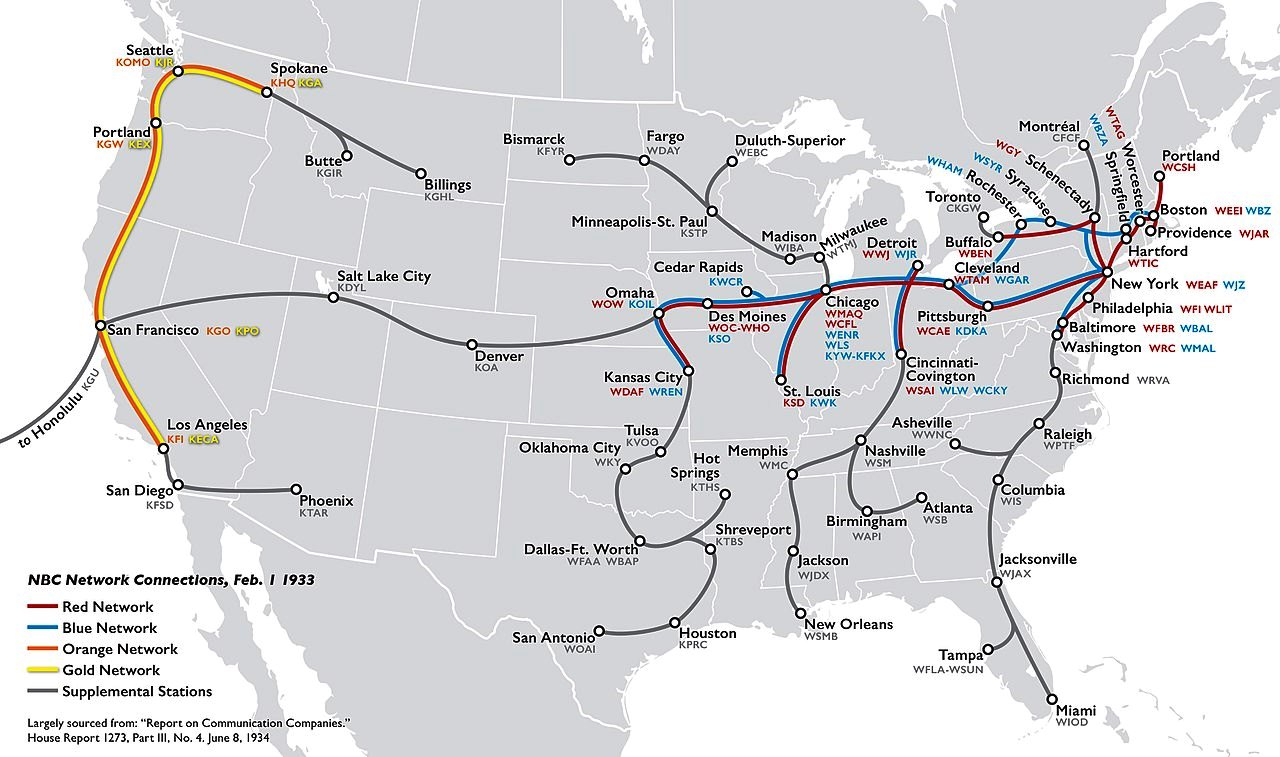
NBC Radio Network interconnections - 1933
In 1940 that path was used by NBC in New York City to air the Republican Convention in Philadelphia. Right after the war AT&T installed a 225-mile path from New York to Philadelphia to Washington, D.C. The Dumont Network was the first to use that path on a regular basis in August of 1946. The following year NBC started using the same path with a RF link in addition to Schenectady, N.Y. A couple of months later NBC added Baltimore and Boston. In 1948 CBS and ABC started using the same east coast paths. In 1949 television network feeds were added to the Midwest and two years later feeds were making it to the west coast, using microwave relay technology, and not only coax.
It took 34 microwave relay sites just to get from New York to Chicago. The main original coast to coast backbone went through places like Pittsburgh, Cleveland, Toledo, Chicago, Des Moines, Omaha, Denver, Salt Lake, and terminating in San Francisco. Other parts of the country north and south of that path were fed by branch lines off the main backbone. Today that infrastructure is gone, having migrated to satellite, and increasingly fiber. What remains are scattered towers and support buildings that were often built to be self-sufficient, and even nuclear bomb and fallout hardened. The highest relay point in the backbone was a facility at 10,075 feet a top Slide Mountain, overlooking Reno and Lake Tahoe, not too far to the east of Grass Valley. 
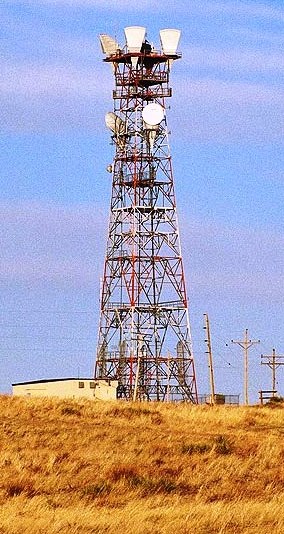

Looking west towards Lake Tahoe from a top Slide Mountain
AT&T Long Lines relay site
still standing in Colorado
Network Compensation
While no longer the case in many instances, the networks used to pay their affiliates to carry their programming. Today in many cases the affiliates now pay the network. This situation started when Fox paid abhorrently high fees to wrestle NFC football away from CBS in the early 90s. They ended up demanding that their affiliates help cover the cost of that contract. When NBC, which had tried to own a station in the San Francisco bay area for 50 years, lost in a bidding war to acquire its then current San Francisco affiliate, KRON, in 1999, NBC demanded that the new owners pay $10 million a year to carry NBC programming. It refused and when its affiliation ran out, a station that was looking for network affiliation, KNTV accepted even harsher terms, $37 million a year.

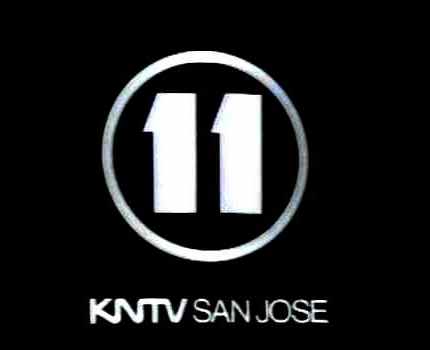
KNTV became the first major affiliate to pay their network instead of the traditional opposite flow. The now cash strapped station was soon forced to sell out to NBC. This started the trend of affiliates paying networks instead of networks paying affiliates.

NBC had engineered a similar coup in 1955, when it coerced a swap of a Westinghouse station in Philadelphia, with an NBC owned station in Cleveland, under threat of Westinghouse's KYW losing its NBC affiliate status not only in Philadelphia, but also in Boston if it didn't go through with the demand. At the time Philadelphia was the largest market that NBC did not own a station in and being larger than the Cleveland market seemed like a good deal for NBC, if not Westinghouse. The Westinghouse station, KYW, moved to Cleveland and the NBC one, WNBK moved to Philadelphia.
After the swap and move, Westinghouse complained to the FCC and an investigation was started. Over the next nine years as NBC tried to secure a station in San Francisco, which failed, and the original operator of the Philadelphia station, Philco, which was now owned by Ford, jumped into the fray by also trying to pry the Philadelphia station away from NBC, the FCC slowly sorted the situation out and in 1965 the swap was reversed.
The moral from these two stories is that becoming an affiliate with a network can be a Faustian arrangement. But early on it was much simpler, the networks paid their affiliates, first by market size, and later by ratings. In the late 40s networks paid its affiliated stations only about 30% of the station's potential ad revenue if the station produced its own shows that got the same number of viewers and kept all the advertising revenue. But local stations, in almost all cases, could not possibly finance network level programs locally.
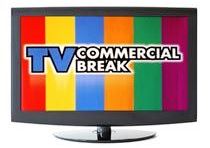
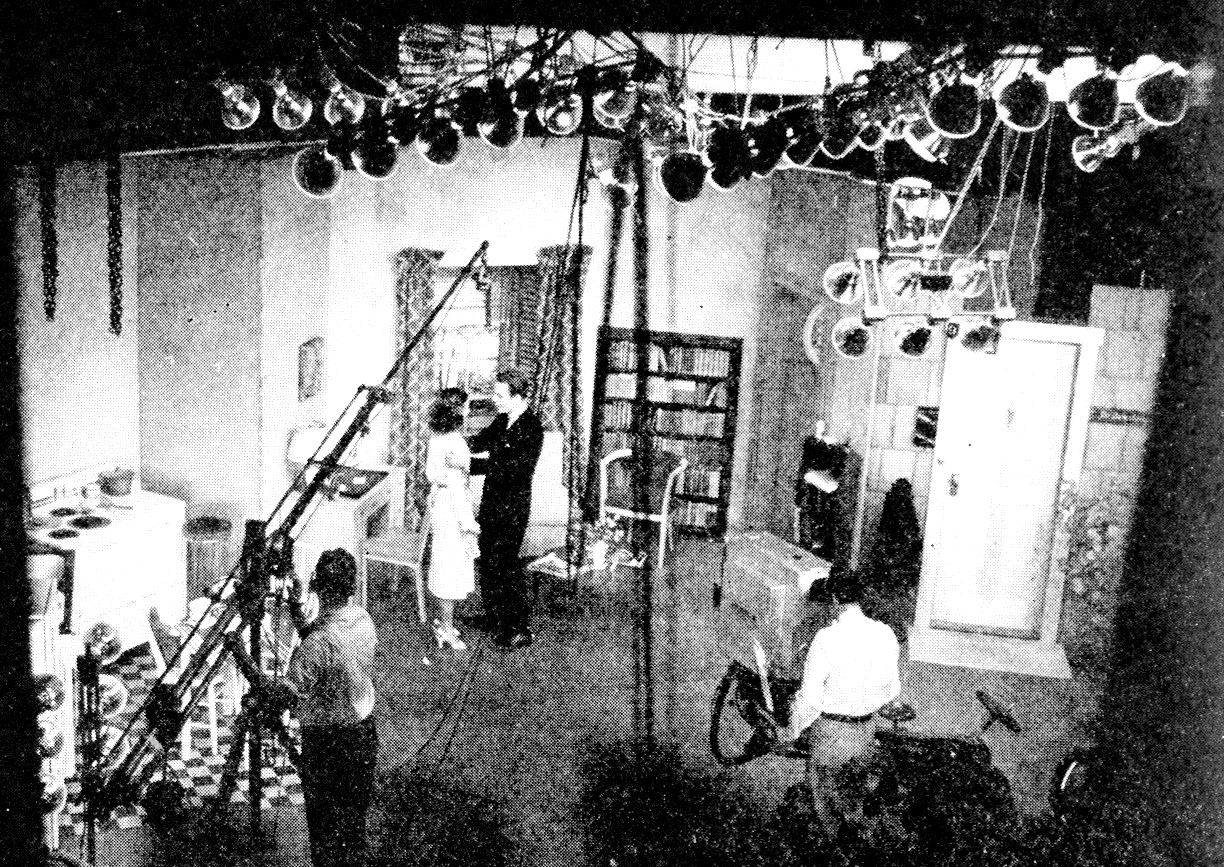
So the general deal was during network programming, which generally was prime time only at first, before branching out to morning and daytime programming, was that the local affiliate got about 90 seconds of commercial time each half hour that they could sell to supplement what they received from the network. This relied on the fact that the whole purpose of a show is to deliver the audience to the next commercial, as the network product is not programs, but the audience a show garners for the advertisers.
Early on television ad rates were 5% of what radio could command, so soon it was realized that TV didn't have much to lose by producing offbeat dramas. As mentioned in the 40s and first half of the 50s, except for Kinescope, TV's dependence on live, studio production, made the dramatic play the most feasible form to present. So, there was a lot of Anthology dramas, stories of human conflict and confrontation, which could be easily confined to a studio with few cameras and usually a small space.
Film production over live
 Early RCA TK-30 black and white camera at CBS Studio City
Early RCA TK-30 black and white camera at CBS Studio City
RCA TK-30 black and white camera doing Lawrence Welk
In the 40s and into the 50s TV came mainly from network studios in New York, but it slowly started migrating towards Los Angeles. At first most Hollywood film companies viewed TV as a threat and competitor. But the television networks were realizing the benefits to film production over live video production, and with all the potential opportunities that would present, Hollywood became prepared to accept all the money and work these East Coast heathens could offer.
Going from live to film changed the texture of TV. The early harsh tones of early TV cameras could be replaced with a softer film look. Film allowed much more choice in show formats. Besides the "anthology" series, many other dramatic adaptations covering a wide range of topics, soon led to episodic shows or the continuing series, featuring characters whose vocations, surroundings, companions, and emotional responses were rigidly defined, and reoccurring. TV also became a new market for the B movie, or the made for TV movies, using smaller budgets and not yet marquee stars. Eventually a mix of the two evolved into the mini-series.
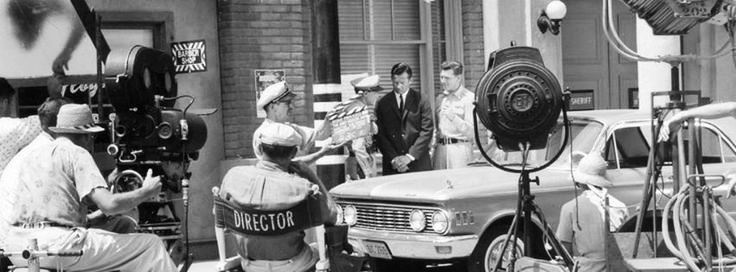
The major studios started producing shows shot on film for the major networks from the early 50s on. As we will see Disney was an early provider for ABC, as was Warner Brothers. ABC was an early adopter of shows shot by movie studios. ABC was lucky in its enlistment of the traditional studios to provide content, especially their timing in approaching Disney. But not all such arrangements worked out. In at least one instance a film studio saw an opportunity to become a television network itself.
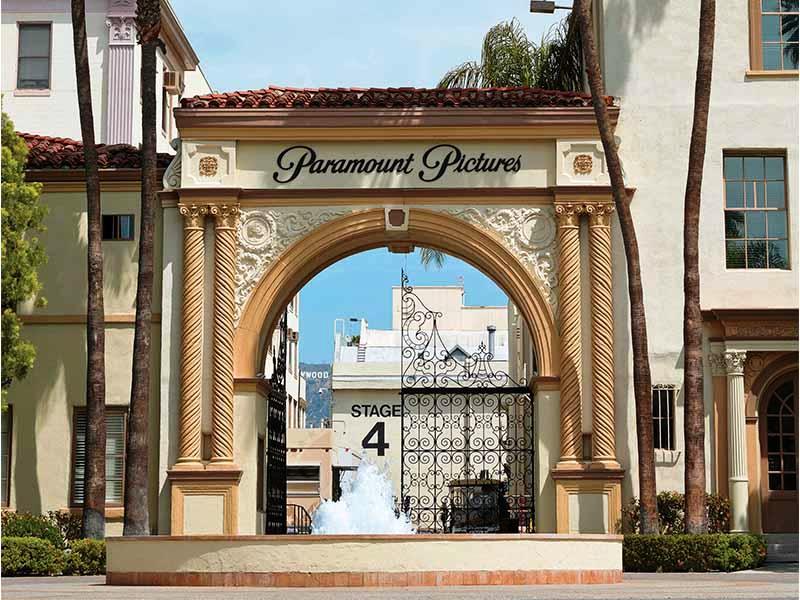
Paramount was forced to spin off its movie theaters, and that branch eventually merged with ABC. The movie studio side started investing in the new medium itself by building TV stations in Los Angeles, and Chicago and investing into the Dumont Television Network. The two companies ended up in endless breach of contract lawsuits that became just another burden on the network. Coupled with the fact that for a number of years the FCC limited the number of new stations allowed on the air, so Dumont couldn't put new stations on the air to cover all the markets that NBC and CBS had. Most of the new stations they did get were UHF, and as already discussed, they were problematic.
Even with the new stations Dumont put on the air, the sole carrier of long-distance television programming, AT&T, did not have enough capacity to handle the distribution of all four networks. In the early 50s AT&T deferred to the predominance of NBC and CBS and allowed them to each distribute 100 hours of prime-time programming per month to their affiliates. ABC was allotted half that, and Dumont, once considered the third network, and now the 4th, less than 40 a month. On top of that until Dumont was able to persuade the FCC to prevent it, AT&T required the networks to lease both radio and television circuits. Dumont was the only network without a radio network and so it had to pay for a service it did not use.
Without a radio network Dumont did not have a stable of stars and the profits from radio to subsidize their television network as the others did. This was compounded by Paramount, who essentially controlled Dumont, not supplying programming to its own investment, but selling it to the other networks. A final straw was that Paramount owned two stations itself, along with the three Dumont had, the FCC deemed that because Dumont was essentially controlled by Paramount that the network really owned five stations, the limit for ownership at the time. The two Paramount stations did not carry Dumont programming. So, the other networks all owned five stations carrying their programming and Dumont only had three. We will see shortly why this was big.
At one-point ABC and Dumont considered a merger. The problem was Paramount's spun off theater side had merged with ABC, and the Dumont Network was effectively owned by Paramount's remaining studio side. Anti-trust considerations derailed that idea, and Dumont started a slow shutdown throughout 1955. For a couple more years, while not airing any regularly scheduled programs, what was left of the network was used to occasionally air sports and other special events.

As already alluded to, some have argued that eventually the network was resurrected. Two of Dumont's owned TV stations, one in New York, and the other in Washington, were spun off from the failed network into a standalone company, underwent a name change and then an ownership change. And finally, in 1986 were purchased together by News Corp to form the nucleus of the Fox Network.
Television's move from all network produced programming to a percentage done by the film studios came as the networks New York City TV studios, rebuilt largely from radio facilities were in need of a new generation of television equipment becoming available in the 50s. In 1954 CBS opened their Television City Broadcast Center in Los Angeles. It was the first facility built from the ground up with TV in mind. It opened with four large studios, with large stages, which could all accommodate studio audiences. One studio had 16,000 square feet with seating for 250. Over the years additional studios were added.
CBS Television City 1952 & today

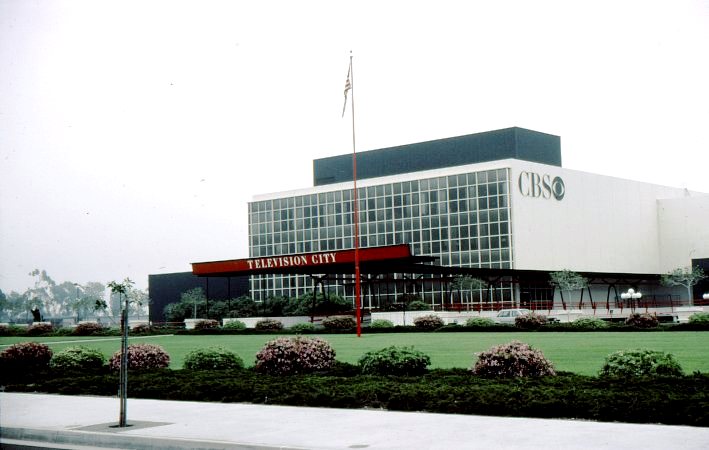
First U.S. network television facility built from the ground up for television. It was built on the site of a former football field and race track, Gilmore Stadium. Before the stadium, it was an oil field.
1st floor plan
Historic Studio 33
Studio 33 is the current home of the long-running CBS game show The Price Is Right and the HBO late-night series Real Time with Bill Maher. This soundstage was also the home of The Carol Burnett Show for its entire 1967 to 1978 run, and The Red Skelton Show prior to that (1953 to 1970), as well as the notable game show, The Match Game (the 1973 to 82 Gene Rayburn hosted version, and the 1998 version). Other shows include the $100,000 Pyramid (the 1980s run), Hollywood Squares (hosted by Tom Bergeron), Wheel of Fortune from 1989 to 1995, the 1986 to 1989 revival of Card Sharks, the 1983 to 86 version of Press Your Luck, and the 1988 to 1995 run of Family Feud. On April 9, 1998, on the 5,000th episode of The Price Is Right (actually number 5,133), CBS named Studio 33 as the Bob Barker Studio in honor of the show's longtime host and executive producer.
Basement floor plan
Typical of the original four studios
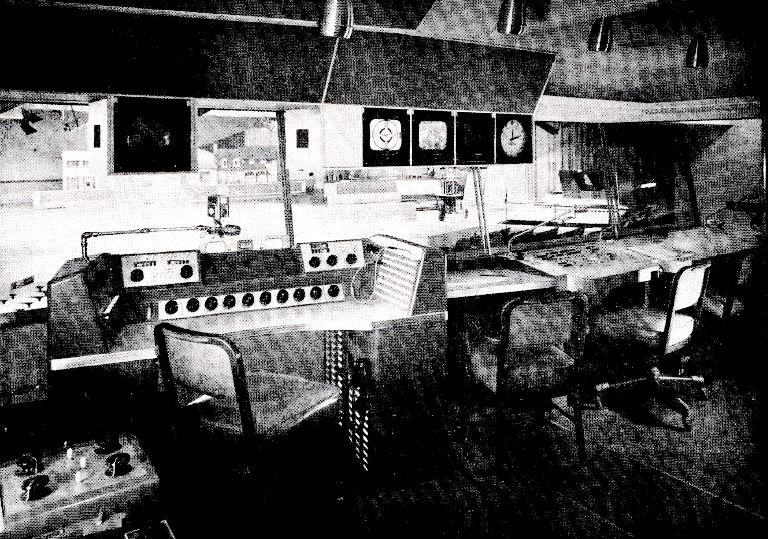
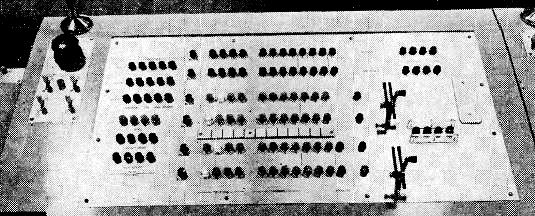
Studio Control Room
The photo of the video production switcher shown here is indicative of CBS's dilemma with RCA/NBC. From the cameras in the studios, to much equipment in the control rooms and throughout the plant, it came from RCA, as did this video production switcher.

As we will see shortly with the introduction of color, this dilemma became more acute. Studio 43 was equipped with RCA TK-40/41 color cameras in 1954, with cables allowing any of the original four studios to use those cameras. In 1956, Studio 41 was also equipped with RCA TK-41s. However, as we will see CBS color broadcasts decreased in frequency until the following decade, when the 1964 production of Rodgers and Hammerstein's Cinderella was recorded which was the last known use of the RCA color cameras by CBS. CBS programs were, in general, in black-and-white until color cameras from other sources where made available starting in late 1964.
Even while the networks were enlisting shows shot on film from the traditional movie studios the networks were realizing that they would need to revitalize their television facilities as many shows could not be economically done relying solely on the film studios, not to mention the pitfalls just seen in getting in bed with them.
The facility was designed with expansion in mind and making television production as efficient as possible. Trucks, tugs, forklifts, and dollies could get completely inside the building and right up to the studios for quick load in and load out of sets and equipment. They even had separate rehearsal rooms, so that the actual studios could be kept busy doing actual production. The layout of the facility was also setup up to facilitate the workflow of television production, from not only the movement of material and equipment but how the talent moved through rehearsal, makeup, and into the studio.
A major problem with the re-purposed radio to television studios in New York at the time were that they were generally cramped which resulted in horrendous cost of not only building the sets, but the disassembling, pack out, transporting, and re-assembling of sets in confined facilities, all the while dealing with a dozen different craft unions in the process. But the footprint in New York, although dropping some, has always remained the center of gravity as New York is still a hub when it comes to the mediums financial command and control. While shows produced there are more expensive to produce, the national heft of the networks still made it worthwhile. NBC still has nine studios in its Rockefeller Center Complex, CBS has eight at its Broadcast Center, and ABC has half a dozen spread around Manhattan.
News
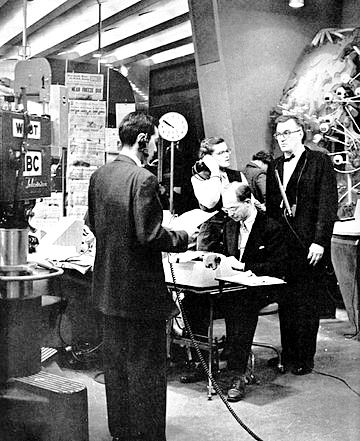
Dave Garroway on the Today set - 1952
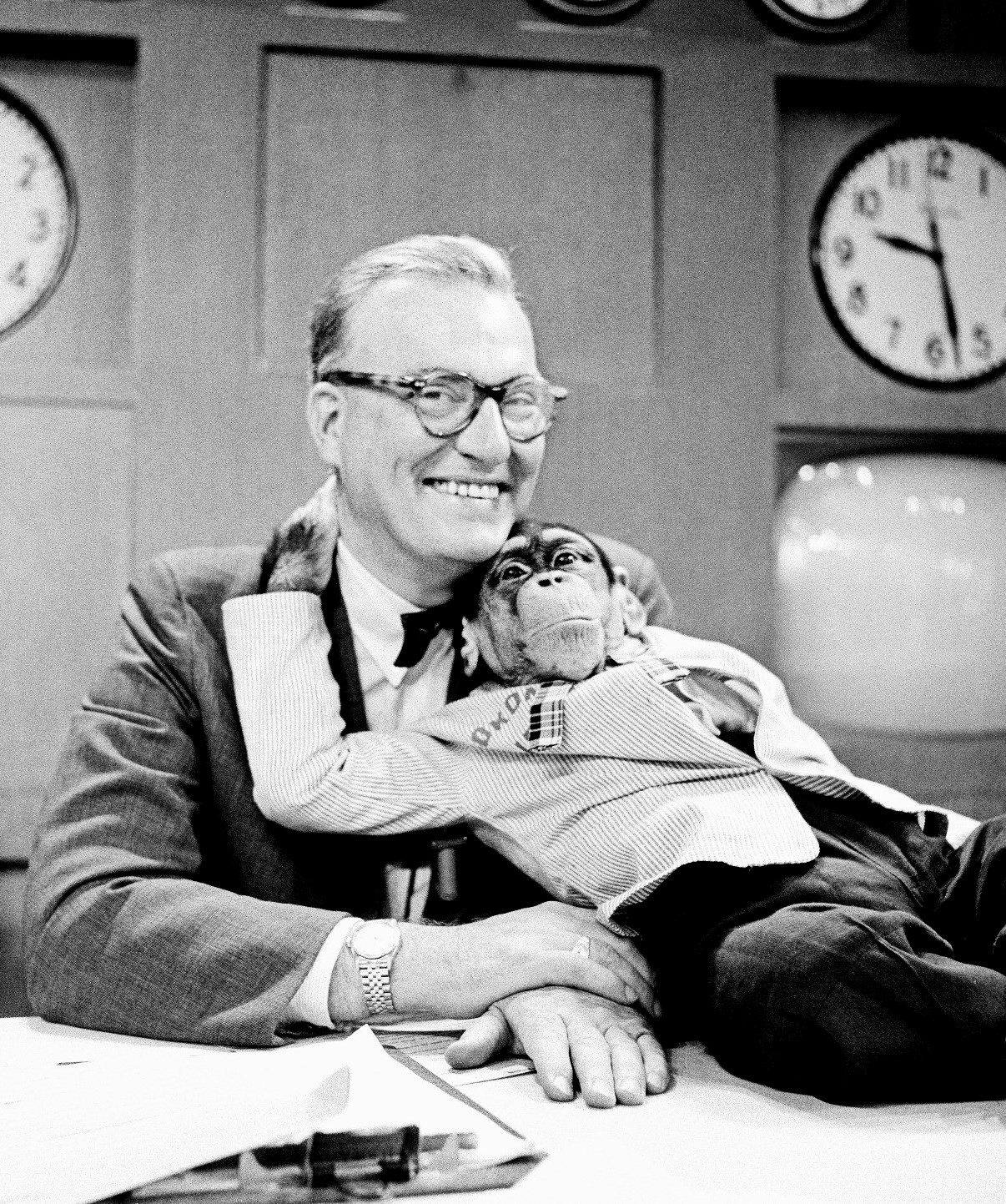
Originally it was a three ring circus!
Included an animal act.
News became an important ingredient of television as it was a way to fill time throughout the day, especially in the morning. The morning news and information show concept took off. NBC premiered The Today Show in 1954 with Dave Garroway as the shows first host. That first year the show sold $7.5 million in spots, the most revenue of any show that year. A one-minute spot commercial sold for $3861, at a time when there were only 15 million sets in the whole country. When Today debuted, it cost $24,000 a week to produce. By the late 60s that figure had risen to $100,000. Often early on there was a bit of deception in that often filmed interviews of a guest were done with the producer asking questions, then bringing the film back and edited and having Galloway act like he was talking live to the person being interviewed.
Garroway had an easy-going style. He started as an NBC Page in 1938, and went through NBC announcers school, graduating 23rd out of 24. But that did not stop him from becoming known in the Pittsburgh area working for KDKA. His laid-back approach to entertainment grew out of wariness being a "daytime' sailor in the navy during WWII in Honolulu and too tired to plan the evening radio show he had. His start-stop cadence made his words at times poetic. He was able to build elaborate word pictures.
Sometimes cities would pay for the Today Show to be done locally. Early on Miami Beach paid $25,000 to bring the Today and Tonight shows there for a week. Most Today Show Remotes were bankrolled by local interests. Often these road trips were headaches for the shows Unit manager. The unit manager is the watchdog of the show's budget. This person does not work for the producer, but for the networks business affairs department. He sees that the show stays within budget. The unit manager would have to sign-off on any shows done in a remote location. Often the proposed locales did not make any sense financially.
Early Today shows done in the studio looked like a three-ring circus, with the studio that subbed as a newsroom, interview set, and an area set aside for entertainment acts. Activity involved with setting up for coming segments could often be partially heard and seen in the background. David Sarnoff once said his initial impression of the show, indicative of the times, was that it involved too much smoking. It was said that the Today Show was "happy talk" long before ABC thought of enacting it. The show even had a comic section, as Garroway's co-host for a while was a chimpanzee named J. Fred Muggs. This helped soften Garroway's no nonsense approach when he was presenting the news. It also gave a reason for the kids to highjack the TV to watch Muggs antics before they were off to school.
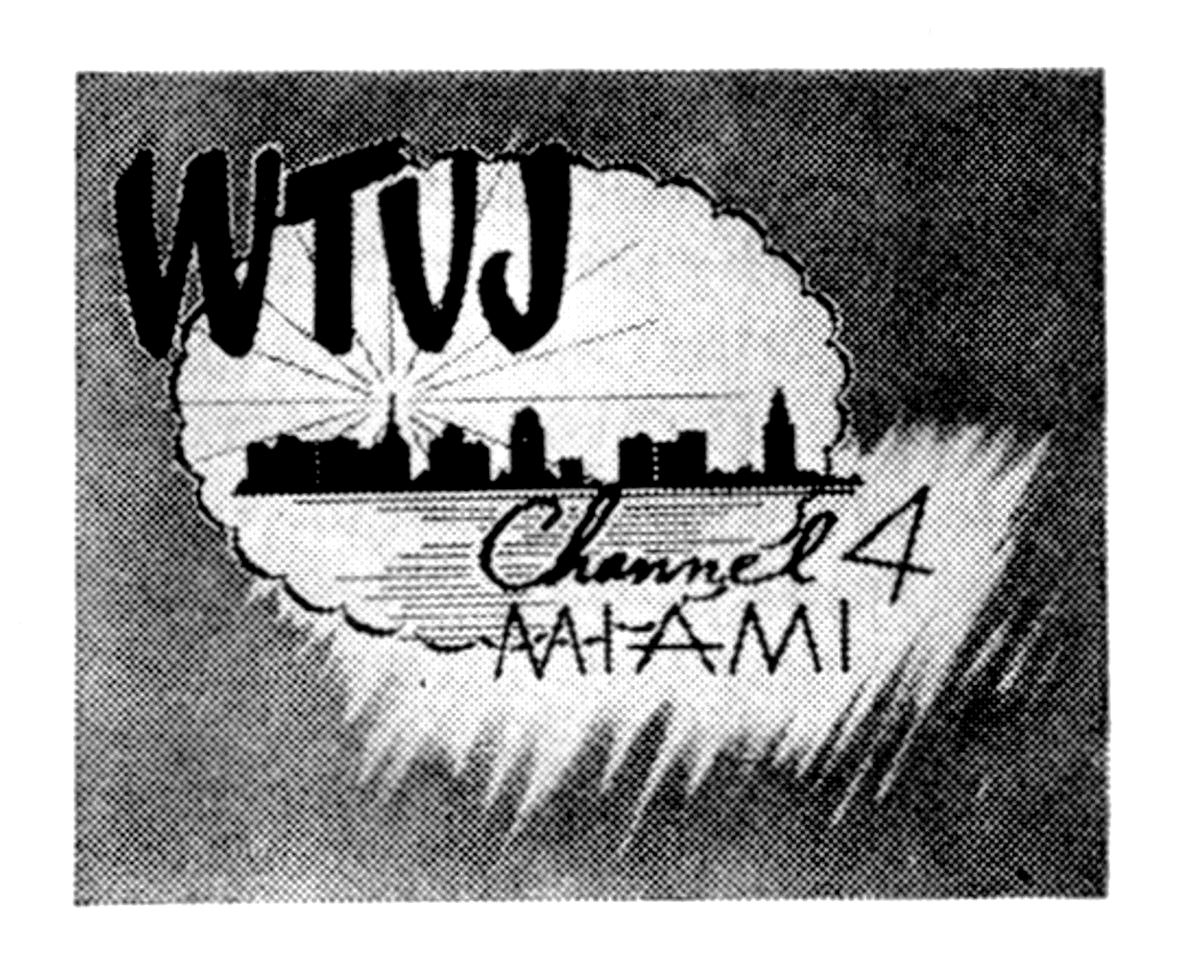
Crude Graphics
In the early stages of television, graphics where usually art cards shot by a studio camera, and they were gray looking and static so there was not a lot of use of graphics, as shots with some action in it was preferred by viewers.
The late-night variety show also took off in 1954. The Tonight Show with Steve Allen first aired on NBC. An early Tonight Show producer was able to make a deal with the unions that paid all guests, no matter who, a flat fee of $265 per appearance. This established the highly efficient economics of late-night talk. While Allen got $3500 a week, and they spent about the same on guests, the other costs were modest and fixed. The Tonight Show had a total original budget of $11,000/week. An hour or even 90-minute late show had an abundance of commercial time and low costs, so these type of shows became cash cows for the network.
A problem shows faced early on was that sponsors had much more control of program content. The sponsors often sponsored entire shows and thus had their names on the shows. They were generally hostile to controversy. During the McCarthy hearings backlisting of celebrities became commonplace. This fact made the TV blacklist successful because groups threatened to boycott sponsors who had backlisted actors on the shows, or even producers and directors on the list. There was a Ford sponsored show in which Ford wanted the Chrysler Building painted out of the New York City skyline. Cigarette manufacturers insisting that only heroes, but no villains smoked. The American Gas Association wanted the mention of "gas" out of a script when a show they backed talked about Jews dying in gas chambers. Proctor and Gamble required that none of its shows depict business as cold, ruthless, or lacking all sentiment or spiritual motivation. This caused many battles between sponsors, writers, directors, and even actors.

What finally mitigated this were the game show scandals of the 50s. Game shows originally were not done because some claimed it was a form of gambling. It took a Supreme Court decision in 1954 that said they were not. But like many shows they were controlled by sponsors, many of whom wanted the maximum amount of excitement and drama. This lead a few shows to choreograph, or script who won, and who lost. The most notable probably being a show called Twenty-One, which ran on NBC. The first show was unscripted, and the contestants made a mockery of the show by not answering most questions correctly. The sponsor, Geritol, was not happy, and said they better not see a repeat performance. From there on the shows winners and losers were known in advance. One of the shows contestants, told to lose, eventually came forward to spill the beans.
While in the end no one went to jail as it was determined no laws were broken, Congress amended the Communications Act, and the FCC implemented rules that were intended to jeopardize broadcasting licenses if it happened again. While this would not directly affect a network, all the networks owned stations of their own, and those licenses could be put in jeopardy. The networks used this scandal to take back control and own most of what they aired.
CBS, after the quiz show scandals it was involved with, such as the $64,000 Question, and Ditto, promised Congress and the FCC that CBS would pay its public debt with a new commitment to public affairs. CBS from early on in radio could not compete with NBC in entertainment, and instead built a stable of legendary reporters, including Edward Murrow, Eric Sevaried, Walter Cronkite, Harry Reasoner, Harry Smith, and Dan Rather. Murrow literally built CBS News. Later the network produced several notable women reporters which included Lesley Stahl, and Diane Sawyer.
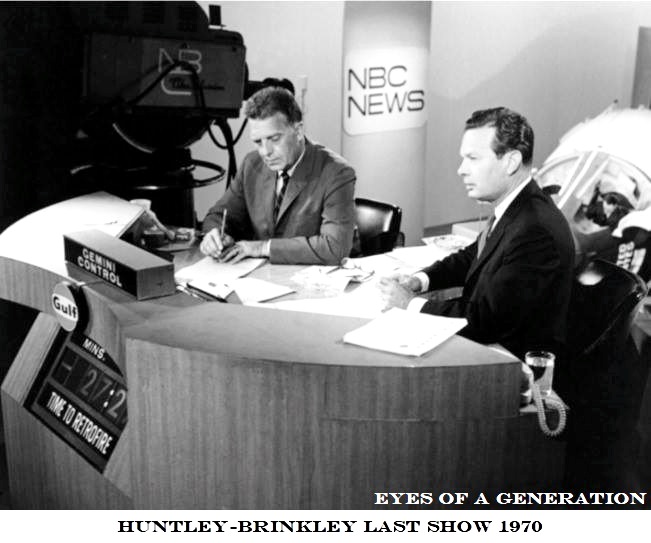
When TV started to eclipse radio, NBC got serious about competing in news. Their compliment of legends became larger than CBS's. From John Cameron, Dave Garroway, Frank Blair, David Brinkley, Chet Huntley, Chris Wallace, Barbara Walters, Hugh Downs, Frank McGee, Tom Brokaw, Jane Pauley, and Bryant Gumbel, just to name ones that came before the 90s.
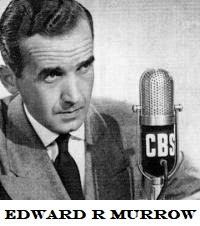
Until the 60s network newscasts were only 15 minutes long. CBS still was not yet able to transfer the pre-eminence of its Murrow radio years to TV. At that time NBC had true TV news personalities but CBS did not until Walter Cronkite, who was hired by Murrow, took over as anchor of the CBS Evening News in 1962 from Douglas Edwards. Because, in part, of Cronkite's success as anchor, CBS was the first network to expand their evening newscast to 30 minutes. While at the start of the 60s NBC had more viewers, CBS poured more money into their news division than RCA allowed NBC to do, and with CBS's growing reputation for greater depth of coverage, by 1967 their news ratings were starting to beat NBC's.
During those years of competition between CBS and NBC, ABC was not much of a factor yet, the two had a tacit understanding that they would not compete against the other's news shows with entertainment programs during their evening news blocks as the entertainment program would take the bulk of the viewers. Then, as is much the case now, the networks would offer two or three showings of the evening newscast to allow affiliates to select the one that best fit the local station's "news block." Often the first two airings would be live as the second would often have fewer mistakes than the first airing. The third airing, usually a recording of the second newscast, could be done live also if breaking news required it.
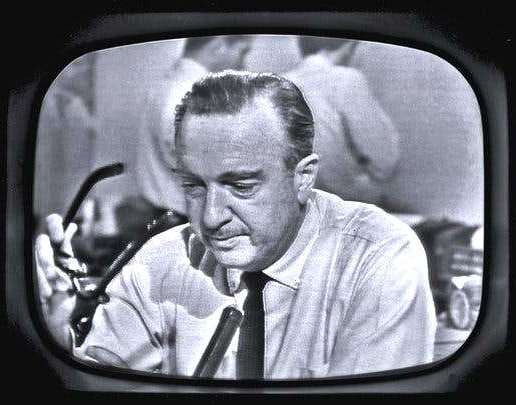
Cronkite's popularity was a liberating force in CBS's news department. While the network often complained about the cost of their news division, it was often the first, and foremost thing highlighted in corporate earnings reports. It was known as the Crown Jewel of the "Tiffany Network." News did not make money, but it was a loss-leader for other shows and offerings. That was much like NFL football is today for the networks that air it. While the rights costs to air the games ensures that the networks will lose money, it is a vehicle for promoting the networks other offerings.
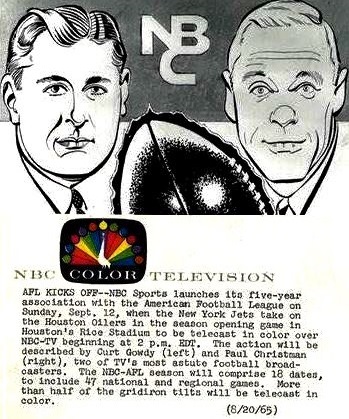
NBC AFL Press Release
In the mid-60s the struggling AFL signed a $42 million five-year contract with NBC. Joe Namath just had signed with the Jets. In the mid-60s CBS paid $14 million a year for NFL. In 1970 ABC paid almost $9 million a year for Monday Night football. Mere peanuts by today's standards. Today television as a whole, through ESPN, DirecTV, NFL Network, Fox, CBS, NBC, Yahoo!/Verizon, and Amazon pay the NFL almost $9 billion a year. The NFL is the most valuable entertainment property in America.
Cronkite's reign at CBS gave viewers what they needed, but not necessarily what they wanted. CBS had a standards book. To be interesting back then was the lowly aim of the rest of broadcasting, but not news. CBS News embraced Cronkite-Murrow's values, which came by being trained in the straight away style of the wire service. In comparison to how other news was consumed back then, newspapers and magazines, the amount of raw news a TV newscast provided was extremely small, and the argument at the time was that it had to be precise. If the text from a typical nightly half-hour newscast was printed, it filled less than a full page of a metropolitan newspaper of the day.
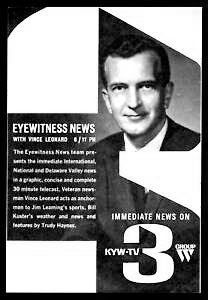
A crucial difficulty with TV news is unlike a newspaper the eye cannot jump to another story if the current story is not of interest, so every item had to interest everyone a little and not go on too long. So, it did not take long for the pure journalism aspect to start to become diluted. In 1959 the Eyewitness News format was started by KYW (yes, those folks again) a Westinghouse owned station in Cleveland. They launched the first 90-minute local newscast and called it Eyewitness. Other Westinghouse owned stations adopted the name. When KYW moved back to Philadelphia in 1965 its news director expanded the Eyewitness news format. The reporter would be the eyewitness to the anchor in the studio. The anchor would introduce the story, and the eyewitness reporter would fill in the details. Technology of the day limited the extent at which this could be done from location live. The eyewitness reporters account was usually recorded on film, or a combination of film with the reporter in the studio or newsroom.
Early on news relied on reading a lot of copy with some film stories intermixed. Back then video cameras were awkward and relatively immobile, especially color ones, which weighted hundreds of pounds, Stories were shot on 16 mm film. Film was expensive and often used sparingly. The live shot was relatively nonexistent unless television equipment happened to be setup where a news story occurred. Dan Rather described the liberal use of film as a lot of "fuzzy and wuzz," lots of police action and dead bodies. Cronkite noticed Rather's coverage of Hurricane Carla in Galveston. Cronkite said, "He was ass-deep in water moccasins." Film, being precious, meant it had to convey lots of action when it was used. And with the dawning of the "Eyewitness" news era, action was the name of the game.
 First "portable" black and white camera; Used smaller newly introduced "vidicon" imaging tube at 56 political conventions
First "portable" black and white camera; Used smaller newly introduced "vidicon" imaging tube at 56 political conventions
Much smaller by the 64 conventions
Color at the 68 conventions (two examples)
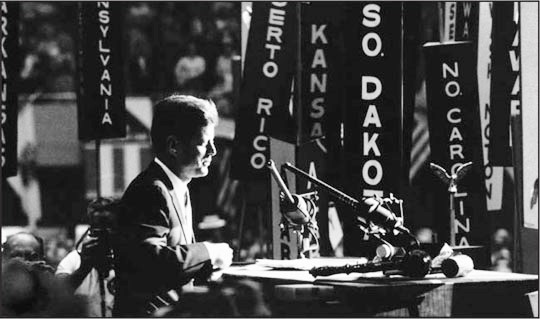
Back then News showed brightest every 4 years at political conventions where all the personalities and equipment could be brought to bear. At that time, it still was not the daily informing force it would become. TV News also shined with large, planned news events such as the Presidential debate televised in 1960, the first live televised presidential news conference, and the first western viewing of a live USSR parade for Yuri Gagarin on the BBC, both in 1961.
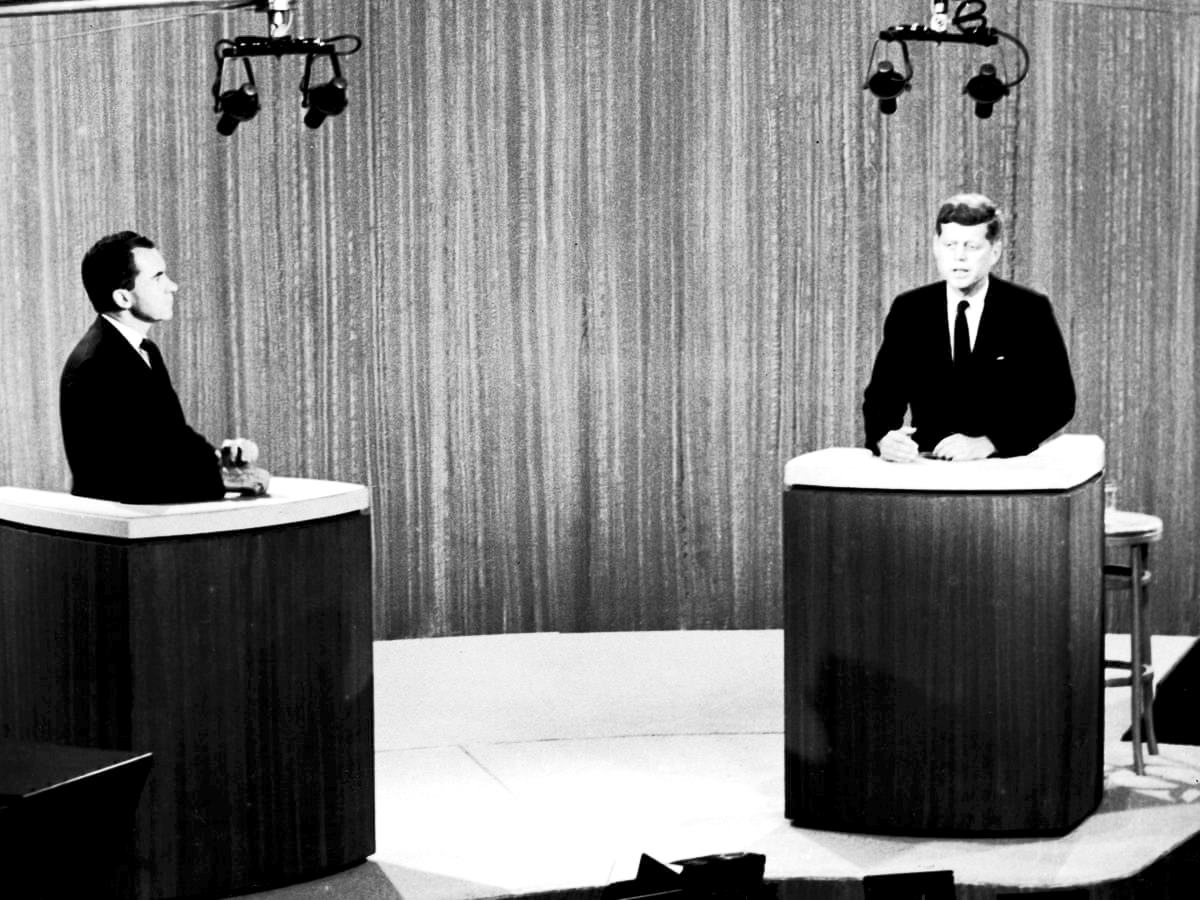
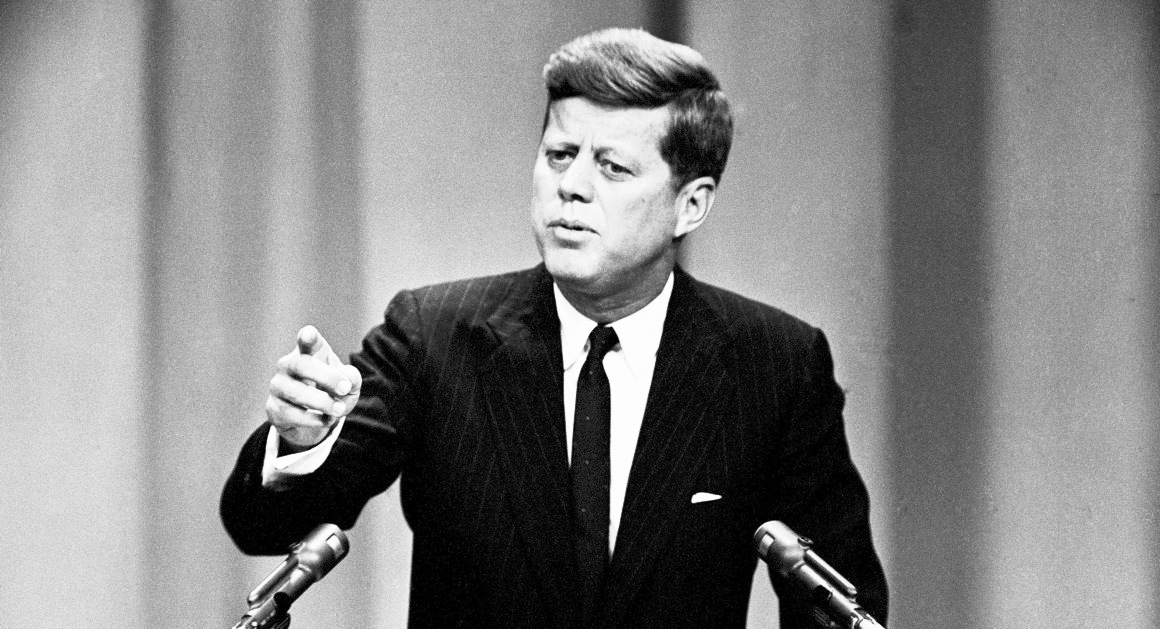
During the Nixon/Kennedy debate, held in the studios of the CBS owned station in Chicago, Nixon talked to the studio audience, as was the custom until then, while his opponent, Kennedy, went straight to the camera and mass audience. Nixon was recovering from the flu, yet most who listened on radio thought the debate was a draw or slightly favored Nixon, but the 70 million who watched via television thought it was Kennedy's night by a wide margin. Kennedy realized that TV was his ally, and started the televised press conference, and his successor, Johnson moved major addresses, including the State of the Union, to prime time because of TVs reach.
The networks made their money in unexpected ways. As mentioned, it was not from news. It was entertainment, and surprisingly from local stations. Early on as already mentioned, the FCC would only allow a single owner or company to own five stations max. This led to the KYW/NBC scuffle mentioned earlier. The five-station cap is a far cry from today, where a single owner can own as many as desired provided those stations reach no more than 39% of all U.S. TV households. There are a couple loopholes where that percentage can be higher, with the largest group station owner reaching 63% of the audience across the country. There are numerous companies that have bulked up. The largest now owns 141 stations. The major over the air networks now all have more than five stations, with NBC, CBS, and Fox all owning almost 30 stations each, with only ABC still having under 10.
Local stations have historically been money makers. The local station groups of the networks, even when the networks only had five local stations, made more money than their network usually did. While the network news lost money, the local news over time made money. Local news was often much cheaper to produce than if they purchased other programming.
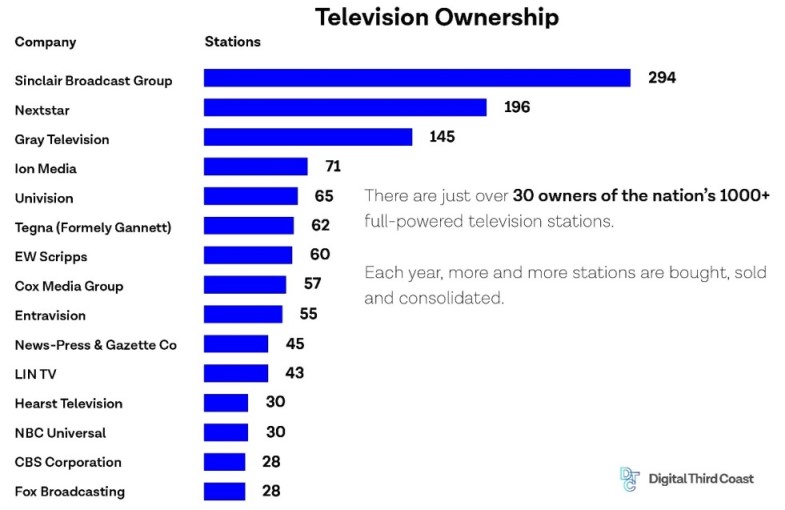
Entertainment
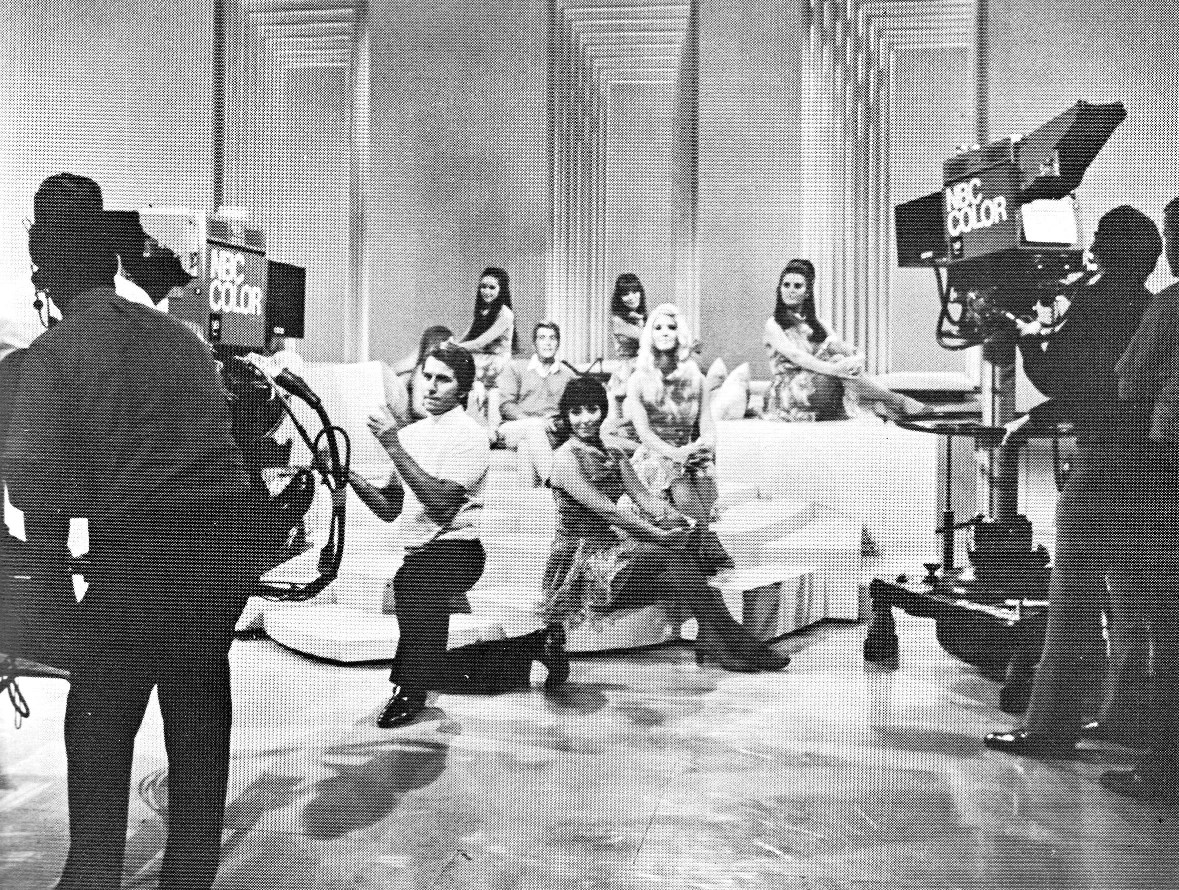
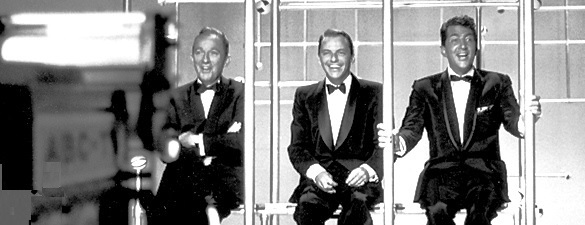
The networks turned to entertainment early on to pay the bills. A staple for a long time was the Variety Show. It came in three distinct forms. The first was with a host as talent, who blended their skills into a broadly appealing show. Dean Martin was a good example. He made a virtue out of his apparent lack of preparation for his show, using it as one of his shticks as he headlined the show but at the same time hosted other celebrity guests. This form never lasted long as the host/talent would tend to burn out after a few years and the show would decline and be taken off, although Jackie Gleason, Red Skelton, and Carol Burnett were exceptions.
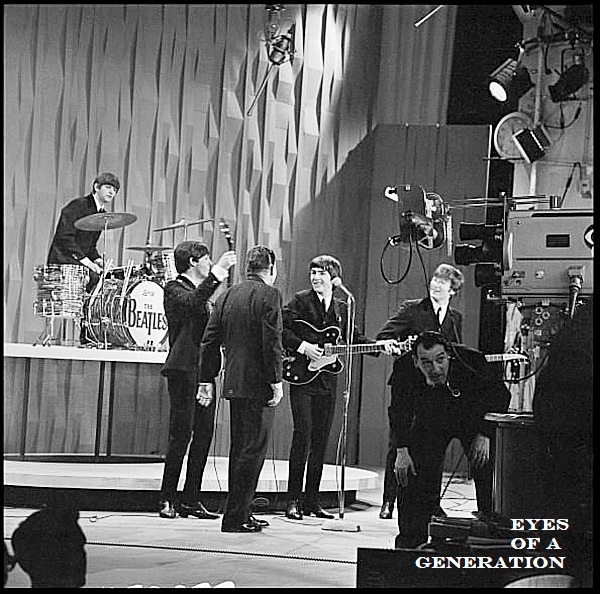
The second was a host as broker of talent offering a blend of comedy, song, dance, and spectacle. Ed Sullivan was a good example of that.
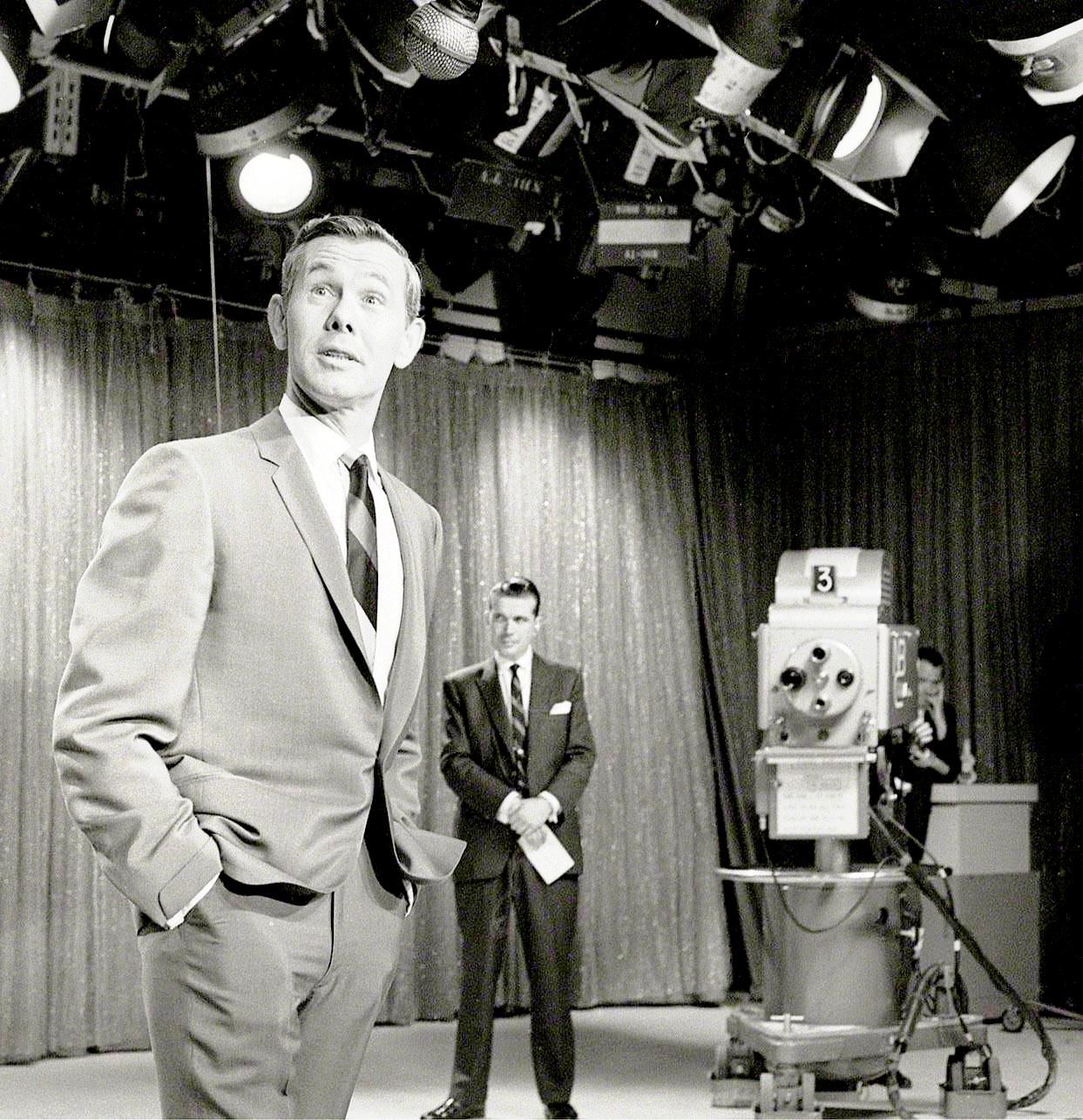
Finally, the host as friend, subordinating their talent, usually comedic, to the fact of their presence. Early on folks like Steve Allen, Johnny Carson, Merv Griffin, Mike Douglas, and Dinah Shore were notable examples. These hosts set out not to be glamorous or exciting, instead they intended to make the audience feel that the show was part of their neighborhood where interesting people come to talk about their activities and lives.
Dick Cavett, another comic who honed his skills as an interviewer, and became notable for his conversational style and in-depth discussions learned that the talk should not be too pretentious or serious. The audiences of these shows did not want to be bedazzled by the show, but just wanted a sense that they seemed included.
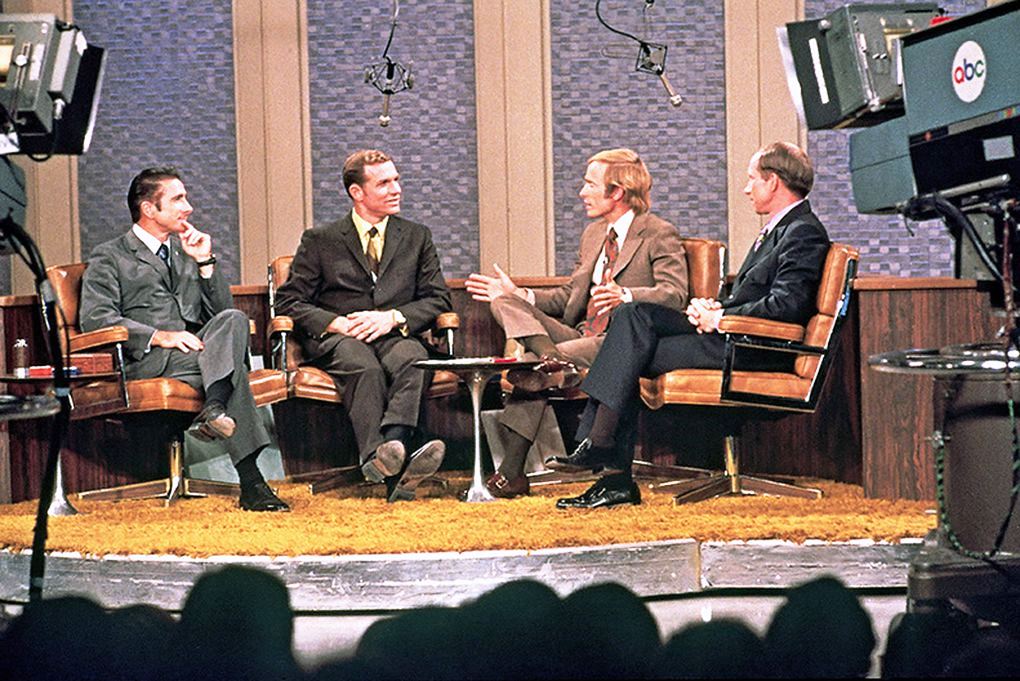
Most variety shows never did well in re-run syndication because many jokes and songs were topical to those shows, and as we see today what was funny and fair game then, is often shouted down today. Most variety shows worked off a stage with the camera occupying the best seat in the house and the audience was always aware it was watching a TV show as even in live to tape situations the needs of the home viewer experience was paramount to the audience in the studio. There was not much effort to hide the goings on "behind the curtain" to people in the studio. Today Saturday Night Live is a great example of that, as the show goes to break, and comes back out to a bumper shot in the middle of the break, showing sets being wheeled into place, talent finding their marks, and crew repositioning.
For many years the networks, NBC notably, could earn half of their profits from the morning news and the late-night shows, and surprisingly not from the prime time shows, that were often so expensive to produce. During the 70s the Tonight show was the most profitable show on television earning $60 million, $250 million today, a year. Carson carried significant sway over the network. From forcing the network to keep paying him ever more sums of money as he demanded to work less, in 1980 his show went from 90 minutes to an hour, to also having more instances of guest hosts. In his quest to minimize his workload early on he insisted that the show be treated as though it was live, even though it was not, it was live-to-tape as it was known. The show was recorded early evening. The tape did not stop rolling even during a break. If it was a three-minute break, there was three minutes of black recorded. There was no stopping down to reset. The show supposedly only stopped recording in the middle twice. Once because of a piece of the set falling over, and another when a guest tripped and fell. This practice insured that Carson spent 90 minutes doing his show and not three hours.
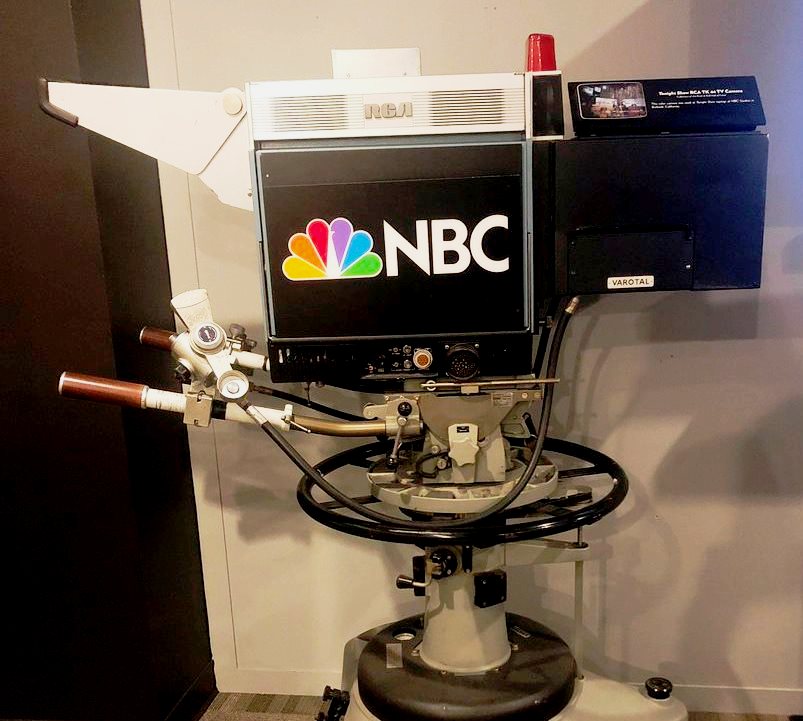
Another Carson edict was that every year his engineering representative would scour NBC facilities, New York, Los Angeles, and the locally owned NBC stations, looking for the best equipment the networked owned. As RCA had done with news, it was doing across the board with all operations, and curtailing the purchasing of new equipment. Even though RCA was by far the largest provider of professional television equipment at the time, and had much newer offerings, NBC often was still using equipment from a couple generations back, notably cameras. Into the 70s the network still had original color cameras from the mid-50s. Early on as we will see, NBC was flooded with color equipment to create color shows, which helped RCA sell color sets. That initial impetuous need receded into excessive belt tightening starting in the 60s.
Third generation RCA TK-44 color camera. For many years these were in short supply at the network
So, Carson could cull through the cameras, and other equipment the network owned and cherry-pick the best for his show. There were plenty of local engineers and technicians that looked after the equipment under their care, only to have that gear snatched from them.
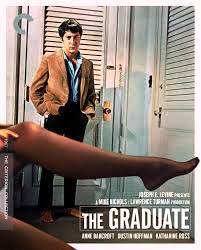
The movie studios reacted to TVs growing dominance by doing something TV at the time could not, which was to gravitate towards more sex. The key for competing against TV was in specialization and looking for the subcultures that TV was too big to reach. This led television to move to more risqué niches which it did not only during primetime but during the daytime also. Even though audiences were much smaller, daytime TV also became more profitable for the networks than prime time. Whereas, even back then, it would cost $150K for a single prime time 1/2-hour program, soaps could be produced at half that and run five days a week instead of once a week. The Soaps were the first television programs to touch on subjects like adultery, impotence, alcoholism, drug addiction, venereal disease, women's liberation, anti-war sentiments, and other once taboo topics.
It was an NBC executive that advanced TVs so called "Drug pusher argument." The networks did not air what they would like to watch, but what the viewers wanted to watch.
ABC 
We have just talked quite a bit about NBC. NBC and RCA had a large impact on our story. As we mentioned back in the radio section, ABC emerged originally from NBC's Blue Network. As is shown in the Grass Valley book, ABC played a large part in the Grass Valley Group's evolution. To a lesser extent RCA's gravitational effect on the television industry also forced the direction that the television equipment vendors took.
The movie studios were forced to divest of their theater holdings by Supreme court in 1948. ABC merged with United Paramount Theaters, which consisted of the theaters that Paramount Studios had spun off in 1953. The new head of ABC was a movie guy, and by instinct and desperation he turned to movie studios for help. While Walt Disney was not interested in ABC's overtures at first, he agreed after ABC invested in the park he was building in Anaheim, Disneyland. Disney had approached NBC, and CBS about producing a show that would help him finance the building of the park, but neither were interested. ABC was his third choice.
Disney and ABC
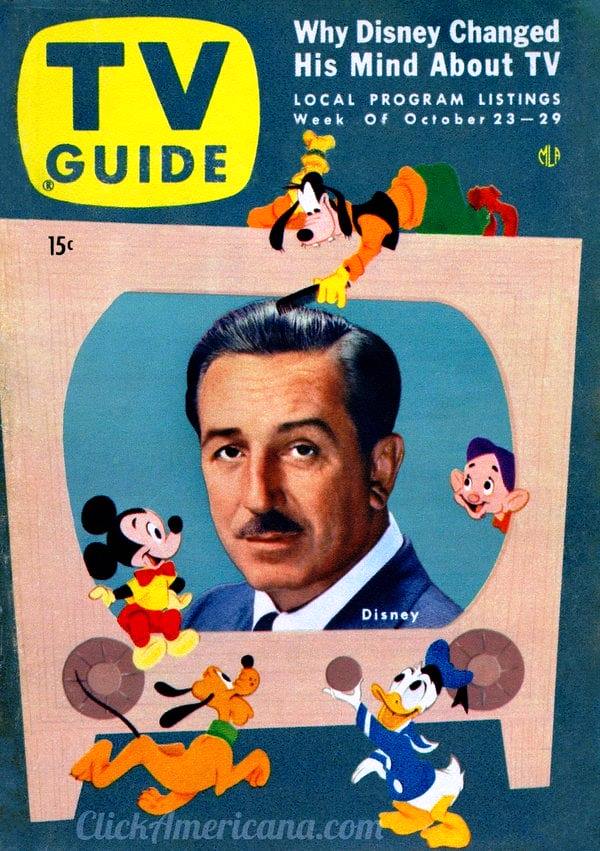
Little did anyone know that in 1985 a small group of stations, Cap Cities, would manage to take over the much larger ABC, along with ESPN which ABC had purchased in 1984. At the time ABC was four times larger than Cap Cities. In 1996 the tables were turned, and Disney took control of ABC/Cap Cities.
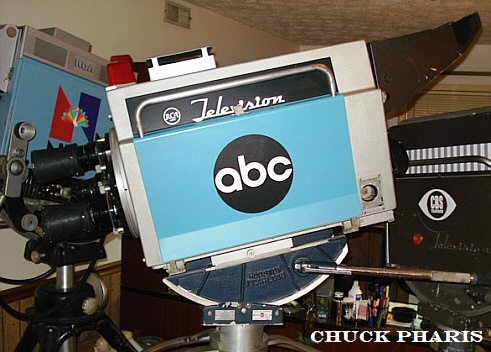
ABC Black & White Camera
The network was almost entirely B&W until the mid-60s
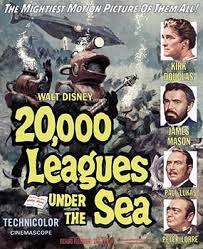
ABC and Disney's first venture together was tentative and short-lived. ABC agreed to let Disney promote movies and the coming park in a show they produced for the network, which was originally called Walt Disney's Disneyland, and later Walt Disney Presents. The show often presented anthology episodes, opened, and closed by Walt Disney. Many of those shows were based on Disneyland's main sections, Adventureland, Tomorrowland, Fantasyland, and Frontierland. Shows based on Dave Crockett or 20,000 Leagues Under the Sea were examples. Episodes of the show often covered the "making of" a forth coming Disney movie. Disney's show quickly became one of the most popular shows at the time.
Disney was the first major studio to give television a try. This convinced the movie studios that TV could be a profitable partner. Warner Bros was the next to produce for ABC. Soon the other movie studios followed as it allowed them to find work for idle stages, crew, equipment.
Several technological firsts were introduced on the Disney show. The show was the first to broadcast in stereo, even before FM stereo commenced in earnest in the early 60s. In 1959 to promote Disney's Sleeping Beauty, which had six-channel sound the network cobbled together AM and FM stations to air a three-channel mix-down of the movie, a clip of which aired on the show. FM stations were enlisted to carry the left channel, AM stations the right, while ABC TV affiliates aired the center channel. Disney also promoted seeing the film in 70mm during the show, a format that was coming into wider use during the 50s.
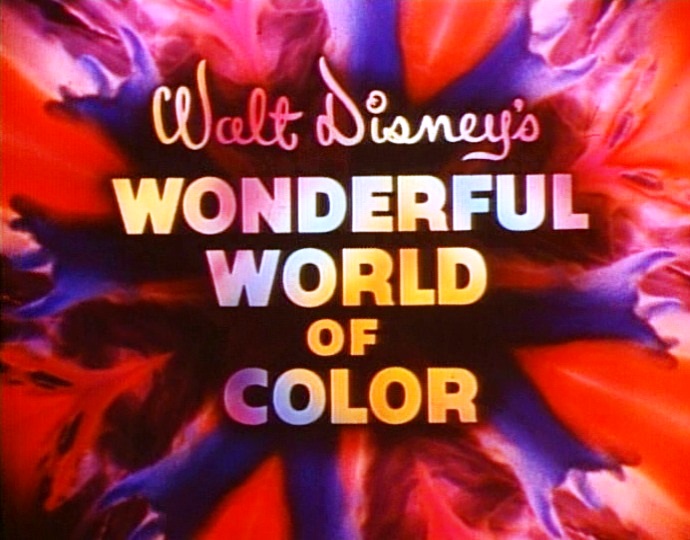
Another technological first for the show involved ABC losing its coveted show. As we just mentioned RCA was using NBC to sell color television sets. In 1961, to great fanfare, NBC started producing, and airing all its prime-time programming in color. As we will see in a bit, CBS and ABC were not. To take advantage of the NBC colorcasting capability Disney took the show to NBC in 1961 and apply called it Walt Disney's Wonderful World of Color.
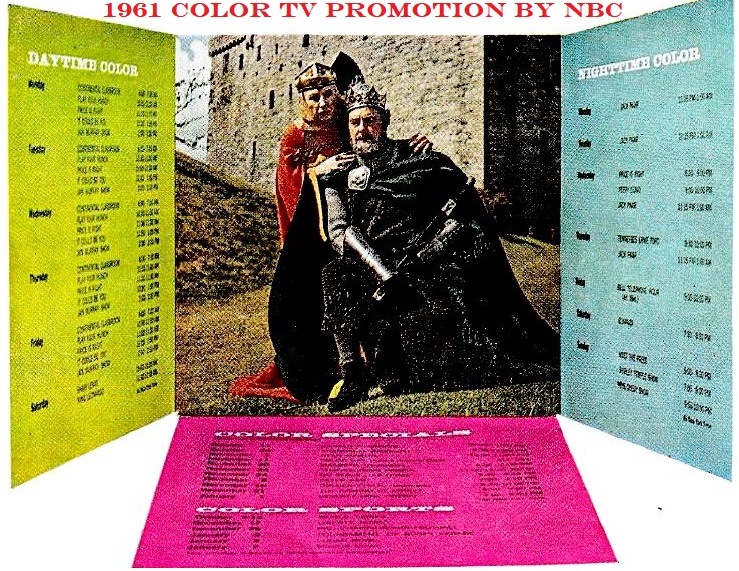
ABC was the third-place network during the early 60s, with occasional hit shows that resonated especially in the larger markets, where it captured many younger urban viewers. To help keep costs low it started its own in-house film studio, ABC Films. The network pioneered the made-for-tv movie and introduced the mini-series with "Roots."
Sports
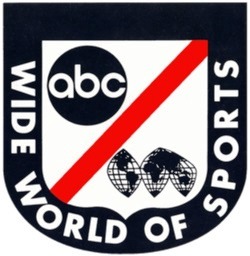

Roone Arledge
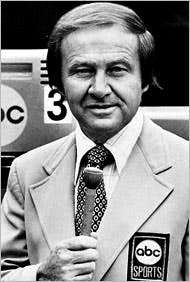
Jim McKay
Where ABC made its mark early on was sports. In 1961 ABC bought the Wide World of Sports concept from an outside production company who had hired Roone Arledge to produce the show. ABC ran the two hour show on Saturday afternoons. The show ran for the next 37 years on ABC. The show's opening sequence where Jim McKay's iconic voice announced the show's theme, "the thrill of victory and the agony of defeat," set the tone for the program. The show aired a smorgasbord of sports; bowling, tennis, track and field, horse and bike racing, skiing, including the ski jumpers wipe out during the "agony of defeat" portion of the open, to rattlesnake hunts. ABC pioneered a lot of technological firsts to produce the weekly show, including early use of the Telestar, a very early communications satellite to relay live feeds from Europe to the U.S.
But a lot of the show's success was that at the time the world was nowhere near as connected as today. This allowed the events aired, often offbeat, to be recorded earlier in the day and delayed until airtime without many people finding out the outcome in advance. The show brought a cavalcade of different sporting events, and most where not advertised in advance. Viewers often did not know what they would be watching that day. What that told Arledge, and ABC is that Americans generally liked to watch sports.
Roone Arledge was a driving force in making Wild World a success. He came to ABC through way of the deceased Dumont Network, and NBC. Early on at ABC he was able to cut a deal to air some college football for $50,000 a year. With that in their pocket ABC was able to leverage potential college football sponsors to also buy commercial time on Wide World. What greatly helped the show was McKay, who had come from CBS, had a natural curiosity about the sports he witnessed, and was willing to describe what was happening in stark detail.
During his time producing Wide World, Arledge had an epiphany on how to cover sports that reshaped sports coverage to this day. Up until then TV coverage acted as another observer from the stands looking down. That was necessarily the case because equipment was often not very portable. Arledge and company started looking for ways to get TV out of the stands and down on the field in the athlete's faces so to speak. The concept was not mere coverage, but weaving a story surrounding the game, and the participants themselves. It did not hurt that about this time technology was starting to make TV more portable. Arledge's genius is that he saw the possibilities before most others. He became president of ABC Sports in 1968. The technology, the TV industry, and the NFL was ready for what Arledge put together next, Monday Night Football.
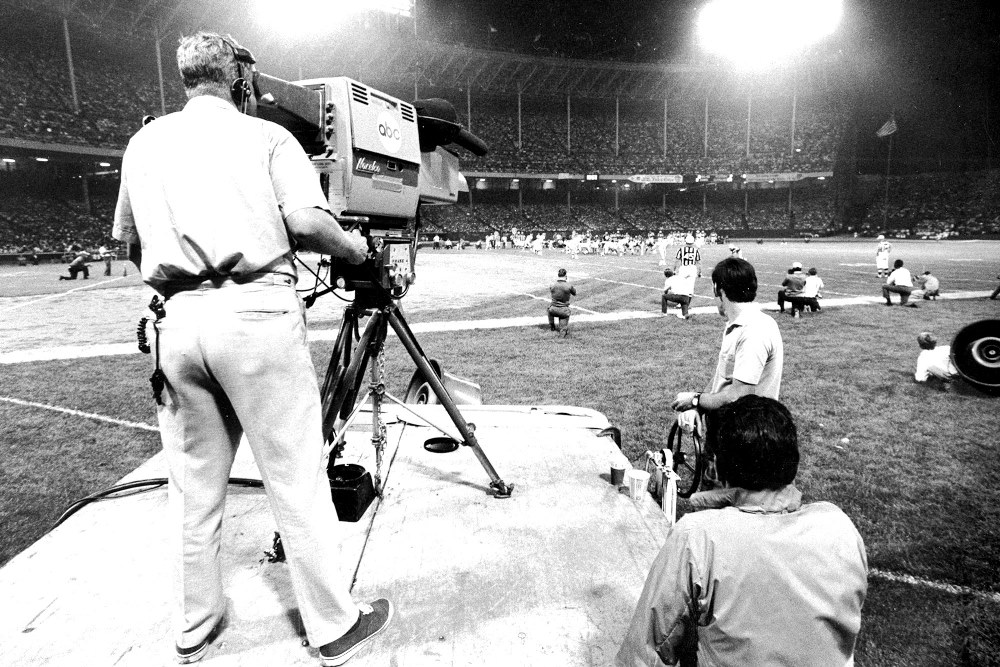
Very First Monday Night Game
Cleveland 1970
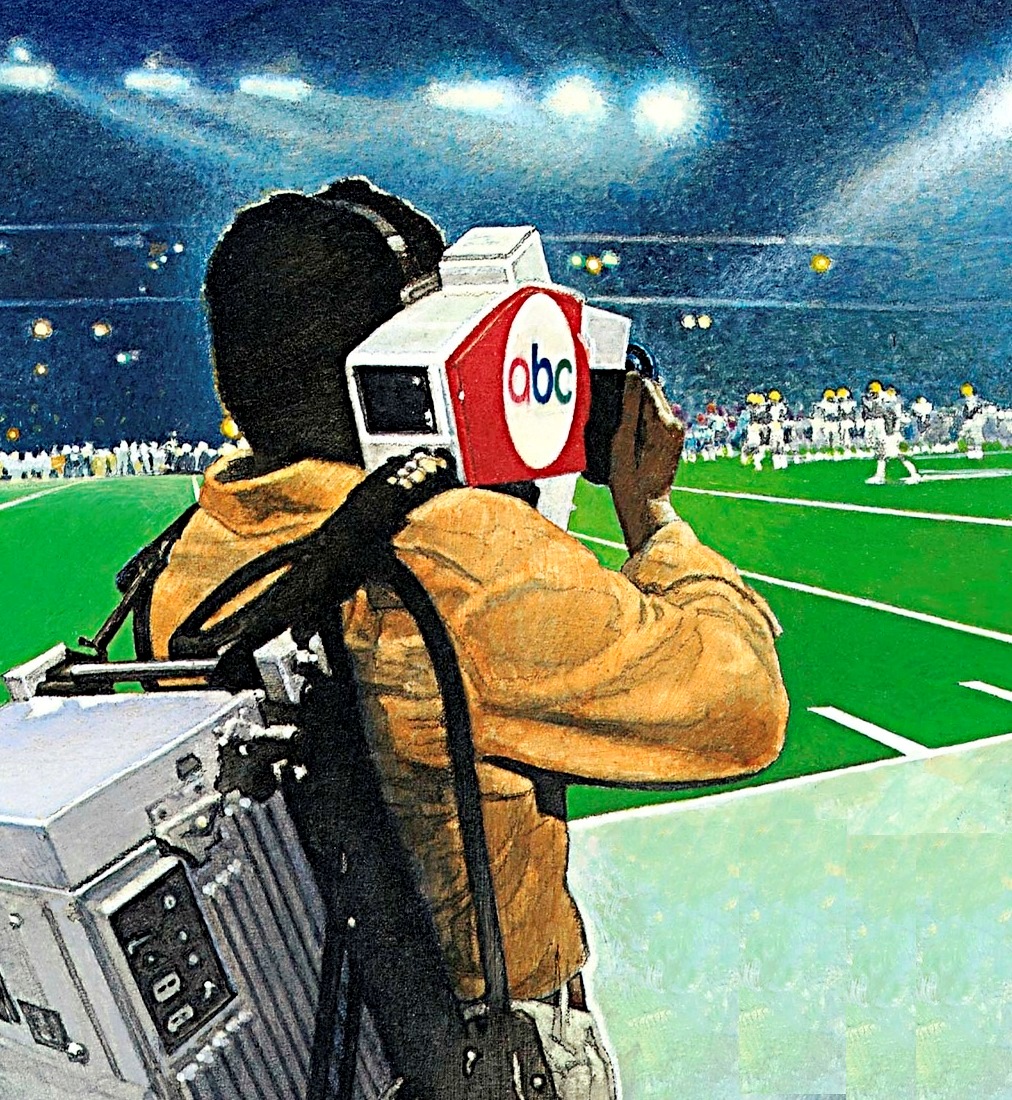
Sideline Portable Camera?
What passed as a handheld camera in 1970. Notice the large equipment pack on the person's back!
From its first telecast in 1970, Arledge did not treat it as a game, but as a spectacle. He treated every week's game as a playoff game. Besides extra everything, cameras, many portable, microphones to capture a full audio image, it was an early user of the instant replay, and computer graphics. Instead of two people in the announce booth, it had three. The third often just to stir things up. It was not sports so much as entertainment. Must see TV.
ABC had become the spunky network that was always experimenting and inventing on the fly. While NBC had the engineering might of RCA behind it, and CBS had its own engineering arm, the highly respected and innovative CBS Labs, ABC only had technicians, directors, and other production staff to figure out how to make Arledge's and other ABC producer's ideas a reality.
ABC provided Grass Valley Group
 it's big break into building television equipment, and Barnathan himself was instrumental in a number of Grass Valley Group's products, and ABC came to look upon the Group as an extension of ABC's engineering efforts. When the Group was sold to Tektronix in 1973, many ABC engineers, some stockholders in the Group, expressed concern about what would happen to the culture of the company.
it's big break into building television equipment, and Barnathan himself was instrumental in a number of Grass Valley Group's products, and ABC came to look upon the Group as an extension of ABC's engineering efforts. When the Group was sold to Tektronix in 1973, many ABC engineers, some stockholders in the Group, expressed concern about what would happen to the culture of the company.
Color
Almost as soon as black & white television became popular, RCA was getting color TV technology to a point where it might be ready to come out of the lab. RCA's approach to Color TV, all electronic, had up until now gotten a number of black eyes, as it was not stable enough to sell to consumers.
To convey color information you need to not only send the black, gray, and white picture information, but also the color saturation and hue. The solution was much like a painter with a palette of only the three primary colors; red, green, and blue. Like a painter mixing those three together any color (tint or hue) and any saturation (how much color) can be obtained.
There are two ways to send the three primary color's information. Either you collect that information in sequence, red, then green, and then blue and send them in turn, or you collect them all at the same time in parallel. To do the parallel approach requires essentially three cameras in a single box, each looking through a prism, and one looking at red light, and the other two looking at green and blue light.


Early three tube/camera color system
Three separate black & white cameras looking through a prism
Block diagram ->
Electronically the sequential approach was problematic for the technology of the time. But going back to the early black and white camera development a spinning disk, which we will examine more closely in a bit, offered a solution. The drawback, there would be a compatibility problem with existing black and white television receivers. That issue was eventually addressed in the sequential system, but not until it was too late, and momentum had gone in another direction.
The parallel approach was able to solve the compatibility issue. It did this by generating a black and white signal that existing sets in use could use, out of the three color channels. It was decided that the black and white signal would be comprised of 57% of the green channel, 30% of the red, and 11% of the blue. Why these percentages? Because they mimic what the human eye resolves.
The color information would be sent by blending in a subcarrier signal on top of the black and white signal, which black and white sets would ignore. While this was a simple and elegant solution, as we will see the state of the technology was not quite ready.

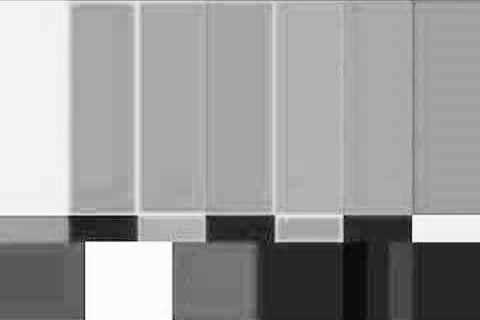
Color Bars - Black and White only
Standard Color Bar Signal as seen on a monitor and as a voltage on a waveform monitor

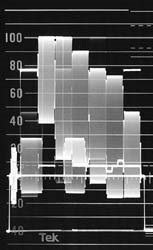
Color Bars - With color added
Standard Color Bar Signal as seen on a monitor and as a voltage on a waveform monitor
Color determined by subcarrier phase differences
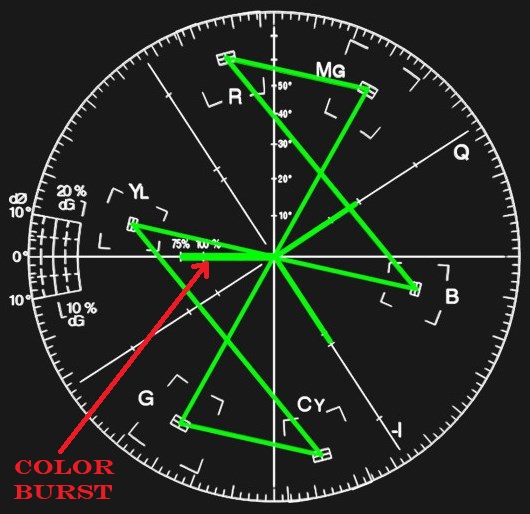
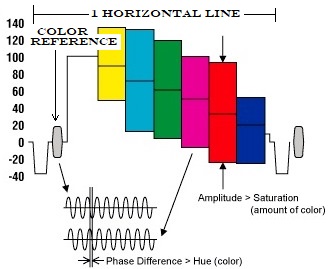
How the color reference signal (called "Color Burst") is used to determine the hue.
How the amplitude of the color subcarrier determines the color saturation.
On the right is a specialized piece of test equipment called a Vectorscope. It presents the various colors as vectors as referenced to the color reference or burst vector.
The developer of the mechanical system was CBS. As we mentioned CBS had already given RCA considerable sums of money for radio, and now television gear. CBS was not relishing the prospect of shelling out more money to convert their facilities to handle color. It was argued that CBS was hoping to be the ones to reap the royalties when color TV made it into the home. Others argued that CBS's real intent was to simply stop color television from happening, at least RCA's way.
Early on the system of parallel color casting, while easily doable today, had a long way to go well into the 50s.
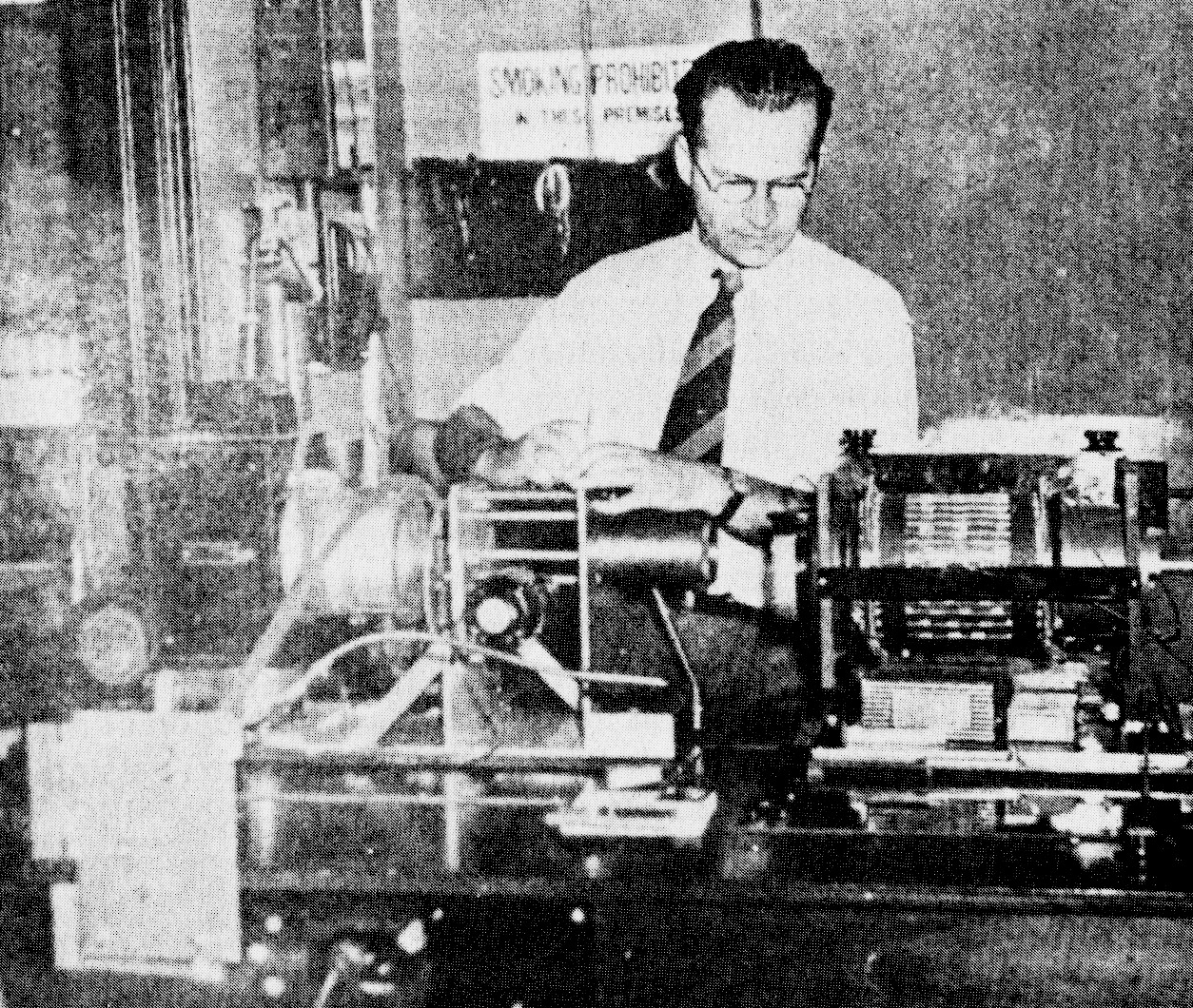
Early Experiments
Dr. Peter Goldmark was the head of color development at CBS
Here he is demonstrating an early CBS color display.
He was inspired after he and his wife saw Gone With The Wind
The desire to capture color images had been around since the very inception of television development. Like the mechanical approaches to black and white TV early on, early in color development a mechanical approached worked better for capturing color than the all-electronic approaches. As we will see shortly the first color television system adopted by the FCC was mechanically based.
Zworykin did apply for a color TV patent in 1925. He proposed a pickup tube that would be composed of a grid of squares that were sensitive to red, blue, or green light. The corresponding display screen would have corresponding squares which would reproduce the color scene. While it looked good on paper, RCA never-the-less started experimenting with mechanical processes of sending color images in 1932.
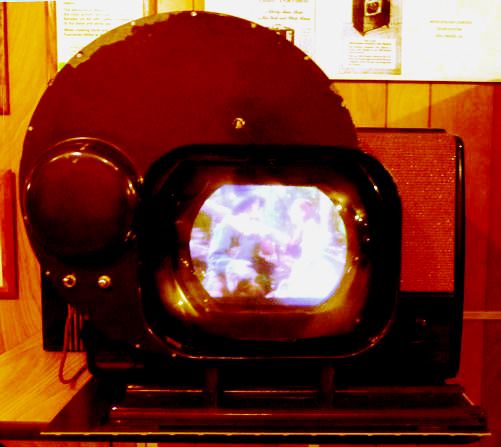
Early spinning disk color TV receiver
Early on NBC experimented with a hybrid electronic/mechanical system as was the case with black and white. By the beginning of 1941 color television pictures with motion were aired by NBC in its first telecast. NBC was transmitting color with 441 lines per frame and 60 frames per second, requiring 26,460 scanning lines per second, and 120 vertical fields per second. This was because like CBS, as we will see shortly, NBC was looking at a sequential systems where in turn, a field of red video, and then green video, and then blue were sent in sequence. The 120 fields split up among the three primary colors meant the overall frame rate was only 40, not 120. RCA soon realized that this would take up too much bandwidth. So they settled on the parallel approach.
As mentioned a prism is installed behind the lens that separates the light into red, green, and blue components that goes to each of the three internal cameras, again, each basically a black and white (B&W) camera. So, to produce a color TV picture, you need to first get a working black and white camera. As we saw that took some doing and well over ten years. When TV was just getting let loose from the lab, World War II occurred, and it was reeled back into the lab, for the most part, to be developed for the war effort.
Towards the end of 1946 RCA engineers had a parallel color system working in the lab. But it was unstable. None-the-less Sarnoff wanted an immediate press demonstration, even though engineers were leery. On October 30th of that year a demo was performed. No apologies were offered for the shortcomings, RCA said they were curable, given time and perseverance. The big thing was that the system was all electronic and compatible with present B&W systems. But the press was not impressed.
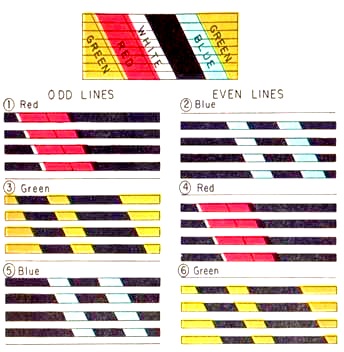
CBS Resistance
CBS Color Capture Approach
It took three complete frames, or six fields to capture two frames of color information
As you can see frame one, field one captured red information, field two blue
Frame two, field one, green; field two started again with red.
So two complete color frames took three black and white frames.
At the dawn of the decade of the 40s, CBS had already started research into color. But their approach was radically different than NBC's. The advantage to their system was that it still only needed a single pickup tube, unlike RCA's three. The drawback was that both the camera and any receivers needed to have spinning color filter wheels in sync with each other. These disks where divided up into three sections, each filtering out all but red, blue, and then green light in turn. The timing of the spinning wheel was such that for one field the camera pickup tube scanned a blue light image, then a red image, and finally a green. That is sequential fields of red, green, and then blue fields. The three-color filter disk rotated at 1440 rpm inside both the camera and the receiver in sync.
It must be understood that the captured fields were still only black and white, just like the three parallel channels in the RCA approach. Each field only represented the amount of video intensity of the light in those three colors. At the receiving end the receiver also had a spinning disc in sync with the camera. What the viewer saw was fields and lines that represented the color capture process just described. These fields happened quick enough that the human eye blended the three colors together and saw combinations of the various hues that represented the scene.
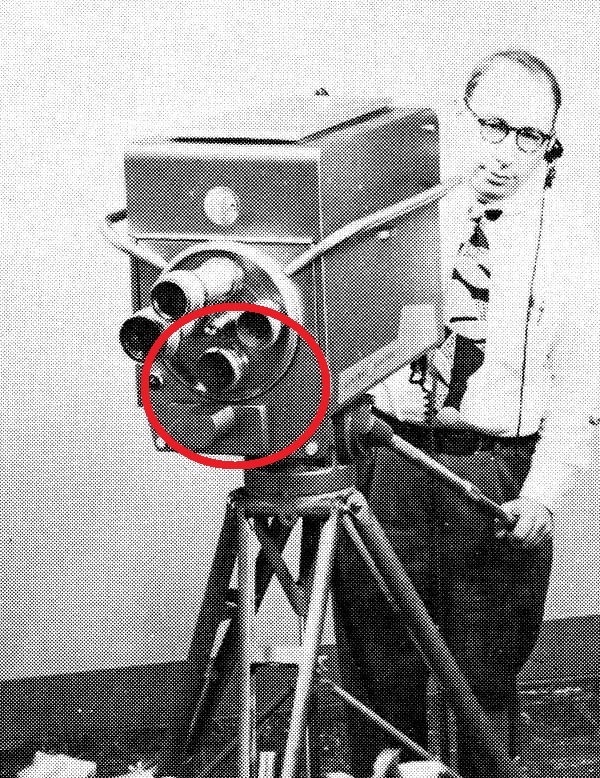
CBS Modified black & white camera
The circled area is where a spinning disk was located between the lens and the single pickup imaging tube
CBS simply modified black and white cameras with different scanning and field rates and added a spinning filter disk at the front of the camera. With the RCA approach the color camera was essentially three black and white cameras in a single case. The big CBS pitfall was you had a mechanical spinning disk system impressed over an electronic system.
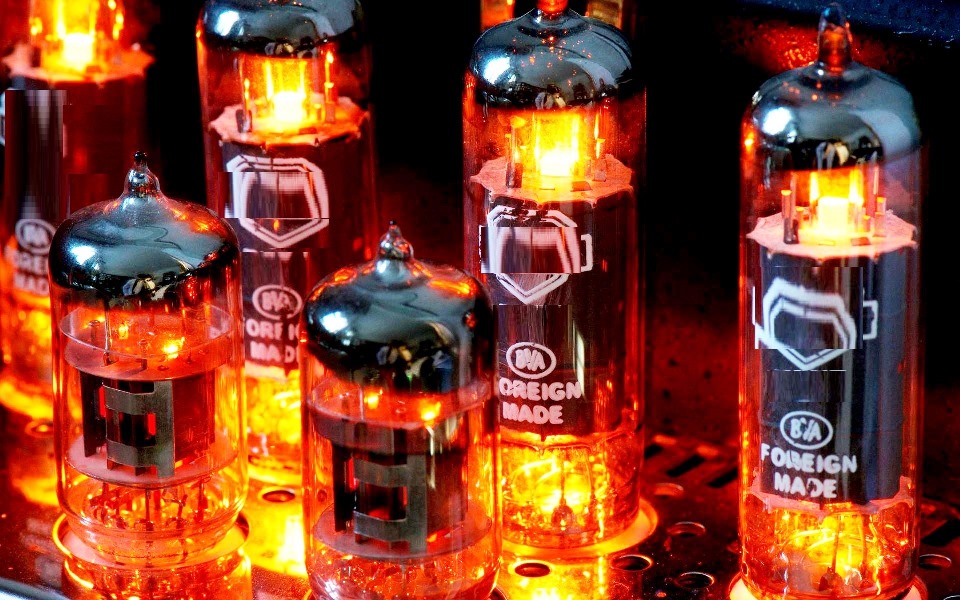
Now at the time, the state of the technology was such that it could be argued that a motor spinning a disk was no less reliable than the rest of the electronics. At that time everything that had active circuitry relied on vacuum tubes. From the time a vacuum tube was first powered up it was on borrowed time. Just like incandescent light bulbs, they are eventually consumed by heat and material migration. Whereas an old fashioned light bulb only had a single filament, a vacuum tube, besides having a filament to heat a plate so that it will emit electrons, it has a number of other elements that become increasingly brittle as they age due to heat. A tube slowly degrades over time. That was a big reason why old sets had so many adjustments that had to be made by the viewer. Horizontal and vertical hold, brightness, contrast, etc.
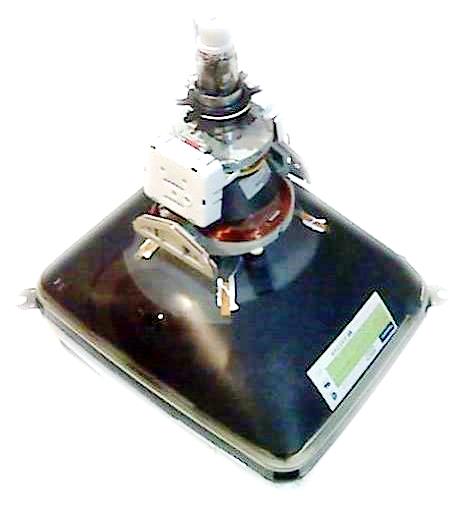
It's also why the TV repair business was so large through the 70s. While vacuum tubes where gone from TV receivers by the mid-60s, sets still had CRTs, which are big, even more complicated tubes, and they required high voltage to work. It often didn't take much for high voltage to literally turn on itself and cause various failures. Today, most sets are essentially all solid state, with failure rates that are usually longer than the life of the sets usefulness.
So the argument can be made that CBS's motive was to either reap the benefits of the next technological leap in the industry, color, or to confuse the issue to slow up any RCA inroads. Most likely they were hedging their bets and working both sides of the dichotomy.
In 1940 the first demonstration of the Field Sequential CBS Color System by Peter Goldmark was broadcast over W2XAB test station using a 343 line, 120 field, RGB sequence, using a 6 MHz wide channel. By the end of 1940 the first live studio pickup broadcast of CBS Color was done. These were done using modified RCA black and white cameras.
By September 1941 CBS Color used 375 lines per frame at 60 frames per second which required a horizontal scanning rate of 22,500 lines per second, and a vertical scanning rate of 120 field scans per second. This was going to require a lot more bandwidth per channel than the current black and white system. CBS recommended a wide-band color system to the industry. By mid-1944 CBS receives FCC permission to construct and operate an UHF color television transmitter. A little over a year later they demonstrate experimental UHF color broadcast using laboratory test equipment and a 10 MHz channel.
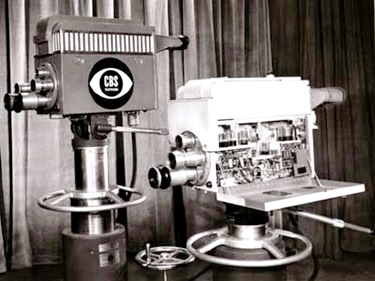
RCA black & white TK-10 Camera on the left
On the right is the TK-10 modified to an CBS Color camera
They had a working and fairly stable color system by 1945. The camera, like the receiver, was a modified RCA black & white camera. So, in 1946 CBS petitioned the FCC for approval of their color standards, knowing at the time that what they were proposing was ahead of what RCA had at the time. In hearings that went from the end of 46 until February of 47 testimony and tests convinced the FCC that no available system was good enough to approve at that time. During those hearings Frank Stanton, president of CBS, admitted under questioning that compatibility was "desirable," but CBS simply did not think the all-electronic system could be perfected. Thinking that the color dragon had been slayed CBS soon curtailed their color research.
While CBS scaled back development some tinkering continued. The field rate was increased from 60 to 144 fields per second to overcome the flicker from the separate color images, resulting in 24 complete color frames per second (each of the three colors was scanned twice, double interlacing being standard for all electronic television at the time (2 scans × 3 colors × 24 frames per second = 144 fields per second), instead of the standard 30 frames/60 fields per second of current black & white TV. If the 144-field color signal were transmitted with the same detail as a regular 60-field monochrome signal, it would take 2.4 times the bandwidth of the black and white signal and would therefore not fit within a standard 6-MHz bandwidth TV channel. Therefore, the image's vertical resolution was reduced from 525 lines to 405. The vertical resolution was 77% of monochrome or black and white sets, and the horizontal resolution was 54% of monochrome. Yes, it would represent a color picture, but with less resolution, and totally incompatible with the almost 40,000 black and white sets already in use.
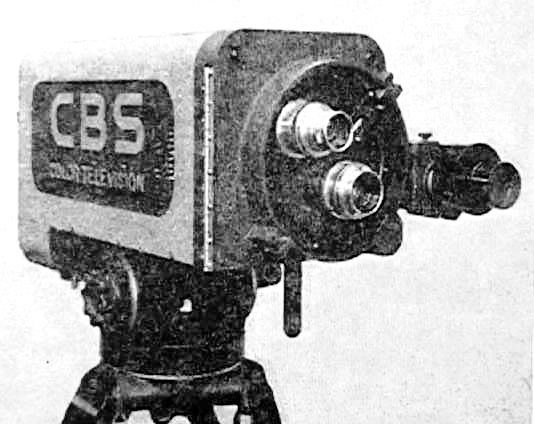
CBS camera designed from the ground up for their color system.
In September 1947 CBS petitioned the FCC to adopt its UHF Color Television System (525 line, 144 field, 16 MHz channel). Starting in December of that year and to February of the next the FCC held hearings on color television standards. The next month FCC denied the CBS system petition for UHF utilization as "premature." The FCC stated that the "CBS System was not adequately field tested and other narrowband systems were not explored," and it also felt that both the CBS and RCA Color Systems required too much spectrum space.
By August, 1948 CBS was still clinging to their 12 MHz wide color system. By manipulating the information in the channel (by using single sideband techniques) they were able to achieve a faster 144 field rate. But CBS was now also investigating systems that could fit within a standard black and white 6 MHz channel. At this time RCA announced its compatible with black and white Dot-Sequential Color (parallel) System. Soon the FCC wanted more data.
At RCA's insistence a second set of hearings ensued in September 1949. Again, the FCC found that the RCA system was fraught with technical problems, including inaccurate color reproduction. It didn't help that RCA made a disastrous demonstration to the FCC in October. The hearings continued until May of the next year. It was one of the longest hearings in FCC history, and it turned up the emotional heat to match. During this time, the Chairman of the Commission Wayne Coy, dropped all semblance of juridical neutrality to become an ardent advocate of the CBS side. Even though as compared to the 1947 hearings CBS could show little progress, while RCA could show a lot of progress, the disc-scanning system still seemed superior.
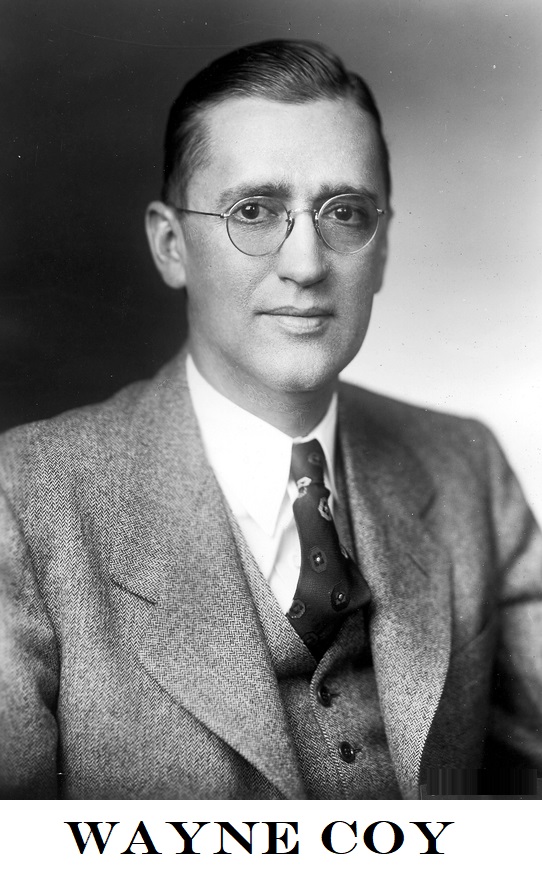
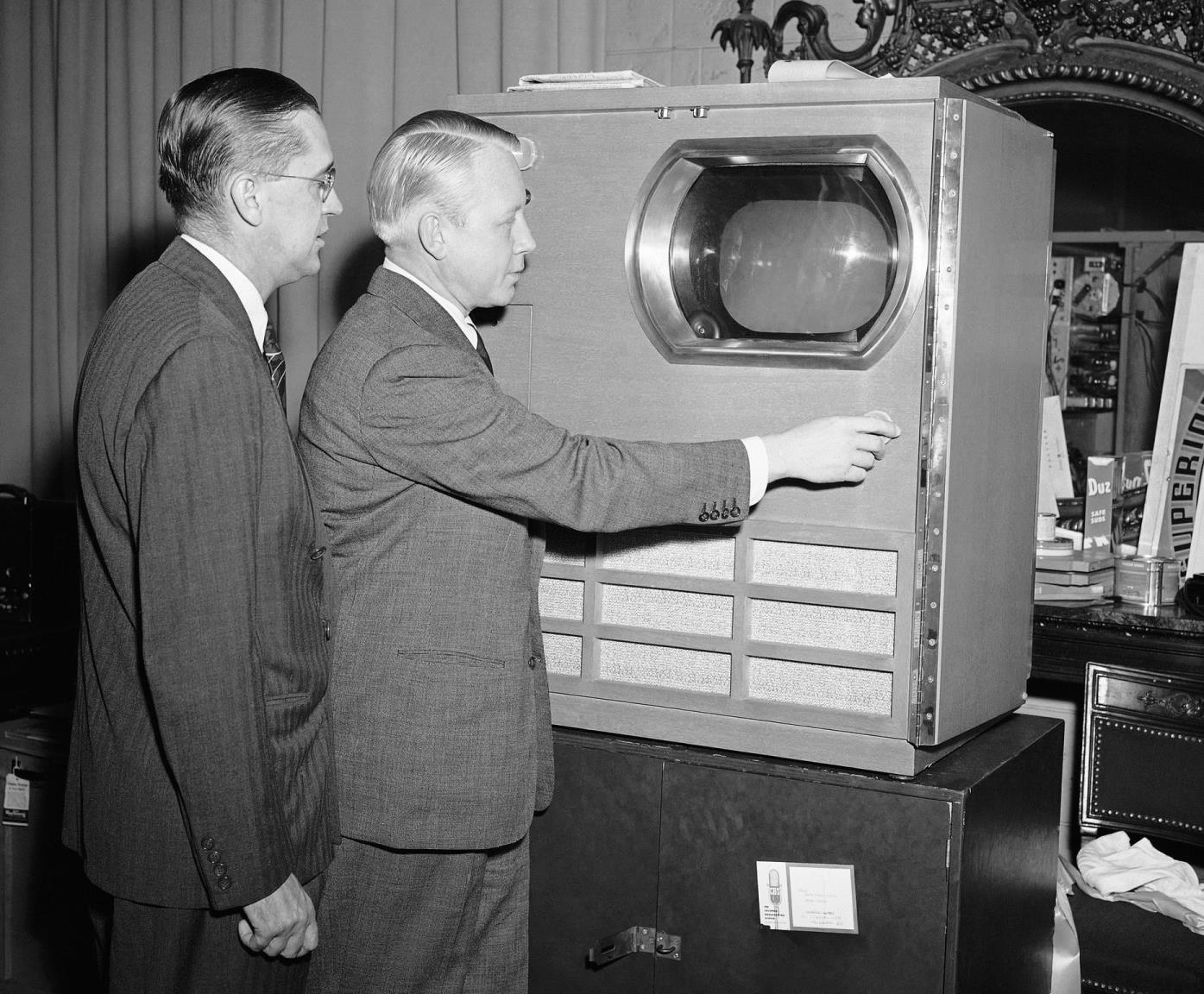
Then FCC Chairman Wayne Coy is shown a CBS Color Receiver
Here is a case where a few years before, RCA was pushing TV while fighting off detractors, now RCA is the detractor claiming, and history appears to vindicate this, that the color system that is ready, CBS's, is not good enough.
Compatibility became the key concept in the color argument. Early on the public had a hard time understanding that compatibility did not mean that B&W sets would somehow display color, it simply meant that a B&W set would display a similar looking B&W signal, ignoring the color information. The hard part is how do you do that. We've already looked at RCA's approach which was to have three internal black and white cameras combined in two separate encoders to create a composite black and white, and the color signal. Those two signal are summed together and at the receiving end a black and white TV receiver would simply threat the color information as an additional part of the black and white signal.
Not perfect, but the RCA system was backward compatible with the millions of sets that would be out there soon. But CBS insisted that the RCA approach was far from even good enough. The electronics of the day were being pushed to their limits. Any signal instability, and with RCA's approach, signal variations of less than a nanosecond would produce incorrect colors on the display. CBS's system did not have that problem, just the low hum of a spinning disc, and the potential for some mechanical problems. The all-electronic RCA system had the three primary colors simultaneous displayed in each picture and not sequentially across three pictures as in the disk system.
Advocates of the RCA system claimed that with whirling-disk color display size would remain limited to 12 ½ inches, while the electronic system could quickly move up to 21 inch screens, the standard size of B&W sets at the time. Over time through the CBS system was able to be displayed on larger CRTs.
While the need for compatibility was obvious to all, including CBS, they believed that an all-electronic system was far off in the distant future, and they wanted the prestige and advantage of being the 1st with a color system. Even as late as 1950, mechanical color transmission was further advanced than the all-electronic system. It was felt by RCA though that the mechanical system was about as perfected as possible while an all-electronic system had essentially no boundary as to the limits of improvements that could be made. The fact that CBS made little effort to market the system raised doubts about their faith in it.
That said, at the end of 1949 the first Successful 25 frame/second color motion picture kinescope recording of the CBS System was accomplished. Color recordings were also made of the RCA system.
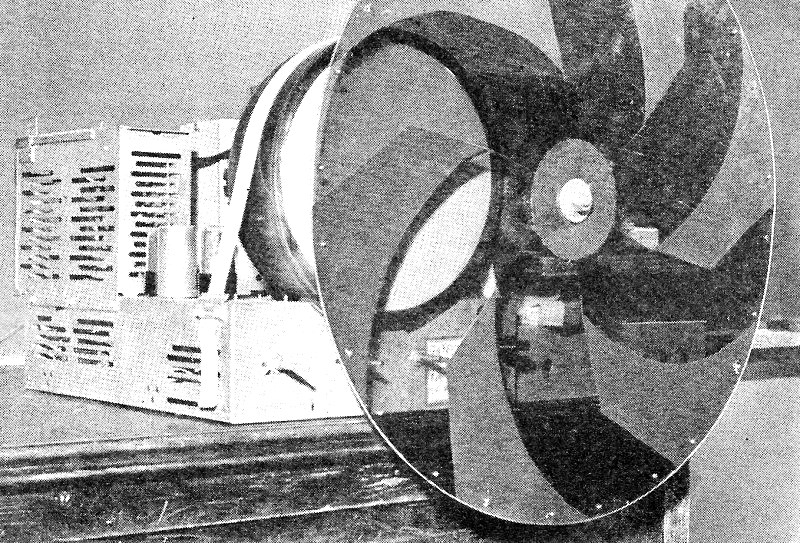
Black and White set with color wheel
During its campaign for FCC approval, CBS gave the first demonstrations of color television to the general public, showing an hour of color programs daily Mondays through Saturdays, beginning January 12, 1950, and running for the remainder of the month, over their Washington, D.C. station, where the programs could be viewed on eight 16-inch color receivers in a public building. Due to high public demand, the broadcasts were resumed in February, with several evening programs added. CBS initiated a limited schedule of color broadcasts from its New York station WCBS-TV Mondays to Saturdays beginning November 14, 1950, making ten color receivers available for the viewing public. All were broadcast using the single sequential color camera that CBS owned. The New York broadcasts were extended by coaxial cable to Philadelphia's WCAU-TV beginning December 13, and to Chicago on January 10, 1951, making them the first network color broadcasts.
While the CBS color broadcasting schedule gradually expanded to twelve hours per week (but never into prime time), the color network expanded to eleven affiliates as far west as Chicago. But its commercial success was doomed by the lack of color receivers necessary to watch the programs, and the refusal of television manufacturers to create adapter mechanisms for their existing black-and-white sets. Add to that the unwillingness of advertisers to sponsor broadcasts seen by almost no one. In March of 1953, the New York Times asked, "Who is going to spend money to put on a color show if it means the loss of virtually all the existing audience?"
At the conclusion of the second FCC hearings in May 1950 there were 10,000 pages of transcripts and 265 exhibits. At the conclusion of the hearings the color television proponents pressure the FCC to immediately adopt a color standard. That July Senate Advisory Committee on Color Television submitted its final report to the Senate Interstate and Foreign Commerce Committee. The report was favorable to RCA and widely quoted by RCA in court litigation to follow.
At the beginning of September 1950, the FCC issued an interim or tentative report which unmistakably foreshadowed a decision favoring the CBS system. The FCC stated "At all of the demonstrations on record, RCA had difficulty producing a color picture with adequate color fidelity. The inability to reproduce skin tones is a particularly serious handicap." The FCC pointed to misregistration, dot textures, poor contrast problems, bulky receivers, and high equipment complexity-costs. The FCC did acknowledge the compatibility problem of the CBS System and the desirability of adopting a satisfactory compatible system.
In September 1950 issue of Broadcasting magazine, their take: "The color battle is still on. CBS is way out front on points. But there's a round to go. Two of the seven FCC judges want to stop the fight with an immediate CBS decision. One wanted to postpone it. The other four decreed it should continue, with a decision upcoming unless there was a surprise knockout."
Broadcasting's take turned out to be correct as soon FCC approved the CBS system. In response to the FCC's sharp criticism of the quality of RCA's color, Sarnoff issued a statement: "We regard this decision as scientifically unsound and against the public interest. The hundreds of millions of dollars the present set owners would have to pay to obtain a degraded picture with an incompatible system reduces today's order to an absurdity. Regardless of what anyone else may feel called upon to do, RCA will continue its effort to advance the bedrock principles on which the sound future of color television can be built and will be built."
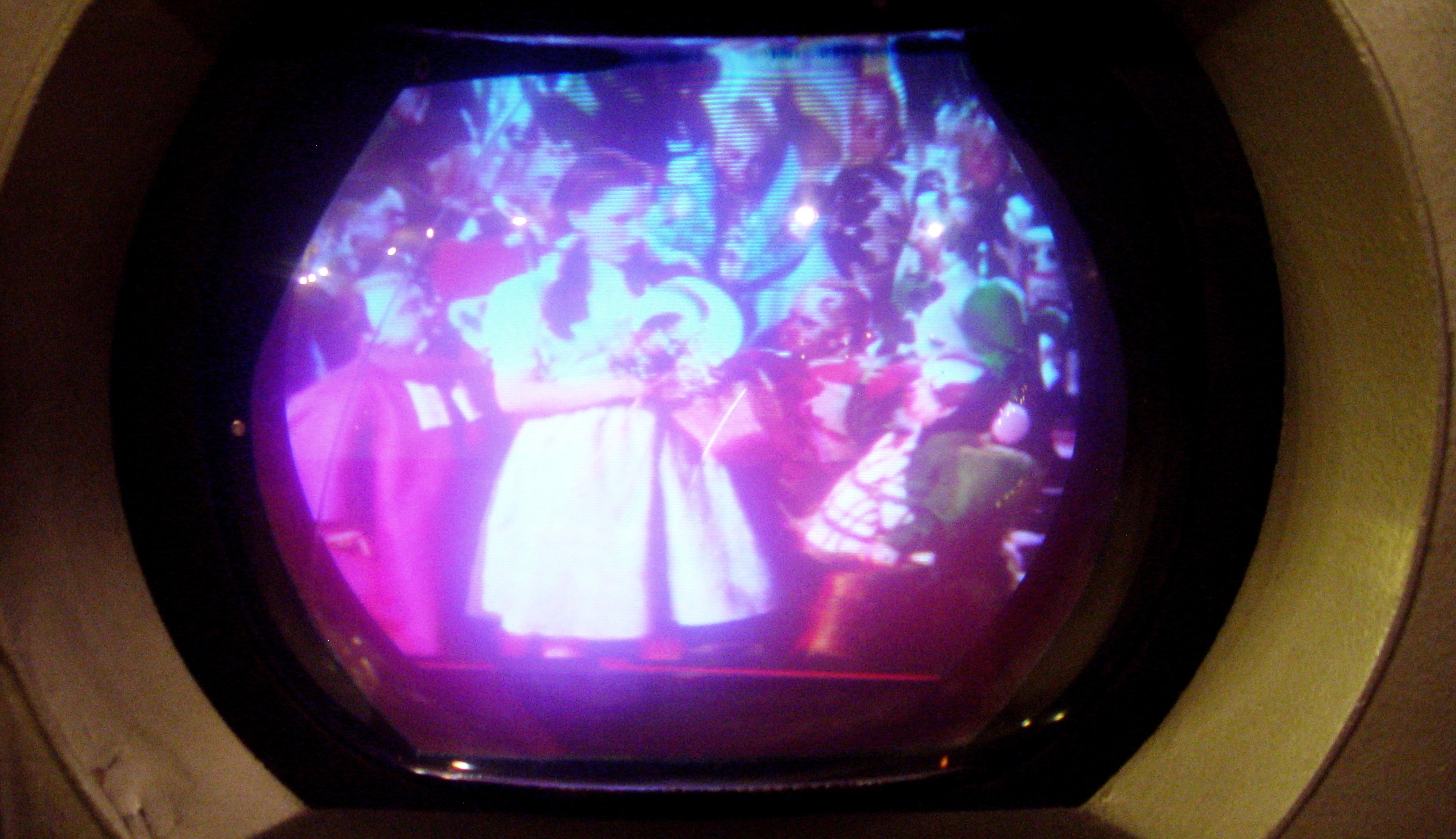
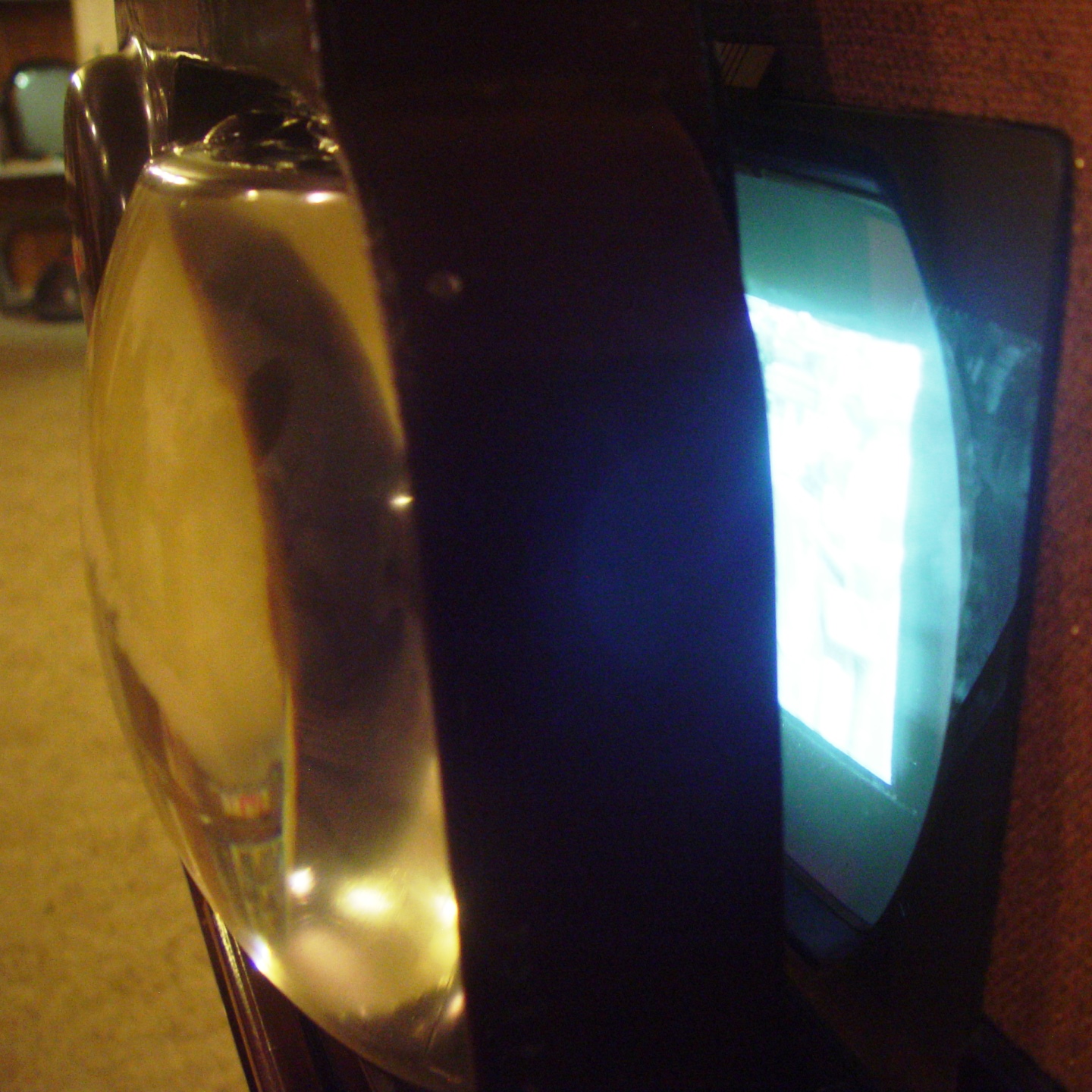
CBS Color Display
On the right is a shot of the black and white CRT behind the filter wheel.
CBS Color Demo
What happens when a color wheel has servo problems
The possibility of an incompatible color broadcast system was so compelling that the Radio Manufacturers of America, formed a second NTSC committee. NTSC stands for the National Television Systems Committee. The first committee was formed in 1941 to enact standards for B&W TV. The first committee never considered color TV. This second committee selected a five-man ad hoc panel of engineers, with a Philco representative as chairman. The other members were from RCA, GE, Sylvania Electronics, and Hazeltine Electronics Corp. The findings of this panel in June of 1951 validated the basic standards embodied in the RCA system and said that compatibility was indispensable. The FCC heavily opposed the NTSC's efforts. One of the FCC Commissioners, R. F. Jones, went so far as to assert that the engineers testifying in favor of a compatible system were "in a conspiracy against the public interest".
Unlike the FCC approach where a standard was simply selected from the existing candidates, the NTSC would produce a board that was considerably more pro-active in development. Before the NTSC's could issue its findings the FCC formally approved the CBS system as the U.S. color broadcasting standard on October 11, 1950. An interesting observation about the committee's endorsement of the RCA's system that had to be so stable to work, and the NTSC acronym, is that many in the business claimed NTSC really stood for "Never Twice the Same Color."
At the time of their discussion the FCC was proposing a requirement that manufactures of black and white receivers with "bracket standards" (receiving both CBS color and NTSC B&W signals) as a means of delaying the final decision and allowing further studies. What the FCC was proposing was a way of waiting for a compatible system. The FCC reasoned that if manufacturers would build black and white receivers that could handle both monochrome and CBS scanning standards, time could be allowed for the development of an acceptable compatible system. The FCC said that, with a 5-6 million annual receiver sales rate, within one year 40 percent of the receivers in use could receive the CBS broadcasts. If the set makers could not provide this "bracket standard" reception capability, then the FCC would be forced to adopt the CBS system immediately to avert the continually growing compatibility problem.
Of course, the manufacturing industry refused. They were faced with adding additional parts into their receivers, increasing their cost to the consumer, and on top of that, with what they thought was an impossible timetable. The Manufacturers said they could not meet FCC's deadline for the manufacture of backward compatible CBS color sets.
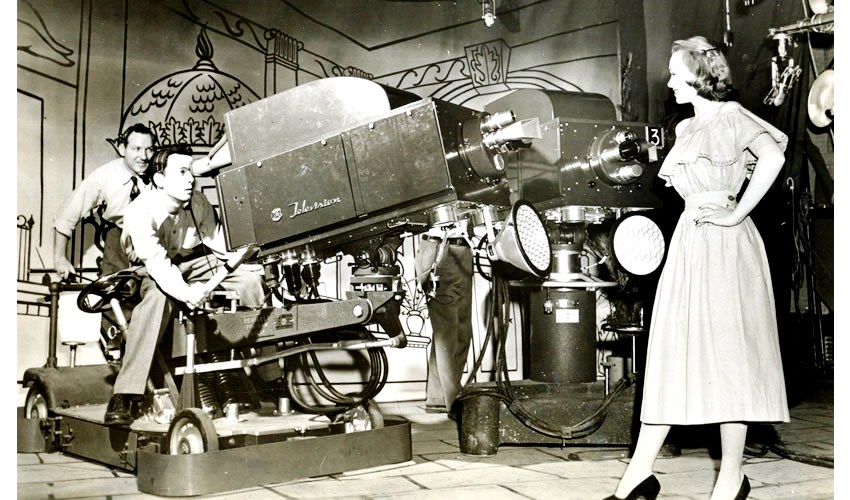
Early RCA working color camera prototypes
Officially known as the TK-40, it had the nickname "Coffin Cam" as it was nearly the size of a coffin.
Shortly RCA petitioned the FCC to delay its final determinations and to permit additional demonstrations until June 3, 1951. This petition was denied on Oct. 11, 1950, the same day the FCC issued its "Second Report on Color Television Issues" in which it approves the CBS Field Sequential Color Television System (authorized for broadcast after Nov. 20, 1950).
So on the 17th of October RCA brought a suit to halt color television in Federal District Court in Chicago asking it to "enjoin, set aside, annul, and suspend" the FCC's order. RCA said that the judgment was based on an early RCA model that had been outmoded before the judgment was made. On December 22 of that year by a vote of 2 to 1, the Chicago District Court upheld the FCC order of Oct. 11, 1950. The Court decided to delay the rule going into effect until April 1, 1951, or until terminated by the Supreme Court.
An appeal was carried to the Supreme Court, which in May of 1951 sustained the lower court. The Supreme Court ruled against RCA's appeal to rescind the decision to use the CBS color system. They ruled only on its legality and not on its technical substance. Sarnoff wondered publicly what recourse anyone has to fight unwise decisions of administrative bodies.
These unsuccessful lawsuits by RCA had an effect on CBS, as they slowed deployment, which delayed the first CBS commercial full network broadcast in color until June 25, 1951, the day the FCC announced that all regular television stations are permitted to broadcast color programs in accordance with the standards adopted by the Commission. Namely the CBS system.
That same day wasting no time the first commercial CBS Color Program with Arthur Godfrey, Ed Sullivan, and George Balanchine, a musical variety special titled simply "Premiere." It aired over a network of five East Coast CBS affiliates, starting at 4:35 P.M. from New York Studio 57. Ten and a half million monochrome sets that then existed in U.S. are blind to this colorcast. CBS then begins regular scheduled series of daytime and early evening (non prime time) colorcasts including the "Mike and Buff Show" (with Mike Wallace) and "The Mel Torme Show."
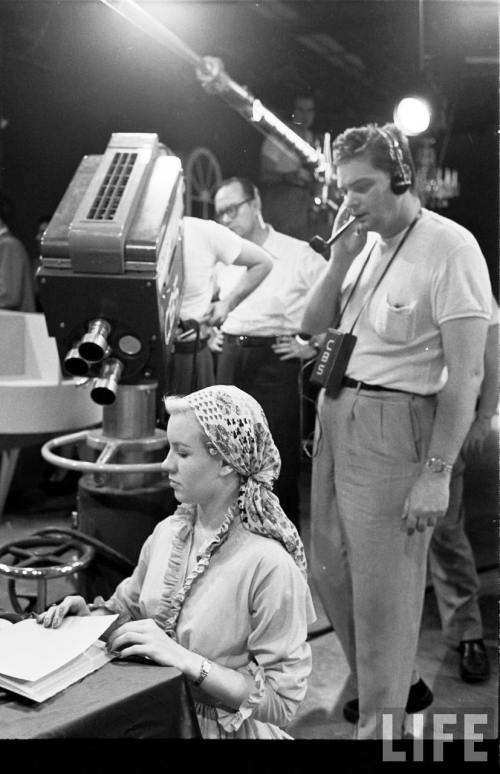

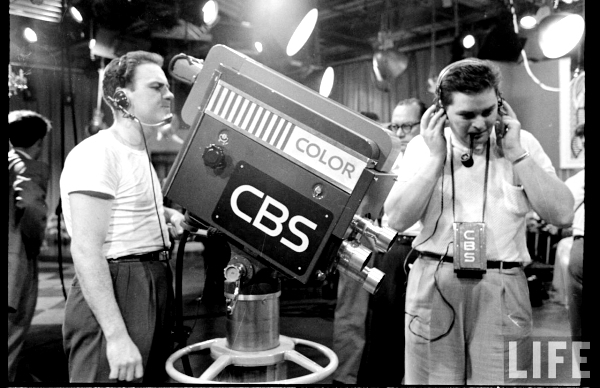
First CBS colorcast after FCC decision
In April of 1951, CBS had taken over the Peace Theater, at 109th Street and 5th Avenue, in Manhattan. After a few quick meetings, it was determined that this would become their Field Sequential color studio. While it was big and empty, it had no air conditioning. CBS called it Studio 57, and moved in five tons of equipment, but there was no time for anything else. These are shots of their June 24 rehearsals, everyone was sweating badly, and the heat was so high that floor tiles would warp when the performers danced on them.
By effectively delaying the startup of the CBS system for seven additional months, this allowed sales of even more black and white sets that could not receive the CBS signals. The FCC Chairman Coy hailed the June 25th broadcast as a "day of fulfillment" and an "hour of triumph." Viewing was restricted, as the program could not be seen on existing B&W sets, and Variety estimated that only thirty prototype color receivers were available in the New York area. Never-the-less regular color broadcasts began that same week with the daytime series "The World Is Yours" and "Modern Homemakers." By this point the market had changed dramatically; when color was first being considered in 1948 there were fewer than a million television sets in the U.S., but by 1951 there were well over 10 million.
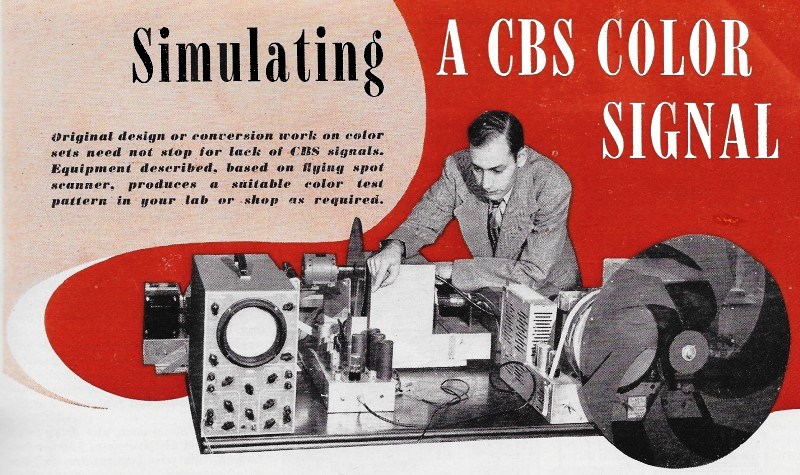
Trade School CBS Color Simulation System
There was enough interest and faith in the CBS color approach that at least one College built this simulation system. The Oscilloscope on the left was used as a "flying spot" scanner to scan a transparency in front of it, which was picked up by a photocell. Between the transparency and the photocell was a spinning color filter wheel. This simulated the camera. as you can plainly see, on the right was a black and white receiver with a corresponding color filter wheel in front of its display.
Far from allowing the blow to break color research, Sarnoff ordered a crash effort; 18 hours a day, seven days a week. TV had already become a large part of daily life and as such the public took interest. Sarnoff had well-publicized periodic demonstrations of all-electronic color progress, he would appeal to public and industry opinion and thus place the FCC on the defensive. By this time skeptics such as Allen B Dumont were now beginning to appreciate the RCA systems advancements in quality.
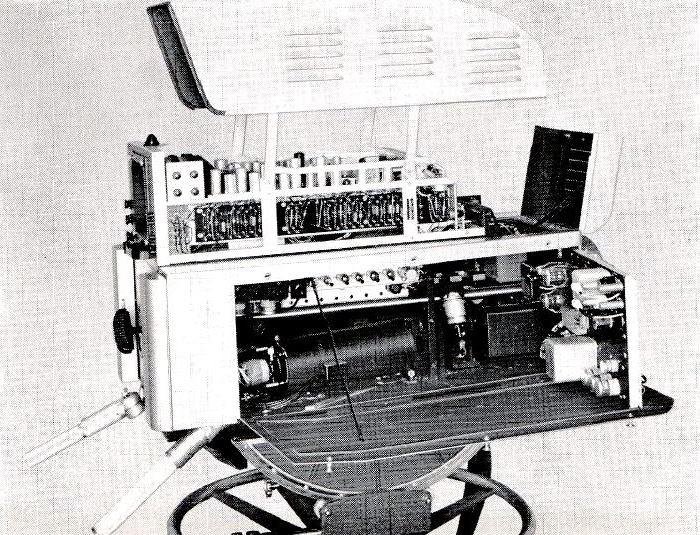
RCA Development continued
Soon the TK-40 was being supplanted by TK41s. While smaller they were still quite large.
CBS acquired Hytron Co, with its Air-King television-manufacturing subsidiary in April 1951, when no other company would produce color sets using the system, and in September 1951, production began on the only CBS color television model produced. The first color receivers were set to reach retail stores on September 28. Gimbels Department Store planned to sell them for $499.95.

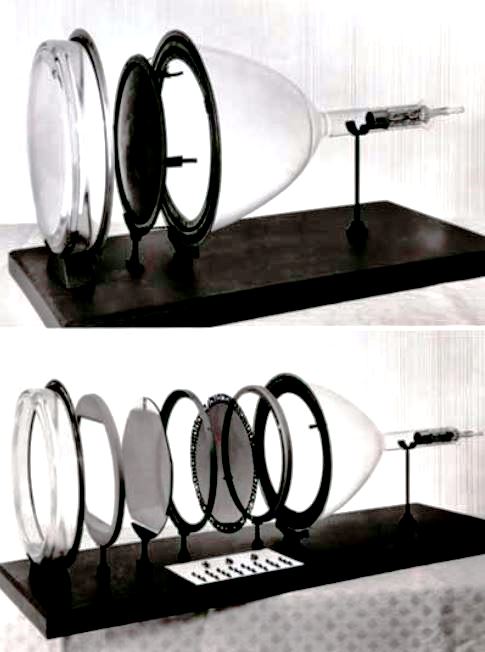
CBS Color Set
CBS-Hytron Engineering also developed a new CRT for the set which they claimed had fewer parts, and thus was easier to manufacture, and was more reliable.
Besides slow receiver sales other warning signs were developing. CBS colorcast a California-Penn St. Football Game which received disappointing reviews. One from the New York Times said that because of viewing fatigue, motion color fringing, and color unbalance the game was not watchable. While still pictures were quite good in quality some shots with action were not conveyed well. By the end of September only 200 sets had been shipped, and only 100 sold, when CBS discontinued its color television system on October 20, 1951, ostensibly by request of the National Production Authority "to conserve material for defense" for the duration of the Korean War. CBS announced, almost too quickly some thought, that it agreed and would also drop color broadcasts; color receivers were recalled and destroyed. Strangely, monochrome receiver production was not affected! The next day the last Commercial CBS Color System Broadcast, a North Carolina and Maryland Football Game is colorcast. Five later games scheduled for colorcasting are canceled.
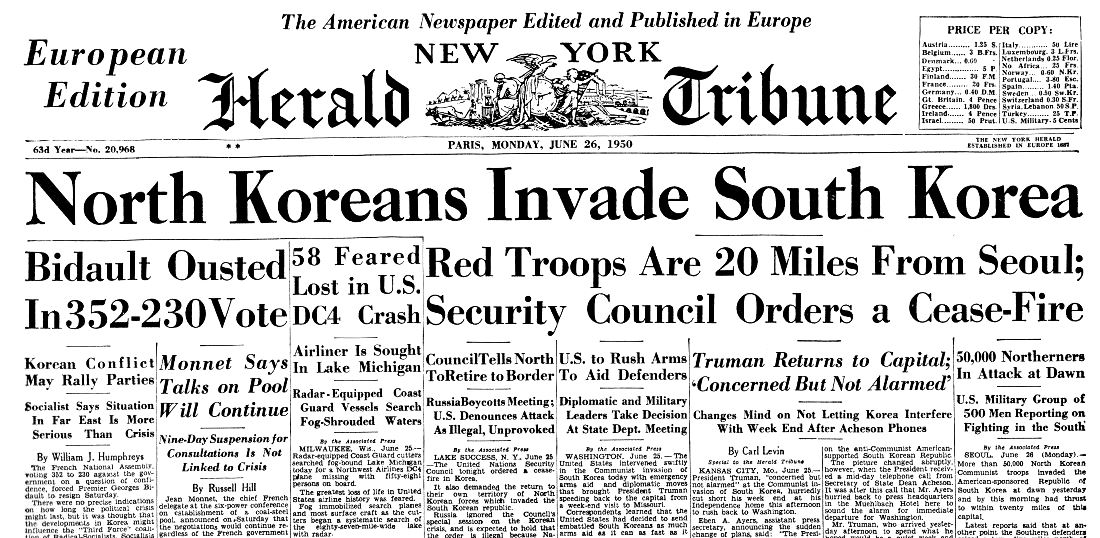
RCA chairman David Sarnoff later charged that the NPA's order had come "out of a situation artificially created by one company to solve its own perplexing problems" because CBS had been unsuccessful in its color venture. Allan B. DuMont said it was "a move to take Columbia off the hook." He charged that "CBS assented because of lack of public interest"
CBS could not follow-up on its initial triumph. No sets were produced by anyone other than CBS, and they found that the introduction of non-compatible color was an economic impossibility. Senator E.C. Johnson, who made the CBS cause his own, well into 1953, blamed "powerful interests" for blocking CBS color, in order that they might saturate the market with "millions upon millions" of black and white sets. FCC Chairman Coy kept his defense of the decision to go with CBS initially. CBS announced in March 1953 that it had abandoned any further plans for its color system.
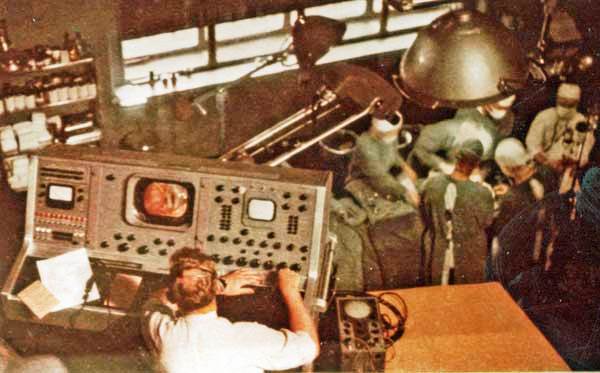
The CBS color system did have one success. From 1951 onward Industrial Color Television Systems based on the CBS Color System were manufactured and sold by DuMont, General Electric, Remington-Rand, Castle, RCA, and CBS Labs. Smith, Kline, and French had commissioned their use in medical closed circuit facilities.
On July 21st, 1953, the NTSC Color Standards Proposal was presented to FCC by the National Television System Committee. On October 17th, of that year the FCC announces approval of the NTSC System. Interestingly a couple of weeks before CBS unveiled its "Chromacoder" System for Color Camera pickup. It converted CBS color to NTSC color. CBS is on the air at 6:15 P.M. that day with a live color program featuring Rocky Marciano. This was an hour after the approval, thereby beating NBC for the first official NTSC colorcast. CBS was able to use the few field sequential color cameras they had, with conversion to NTSC using its "Chromacoder" unit.

CBS Chromacoder
CBS was hedging their bets. They developed the Chromacoder, which converted CBS sequence color to NTSC parallel or dot color. It used the persistence of special CRTs, three of them, with a corresponding three imaging tubes to convert to RCA's color system. Thus they were ready to go with a program aired in NTSC color before RCA could.
In early 1954 General Electric was licensed by CBS to build a commercial version of the Chromacoder. Unable to buy color cameras from RCA initially, most likely due to Sarnoff's spite, CBS orders four Chromacoder units from GE. It is believed that one Chromacoder system was installed at a local Texas station, WZAU.
Soon the Chromacoder faded from use. CBS color was dead. But the idea lived on. By the mid-60s electronic technology had evolved to a point where odd and even horizontal lines could carry different color information, and it didn't require any moving parts. It was Secam (séquentiel couleur à mémoire). Developed by the French with input from the Russians. Those two countries used this standard for color television in place of NTSC, or PAL. A number of African countries, mainly French Colonies, used it also. Like NTSC and PAL, it was abandoned when digital broadcasting became the norm.
The initial developer of Secam was Thomson
 , a company that had a major impact on the Grass Valley Group later on.
, a company that had a major impact on the Grass Valley Group later on.
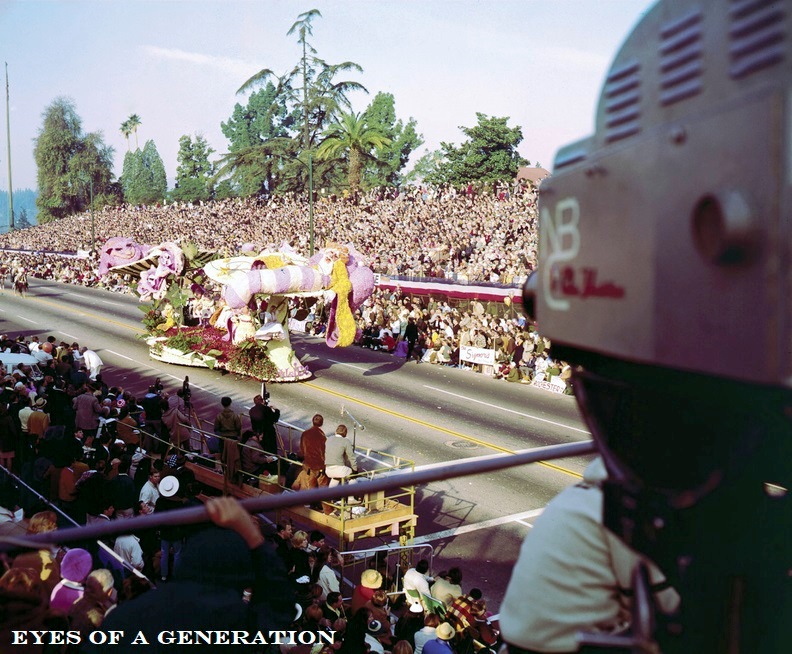
The first officially announced network demonstration of a program using the NTSC "compatible color" system was an episode of NBC's Kukla, Fran and Ollie on August 30, 1953, although it was viewable in color only at the network's headquarters. The first network broadcast to go out over the air in NTSC color was a performance of the Opera Carmen on October 31, 1953. On January 1st, 1954, the first large network coast-to-coast broadcast of NTSC Color to 22 cities was telecast - the Tournament of Roses Parade from Pasadena.
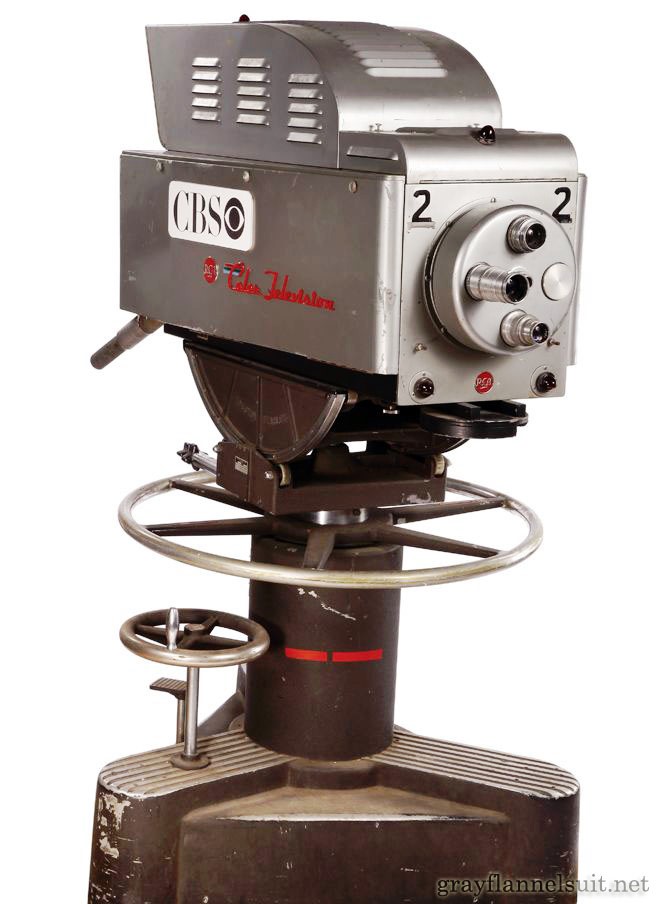
On February 1, 1954 Four GE Chromacoder cameras were ordered by CBS and to be delivered before March 1, 1954. Strangely at the same time it was announced by Walter Watts, an RCA VP, that the first two of 12 color cameras CBS had ordered from RCA would be delivered in February with the balance of the million dollar order completed by June. It is believed that CBS had also managed to order a couple cameras earlier through third parties. So early on it appeared CBS was now on board with NTSC color.
One positive fallout from the CBS color effort was the development of "crispening" circuits by CBS which improved apparent picture resolution as the CBS system had a definite disadvantage in horizontal and vertical resolution. The crispening was done by enhancing all transitions between low lights and high lights in the picture, which gave the impression of more resolution. This development is still used in cameras to this day.
The hope that RCA might simply walk away from color was always short-sighted. By 1950 RCA had already sunk about $20 million into color research and field testing. RCA was the leading company in the television field, with a larger technical staff, more development funds, and more political access, which eventually succeeded in getting the NTSC compatible color television system to fruition.
A big breakthrough in color television receivers also happened in 1953, it was the invention by RCA of shadow mask color CRT. Its accuracy in electron beam landing and the mask layout over the front CRT phosphor, created a much sharper display.
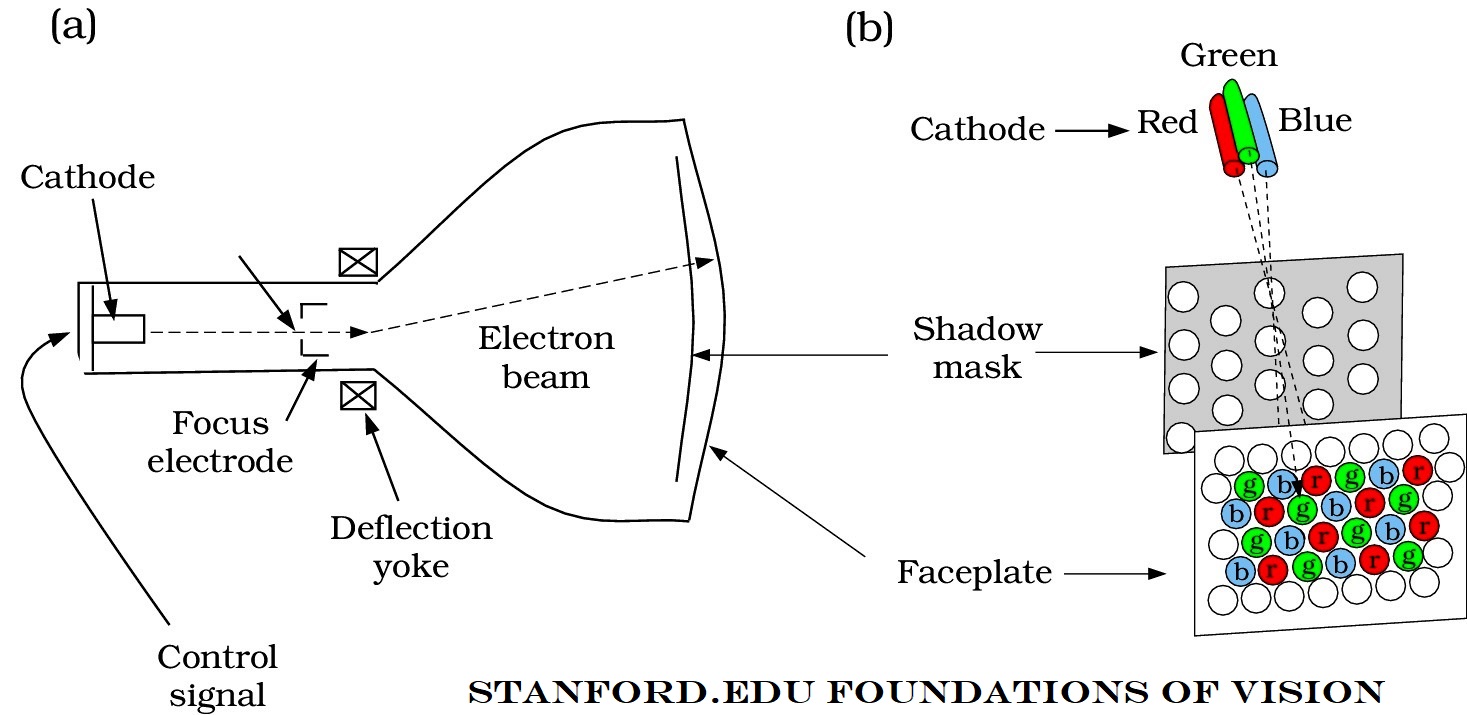
RCA Shadow Mask CRT
The left side of the graphic (a) shows that most of the CRT was organized as before. The breakthrough was on the right (b) side. The three scanning beams (R,G,B) could only pass the holes in the "mask." The beams were aimed so that they converged at the mask and the result was the beams could only land at distinct spots on the faceplate. This made for much more accurate beam landing resulting in a sharper picture with truer color.
RCA TK-41: First production color TV camera
 The gory technical details of RCA Color Television
The gory technical details of RCA Color Television

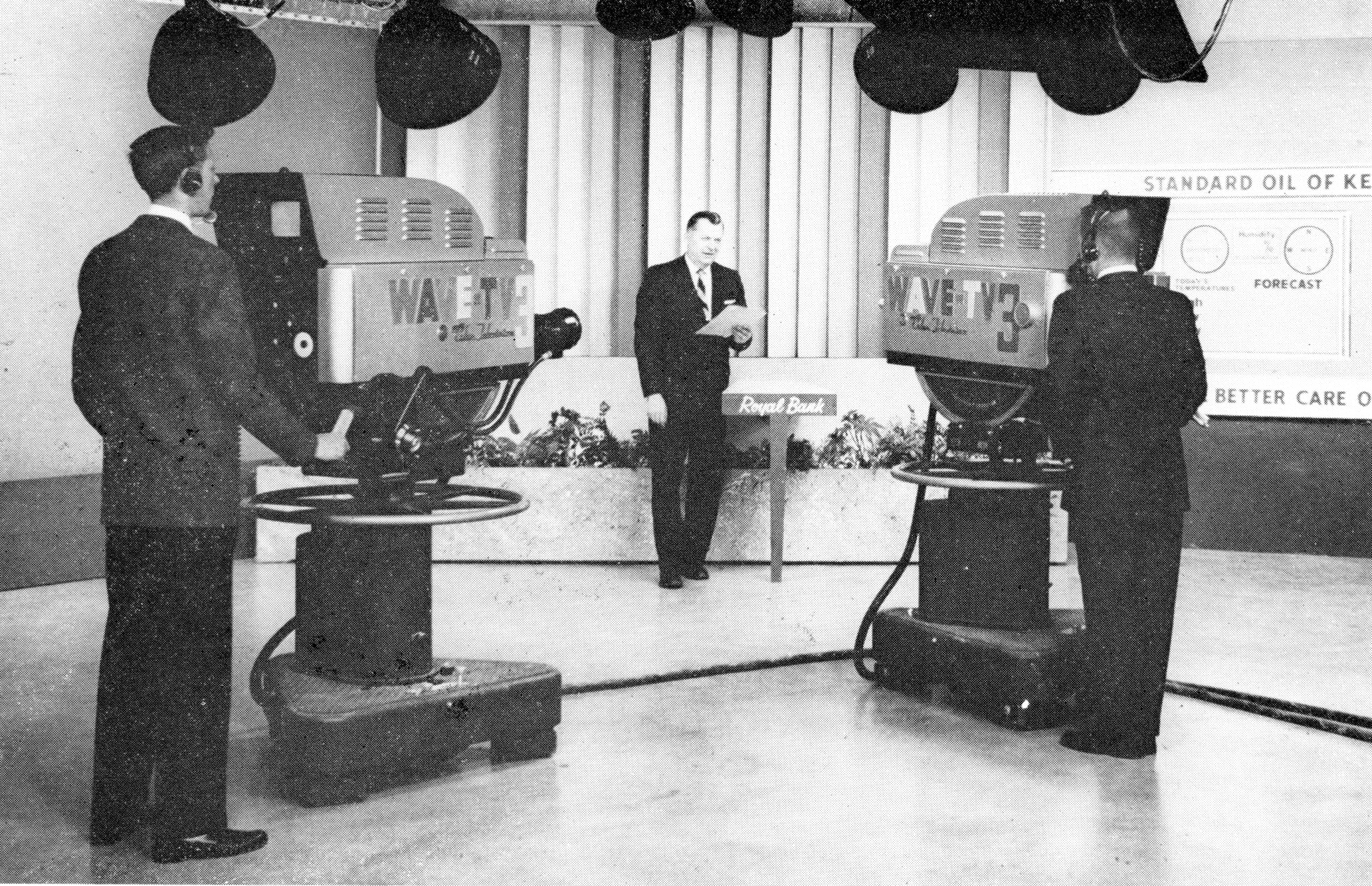
These were large and could be hard to manage in a studio. The camera head, the only part of the camera seen here, weighed over 400 pounds!
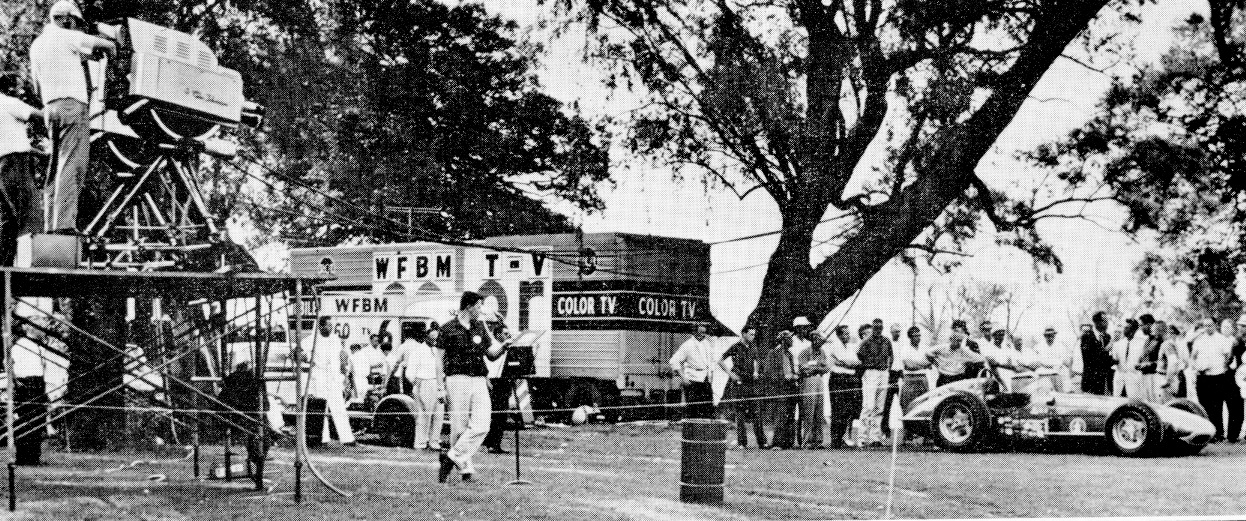
It usually took four people to lift the camera head! The author of this site got his first real work in television because he was young with a strong back!
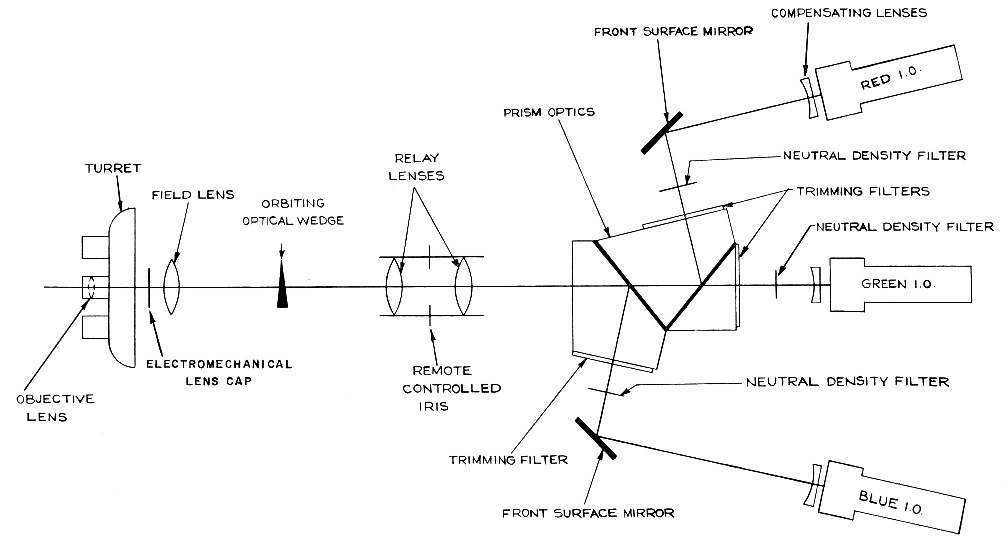
One of the reasons that the camera head was so large was the fact that a color video camera is really three black and white cameras in one package. This is still generally true today, except for many low end cameras. Here is the optical path that splits the incoming light up into the three primary colors used.
As mentioned earlier the tubes used in this camera were all Image Orthicons, which tended to let stationary images burn into their targets if the image was static and not moving. In other words the image could be seen after the camera panned away to another view. To prevent that a "orbiting optical wedge" in front of the prism, a concaved piece of glass, would be rotated and the result would be that the image would keep moving in a very small concentric circle. When the camera was actually being used during a show that "feature" would be turned off.
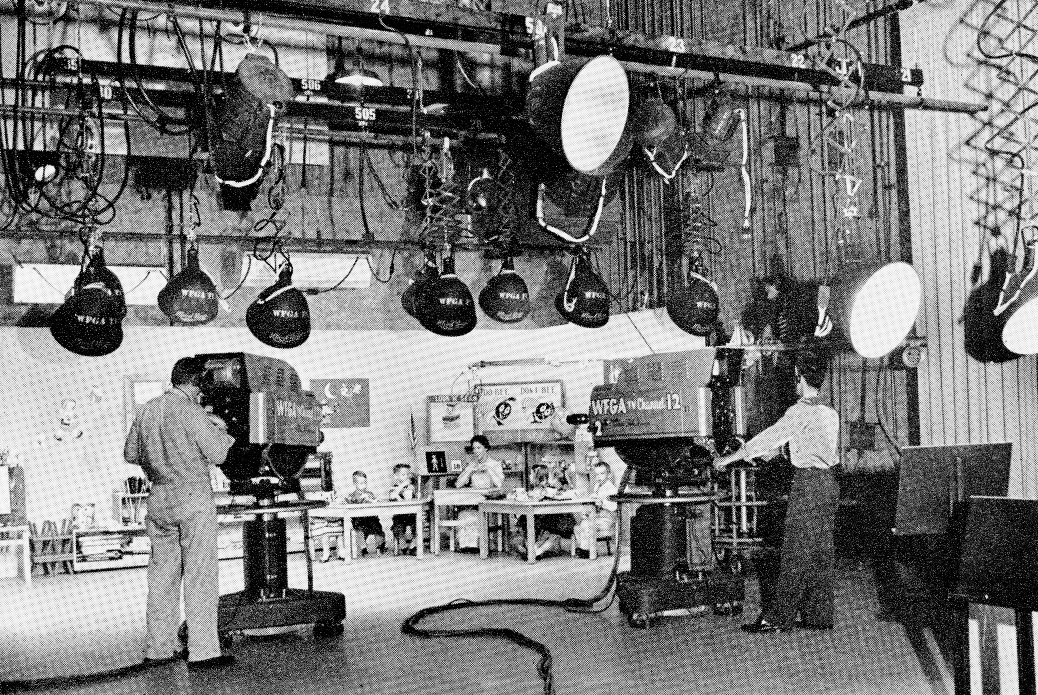
Because the incoming light through the lenses of a color camera was split, early color cameras needed even more light than black and white ones.
Below, straight out of a RCA brochure, the page touts the ease of access to the various parts and sub-systems in the head.
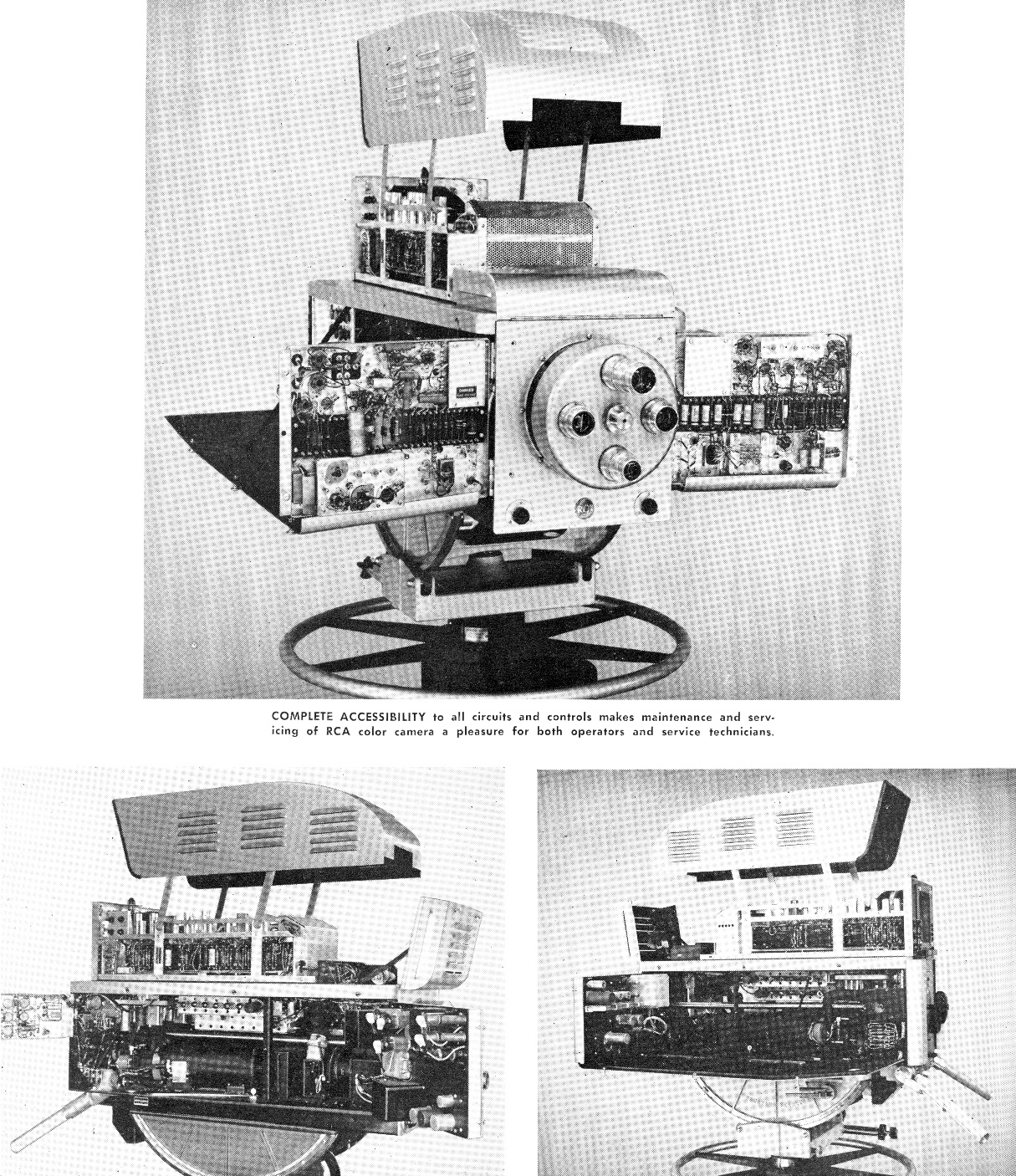
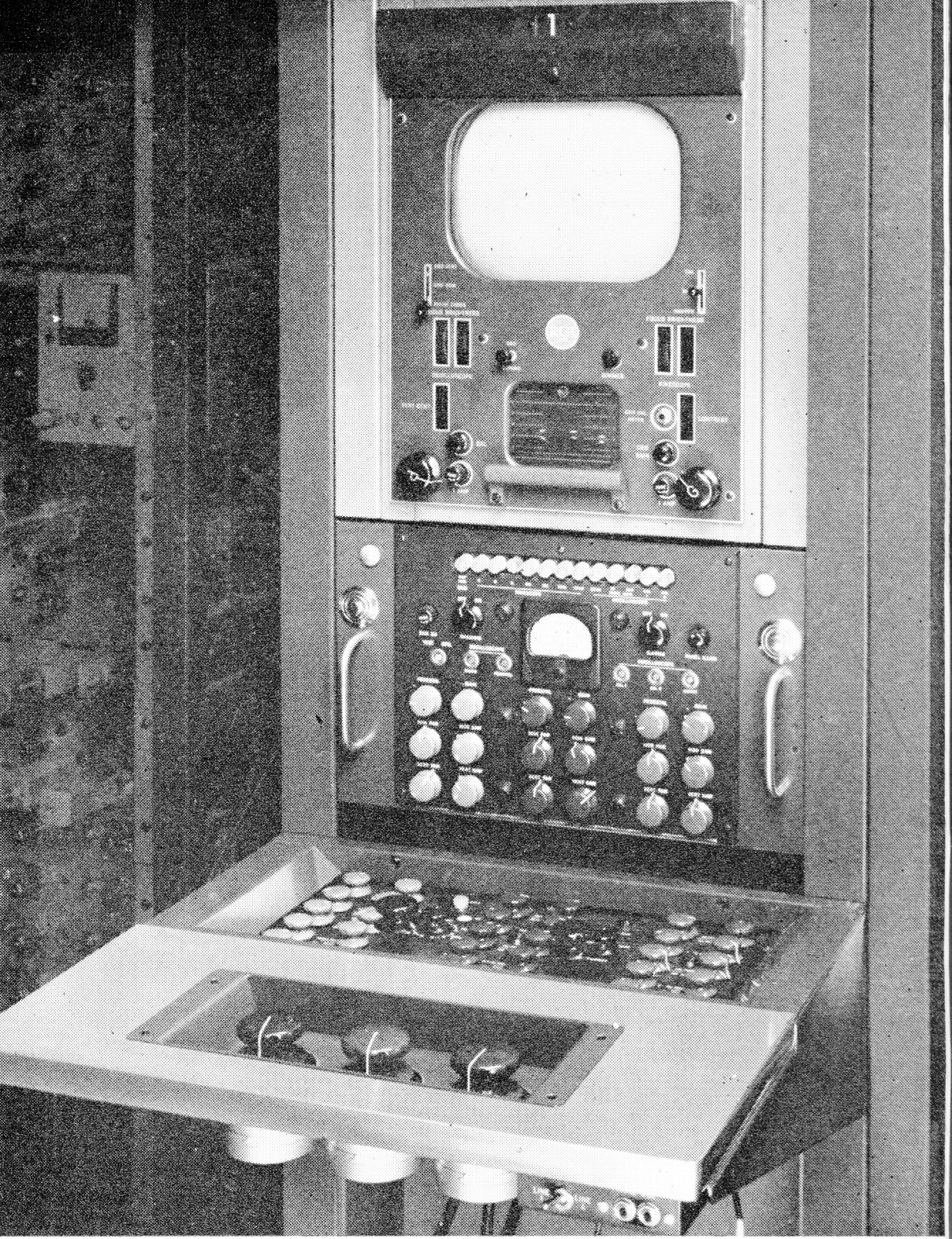
The TK-41 had just under 200 vacuum tubes in it. All slowly aging by slowly consuming themselves because of the thermionic emission occurring within them. As they aged their operating parameters continually changed. The result was the necessity of near constant adjustments. Also, since microprocessors, and other complex ICs for automating these adjustments were far off in the future, almost every parameter to be adjusted had its own control knob.
Here is the camera control unit (CCU) where the video operator would setup the camera and maintain the cameras settings while it was in use. The camera head had adjustments for color registration, and geometry. A fancy way of saying to adjust the scanning of the three color tubes, so that they all lined up in the final video signal out: width, height, and centering wise. The controls on the CCU generally where to make sure the three color signals combined correctly so that red was red, and not slightly orange or brown, that blue was blue, and not magenta or slightly cyan, etc.
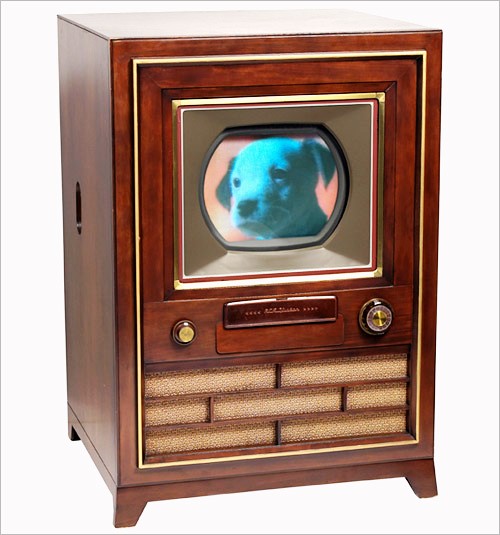
Slow to adopt
Compared to the size of the set, the screens were small
So, by 1954 color TV seemed settled. The problem was that the first color sets produced by RCA were not cheap, and retailed at $1000, which would be almost $10,000 today. Even at that price each was sold at a loss. Only 5000 were distributed initially. Early on most manufacturers of sets boycotted the system. Fortune in 1962 said "For five years after it marketed its first set in 1954, RCA found itself the solitary tenant of the new world." Elmer Engstrom President of the time at RCA explained: "Our competitors were as eager as we to have the right route established for color. Once that was done, the whole industry relaxed. We always had our arms around color, and we couldn't let go as the others could." In plainer words they had too much invested in color to let go. Some pointed out that part of RCA's problem might have been the great bravado it engaged in when the decision came down their way.
Sarnoff would often lament that while RCA did most of the pioneering in TV and then color, others would hang back until the invention reached maturity and then jump in and get rich. RCA spent $130 million on color before it saw any returns. Besides research, and manufacturing setup, it forced NBC into producing color programs that advertisers would not pay extra for, along with RCA's marketing of color sets.
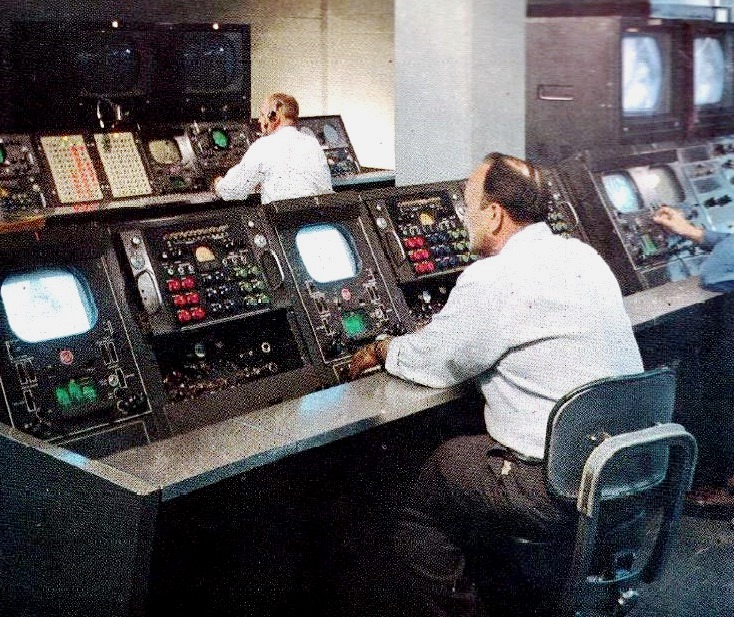
Operator at the controls for only two TK-41 Color Cameras
The other necessity for color TV to the home is the equipment at the broadcast end. Mainly color cameras. The first introduced for actual sale by RCA were known as TK-40s, which soon were supplanted by the TK-41, which fixed early design issues in its predecessor. The camera weigh almost 600 pounds it you added all the parts that made up one. The camera head, what people saw in the studio weigh almost 400 pounds. It made color video using less than 200 vacuum tubes. Compare that to a single IC in a camera today that might have thousands of vacuum tube replacements, transistors, each. Imagine a Mount Everest of processing elements verses a small burn pile of fragile and often short-lived components. How was that possible? Instead of user GUIs, and auto everything, imagine hundreds of knobs, each of which needed to be adjusted every few hours. These cameras came out in 1953 and stayed in production for the next 11 years.
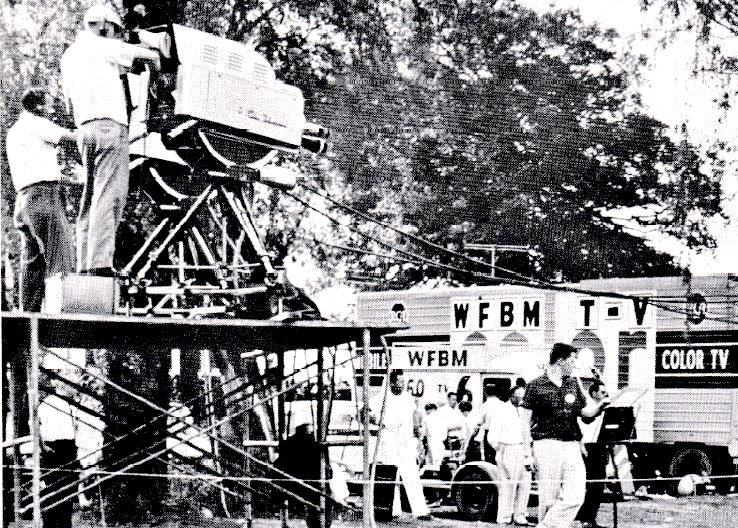
The first color cameras
TK-41s on location
The first RCA color cameras that made it into use were known as the coffin cameras, because they were big enough to bury a person inside one. They were used for testing in Washington, D.C. for the FCC, and later in NBC's studio 3H in Rockefeller Center. There were only two ever built. They were replaced in 1952 by the first real production cameras, the TK-40. The B&W camera that RCA sold many of was known as the TK-30. The 40 number indicated a major advancement from the previous 30 series. All future RCA color cameras, save one, had numbers in the 40s. The exception was a model called the 76, that was introduced in 1976, and was RCA's first portable news camera.
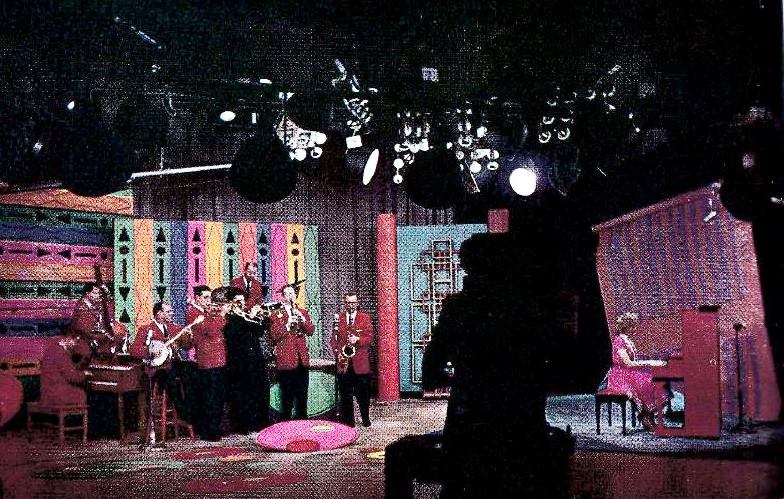
Lots of studio lights
The TK prefix was probably in honor of Zworykin. The best explanation seems to be from Lou Bazin via Bobby Ellerbee. Bazin was a lead engineer on a couple of RCA cameras, and Ellerbee has a great site on the technical and production history of television in the U.S. Supposedly TK stands for Tele Kine. Tele originally meant "across a distance." Now the word itself is associated with television. Kinescope, or simply "kine," which was coined by Zworykin, was what RCA called their CRTs. The industry pronounced "kine" with a long e.
The original two prototype "coffin" cameras were painted grey (photo above). These cameras consumed a lot of power and thus generated a lot of heat. These cameras also required a lot of studio lighting to produce decent video. So, when the TK-40 was released they were painted silver to reflect some of the studio light so that it was not adding to the internally generated heat from the camera.
These color cameras, as explained before, used an image splitter, producing red, green, and blue component colors which directed the incoming light into three image orthicon tubes. As mentioned these early color cameras required tremendous amounts of light to operate correctly, making television studios of the day hot and uncomfortable. Splitting the incoming light through the lens into three streams, instead of just one for B&W cameras, made the situation worse. Individual studio lights could be as large as 5000 watts, with 1000 and 2000 watt lights common. Large studios could have 100 or more lights. Early on cameras required upwards of 1000-foot candles of light for optimal video. With newer pickup tube technology, and then the use of CCDs over the years the required light for some productions can now be below 20.
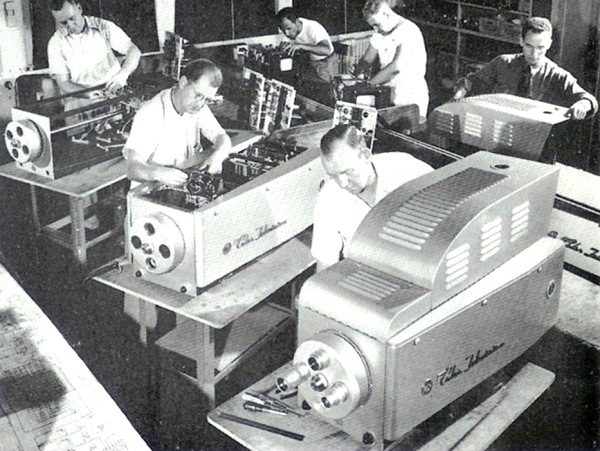
The RCA TK40 began broadcasting color images for the first time in late 1952, it was followed by the TK40A, which in 1954 became the first color camera to go into mass production. In 1955 RCA discontinued the TK40 in favor of the TK41. The TK41 was followed by the A, B and C models, and RCA manufactured them until 1964. RCA made 24 more on a special order in 1966; 12 of them were for ABC's remote trucks, and 12 more were sold to stations.
.jpg)
In 1954 the first two TK-41s were delivered to a local station WKY in Oklahoma City. In 1956 the NBC owned station in Chicago became the first "all-color" operation. Besides studio cameras, that also meant that "film chains" had to be color also. A film chain usually consisted of two film, and one slide projector pointed into a series of mirrors that would control which projector shined into the film chains camera. Before video tape, all television programming had to funnel through a camera.
Early color cameras were a precious commodity and could not be dedicated to a single show no matter how important that show was. Even the Today Show had to share its cameras. When the show talked of moving to larger space, they were told they had to stay a part of Rockefeller Center as part of a central facility.
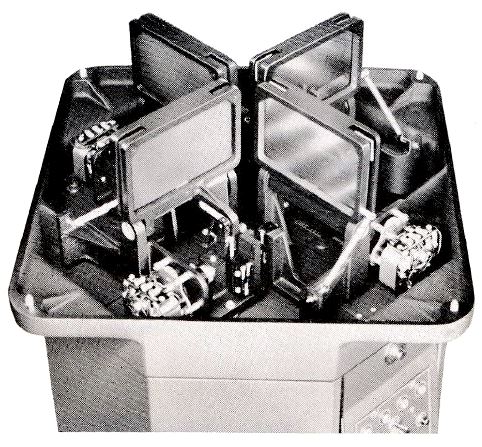
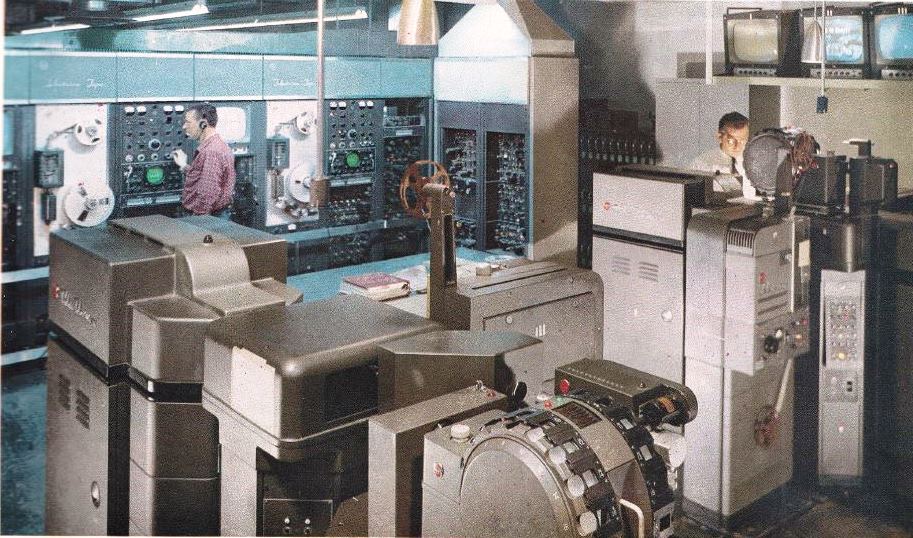
Film Chains
Up until this time if an image was not captured by a television camera of some sort, it did not make it to "air." While we are getting close, video tape recording at this time was still in the lab. But the photo on the left does show early Video Tape Recorders in the background.
The "RCA Gray" contraption in the foreground is a "film chain." A film chain was a system made up of one or two film projectors, a slide projector, and a repackaged television camera. In between the slide and film projectors, and the camera was a "diplexer," which was a series of mirrors which determined whether it was the slide projector or one of the film projectors that shown into the lens of the camera.
The photo on the right shows the mirrors. Powerful solenoids would drive these mirrors up or down depending on which projector was needed into the camera. The solenoids, moved into and out of position so fast that there was a very noticeable "clunk!" if you were within a hundred feet of it. The speed was so fast so that operations could switch between the projectors while the film chain camera was on the air with very little picture disruption.
Remember at this time cameras, studio, or film were precious commodities and so a film chain camera was naturally shared between projectors.
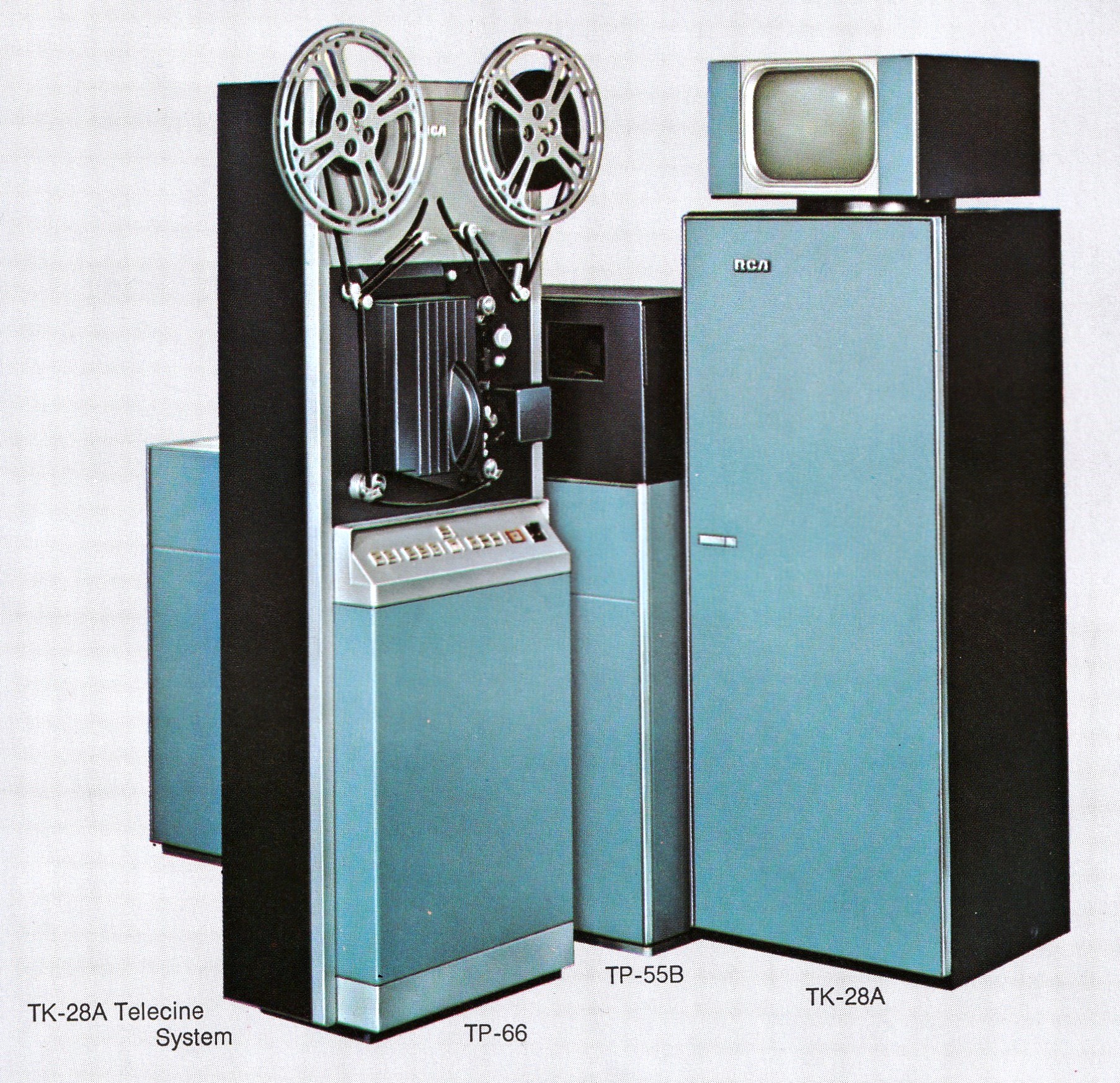
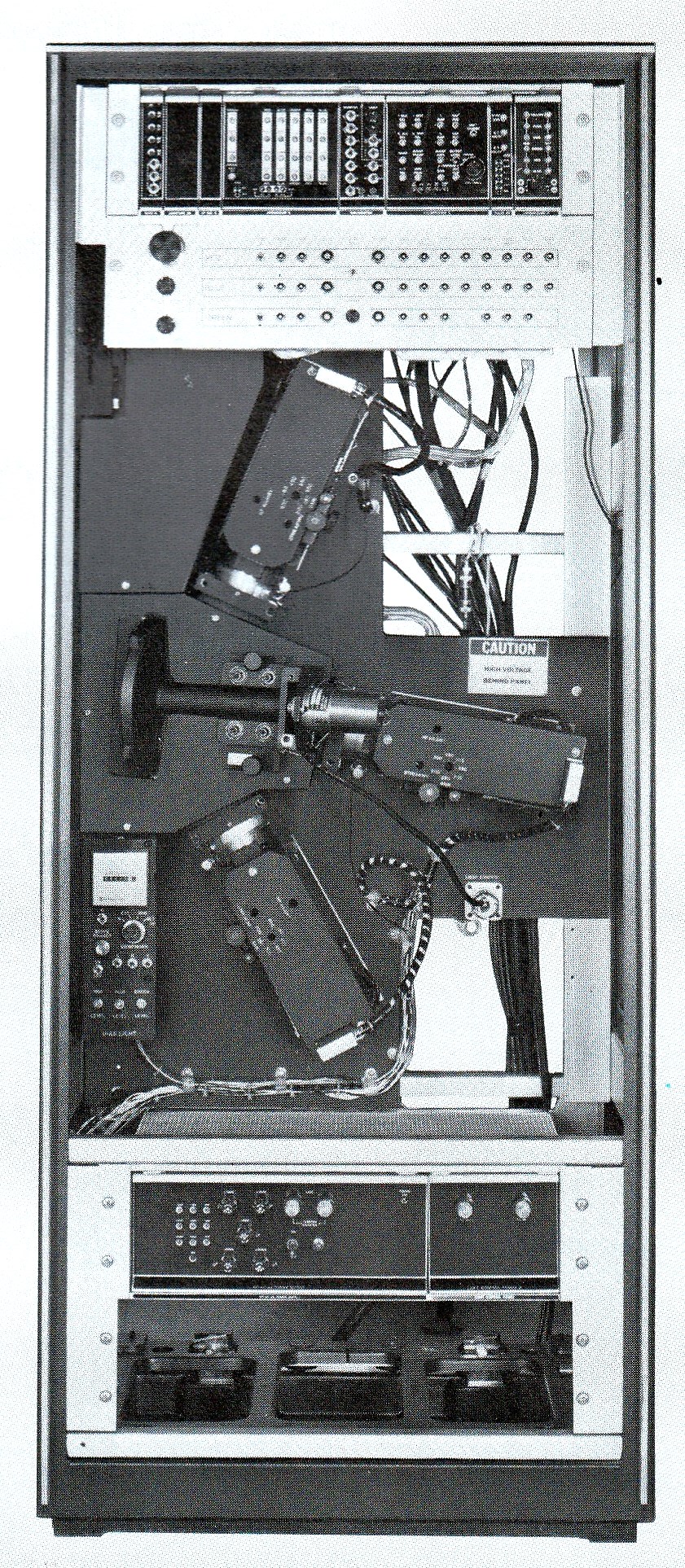
A 1970s complete Film Chain
These systems were found in television stations into the 90s. Often powered down, but still available for the occasional film that was need for air.
The right photo shows the camera portion of the system, where the R,G, and B imaging tubes are easily identifiable.
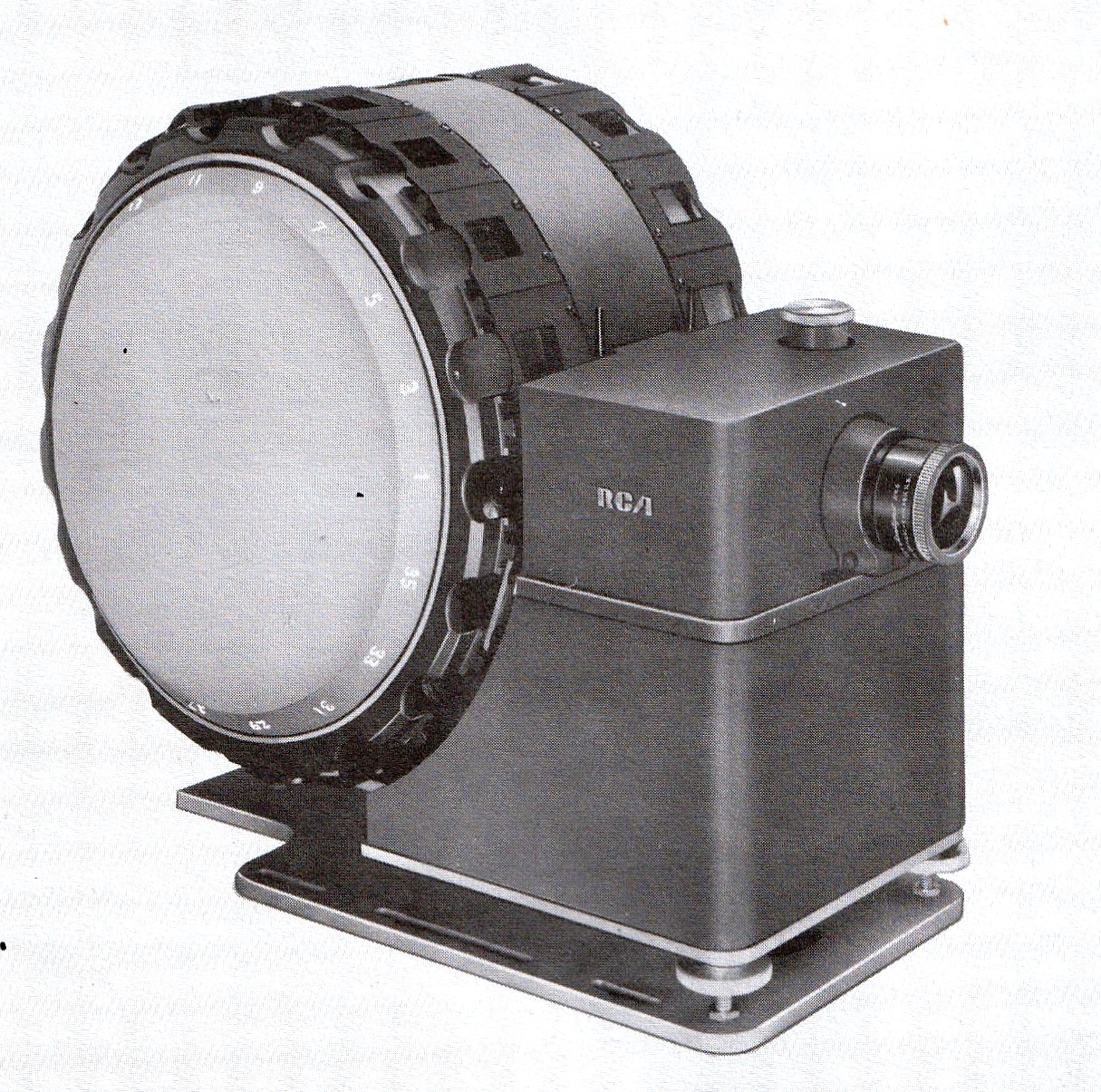
Drum style slide
projector
Final piece of the "film chain"

Successive RCA Film Equipment
In 1954 and 1955, NBC and CBS each had only one color studio each on the East and West Coasts. ABC would not have a live color stage until ten years later in 1965. The unavailability of color studios led to early color programming practice of the occasional color special or colorizing a single episode of a regular series. In several instances, local affiliates had better color facilities than the networks. The first dedicated color studio that NBC had was Studio 3K, which was created by taking a wall down between 3H, NBC's first television studio and 3F, which was a radio studio. Although the first commercial color broadcast was "The Colgate Comedy Hour" on November 22, 1953, the "Hoody Doody Show" done in 3K on September 12, 1955, became the first daily color television show.
NBC's Burbank facility did not do its first color telecast until early 1955.
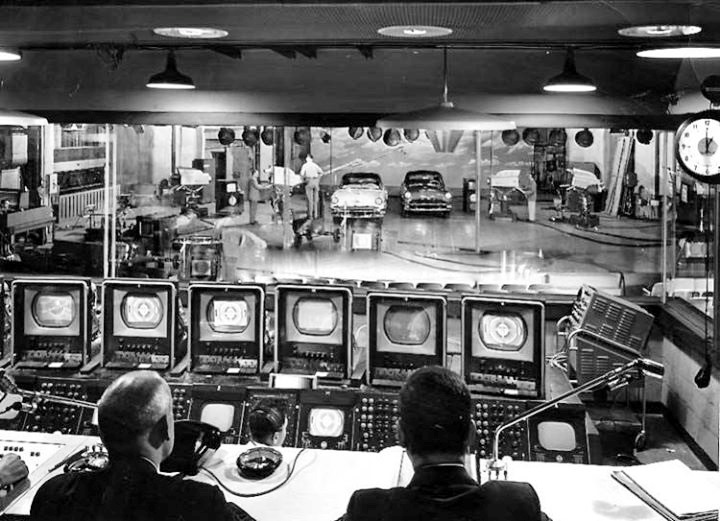
CBS Studio 72
CBS was forced to give in and buy a few RCA color cameras. The first ones they bought through contacts at Philco, as they did not want RCA to know, while their battle over color was still brewing. They were TK-40s, which they acquired mainly to study it and determine what to do about color. These four went to their Television City facility in Hollywood, where they were used occasionally. In 1954 they bought four directly from RCA and equipped a studio in New York City, Studio 72. The first big show was the telecast of "Cinderella," which stared Julie Andrews. The Studio also did Ed Sullivan's "Toast of the Town." The network did about 50 shows out of the studio in 1956. By 1960 the studio was barely used, and CBS east and west coast color productions dwindled to a few shows a year.

Red Skelton, who bought the old Charlie Chaplin Studios had his own remote production color television equipment that he used to produce his show on CBS, tried to get CBS to use his facilities to increase their color offerings. They were not interested, and eventually he sold the studio to CBS, and the mobile units to KTLA and continued his show from CBS's Television City. CBS was not an early fan of color, especially due to the fact that they had to buy equipment from RCA. They went so far as to take all RCA nameplates off their color cameras, and even the stylized "Color Television" plate off the side of the cameras. CBS executives claimed that they would commit to color when the sponsors wanted it.

Red Skelton's mobile production trucks
His company had three RCA TK-41s
Remote production vehicles around 1960
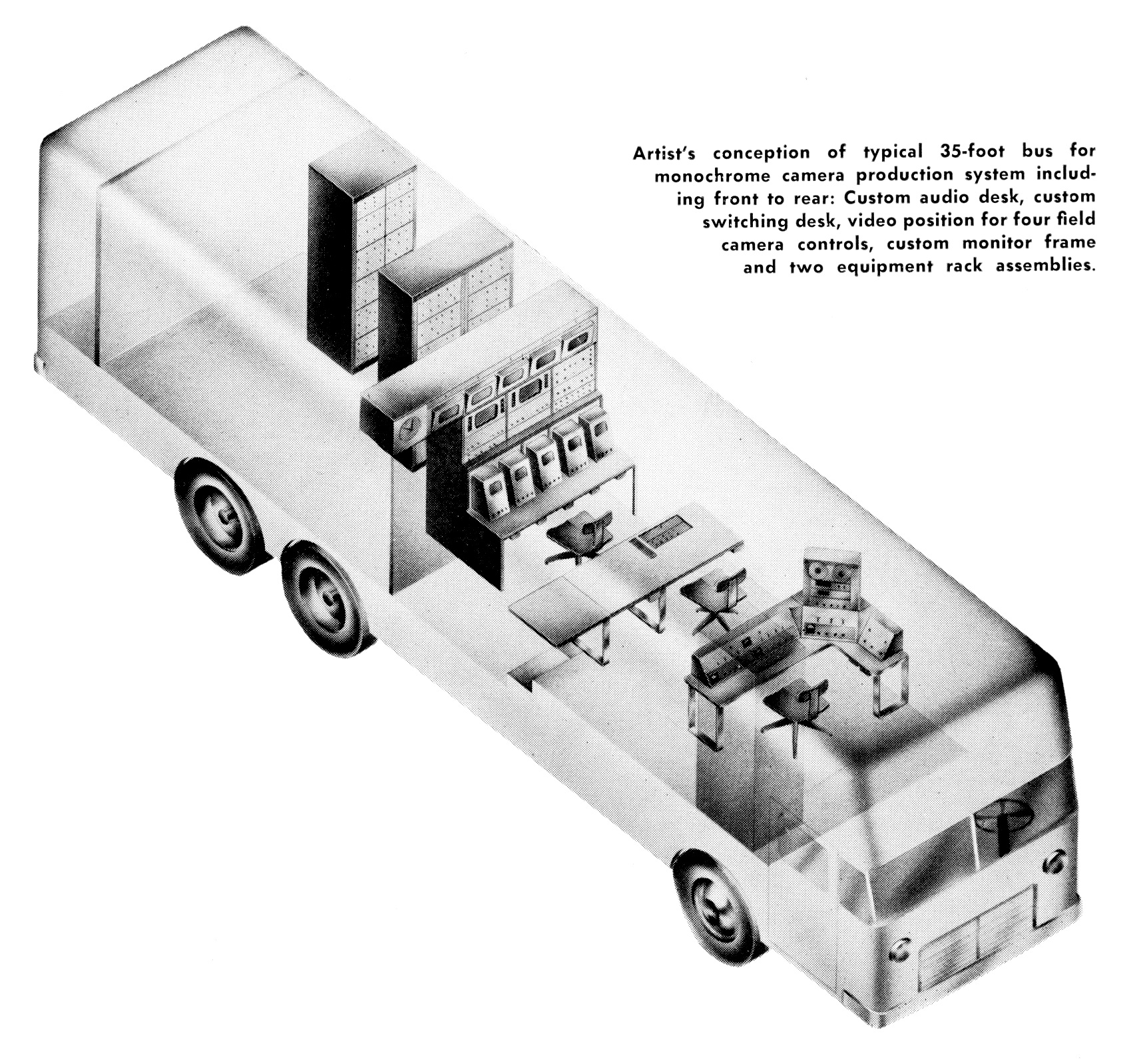
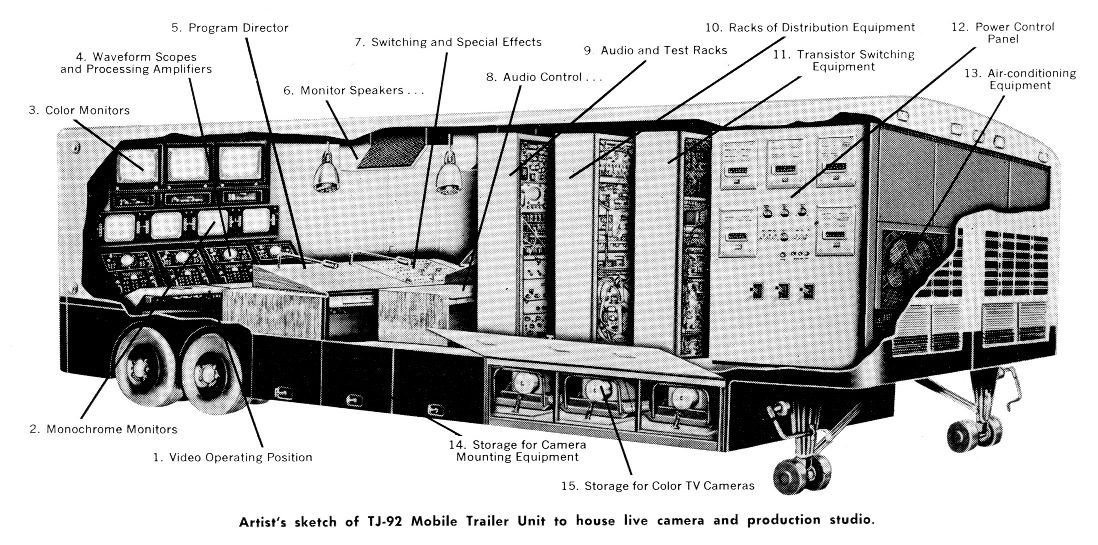
Eventually as the amount of equipment carried out to do remote production increased, eventually all large production units became one, or more trailers. Back when these trucks roamed the countryside, cameras, VTRs, etc. were so large that few were on board these units. A six camera truck with a couple VTRs was considered large. Today a production unit with a couple dozen cameras, and many dozen recording channels are found often.
Tour of mid-60s CBS Mobile Unit
Very quaint by today's standards.
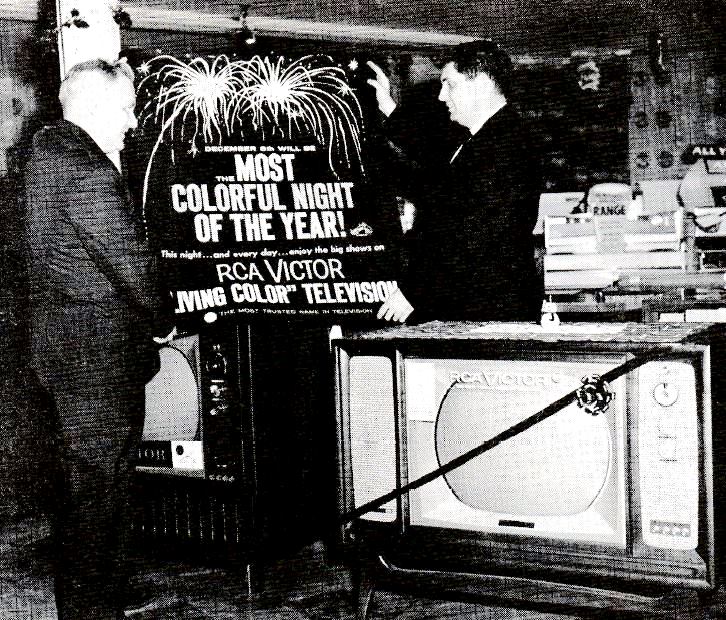
At its beginning, the "Tonight Show" was done live, but in January 1959 they began taping the show, and in September of 1960, the show went all color. In 1960 and 61 RCA made a big marketing effort to sell color receivers. They forced NBC to up their production of color shows. This was partially due to the fact that in the late 50s the sales of B&W receivers had begun to saturate, and sales slowed. Now other manufactures started to realize that color sets might revive the industry. In 1959 RCA had its first year of profitable color-set sales. Soon companies like Zenith, who originally derided color CRTs as a "Rube Goldberg contraction" began to offer color sets. By 1963 RCA revenue from color set sales equaled the revenue from B&W sets.
RCA stopped making the TK41 in 1964, but NBC needed new cameras and they were not happy with RCA's replacement camera, so a final run of a dozen or so were built.
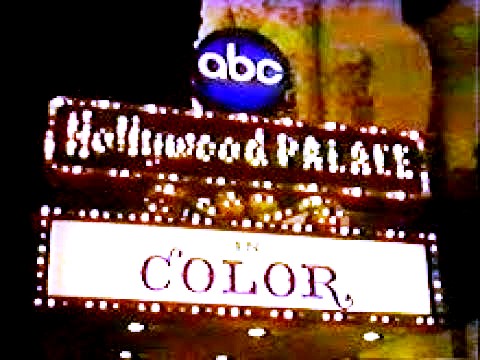
ABC's first color facility was The Hollywood Palace. In the summer of 1965, they bought an RCA color production truck that RCA had used at the 1961 World's Fair. The four camera TK41 truck was parked next door to the venue for a year, and the first live color show on ABC was The Lawrence Welk Show in the fall of 1965. During a production break during the summer of 1966, the theater was redone with a new control room and equipped with new, non-RCA cameras. The truck went to ABC Sports. ABC eventually had at least a dozen TK-41s doing sports.
The TK41s were in use by affiliates and networks well into the 1970s. Even with third generation camera offerings from RCA introduced in 1968, NBC kept its New York, Los Angeles, and O&O-station TK41s in service for years. Johnny Carson's Tonight Show used TK41s until about 1970. ABC had backup sports trucks with TK41s as late as 1978.
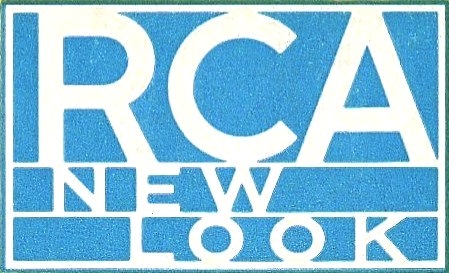
RCA's Second Generation
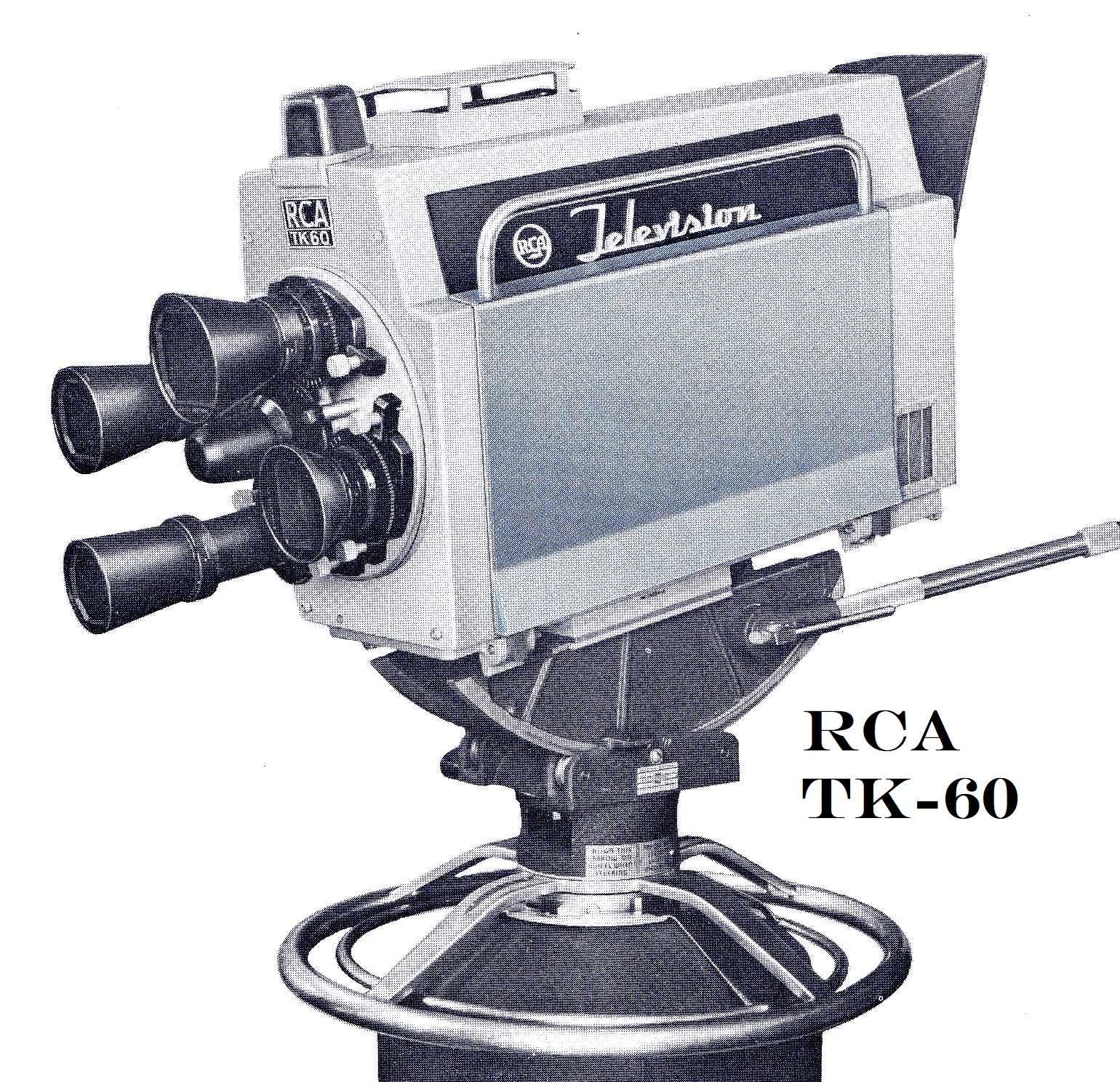
 What David Sarnoff eventually did to "Nipper"
What David Sarnoff eventually did to "Nipper"
Back from exile
Article
RCA continued to offer B&W cameras until the mid-60s. In 1960 they came out with what the company called the new look. Gone were racks, cabinets, consoles, and chassis that were painted a dull to dark grey, instead it was heavy on blue and silver. The shade of blue used came to be known as "RCA blue" in the industry. A "new look" TK-12 black and white camera was introduced in 1960. An upgraded version that fixed mechanical and heat problems became the TK60 in 1963. this was RCA's first solid state camera (with the exception of one very small vacuum tube that RCA had invented in 1959). Like the earlier mentioned TK-76, and being a camera of the 60s, it was given that name. The camera continued to have pickup tubes that were essentially vacuum tubes. In fact, the TK-60 had a large one which had a 4 1/2 inch wide target, the same as the three in the TK-41. The TK-60 had a reputation for making very good video, albeit black and white.
With the new look marketing push RCA began to feel it was time to replace the TK41s with a new model; the TK42. They showed an experimental model at the NAB show in 1962. RCA wanted a black-and-white picture as beautiful as the TK60's and a color picture as good as what the TK41C produced. To get the same quality black and white TK60 picture, they used the same 4½ inch image orthicon tube for the monochrome or black and white image, but also used three smaller 1 inch vidicon tubes for each of the three colors. This led to a fairly complex light splitting system that required a lot of space and ended up having the pickup tube targets facing backwards in the camera. The three vidicon pickup tubes where less sensitive than the image orthicon tubes used up until then. Also, being smaller in size meant they did not have the resolution that the larger tube had. That was probably the first instance of purposefully sending less color information than luminance information. That concept continues to this day as we will see later in the book.
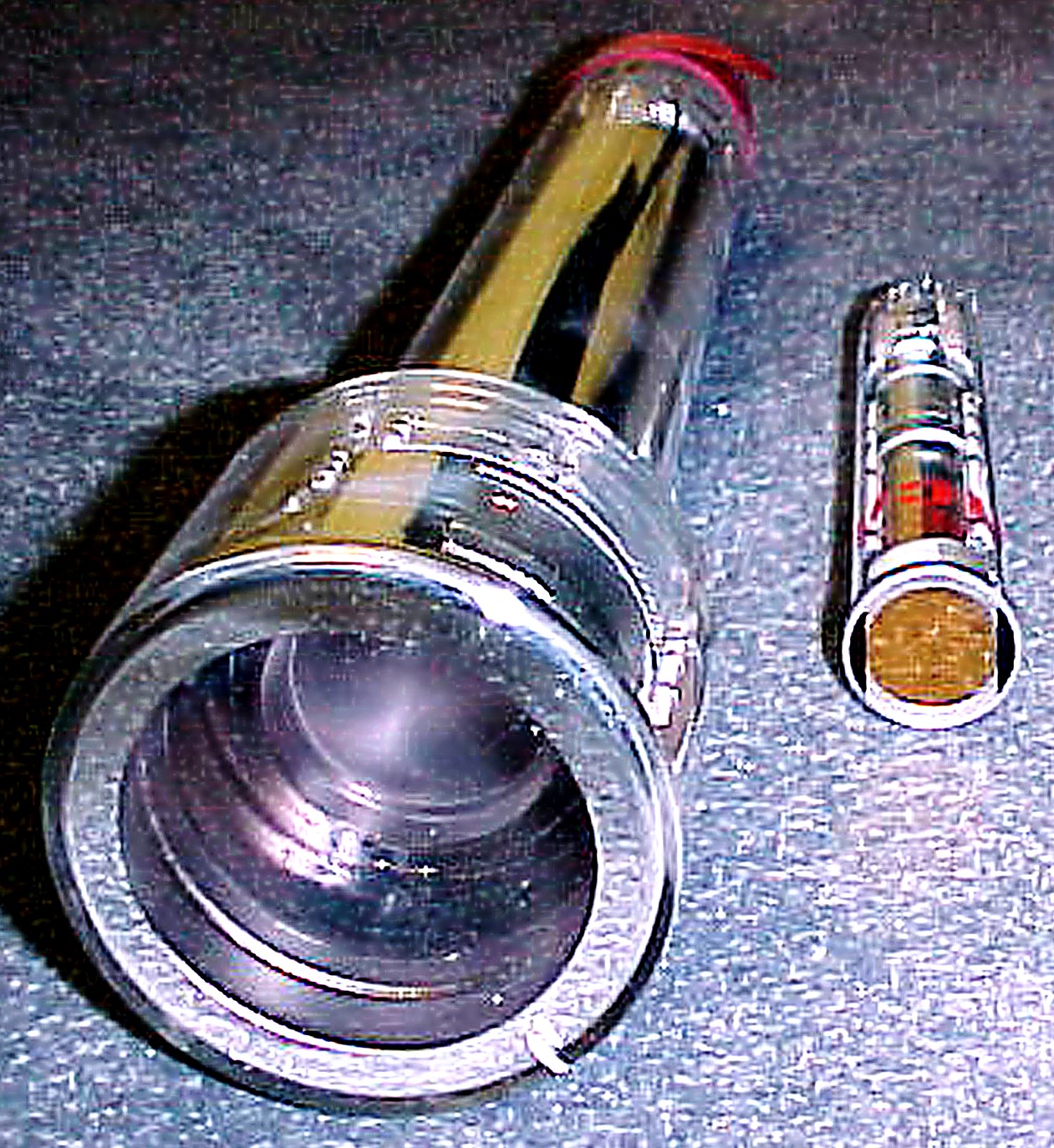

TK-42
The photo on the right shows the two different image tube types used in the camera. There was one of the larger tubes, for the black and white signal, and three of the smaller tubes for each of the red, green, and blue color channels.
This camera had its base zoom lenses mounted inside the camera head portion. Let us talk a moment about what constituted a camera back then. The camera that one saw out in the studio or in the stands at a sporting event was called the camera head. The camera head had the necessary optics and electronics to send unprocessed video to what was called the Camera Control Unit, or CCU. The CCU processed the video and combined it into a single color signal. These cameras consumed much power, often almost 2000 watts. So, there was a separate power supply also.
 Magazine cover showing the four tubes used in the TK-42
Proof that the TK-42 was not much lighter than the TK-41
TK-42s at 1967 golf match
Magazine cover showing the four tubes used in the TK-42
Proof that the TK-42 was not much lighter than the TK-41
TK-42s at 1967 golf match
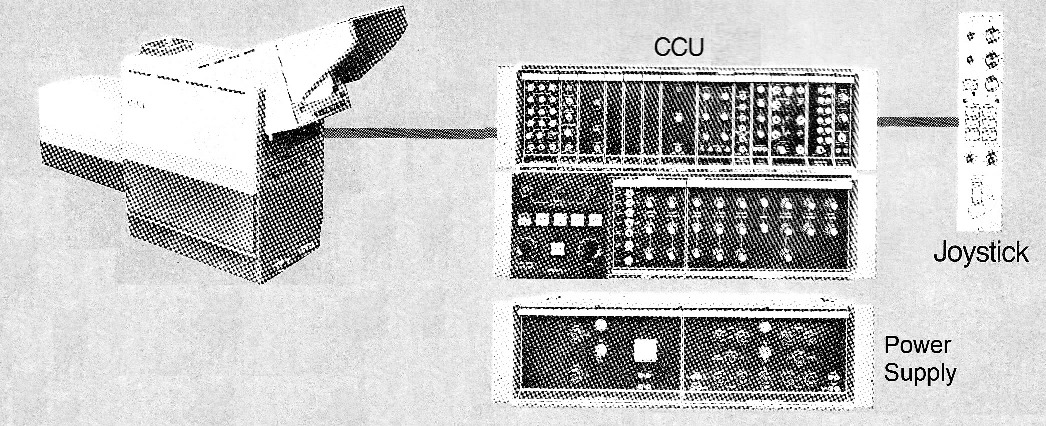
Sample Camera System up through the 80s
In essence RCA wanted to put a TK41 and a TK60 in the same camera head. They wanted the TK60s 4 1/2 image orthicon, so the image broadcast to the millions of still mostly black and white receivers was sharp, but also wanted the kind of great color images that came from the TK41. With the plan to put the lens inside the TK42, that did not leave enough room for the three image orthicons and optics from the 41, so they opted for the smaller vidicon tubes for the red, green, and blue signals. This was RCA's first all solid state color project, no vacuum tubes were used, again with the exception being the pickup tubes. RCA soon had an upgraded TK-42, naturally named the TK-43. The main difference between the TK42 and the TK43 was the external lens on the 43. The internal TK42 zoom lens was affected by the camera's heat and at times would "chatter" while zooming as the lens elements tended to expand due to the heat in the camera head, making a smooth zoom a matter of luck.
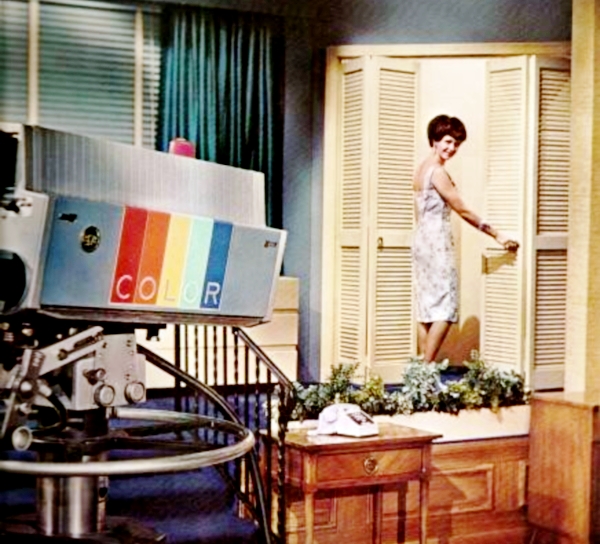
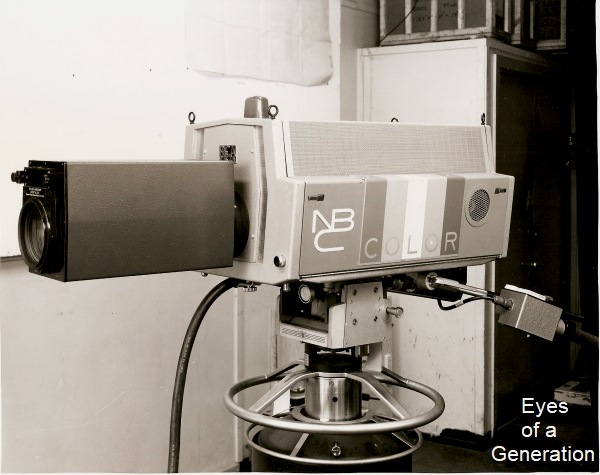
The lens problem, the camera heads 280-pound weight, almost as heavy as the TK-41 it was to replace, plus the fact that RCA had color camera competition on the horizon kept this camera from being used by any of the networks, even NBC. Well not exactly. RCA shipped a few TK-43s to NBC to be used on an election night out of Rockefeller Center that showed up just a couple days before. NBC was instructed by RCA to use them in a conspicuous location where they could be seen in wide shots, complete with NBC logos. NBC technicians could not get setup of the cameras where they wanted it in time, so they put an NBC logo on them and camera operators behind them to look like working cameras on the set. RCA took all back but one back, and NBC relegated the remaining camera into a small "always ready" flash studio for breaking bulletins and late-night news summaries for locally owned WNBC. It is claimed that video from the TK-42/43 cameras never made air on NBC or any of the other networks.
RCAs real color camera competition showed up at the 1964 NAB convention, the Norelco PC-60. Potential customers of RCA started asking too many hard questions about why the four-tube TK42 pictures were not as good as the PC-60 three tube cameras. RCA pulled the plug on the TK42 at the show literally. They turned it off and left it off. While RCA had no luck selling them to the networks, not even their own, local stations bought about 60 of them. Overall RCA managed to sell about 500 of the TK-42/43s. Mainly because more of the local stations were starting to convert to color and to stay competitive once one station went color in a market, the others were forced to follow.
At this time NBC's nearly full lineup of prime time shows in color helped RCA. By 1964 70% of NBC programs were in color, a year later that percentage was a 95%. NBC was for all intents a full color network, when the other two major networks at the time had very little color TV offerings. Many NBC affiliates saw locally produced color shows advantageous. Many CBS, and ABC affiliate competitors were forced to make the jump. How this helped TK-42/43 sales is that the Norelco cameras were not quite ready to ship, and the stations took the only viable option at the time. Station managements trusted RCA's massive support organization, its unequaled sales force, known to rival IBM in temerity, its research facility in Princeton, a huge variety of products, and extensive color TV engineering expertise. But the TK-42/43 was not RCA's best effort at serving their customers, and with competition growing many turned to others.
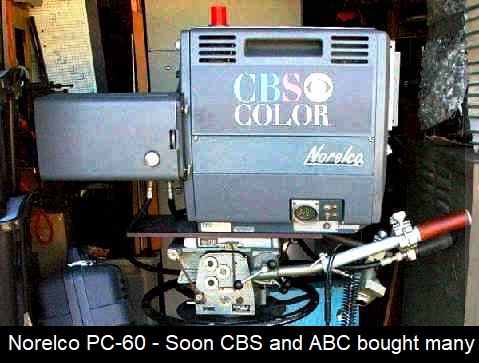
Not RCA
As we already mentioned, in 1962 a CBS official said that "We'll go into color when there's enough audience or sponsor demand for it." The New York Times said that CBS was "The main barrier to greater color programming." CBS put the onus on the advertiser. They would only broadcast a show in color if the advertiser would help cover the added costs. With one network fully color by 1965, sponsors, both local and national, started to see the benefits of sponsoring color shows. In 1958 there were 350,000 color sets in the U.S. when RCA/NBC started their marketing push. By 1960 that number was 500,000.
Now you might wonder why not just spend the money and bite the bullet and produce shows in color. Money! Cameras, along with other high end gear was not cheap. High end cameras were pushing $70,000. That is in 1960 dollars. That would be over half a million today. Not only that but often a lot of the processing equipment that was between the camera and the viewer had to be replaced. ABC and CBS had already spent many millions of dollars each to do black and white television.
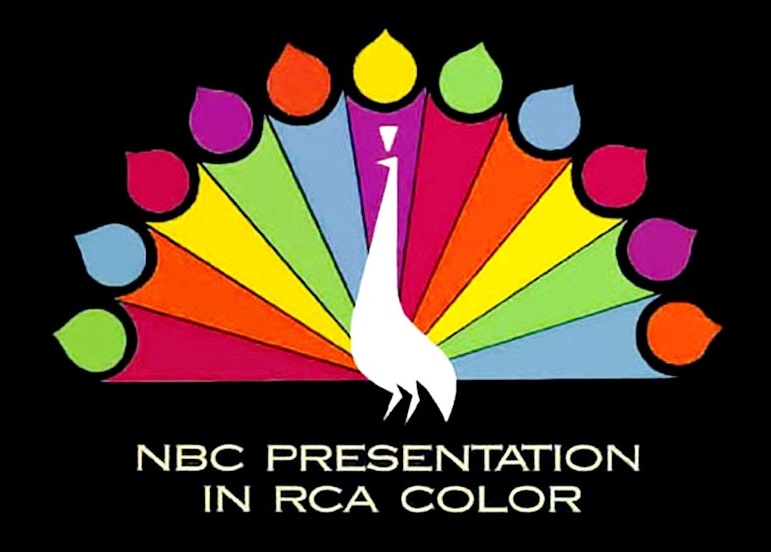
 None-the-less 1965 seemed to be a tipping point for color. At the start of the year there were just under 3,000,000 color TV sets in the U.S., which was almost double the number the year before. By the end of the year the number stood at 4,500,000. NBC claimed, as others agreed, that their color programming gave them a rating advantage. Many who had color TVs tended to view a show that was aired in color over one that was not. All but two shows on NBC were aired in color, one show used extensive black and white stock footage, and the other, "I Dream of Jeannie," had extensive special effects for the time that was considered too expensive to do in color. At the beginning of 1965 CBS had three programs per week in color, and ABC, was actually ahead with about eight programs a week. By the end of that year CBS surpassed ABC with 50% of their programming in color, to ABC's one-third.
None-the-less 1965 seemed to be a tipping point for color. At the start of the year there were just under 3,000,000 color TV sets in the U.S., which was almost double the number the year before. By the end of the year the number stood at 4,500,000. NBC claimed, as others agreed, that their color programming gave them a rating advantage. Many who had color TVs tended to view a show that was aired in color over one that was not. All but two shows on NBC were aired in color, one show used extensive black and white stock footage, and the other, "I Dream of Jeannie," had extensive special effects for the time that was considered too expensive to do in color. At the beginning of 1965 CBS had three programs per week in color, and ABC, was actually ahead with about eight programs a week. By the end of that year CBS surpassed ABC with 50% of their programming in color, to ABC's one-third.
It was clear that color TV was reaching critical mass, and both ABC and CBS announced before 1965 had ended that they both would be all color by 1967. Good thing, because by then color sets were just under 10,000,000. The next year 25% of all households had color sets. By 1969 the number of color sets had doubled the 1967 number. By 1971 there were almost 30 million sets in roughly one-half of American households. The decade of the 60s saw over a 50 fold increase in color sets.
It is apropos that finally going to color in New York City, caused the most chaos for the network that fought color the hardest, CBS. CBS had their four original main television studios in the upper reaches of Grand Central Station. But they also had other studios spread around Manhattan. The conversion to color prompted many studios to have to move. CBS did not have a Rockefeller Center like NBC, where it was able to centralize its network operations. CBS cobbled their television facilities together all across town.
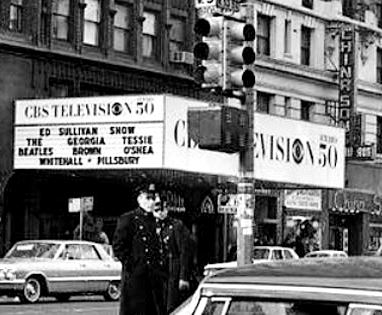
When they got serious about television, CBS had to scramble to find suitable facilities. They turned to available Broadway and movie theaters for use as television venues. Probably their most storied studio was Ed Sullivan's, internally known as Studio 50. That studio hosted three iconic shows, Jackie Gleason, Ed Sullivan, and then David Letterman. Each show came and went, and CBS seemed to forget about the facility, and then rediscover it again for a new show. Some claim that venue might have seen more stars over the decades than any other place. It now hosts Stephan Colbert's "Late Show." In 1965 CBS converted this studio to color. The third studio CBS had in New York to go color, which happened when Ed Sullivan's show was the main tenant. Over the years almost 30 television shows came out of this studio.
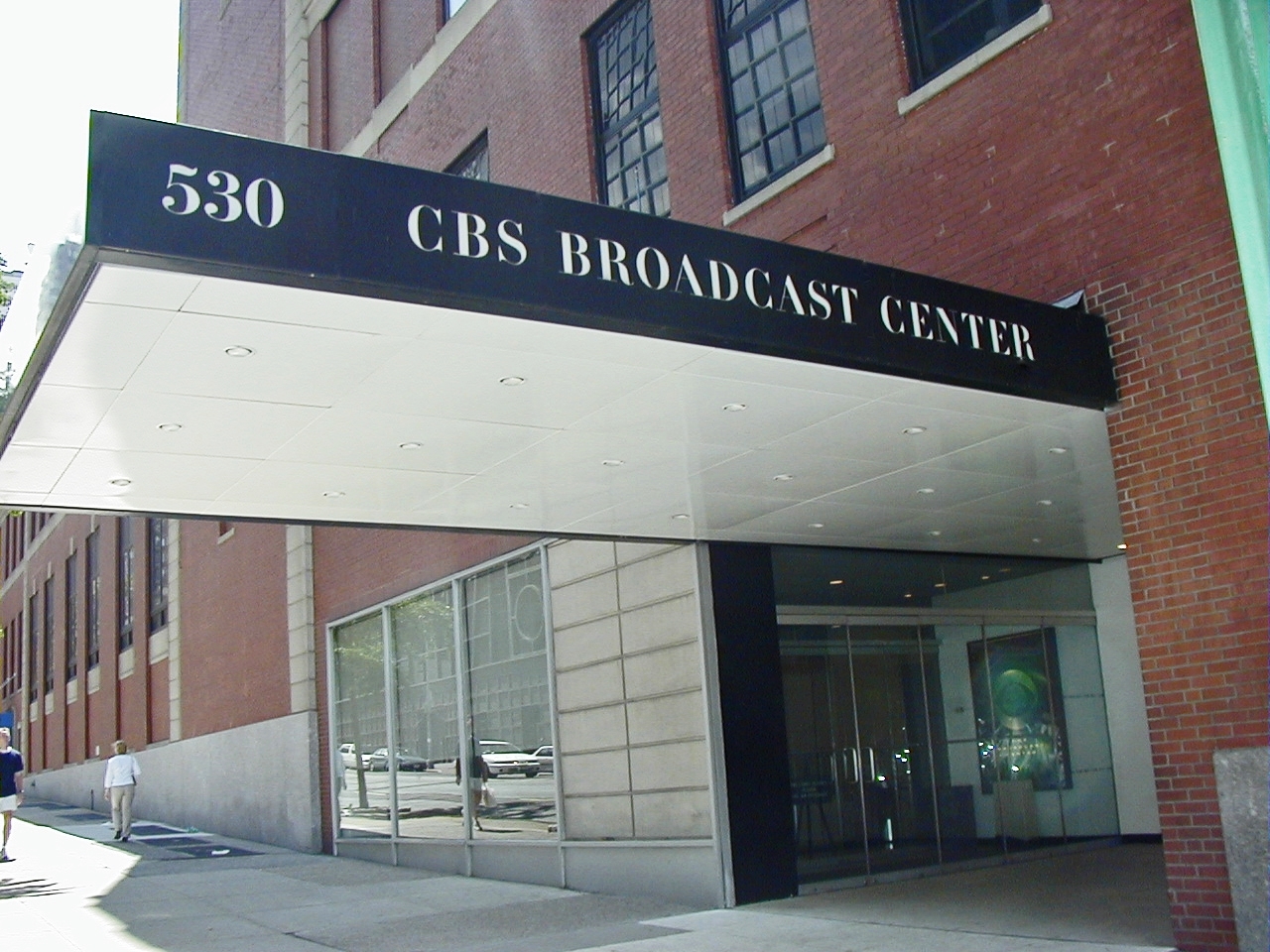
In all, besides the CBS Broadcast Center on 52nd street, CBS had over a dozen studios spread throughout Manhattan. When the Dumont Network went dark CBS leased some of their facilities. As they scrambled to "go color," and still maintain their programming schedule, plus the fact that color equipment was far more expensive than black and white, it made sense to centralize. While it was hoped that CBS could duplicate what NBC had at Rockefeller Center, CBS could never quite fit what they needed as a network into their Broadcast Center, where they managed to cram five moderately sized studios for the network, and one for their local WCBS station, the largest just over 8000 square feet. So, shows continue, to this day, to be produced in locations remote from their network center. The CBS Broadcast Center has a reputation for being a cold, drab, cluttered, and essentially "hard" facility, as space was continually reallocated as needs changed and the size of the facility could not be enlarge due to where it is located, although they were able to add a sixth studio in recent years.
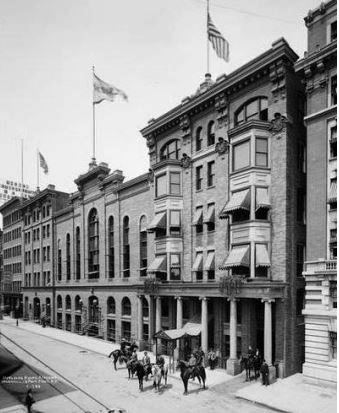
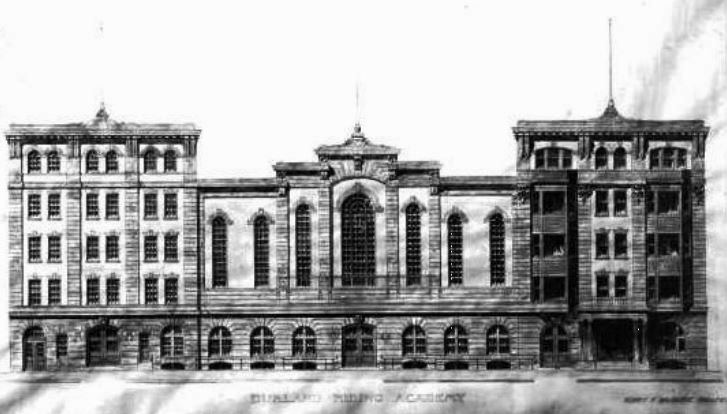
Buildings on W66th St before ABC
The row of buildings shown here were built in the late 1800s. The center building was a riding academy. That open indoor space became ABC's first two network studios.
When ABC started their TV network in April of 1948 they were co-located with NBC. This was owing to the fact that the network had been sprung out of NBC's Blue radio network, so they still had use of NBC studios, and even had office space at 30 Rock. In fact, their original address for ABC was 30 Rockefeller Plaza. They soon moved to 77 66th Ave, about 16 blocks uptown from the Rock. The first building they took over was a riding academy which had a large indoor arena. That space became ABC's first two television studios. Soon ABC had taken over the St. Nicholas Ice Skating Arena next store and converted it to studios. It had started as a skating rink in 1896 and eventually evolved into a boxing venue. Over the years ABC slowly spread over a few blocks along 66th. Much like CBS, but not as spread out. Over the years ABC had nine remote television venues that ranged from West 44th St. to West 77th. They currently have ten studios within a few blocks of each other along 66th, with six in their 77 66th main facility. Their only real remote location today is their Times Square Good Morning America facility.
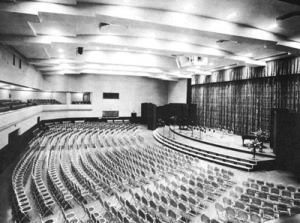
NBC's famed Rockefeller Studio 8H as a radio studio
As a radio studio it hosted Arturo Toscanini who led NBC's symphony orchestra, which performed regularly for the network, and performed for many of those years from 8H. RCA president David Sarnoff had persuaded Toscanini to head up the NBC orchestra, believing the radio medium needed to improve its commitment to cultural and artistic programming. From 1937 to his retirement in 1954 Toscanini headed up the orchestra. As a radio studio Fred Allen hosted his series from 8H.
As a television studio before SNL took up residence NBC News based special events coverage, such as election nights, and space mission coverage from this big studio. In the early days of television, NBC would air live drama and musical programs from there.
But there is no doubt who owns the studio now. There's an elaborate SNL permanent set, and the corridors are lined with photos of previous hosts and cast members, and Lorne Michaels has a ninth-floor office with a glass window overlooking the studio.
Whereas NBC was heavily centralized at 30 Rock, and thus could share central needed infrastructure over many shows, the other two not so much. This was another reason why they were not excited about investing in color early on. Not to say that NBC did not have remote venues, especially during the transition from going radio centric to TV centric. The first NBC color facility was at the Colonial Theater. NBC even had a couple facilities across the East River in Brooklyn. Over the years NBC had a dozen remote venues. But its central core at 30 Rock has had eleven studios within it, spread out over five floors, including famed studio 8H built in the early 30s as a 1200 seat radio studio which was the world's largest. When it was converted to television in the early 50s, it was reduced in size to add TV control rooms and make room for other necessary equipment. It has hosted Saturday Night Live since 1975.
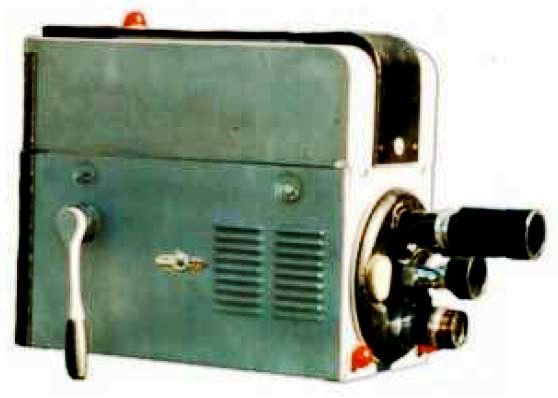
Marconi
In 1948 Marconi licensed RCA's TK-31 and manufactured it

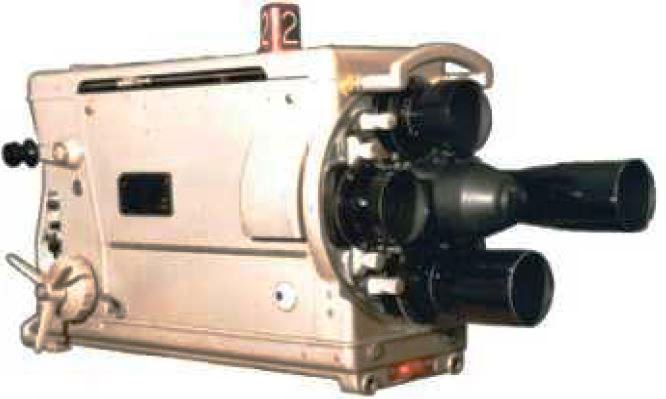
Marconi's first cameras of their own design - both a black and white one
Camera on the left was introduced in 1953. The large focus handle on the side was known as a "beer handle."
The Mark IV on the right. CBS liked these as they did not say RCA on the side.
There were other companies working on color equipment. Marconi, the same company that was forced to divest their U.S. operations in 1919 into what became RCA had licensed the rights to Marconi to build their own version of the RCA's TK-30, and in 1962 licensed RCA's TK-41 design. Marconi made some changes as solid state transistors where on the market and so they replaced some tube circuitry with transistors. The company totally redesigned the cameras viewfinder, making it smaller and lighter. The camera was known as the BD-848. This was the first color, or colour as the British spell it, camera which the BBC started using in 1966.

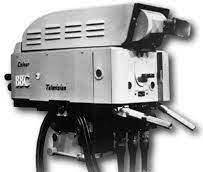
Marconi Color Cameras
Camera on the left is an RCA licensed and Marconi built version of the TK-41.
The one on the right is a Marconi's much improved version of the TK-41, now with many solid state parts. This camera was introduced in 1962.
The next major camera from Marconi was the Mark VII color camera which launched in 1965 and CBS began to buy these too in 1967. Like RCA's TK-42/43 it also used four pickup tubes. But there was a large technological advancement in the tubes used. These tubes were much smaller, the target only being 30mm in diameter, and still they were more sensitive than tubes that were four times larger. These new tubes eliminated a major problem that Orthicon tubes had.
If the Orthicon tube looked at a bright static scene it would burn that image into the target. The camera would then have to stare at a white object for a while to eliminate the burned image. A Rube Goldberg solution early on was to offer an option, called an orbiter, which would slowly move all the tubes in a small "orbit" slowly. With the orbiter on you would see the video minutely move in a circle.
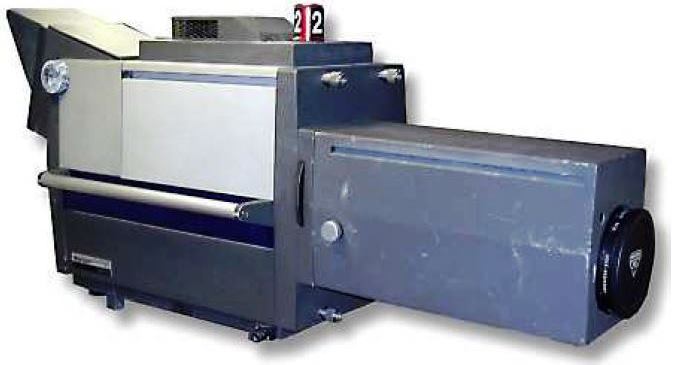
Four tube 3rd Generation Marconi Camera
This camera has an interesting prism system, where most of it could be swung out of the way so only the luminance or black or white tube would receive light from the lens. This allowed the camera to be much more sensitive in producing non-color video as all the light went to a single tube, and not divided among four tubes.
This camera also used the same smaller and more sensitive tubes as the Norelco did. The first 13 cameras that the BBC received to start their color service were these. CBS also ordered a batch of them.
The first color cameras installed in the Ed Sullivan Theatre and several other CBS broadcast centers were Marconi Mark VIIs. The production company that produced Sesame Street also used Marconi Mark VIIs. ABC bought some Marconi Mark IV black and white cameras for the 1964 Winter Olympics in Innsbruck, and for other remote productions. The CBC also launched color using Marconi.
Marconi continued to offer cameras into the 80s. Often their later camera head designs bordered on very interesting or odd, depending on one's taste.
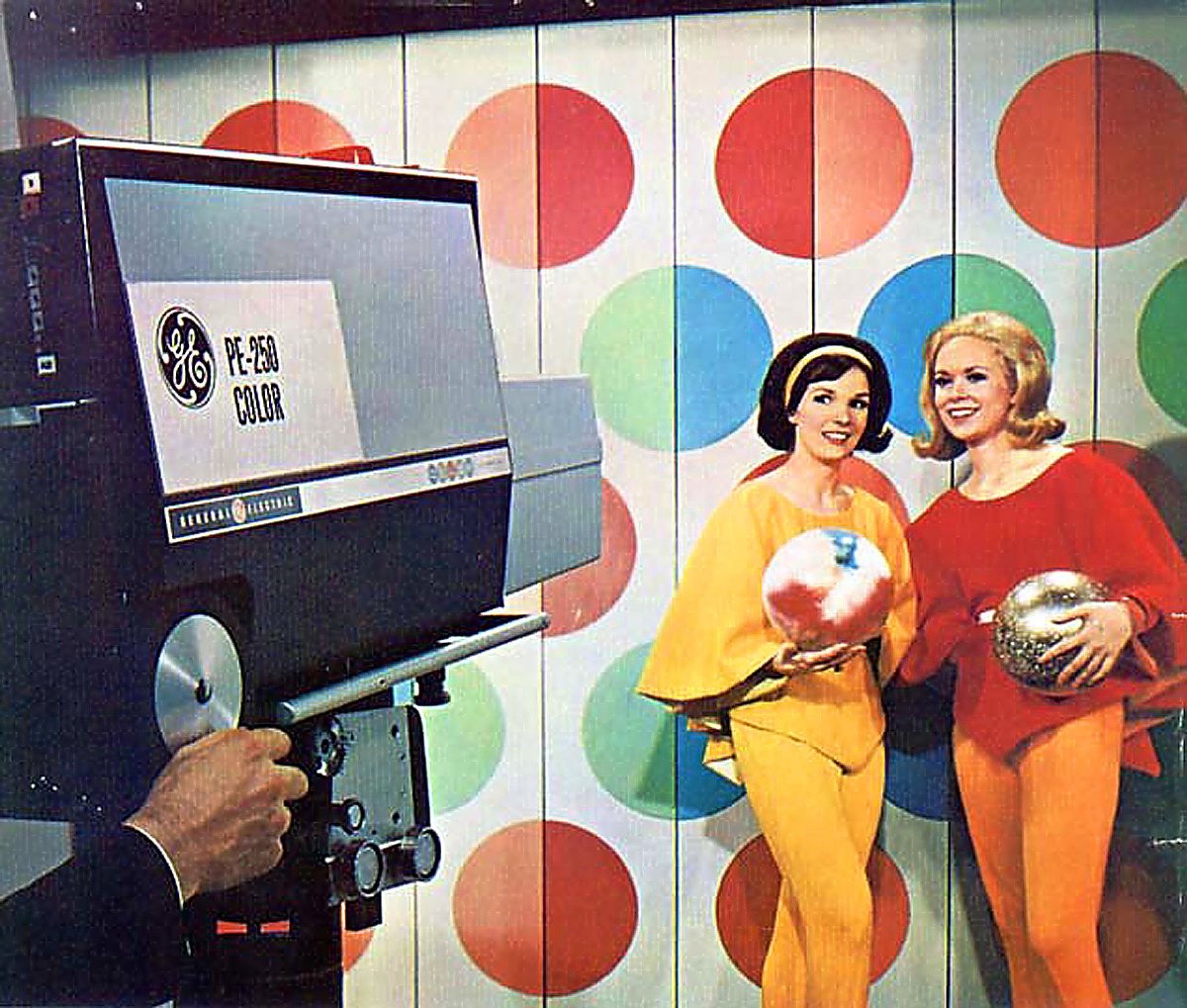
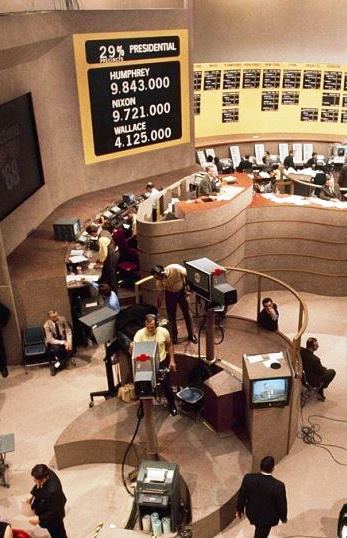
GE
ABC used the PE250 in their NYC studios
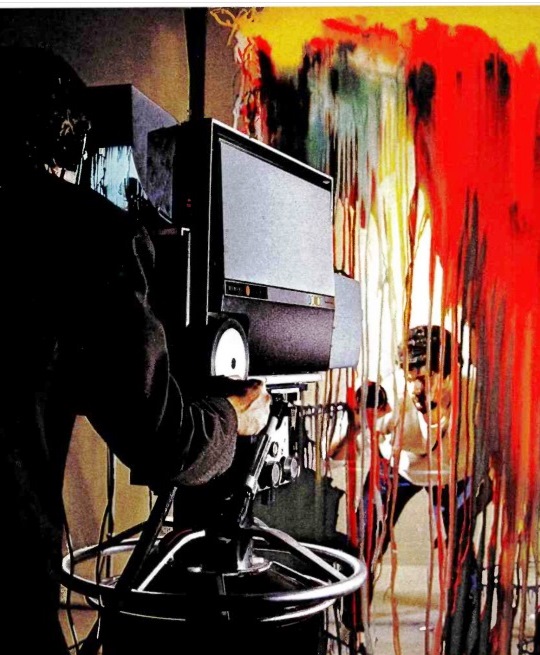
GE, which once controlled RCA started selling cameras also. Some of ABC's first cameras were GE black and whites. Those cameras were actually built by Dumont, who never built a color camera. By the end of 1953 GE was working on a color camera of their own design, which they started offering in the mid-50s as the PC-15. This was a three pickup tube image orthicon camera, looked about the size of an RCA TK-41 but was 150 pounds lighter than either the TK-41, or the TK-42/43 for that matter. GE's second generation color offering was introduced in 1965, the PC-25. By 1968 their third generation of cameras hit the market. The PE-250 and PE-350s shown here.
All GE's designs used four pickup tubes. But again, the pickup tubes were of newer design, which made them smaller and more sensitive at the same time. A problem that these cameras had was they used a set of dichroic glass for the color separation that allowed less light to get to the tubes and could minutely move with temperature changes or rough handle leading to color registration issues. While ABC was the only network to put them in service, many local stations and a company that specialized in covering sporting events, Sports Network, later Hughes Sports Network, bought a couple dozen.
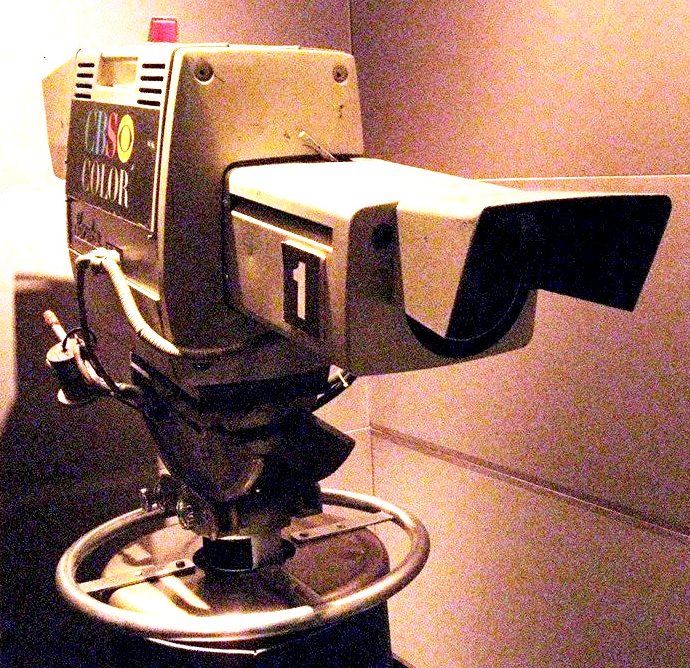
The Norelco Revolution
We mentioned that a couple cameras were using new, better pickup tubes by the middle 60s. The tubes had a number of different names, mainly for marketing and refinements made by the vendors of those tubes to get around patent infringement. The most common name was the Plumbicon. In the early 1960s, an experimental color broadcast camera using three of these new Plumbicon tubes, was being developed by the Philips Company in Holland. The Plumbicon's target was lead based and was referred to as a lead oxide tube. The periodic symbol for lead is Pb, hence the name. Field testing on the new camera went on at the BBC in London. By 1963 the Philips Experimental color camera, was in comparison tests with the Marconi camera.
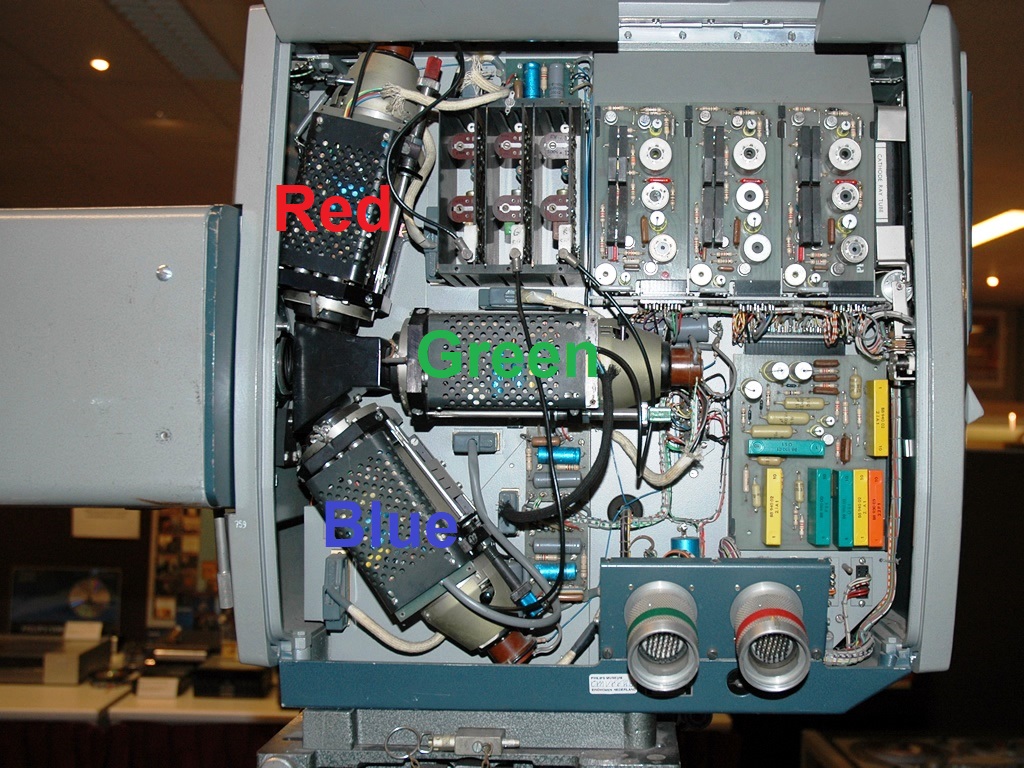
Three Tube Norelco PC-60
Here is the camera head opened up. The three much smaller, but more sensitive, imaging tubes can be seen on the left. The camera head is now well under one hundred pounds. Still, to keep the head as small and light as possible only the electronics to support the imaging tubes, along with intercom and return video for the viewfinder is in the head.
A drawback to the PC-60 is that it required two fairly thick camera cables to connect it to the rest of the camera chain. Notice the two large connectors in the lower right. The PC-70 was down to a single connector.
The first model out was the PC-60 in 1964. PC stood for Plumbicon Color. 60 stood for the year the Plumbicon was invented. In the U.S., the camera was sold under the Norelco brand. Yes, the same folks who sell electric razors. An early pioneer in television, Philco, in 1940 claimed that Philips name was too similar to theirs, and got the FTC to block any products from having the Philips name on it in the U.S. So they set up a subsidiary called North American Electronics, or Norelco for short. So everywhere else except the U.S., when the Norelco PC-60 launched, it was known as the LDK-1. LDK is the Dutch abbreviation of the lead oxide tube. Finally, in 1981 Philips acquired GTE, who had acquired Philco from Ford Motor. Ford had bought Philco in 1961. Philips could now brand itself Philips everywhere.
Philips will continue to play a major role in our story about Grass Valley

. Philips has a storied history. They developed the first-ever dry shaver in the 1950s, the audio cassette tape in the 60s, the first video cassette recorder intended for the home in 1972, and even were instrumental, along with Sony, in bringing the compact disc to market. As we will see later in the book, Sony had a major impact on the Group also.
The Plumbicon tube developed by Philips was manufactured by Philips subsidiary Amperex Electronics in Slaterville, Rhode Island. The plumbicon tube earned Philips an Emmy in 1967 for "Outstanding Achievement in Engineering Development."
The smaller plumbicon tubes allowed for a smaller prism and optics overall. The camera tubes and solid state electronics made the pictures less noisy. Plus, the camera head ran much cooler.
While CBS acquired Marconi color cameras, they went all out when the PC-60, soon followed by the PC-70. On October 31, 1965, the Ed Sullivan started normal weekly colorcasts using Norelco PC60s.

The PC-60 and PC-70 series were very popular cameras, and all the major networks and countless local stations used them. However, perhaps the most well-known customer was CBS, which eagerly now bought Norelco's in its effort to become a color network. Even before the PC 60s were debuted at the 1964 NAB show, CBS had already placed an initial order for 36 units, and a secondary order for 36 more on an as needed basis.
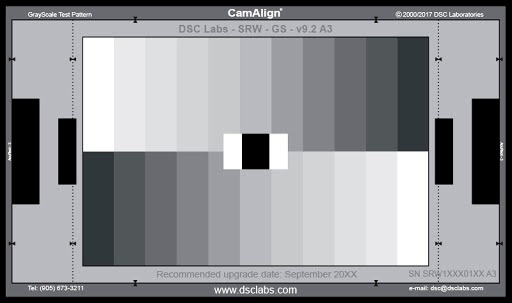
Just as we said there was an NBC "Blue," well there was a CBS "Gray." It was based on a test card developed by Kodak that was used in photography. The card had a large gray patch, along with white and black patches. The gray patch was halfway between the values of the white and black patches. This was used as a reference when setting up a film camera. Television used charts that had nine vertical strips that went from white to black with seven shades of gray in between. A person setting up the camera would know normally to set the levels so that the middle strip was half-way between black and white levels. CBS painted their cameras with a gray that matched the middle strip.
Some had speculated that was done so that the production and technical crew could quickly shoot a camera with another and see if the camera showed up as the proper shade of gray. Actually, CBS liked to often run the shades of gray lower than normal to give some shows, like soaps, a darker look.
Dr. Frank Stanton, who was the long time VP of Engineering at CBS had ordered for all cameras as far back as the TK30s to be painted CBS Gray, even the chromed Norelco logo on the new cameras was painted gray. But at least the Norelco name plate was left on the cameras. RCA logos on equipment that CBS owned were always taken off.
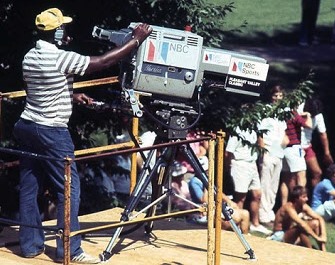
Even NBC ended up buying Norelco cameras for their field trucks. NBC never liked their parents TK-42/43. RCA was working on competition for Norelco, the TK44, which would be quite similar to the PC-70, but development was behind schedule. So, with an aging fleet of TK41s in the field, NBC "jumped the shark" and ordered 35 Norelco's but requested a few modifications.
One of the first events NBC deployed the Norelco's on was the world series. While the main cameras were Norelco, there were still a few TK-41s in use. It is claimed that Philips executives in attendance were especially impressed with the shots from a couple of the cameras, which turned out to be TK-41s. While the TK-41s were old technology, at least compared to the Norelco's, with Orthicon pickup tubes, compared to the much improved Plumbicon tubes, the RCA tubes where larger in size and thus while they had the image burning issue, and were less sensitive, in the outdoors with lots of light their pictures in some instances looked better than the Norelco's.
RCA had one other advantage, the optics that split up the light into three colors tend to favor the reds more than the competitors' cameras. This made the video look warmer, and more pleasing on the eyes. Later competitors were soon designing, or at least offering as an option, cameras that mimicked the RCA color look. The optics that splits the incoming light into the separate colors, to this day, does not cleanly separate the colors. The red part of the spectrum overlaps the green, which overlaps the blue parts of the spectrum. For a long time, there were a few color tints that television cameras could never get quite right. The magenta uniforms of the Minnesota Vikings are a well-known example.
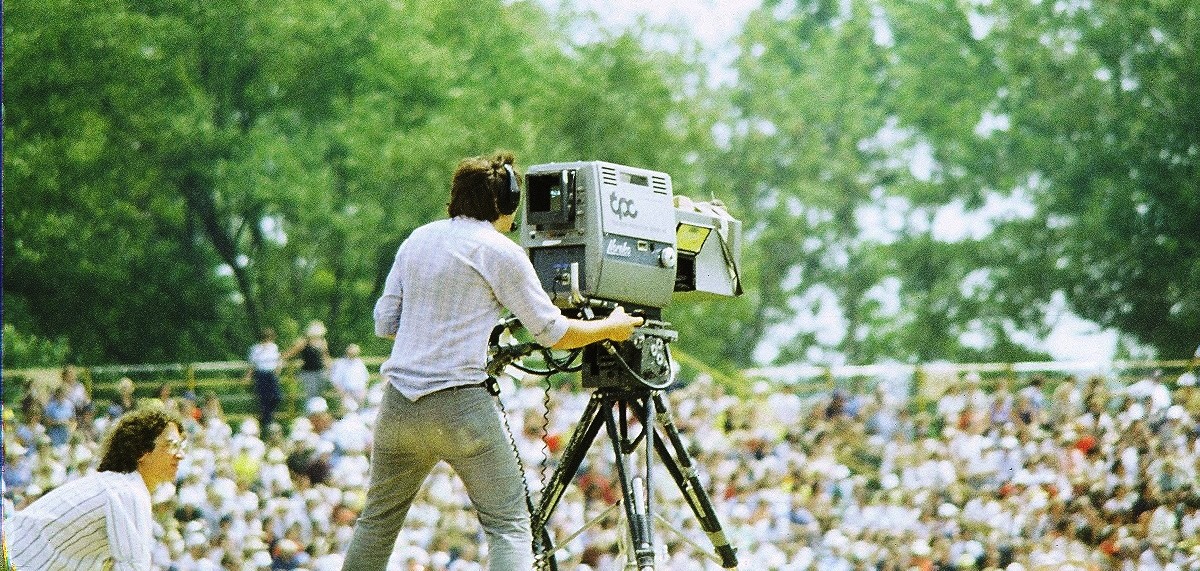
A process called painting developed among people who set up color cameras, where they would tweak each color's white, black, and gray levels, along with a myriad of other adjustments to get a banana brilliantly yellow, or an apple deeply red. More often it was used to make the talent and producers happy with the way they looked on air. The drawback was if the apple was made exceptionally red, or a person to look goldenly tanned, you would compromise by not quite getting some other color tints correct. Today the processing ability of cameras, video wise, but also memory, and computer processing wise allows an experienced camera setup operator to hit all the required spots on the color wheel. But it would not be until the mid-70s that a microprocessor found itself inside a television camera.
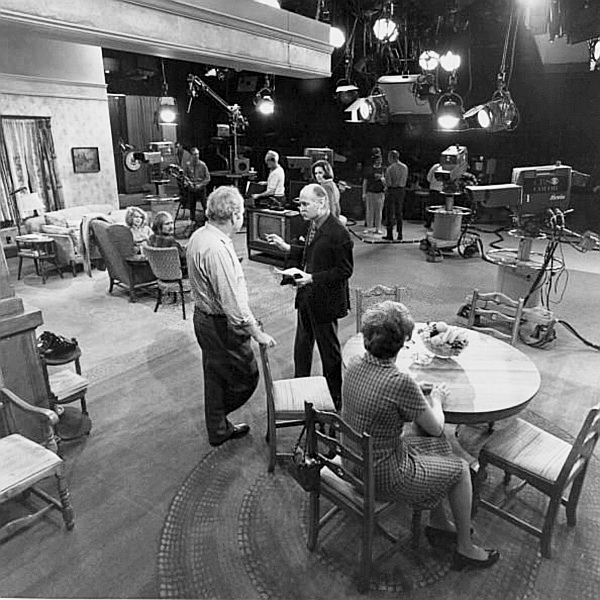
All in the Family
It is claimed that this is the first sitcom which was shot using the now standard three television camera approach, instead of using film cameras. Yes there are four cameras on the set - one most likely for ancillary duty, like shooting the whole set or to capture art cards as this was before there was computer animation. It was shot at CBS's Television City.
While the director would switch between cameras while they were recorded, each camera would also be iso recorded. Not a simple task in the early 70s, as we will see shortly as video tape recorders were also a precious commodity.
Originally shot before a live audience, it eventually was shot without a live audience. The laugh track would be obtained by letting an audience in to see another show watch a preview of the show in a studio where their reactions would be recorded and added to the audio track.
Norelco could not keep up with demand, so they also started building them in Mt. Vernon NY. There were a few specially modified PC-70s, called PC-71s that were built and were made with special mu-metal shielding for the insane electromagnetic problems caused by a huge DC subway transformer behind the back wall of the stage at The Ed Sullivan Theater.
Originally ABC was using RCA TK-41s for remote production. By 1968 when they covered the U.S. Open half of the two dozen cameras employed were now PC-70s.
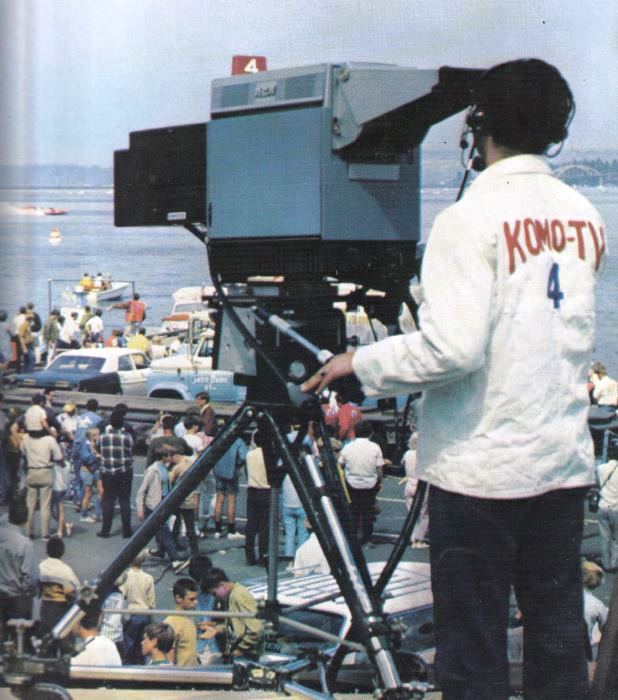
RCA TK44
 The first four shipped
The first four shipped
RCA's response to the Norelco's was the TK-44. The original was still going to be a four tube camera. Up until Norelco everyone else had four-tube designs, with a separate luminance channel. This was because there was still a large monochrome viewing audience and so in many ways that audience was still the dominant viewer. But in response to NBC's and RCA's reverse engineering of the Norelco's when the TK-44A was introduced in 1968 it was also a three tube camera.
The top brass at RCA did not have any idea that engineering was working on a 3-tube Camera. But upper management did finally face the fact that RCA had to walk away from the whole TK-42/43 approach and that it was time for something new. Larry Thorpe, Lou Bazin, Harry Wright, and Fred Himelfarb were the engineering team that worked under Norm Hobson. For a while this was a true skunkworks project.

TK-43 left - TK-44 Right
For a couple years RCA top brass held out hope that both cameras could sell side by side. In fact this graphic was from an NAB where they actually stated that the two cameras allowed the best of both worlds. That campaign did not last long.
RCA got a big break when Amperex, located in Rhode Island, which was another Philips subsidiary, and the US source for the new Plumbicon tubes and yokes that were in the Norelco's, invited the TK-44 team to come and look at the possibilities of using their tubes in RCA cameras. While Philips would not have approved, Amperex wanted to sell tubes, even if it was to RCA. RCA ended up using not only Amperex Plumbicon tubes, but also the yokes (component that controls the tubes scanning of its target), and the small prism that Philips was using.
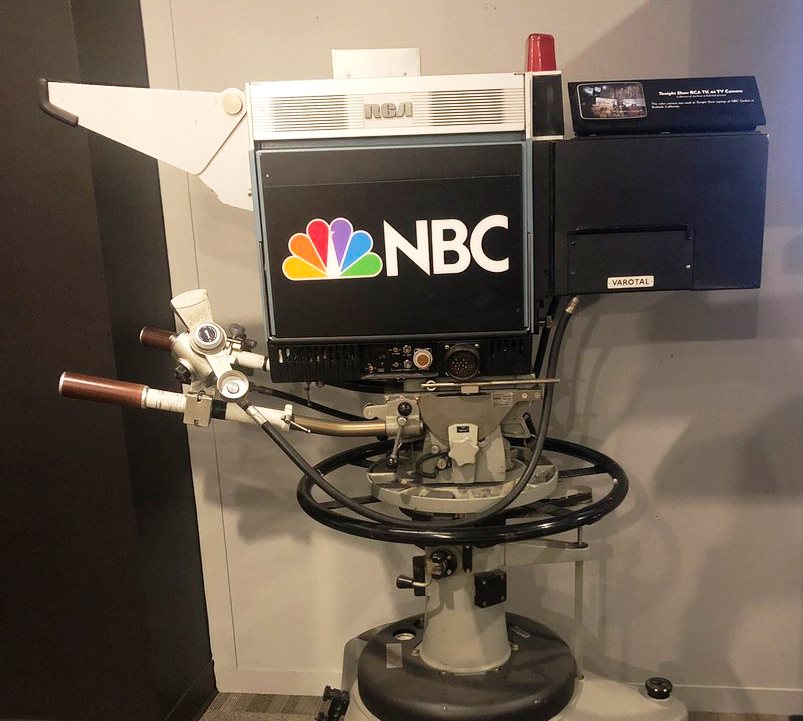
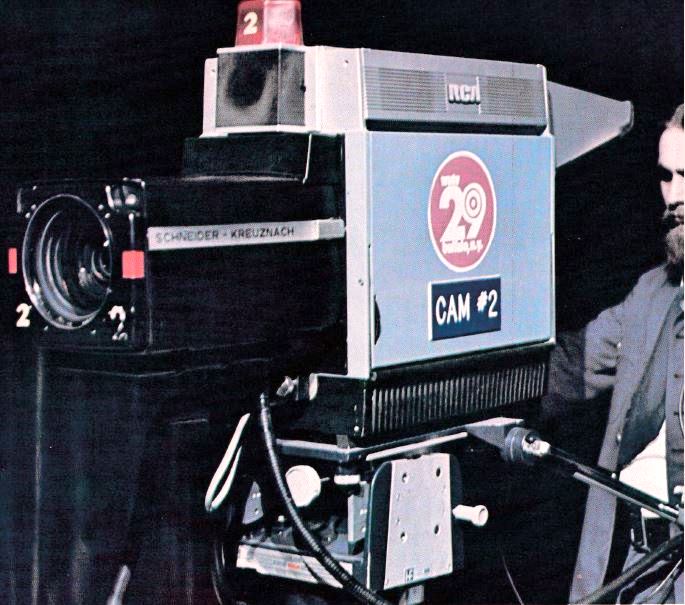
While RCA and others were also working on lead oxide targets for tubes, only Amperex was able at that time to produce a stable imaging target in quantities. The design was later licensed to a number of companies, including RCA. WBAP in Dallas received the first TK-44s, which shipped in early 1968. Eventually almost 800 were sold. RCA used the camera throughout the network, although never on remote production. Many claimed that the TK44As made better pictures than the Norelco and were much more stable when it came to temperature changes, in part by circuit design, but also better power supplies. The camera also automatically adjusted frequency compensations based on the length of the cable run. The TK-44 family lived on for many years as the upgraded TK-45/46.
 RCA Engineering Lab
RCA Engineering Lab
1969 NAB - TK-42 on left, TK-44 right
KOMO Seattle boat races
Saturday Night Live - 1975
KBHK, San Francisco
We looked at this facility earlier as it was originally NBC Radio City on the west coast.
David Letterman having fun with a TK-44
Before we move on off cameras another NBC observation. RCA over its lifetime had many technological triumphs and breakthroughs. Throughout its existence its engineering prowess was legendary. As we have seen it almost single handedly got color TV into the home. It provided equipment across the full spectrum of a broadcasters needs. Even in the 70s and 80s it pushed the envelope when it came to technology. It incorporated the first microprocessors into cameras. It demonstrated the first practical camera without pickup tubes, introducing CCDs in their place in 1984.

RCA TK-47: Introduced in 1978, first camera with a microprocessor. Automatic setup.
 Won an Emmy
Won an Emmy
E.J. Stewart TK-47 (as is the photo above)
Sesame Street
TK-44s being replaced by TK-47s at NBC
CNN
The first batch that CNN ever ordered, never made it to them. They were stolen!
David Lettermen's camera night show - Lots of TK-47s
 RCA first CCD camera
RCA first CCD camera
At the political conventions
Won another Emmy
Beauty shot
While their engineering was usually solid, their manufacturing and QA was spotty. Often equipment would be delivered to a customer that did not work out of the box and required an RCA service call. Thankfully, the company had stellar engineering and service support. Often cold solder joints, mechanically compromised assembly, and often just poor packing stressed the integrity of newly delivered gear. RCA had too much momentum to correct those errors quickly. The world was changing, and spunky little companies like "The Group,"
 but also the Japanese, where changing expectations. Whereas RCA would produce spectacular engineering achievements, their gigantic brooding bureaucracy took years to get from an idea and into a box for shipping. Over the course of their existence most of their engineering milestones took a decade from concept to installation.
but also the Japanese, where changing expectations. Whereas RCA would produce spectacular engineering achievements, their gigantic brooding bureaucracy took years to get from an idea and into a box for shipping. Over the course of their existence most of their engineering milestones took a decade from concept to installation.
General Electric announced in December 1985 that it would reacquire its former subsidiary, for $6.28 billion in cash, and the sale was completed the next year. Originally GE claimed that it would leave RCA intact. But in 1986 GE's real motivation came to light. It had purchased RCA to acquire NBC. GE proceeded to sell off most of the other RCA assets. In 2011 it sold off NBC Universal. NBC Universal was formed in 2004 when Universal decided to sell an 80% stake to NBC's parent company GE.
As we will see in the book the question of how a small startup could go head-to-head with a juggernaut like RCA was exemplified when Dr. Hare was asked by ABC if his company could produce something called a "Proc Amp," with Dr. Hare's response being "what the hell is a proc amp?" Then in less than ten days demonstrating one that was even buttoned up in a chassis. As we will also see later, it is hard for a company to keep as nimble and responsive as the "Group" was when they were hungry.
Recording

Up until the invention of video tape the only way to record television was with the device shown here; a Kinescope.
The hood on the top left of the box had a very bright CTR video display.
On the right is a film camera. Video was literally transferred to film.
There is one other milestone that we should touch on, the recording of video. Sarnoff in September of 1951 at his 45th anniversary ceremony held at the newly renamed Sarnoff labs asked his scientists for three things in the next five years:
- a true amplifier of light, which he called a "Magnalux"
- A "videograph" that would record B&W and color TV signals on magnetic tape
- An electronic air conditioner that would work on tubes or possibly electrons on solids. It should not have moving parts. He called it "Electronair"
While the first has been achieved using night vision type technologies, and number three is still an intriguing idea, we will address his second request.
Magnetic recording has been a quest since the end of the 19th century. While not magnetic, Edison had applied for a patent on his phonograph at the end of 1877. The era of audio recording had begun.
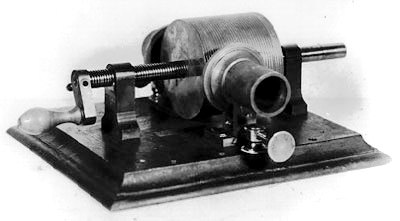
Audio Recording
Very early phonograph
In 1885 a patent was applied for which included a means for magnetic recording by causing phonographic records to produce changes in the magnetic field of a magnetic needle, thereby inducing electric currents in a coil converting those currents into sound waves. The next year a demonstration was conducted and written about. The article mentioned several different means of magnetic recording including an idea for a recording telephone using either a cord, string, thread, ribbon, chain, or wire which could become magnetized as it passed through a helix (coil) by means of hand, clockwork or other means. It would be played back in a similar manner.
By 1922 GE had invented a way to optically record sound on film. The "talkie" movie was made possible. In 1926 Warner Brothers Studios invented a way to record sound separately from the film on large phonographic disks and synchronized the sound and motion picture tracks upon playback, which was an improvement on Thomas Edison's work. The first film made using a separate disc was the "Jazz Singer." That same year GE made RCA responsible for their sound on film efforts. RCA struck a deal with Paramount to use sound optically recorded on film. The "talkie" (detractors called them squawkies) movie "Wings" was produced, it was released in 1927. The sound was still on a separate film.

Optical audio soundtrack laid down along the side of the film track
The soundtrack on a single film became known as Movietone and Fox Studios acquired the rights to it in 1927. That same year audio recording on magnetic tape had reached a point where the concept of magnetic tape bias was introduced. Here either DC or AC bias is added to the audio signal that is being laid down on tape. This increases the signal quality by pushing the signal into a more linear range of the magnetic oxide capture function.
On the optical film recording front, in October 1929, which was very bad timing as it was the eve of the Great Depression, Sarnoff got together with Joseph P Kennedy, the father of a future president, who had an independent production agency. RCA invested $400K into Kennedy's firm. Kennedy's firm had an informal but close relationship with the leading vaudeville chain at the time, Keith-Albee-Orpheum, which owned several hundred strategically located theaters. The obsolescing theatre chain was merged with Kennedy's firm to form Radio-Keith-Orpheum (RKO) movie studio. RKO used the GE/RCA audio system. The studio had a number of early movie successes. Kennedy sold out his interest in his old firm and took it as stock in RKO. Before long he sold his RKO stock for a substantial profit. RCA held about 25% of RKO's outstanding stock. The aggregate RCA investment came to $16 million. During the depression RKO suffered as did the other studios. RCA eventually sold half its interest for $5 million. When things got better it cashed out all its holdings in RKO and essentially recovered its investment.
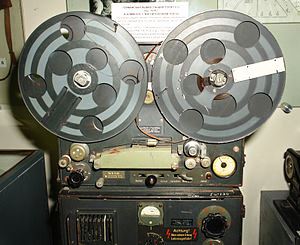
Audio Magnetic Tape Recording
Early German Audio Recorder
In 1928 Fritz Pfleumer developed, and in 1929 patented a magnetic recording tape using oxide bonded to a strip of paper or film. From then until the end of WWII the Germans led the way in audio tape recording development. The first reel-to-reel audio tape recorder was developed by the engineers of the German electronics company AEG in the 1930s. It was the world's first practical tape recorder, the K1, first demonstrated in Germany in 1935 at the Berlin Radio Show. It used a foil of cellulose acetate coated with a lacquer of iron oxide bound with additional cellulose acetate. About the same time the Blattnerphone steel band recorder was developed by the BBC. It never achieved the quality of the German tape recorder. In the late 30s Japan was also working on developing a wire recorder. The problem with wire recorders is that the machine needed to pass wire over the heads at high speed for decent quality, thus needing either enormous spools or very thin wire.
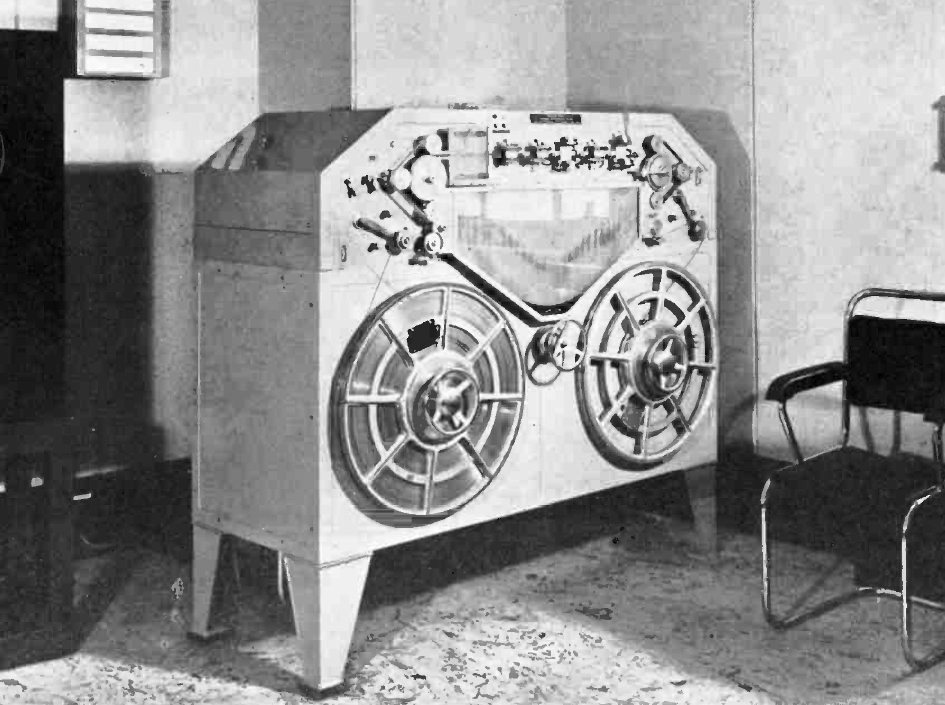
BBC's Blattnerphone steel band recorder
Towards the end of the war the Allies became aware of the German superiority in this technology, and a young technician from the Army Signal Corps, John T. "Jack" Mullin, was assigned to capture and analyze enemy radio equipment. He got his hands on a Magnetophone, and the U.S. went to work reverse engineering it.
At the same time Eisenhower ordered Major John Herbert Orr to use captured German scientists to set up an American tape manufacturing facility. When Orr was mustered out of the Army he eventually started a company that manufactured magnetic tape, in Opelika, Alabama. His company, ORRadio Industries, manufactured magnetic tape for the recording industry from 1950 to 1959, when he sold it to Ampex.
Ampex, as we will see in a bit, began producing magnetic tape and magnetic recorders. The German patent rights on the recorders had been seized by the U.S. Alien Property Custodian and thus the technology did not need to be licensed.
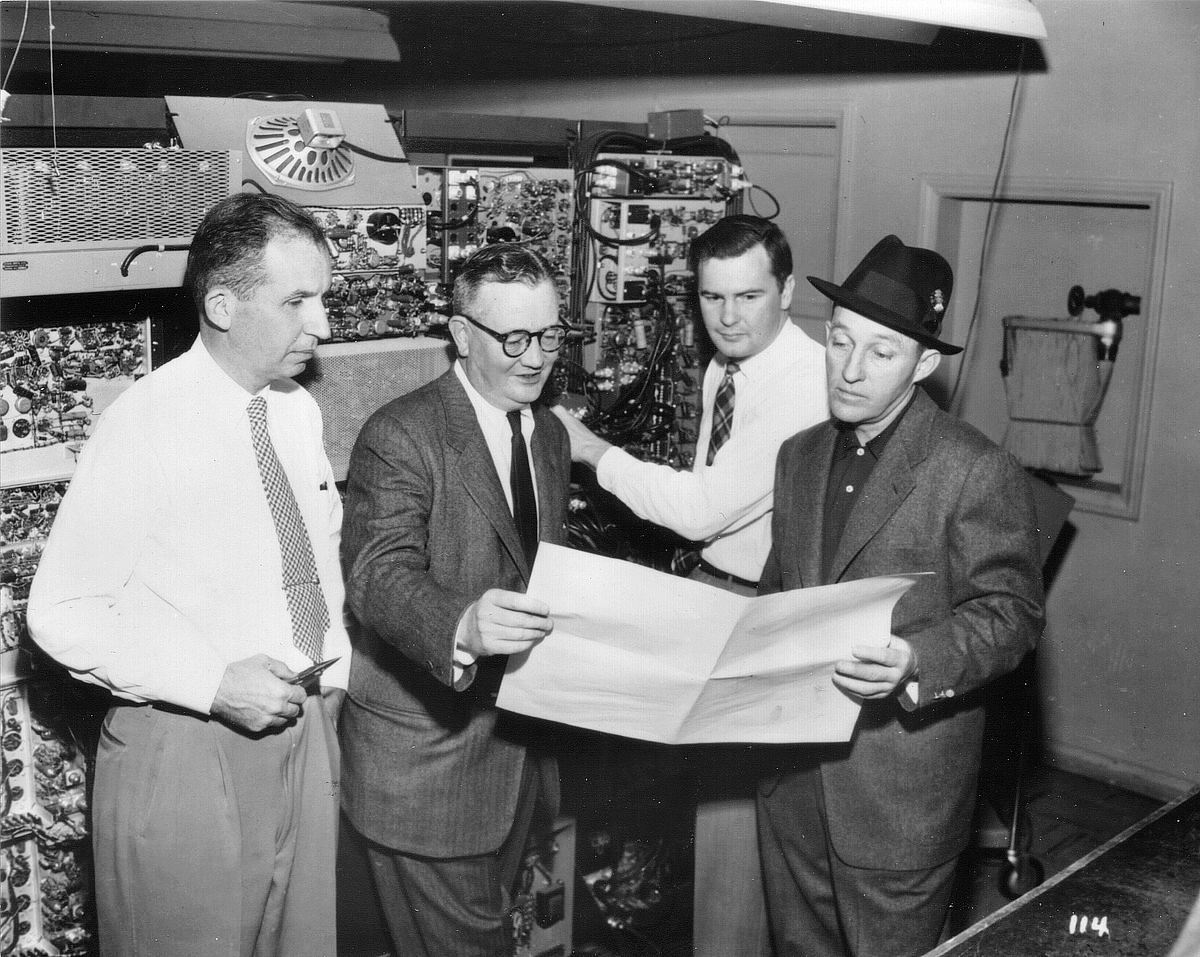
John T. "Jack" Mullin (left),
then John Herbert Orr,
and Bing Crosby (right)
The Crooner Bing Crosby, as we will see took a big interest in recording
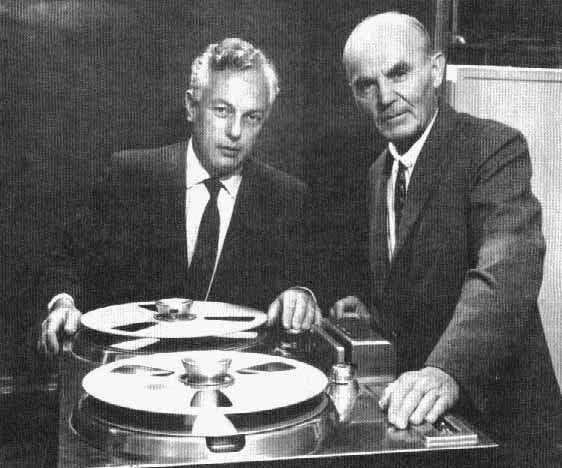
Alexander Poniatoff (Right) with his chief engineer, Harold Linsay
Ampex's first audio recorder - 1948
As we will see in the book also at this time Dr. Hare, the Grass Valley Group's founder, had gotten his hands on a captured Magnetophone and so technically competed with Ampex for a while. While Ampex itself had no direct impact on "The Group"

early on, it did influence the tech activity of the area, as we will also see in the book.
When Mullin got back to the states in 1946 he demonstrated the advanced Magnetophone to a meeting of the IRE in San Francisco, predecessor to the IEEE. There, according to Mullin's own account, it created quite a sensation. Word got back to Bing Crosby, who was a pioneer in the area of entertainer-as-entrepreneur, and a big star on radio at the time, he was receptive to the idea of pre-recording his radio programs. In the 40s with radio at its height, radio performers had to create their shows live, sometimes even doing the show a second time for the west coast, so Crosby had to do two live radio shows on the same day, three hours apart.
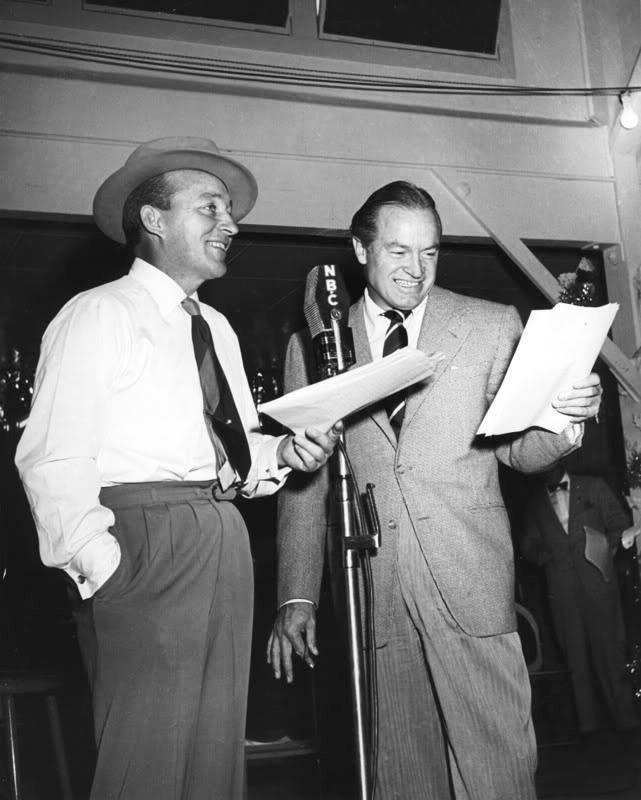
Crosby disliked the regimentation of live broadcasts and preferred the relaxed atmosphere of the recording studio. Also if he could do his show when he wanted, it would allow him more flexibility to work on his golf game. He was legendary for sneaking out of movie, and radio studios to get in a round. To accomplish that he ended up with the nickname "one take Crosby." Crosby liked golf so much that when he was entertaining at the infamous Cal-Neva Lodge on the north shore of Lake Tahoe, a little over an hour's drive from Grass Valley, in 1934 and 1935, he would invite his friends up to Tahoe to play golf at the nearby nine hole Brockway Golf course. They would play there every afternoon and then entertain at the Cal-Neva.
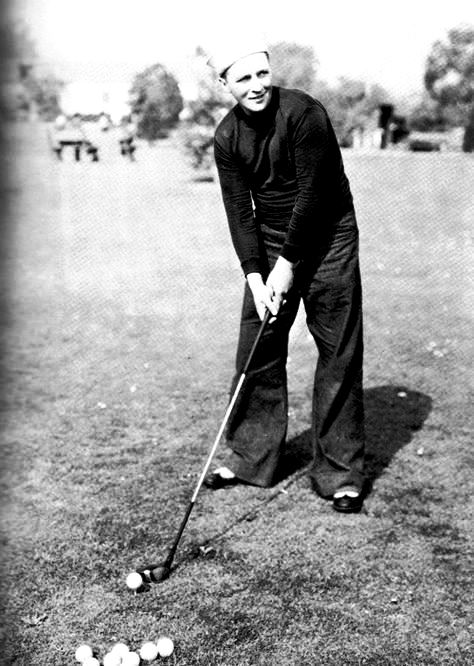
He hosted a little tournament during his summer stints at Tahoe that featured a clambake and a modest purse for the winner. The tournament soon became so popular they had to move it to the famed Pebble Beach, just south of Monterey, which morphed into the AT&T Open Pro-Am on the PGA Tour.
But it was not just Crosby that was drawn to the place. In 1960 Frank Sinatra bought the lodge and it played host to his "Rat Pack" buddies, celebrities, politicians, and other nefarious types. It is rumored that John Kennedy had numerous trysts there. Marylin Monroe's last weekend alive was spent there. Sinatra and his Rat Pack co-hearts, Sammy Davis Jr. and Dean Martin, played Brockway often during the 1950s while at the Cal-Neva. As did Joseph Kennedy, the father of President John F. Kennedy, and President Dwight Eisenhower once played the course also.
Map showing Brockway Golf course and the Nevada State line at Crystal Bay (where the Calneva was located)
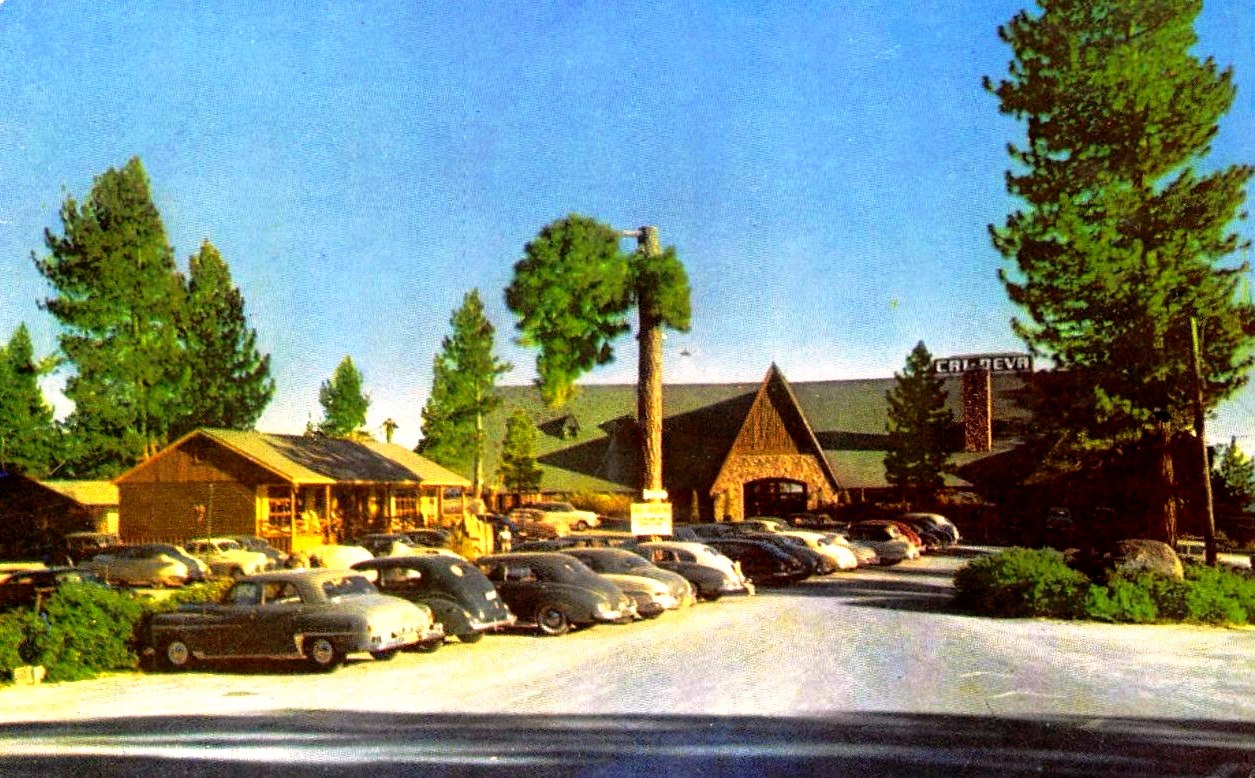
Cal-Neva Lodge early 60s
In 1937 Crosby moved the party down to Monterey, where he ended up buying a house on the 13th hole of Pebble Beach. It was now known as "Crosby's Clambake," the first Pebble Beach purse was $3,000 which came straight out of the singers' pocket. The idea was to pair pro golfers with some of the better amateurs on the West Coast as the golf tour made its rounds through the region.
For Crosby's 1944-45 radio season he asked NBC to let him pre-record on phonographic disks, which the network refused. The sponsors were adamantly opposed to the idea. Both the networks and sponsors argued that the public would not stand for 'canned' radio. Continuing the argument, they claimed that there was something magical for listeners because what they were hearing was being performed and heard everywhere, at that precise instant. Some of the best moments in comedy came when a line was blown, and the star had to rely on wit to rescue a bad situation. Fred Allen, Jack Benny, Phil Harris, and also Crosby were masters at this, and the networks were not about to give it up easily.
Crosby was not only fighting the network but the musicians' union and ASCAP (American Society of Composers, Authors, and Publishers), which wanted to ensure continued work for their members. So, Crosby withdrew from live radio for a year and returned for the 1946-47 season with the recently formed ABC Network, but only reluctantly. The new network gave him more latitude in how he produced his show.
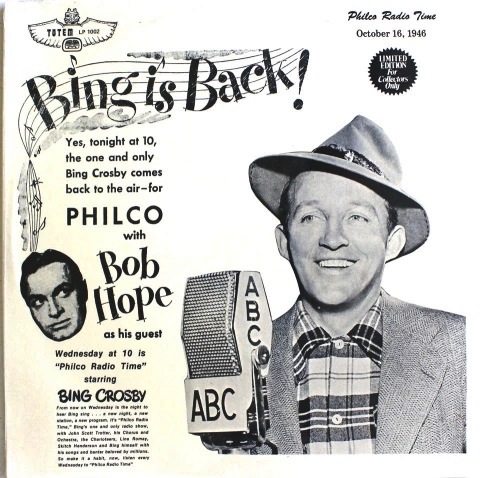
In June 1947, Mullin, was pitching the technology to the major Hollywood movie studios, and he got the chance to demonstrate his modified tape recorders to Crosby. Crosby immediately saw the enormous advantage in prerecording his radio shows on audio tape. The scheduling could now be done at the star's convenience, such as doing four weekly shows in the same week, if he chose, and then taking a month off.
Crosby commissioned Mullin to prepare a test recording of his radio show. Ampex was finishing its prototype of the Model 200 tape recorder, and Mullin used the first two models as soon as they were built. After a successful test broadcast, ABC agreed to allow Crosby to pre-record his shows on tape. Crosby immediately appointed Mullin as his chief engineer and placed an order for $50,000 worth of the new recorders so that Ampex, then a small six-man concern, could develop a commercial production model from the prototypes. Later that year Crosby's taped radio show premiered on ABC, which being a hungrier network at the time was willing to take a chance on the new technology to land Crosby on their network.
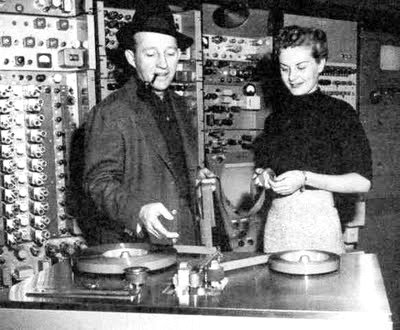
Audio Recorder Crosby used to record his show
Being able to record the show in advance changed how the production was done. By using tape, it could go past its allotted length, say thirty-five or forty-minutes, then edit it down to the twenty-six or twenty-seven minutes that the program ran. In that way, they could edit out jokes, gags, or situations that did not play well and finish with only the "prime meat" of the show; the solid stuff that went well. Cosby, who was at his core a crooner, liked the fact that they could also take out the songs that did not work well. It also gave Crosby the opportunity to first try a recording of the songs in the afternoon without an audience, then another one in front of a studio audience. They would then use or dub the one that came off best into the final transcription. It gave Crosby a chance to ad lib as much as we wanted, knowing that excess "ad libbing" could be sliced from the final product. Crosby had said that "If I made a mistake in singing a song or in the script, I could have some fun with it, then retain any of the fun that sounded amusing."
In the evening, Crosby did the whole show before an audience. If he muffed a song then, and the audience loved it, that version would be kept. If not, they would take out the show version and put in one of the rehearsal takes. Sometimes, if Crosby was having fun with a song and not really working at it, they would edit a composite song out of multiple rehearsals and the final show takes. This process carried over to television.
Crosby claimed his show invented the laugh track. They recorded a show where they had bits that were not very funny, so they took the laughs out of another show that got enormous laughs. In that show there was a guest who told off color jokes that could not air, but Crosby told the crew to save the laughing. They salvaged the laughs and inserted them into the show. Thus, the laugh-track was born.
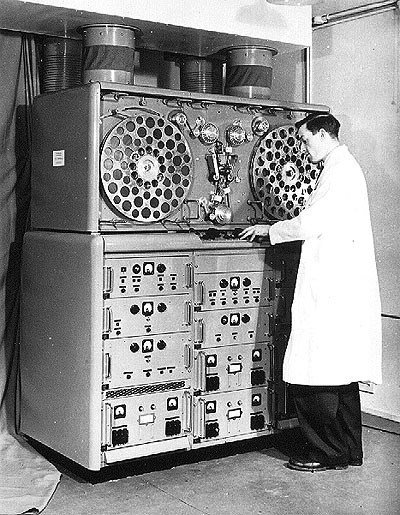
Video Recording
The BBC's answer to Ampex's two-inch quadruplex videotape recorder was VERA: Vision Electronic Recording Apparatus.
 Just like the RCA logo, anywhere you see this Ampex logo there is a link to the oldradio.com website
Just like the RCA logo, anywhere you see this Ampex logo there is a link to the oldradio.com website
About the time Crosby started pushing Ampex to develop a video recorder, the BBC started the VERA project which stood for Vision Electronic Recording Apparatus. A recorder was demonstrated within the BBC in 1956 and then took another two years to develop before being shown to the world. By then it was too late, as we will see.
The project grew out of a recognition by senior BBC engineers that recording, currently on film with the kinescope, needed a better way. Kinescope film recordings were commonplace by American television networks at the end of the 1940s, but was rarely used by the BBC, and then only for special occasions when a permanent record was required.
VERA stored Britain's 405-line monochrome television as a linear recording. like audio tape, on half-inch magnetic tape traveling at 200 inches per second. This required 20 inch diameter spools to achieve 15 minutes' recording time. The range of frequencies required for video were an order of magnitude wider then audio required. So the speed of the tape passing by the record head had to be very high to capture the much higher frequencies that video needed. Turned out that Ampex came up with a better way.
In early 1951, Bing Crosby asked his now Chief Engineer, Jack Mullin, if television could be recorded on tape as was the case for audio. Mullin said that he thought that it could be done. Up until then as has been mentioned before, TV was either live with studio cameras, or recorded on film and played back through a special film projector into the lens of a camera, as we also saw earlier. At that time, the only way to record the video coming from a camera or other live source was with a Kinescope. A kinescope recording is simply another film recording, made by photographing the live images on a television video monitor. The monitor and film camera combination were usually packaged in a fair size machine (see above).
The quality the process produced was marginal. Especially the kinescope film recordings that were recorded for delay for the west coast. A show done live for the east coast was sent across the country where it was displayed on the video monitor in the Kinescope machine out in Los Angeles. The film was developed in time for the west coast feed, which was played back on a film projector into another camera and sent to the local west coast affiliates where it was finally transmitted over the air. The trip included two television cameras, a film camera, and three transmission hops from New York to Los Angeles, then Los Angeles to the local affiliates, and finally over the air to the home. Each step took a toll on the quality of the video, including the fact that the original cameras capturing the video in New York did not have the quality anywhere approaching what they had even 30 years ago. If it were possible to video tape the show for the west coast you would eliminate one of the TV cameras and the film camera in the process.
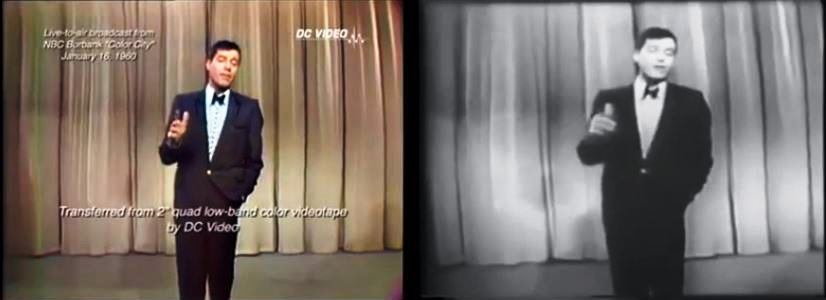
Jerry Lewis Show recorded on video tape (left), kinescope (right)
These recordings were made during one of his shows in 1960. The video tape recording was not even the highest quality available at that time. But even with that the kinescope recording pales in comparison.
Bing asked Ampex to build one and also set up a laboratory for Mullin as part of Bing Crosby Enterprises to also help develop it. The problem they all faced was that a video signal has a much wider bandwidth than an audio signal does (20 kHz vs 6 MHz), requiring extremely high tape speeds to record it; and there was another problem. The magnetic head design would not permit bandwidths wider than one megahertz to be recorded regardless of the tape speed. These two issues were eventually worked out by Ampex in a novel way.
First instead of recording video down the length of the tape, a two-inch wide tape was pulled past a spinning drum a couple inches in diameter which had four record/playback heads 90 degrees apart. One head was always traversing across the width of the tape. The head drum spun at 14,400 rpm. Each pass by one of the four heads laid down 17 horizontal lines of video on the tape. Because of the four heads these video tape recorders colloquially became known as "Quads." The spinning heads across the tape gave a head to tape speed of 1500 inch per second.
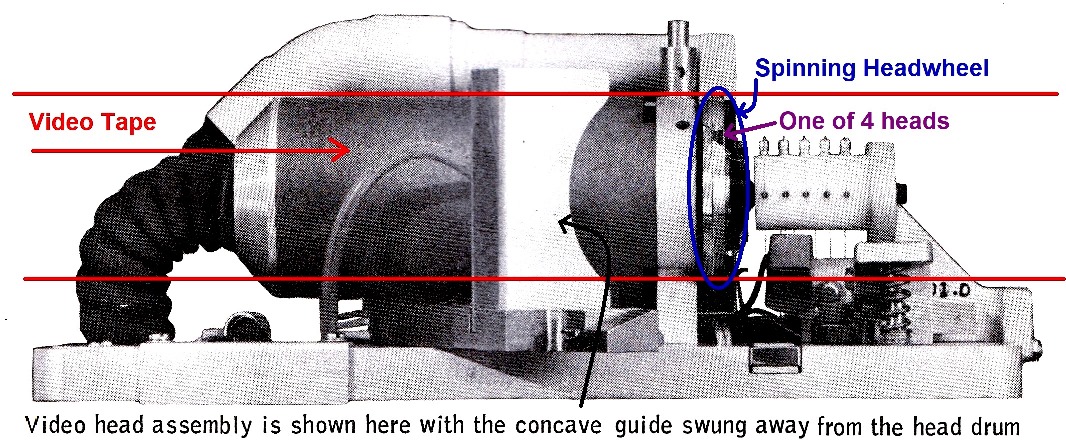
Record/playback head-wheel with 4 heads
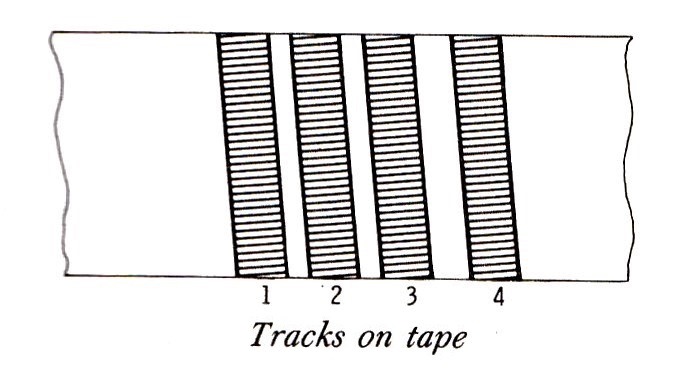
Video tracks laid perpendicularly across the tape
Operating a third generation two-inch "Quad" VTR
No you don't just hit play!
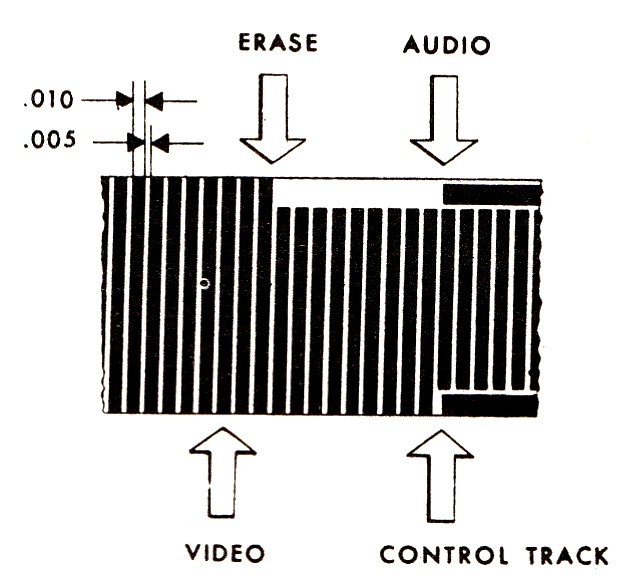
Audio/Control Tracks
As the video tracks are laid down, then an audio and control track are laid down along the edges of the tape. Control track is used to control the speed of the tape.
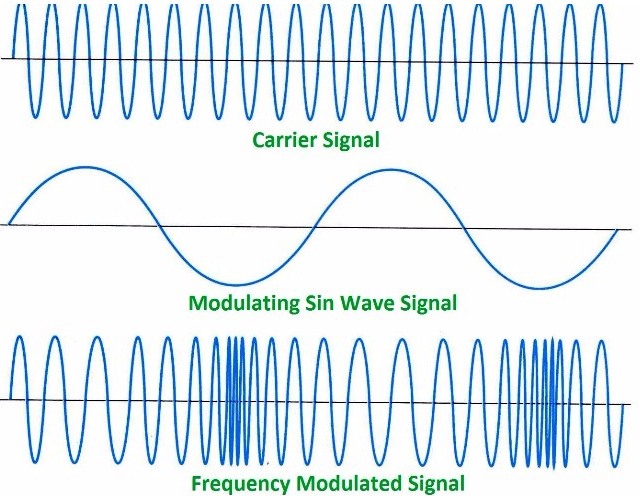
The 2nd solution - FM
The carrier signal (top) is modulated, not by a sine wave as shown here, but by the video signal. The result is a resulting set of frequencies that stay within a megahertz in bandwidth, conforming with the limitation
of the record/playback heads. Much like an FM station today, a carrier is used that oscillates across its channel, unlike AM where the carrier is fixed. These early Video Tape Recorders (VTR) had a carrier frequency of 4.5 MHz and were able to deviate from that by +/- 500 KHz to stay within the 1 MHz bandwidth of the heads.
The second solution was to use FM to lay information on the tape. So use of FM and the perpendicular or orthogonal scanning of the heads across the tape and not along the length of it made video tape recording possible.
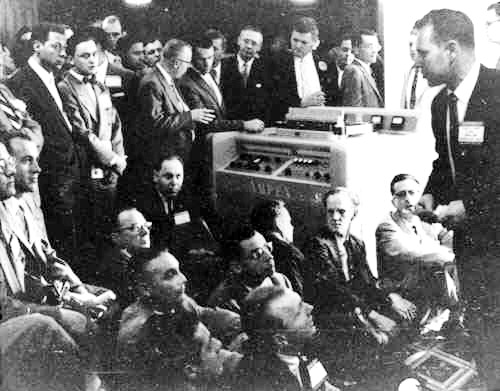
Demo to CBS at NAB

The machine shown in the photo ended up here
The first Ampex Video Tape Recorder (VTR) was demonstrated on April 14, 1956, at the National Association of Radio and Television Broadcasters in Chicago to a group of CBS management and engineers. Unbeknownst to the CBS crowd that assembled in a private room was that they were being recorded or "videotaped" as they entered. When all were seated, the lights where dimmed and the monitors in the room that where showing live video of them entering now started showing them what had just occurred a couple minutes ago. Pandemonium erupted as none of the guest had ever witnessed instant playback of a television recording. Upon playback of the material, they were astonished at the quality, marginal by today's standards but unparalleled at that time. CBS immediately placed orders for VTRs across the network. Ampex could not build the machines fast enough. The first magnetically recorded time-delayed television network program using the new Ampex Quadruplex recording system was CBS's Douglas Edwards and the News on November 30, 1956. Ampex sold 71 of these machines at or shortly after that NAB.

Ampex VR-1000
Here, the Ampex design team poses around the Emmy their efforts won, which is sitting on the tape transport section of the VR-1000. (Ray Dolby, founder of Dolby Labs, is fourth from the left.) The compressors and pumps seen in the exposed underbelly were needed to control and move the two-inch videotape used. A one-hour reel weighed close to 20 pounds. The photo on the right shows the tape transport with its "monitor bridge" sitting next to the two-rack electronics cabinet. Essentially, one of the racks housed the video and audio processing circuitry, while the other housed the servo circuits.
Early video tape editing
It involved the physical splicing of tape!
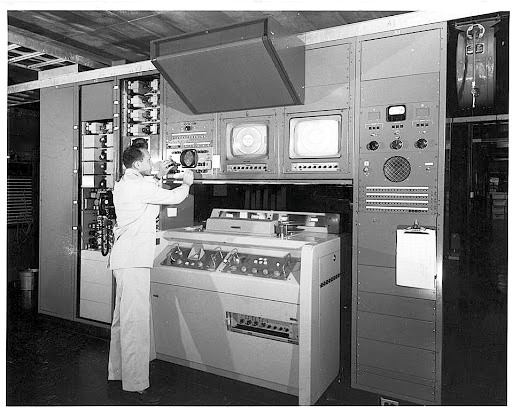
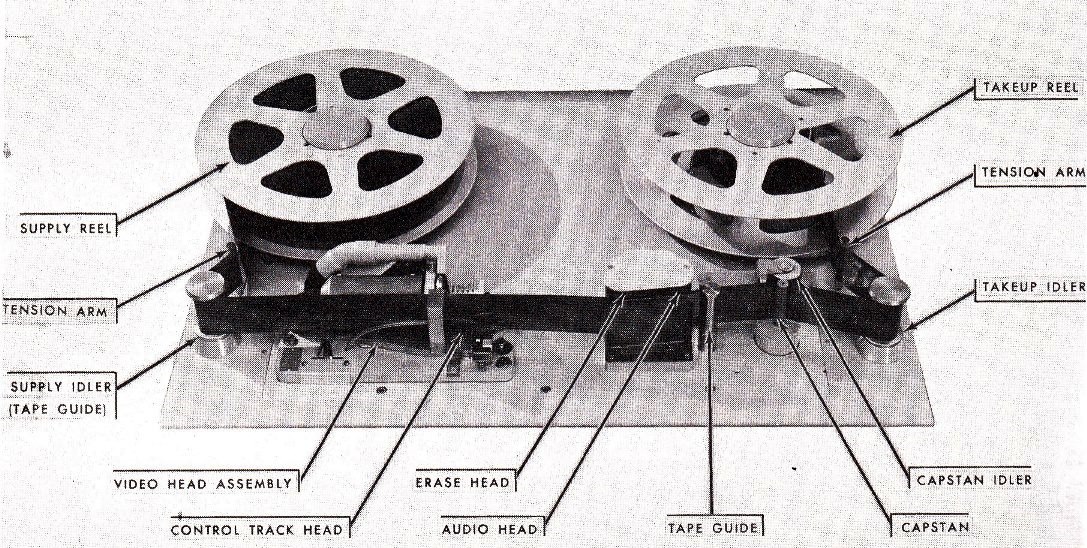
VR-1000; in use at CBS/tape transport
CBS installed 14 at their Grand Central Terminal facilities in 1957.
The VR-1000 had three sophisticated servo systems. One to move tape at the right speed, the caption servo. One to keep the head wheel spinning at the correct speed across the tape, and a third to keep the tensioning of the tape correct so as not to damage the tape.
The original recorders only recorded in black and white, but after we saw how CBS fought color TV early on, that fact did not matter to the network. VTRs where not only complicated electronic devices, but complicated mechanical devices also. Besides racks full of electronics to simply record black and white video, and a single audio track, along with a cue track, there were several motors, solenoids, pumps, and air vacuum systems. The first Ampex VTR weighed 1500 lbs. and took up 92 square feet.
When these machines were first introduced they could not be synched to other video sources and so could not be used in any kind of effect during playback, like a dissolve or split screen. Like color, which took a number of modifications and additions to the machine, locking a VTR to other sources, or to the "house" as they would say, took more stuff. Including money. It was not hard to get a VTR up into the $100,000 price range. That is in 1950s dollars.
 The Ampex VR-1000 was the first of Ampex's line of 2 inch Quadruplex videotape recorders. Crosby Enterprises was Ampex's West Coast representative until 1957. Crosby became one of the richest men in the history of show business. He had investments in real estate, mines, oil wells, cattle ranches, racehorses, music publishing, baseball teams, and television. He made a fabulous fortune from the Minute Maid Orange Juice Corporation, in which he was a principal stockholder. He had come a long way in his life. While always a gifted singer, who could not read music, he squandered that talent early on with partying, drinking, and even an arrest. When William Paley, head of CBS first heard his voice he wanted the network to hire him. Network executives were reluctant, but at Paley's insistence they did. Crosby managed to cloister his shortcomings and demons for most of his life. He had more number one hits in his life than Elvis and the Beatles. For 15 years he was a top movie box office draw. In 1945 Life magazine declared that he had made more money than any entertainer in history. His passion for golf greatly swayed the trajectory of broadcasting for 20 years.
The Ampex VR-1000 was the first of Ampex's line of 2 inch Quadruplex videotape recorders. Crosby Enterprises was Ampex's West Coast representative until 1957. Crosby became one of the richest men in the history of show business. He had investments in real estate, mines, oil wells, cattle ranches, racehorses, music publishing, baseball teams, and television. He made a fabulous fortune from the Minute Maid Orange Juice Corporation, in which he was a principal stockholder. He had come a long way in his life. While always a gifted singer, who could not read music, he squandered that talent early on with partying, drinking, and even an arrest. When William Paley, head of CBS first heard his voice he wanted the network to hire him. Network executives were reluctant, but at Paley's insistence they did. Crosby managed to cloister his shortcomings and demons for most of his life. He had more number one hits in his life than Elvis and the Beatles. For 15 years he was a top movie box office draw. In 1945 Life magazine declared that he had made more money than any entertainer in history. His passion for golf greatly swayed the trajectory of broadcasting for 20 years.

Seven generations of Ampex VTRs
History of Ampex
Mechanical Wonder
The pinnacle of electronic and mechanical engineering. A Ampex ACR-25. The system comprised of two Quad tape decks and a carousel that held short 2 inch video tape cartridges. It would automatically load and unload the tape in those cartridges into one of the two decks. The machine mainly used to play back commercial breaks.
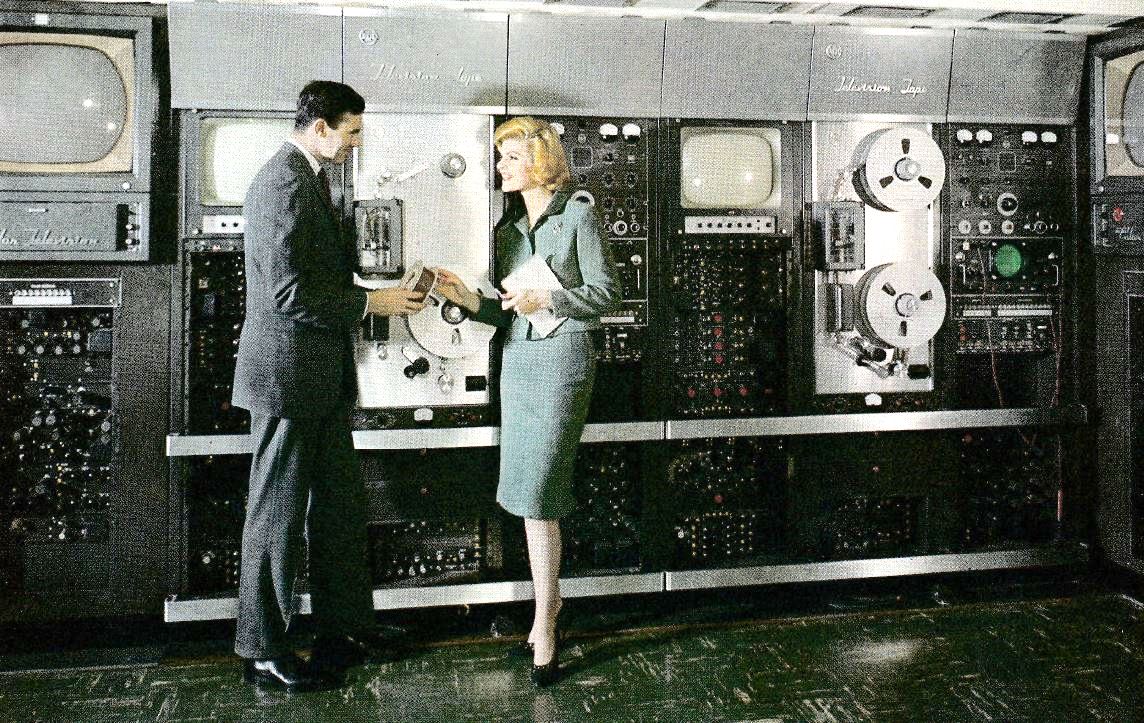
RCA TRT-1 - Their first VTR
Now it was RCA's turn to buy someone else's equipment. NBC ordered three Ampex machines. Two went to Burbank to tape delay west coast shows, which was better than their Kinescope recordings. One NBC forwarded to RCA Labs in Camden. Eventually RCA had eight Ampex VR-1000s in their lab. RCA proceeded to "colorize" the Ampex VR-1000. RCA's main interest was still selling color sets and that required colorized recordings along with live. RCA demonstrated their "colorized" VR-1000 to Ampex engineers and executives, which led to a patent cross-licensing deal, which enabled RCA to use Ampex's technology and make its own video recorders.
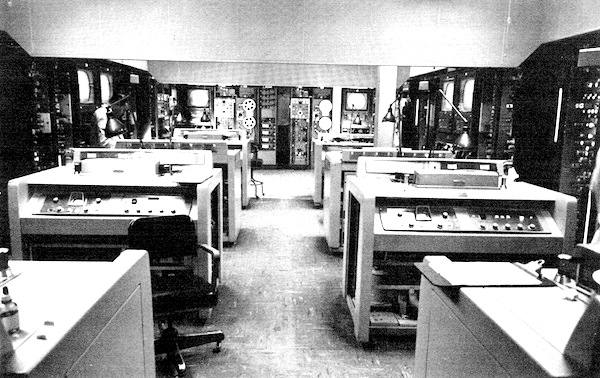
VTRs installed at NBC Burbank
NBC's Videotape Central started operation on Tuesday, April 28, 1958. The NBC Burbank facility had been dubbed "Color City." The $1.5 Million facility sported eight RCA modified Ampex VR-1000 recorders and one RCA TRT-1C color recorder.
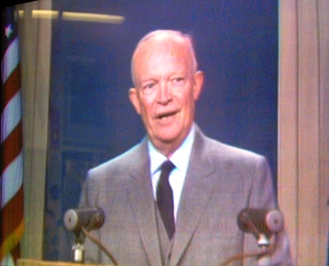
First Color Recording?
Screen shot of President Dwight Eisenhower during the 1958 dedication of WRC-TV/NBC Studios in Washington, DC. This is the oldest Color Quad recording known to exist. It was recorded at NBC, Burbank during the live broadcast on the NBC television network.
Early NBC color recordings (1958 and early 1959) were recorded on Ampex VR 1000 black and white VTR's modified with RCA Labs-designed color circuits. Early in 1959 the two companies compromised on a different color recording format and the early "RCA Labs" color tapes were obsolete and could only be played on a very few of the Ampex-RCA Labs VTR's. RCA sold color VTR's before Ampex did by offering a color upgrade kit for their TRT-1B VTR. Ampex had a registered trademark on the name "Video Tape," RCA called their system "TV Tape" and "Television Tape" in print advertising and on the machines themselves.

Successive RCA VTRs
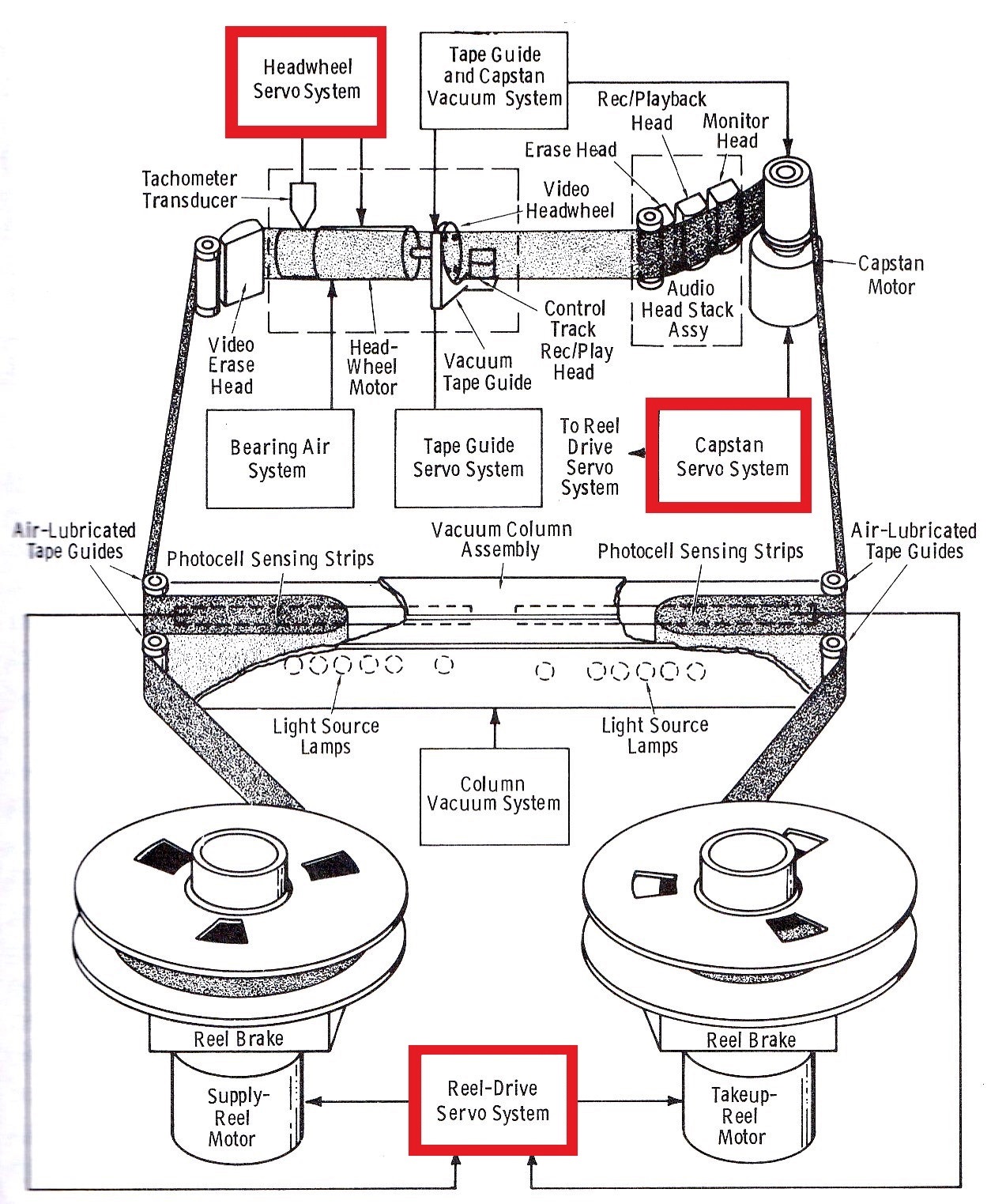
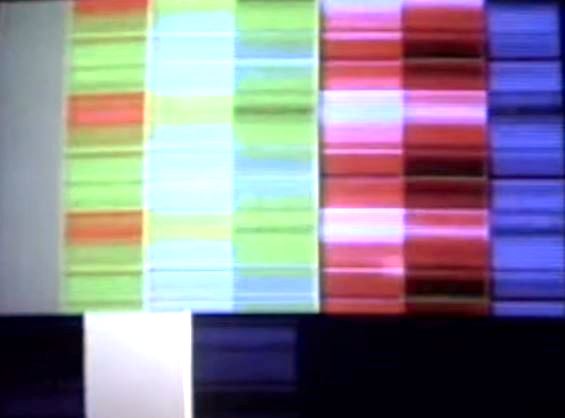
Recording and playing back color
Recording color is not the hard part. Playing it back with the correct colors is the hard part. The color receiver or display depends on a reference burst of color subcarrier sent at the beginning of each color line. It then used that reference to determine the tint or color at any given place along the line. The slightest timing error, as little as 1.5 nanoseconds (that is 1.5 with 8 zeros in front), and the intended color would not be reproduced correctly, as seen above. As we just mentioned, VTRs, while complicated electronically, were also very much mechanical beasts as well.
The diagram shows that it took three mechanical servos (in red) to record, and then play back a tape. It also took at least two completely electronic servos in addition to faithfully reproduce the recorded material. The textbook definition of a servo is: an automatic device that uses error-sensing negative feedback to correct the action of a mechanism.
The head wheel that scanned the video tracks on the tape, was continually going a little fast or slow as the head wheel servo worked to keep the rotation speed near steady. But never completely steady. That meant that the video coming off the tape was a bit sooner or later than expected. Remember the color display took the color reference at the beginning of the line as gospel. Video jitter, as it was called, even incredibly small, caused color problems as the timing errors translated into wrong colors. The early fix was to use a dual heterodyne process.
This is what RCA originally did in modifying the Ampex machines to record color. We mentioned this process earlier to make it simpler to tune radios, and televisions for that matter, by mixing, or beating as they say, two different frequencies together to get two new frequencies, the sum and difference of the original two. If carrier off the tape with the video jitter is mixed with a steady carrier, one of the two new frequencies also has the same jitter. But a second frequency will be stable. What RCA did was separate the color signal or carrier from the rest of the video, leaving only the black and white info, and putting the color information on a second carrier, lower in frequency than the main RF carrier and record both on tape. This lower color carrier was often referred to as color under.
On playback both the luminance or black and white, and the color carriers will both have jitter, but the color carrier will be heterodyned again with a stable color reference and one of the two new carriers will be a stable color signal. This "time base" corrected color signal was mixed back with the B&W recovered signal. Yes, the B&W part of the signal will still have jitter, but it is small enough that it appears as slight fuzziness around the edges. But the color is stable and locked. This is the same process that the home VCR used, and why the video always looked a little fuzzy. Most think it was the color part that was fuzzy, while it was always the luminance or black and white part. Ampex and RCA came up with very expensive and complicated systems to get away from using heterodyned color, but it took a few years. It was not until the beginning of the digital revolution in the 70s that an elegant solution to time base jitter was achieved.
In record time for RCA, in only a year they had their own Quad VTR working, the TRT-1, and a little over a year later they had a colorized version working, the TRT1B. It was no smaller or lighter than the Ampex machine. The base unit was six racks and instead of a separate console that held the tape deck it had its tape deck vertically mounted in one of the racks. Two of the five racks housed nothing but the servo systems. If you wanted color you added a sixth rack. In a couple years they got the whole thing down to three racks.
Ampex and RCA competed with each other with two-inch VTRs well into the 70s. The machines got more capable, and a bit smaller, but not a whole lot. Ampex actually owned the VTR trademark and RCA never used it. While Ampex two-inch Quads had VR prefixes (Video Recorder) RCA ended up using TR (Television Recorder). The original TRT designation for RCA's first machine was never clear if it meant Tape Recorder Television.
The RCA bureaucracy showed up in the tape machines. The Ampex approach to integrating all the sub-systems into the machine was so that they were more readily separated when needed during troubleshooting and repair, which all these machines needed regularly. RCAs approach was much more convoluted with many sub-systems relying on other sub-systems to perform their function. This made it much harder to separate out which sub-system was in trouble when the machine was not working correctly. In fairness some of the byzantine approach was so RCA could get around some patent infringement contention.
A look at an ancient RCA TR-70 VTR
The original video server!
Much like a juke box being an audio server.
Sappy RCA TCR-100 promo
Bizarre promo for the RCA TCR-100
Before Ampex introduced their
ACR-25
, RCA introduced this mechanical beast. Like the later Ampex version it had two quad tape decks, and a open carousal to hold 24 cartridges of tape. The tape length was limited to 5 minutes. Unlike the ACR-25 the tapes it had in the carousal could only be played in order, not randomly. Also whereas the Ampex version used pneumatic air columns to pull tape out of the cartridges, the RCA version used pins on sliders moved by bicycle chains to thread the tape.
Besides the pompous tone of the narrator the strangeness of this promo is centered on showing Sony BVU-200 VTRs and saying that RCA will essentially show the Japanese how it is done. The other hilarious thing is that it was claimed the machine was maintenance free. Anyone who worked on one knew that definitely was not true. To be charitable it did not need the setup to play back a quad tape as
shown here
, but it required almost constant maintenance and repair.
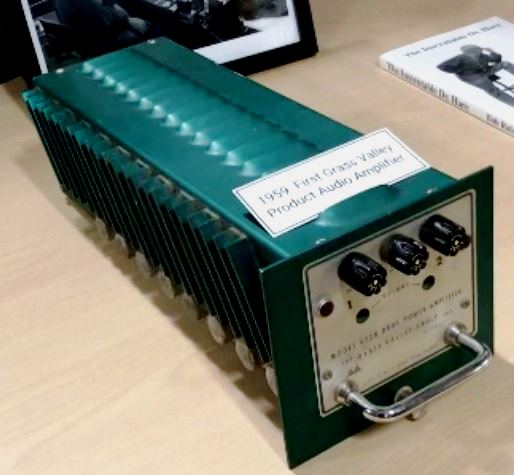

The "Group"

Before they were a video company, they were a audio, and anything else to keep the doors open company.
Dr. Donald Hare started his company, D.G.Hare & Co in the east. He sold and bought back the company a couple times. While owned for a second time he managed to move the company to Grass Valley, accepting an offer from a fellow Stanford alumni, Charles Litton, to move into extra space his company had. While renting from Litton, Hare and him had a failing out. The positive thing was that Hare ended up getting his company back. He had a small group of employees that called themselves "the group," so when casting about for a new name indicative of a new start for the company, it ended up as "The Grass Valley Group."
So, when the Grass Valley Group was still struggling to stay viable, TV was to a point where color TV was rapidly ascending and video recording was becoming standard in most broadcast facilities. RCA was at the top of the broadcasting equipment food chain, and Ampex was itself becoming a force in the industry. In the 60s Ampex started branching into cameras and other broadcast equipment. GE, Marconi, Philips, and other large and small companies where selling to broadcasters. Did the industry need another small outfit up in the "boonies?"
In 1963 during a Grass Valley Group company brainstorming meeting it was suggested that they should do something for the television market. Hare ran the idea by Harry Jacobs, who had worked for him at the Airborne Instruments Laboratory during the war, and had returned to KGO, the San Francisco ABC owned station. Harry said GVG would have a hard time competing with RCA, Ball Brothers, GE, and others. But he said he would like to visit GV and he brought a ubiquitous piece of equipment with him, a video distribution amp, or DA as they were called. They were simple and straightforward devices and sold for about $350 each (in 1963 dollars). Harry suggested some refinements. In short order GV designed a video DA.
1963

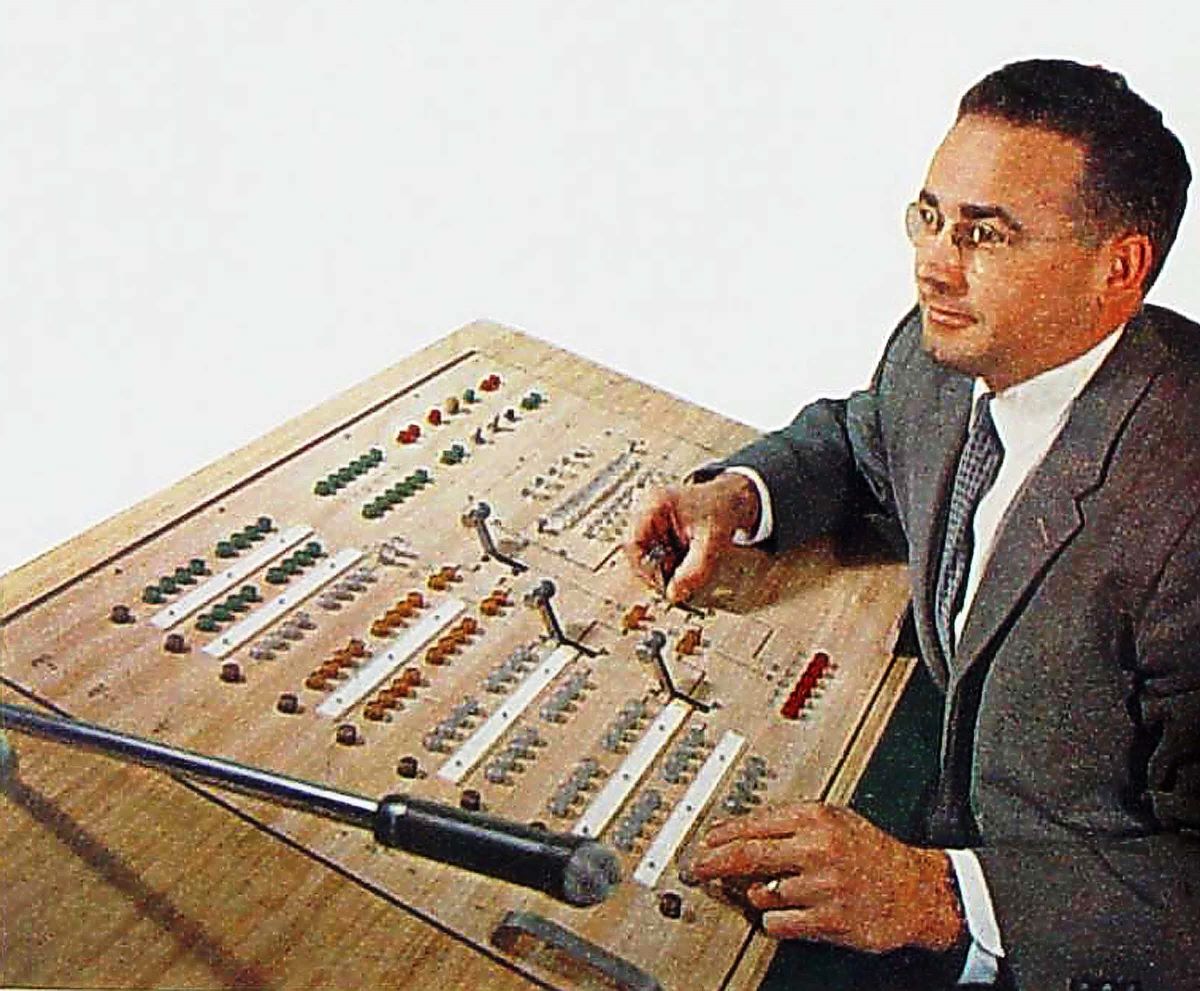
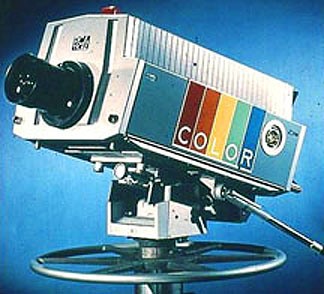
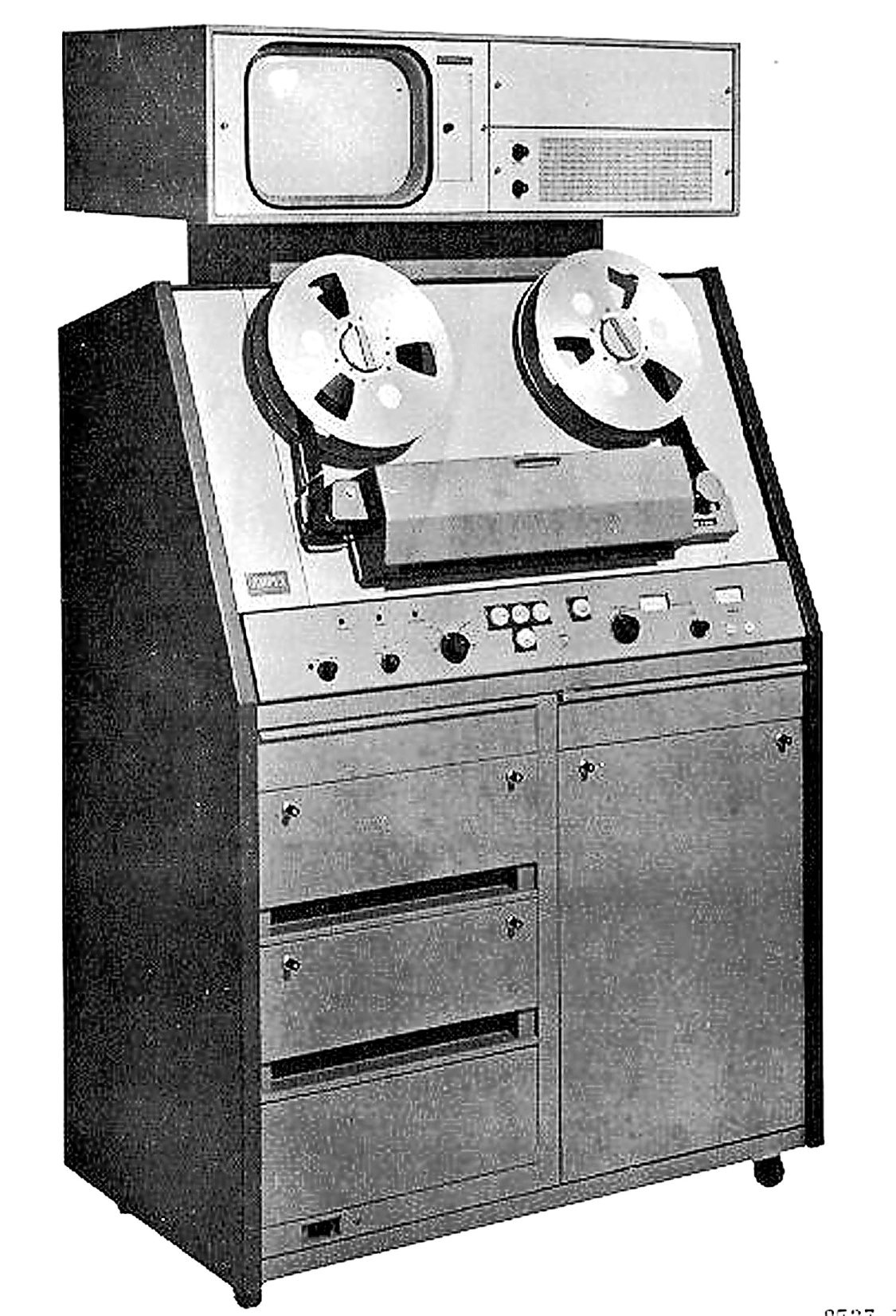
RCA TS-40 Video Production Switcher
RCA TK-42 2nd Generation Color Camera
Ampex VR-1100 2nd generation VTR
Eventually the Grass Valley name would compete in these three areas.
 This was at a time when engineers still used slide rules. Forget about today's hardware description languages, or earlier Spice circuit simulation, or more ancient programable calculators, or any calculators. This was not even the dark ages of modern system design, nor even the iron, or bronze age. This was the tin age. While electronics had progressed, the tools to design, build, and test were rudimentary at best.
This was at a time when engineers still used slide rules. Forget about today's hardware description languages, or earlier Spice circuit simulation, or more ancient programable calculators, or any calculators. This was not even the dark ages of modern system design, nor even the iron, or bronze age. This was the tin age. While electronics had progressed, the tools to design, build, and test were rudimentary at best.
In the meantime, sales for their existing audio amps picked up and they got big orders from radio stations in New York and New Orleans. It helped keep the doors open and the lights on. In October 1963, Herby Hartman, chief engineer of KCRA, the NBC affiliate in nearby Sacramento, joined the group. He, Bill Rorden, and Hare put the final touches on the 700 Video DA.
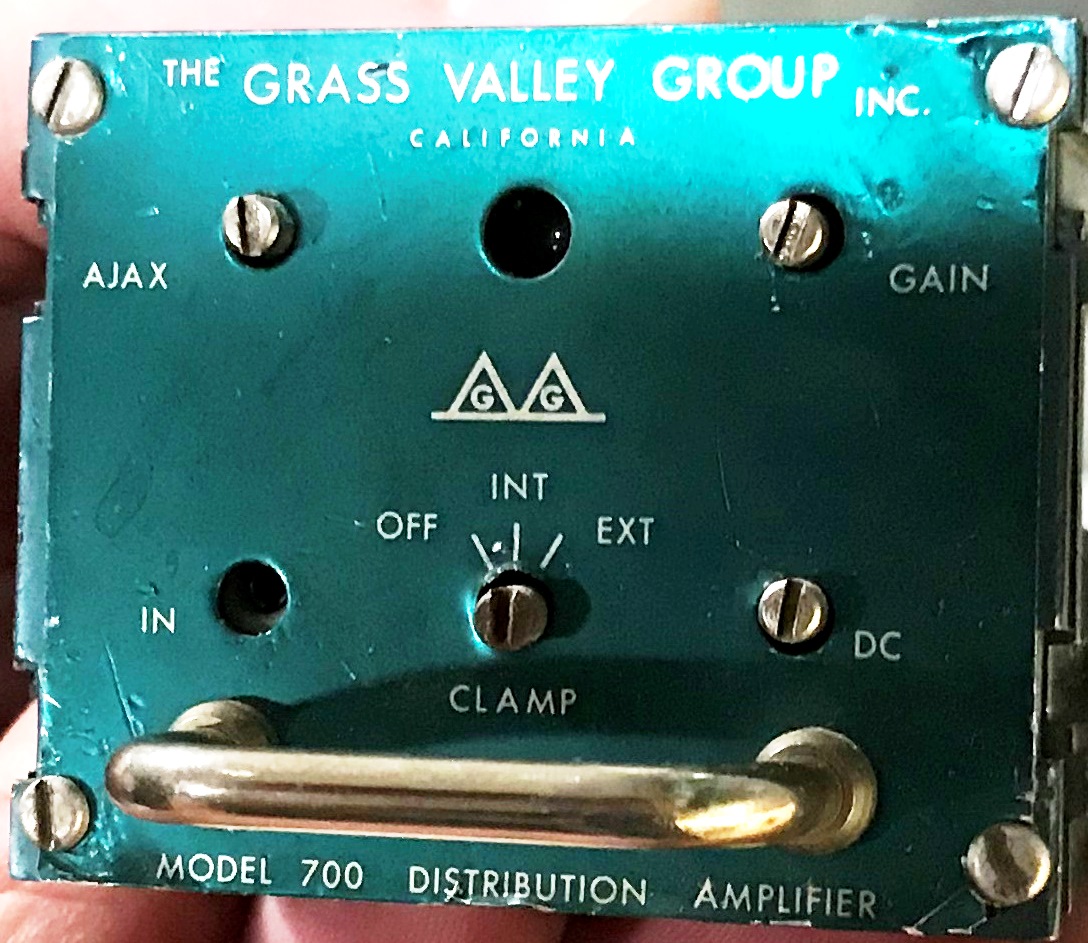
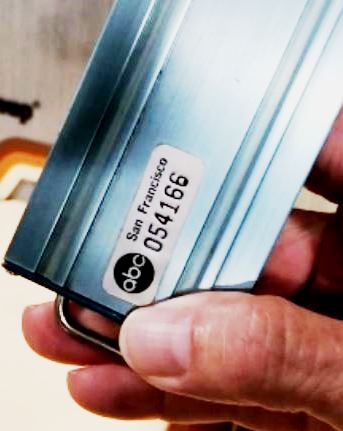

Very first video product; The 700 Video Distribution Amplifier. Not much to look at. They came in two flavors; one that could be mounted directly into a rack, and one that could go into a frame (with up to seven others like it), which could also be mounted in a rack. ABC was an early customer.
About the same time Hare's son, Stephen, graduated with an Electrical Engineering degree from Stanford and went to work for the group. Steve was tall and lanky, and a good athlete, like his dad. Also like his dad he was a free thinker, and there was occasional friction between them. Most of the group called him Corky after Corkhill, his second middle name, which was the same as his dad's.
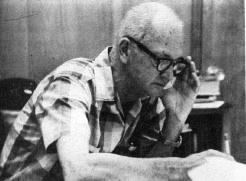
Dr. Hare's Management Style
A consulting contract with a company called Sangamo was ending. Sangamo had owned Hare's company at one time. At this time, an employee of Sangamo, Bob Robertson, who worked in their financial area, was looking for a change in environment because of recurring asthma. A Sangamo bigwig recommended him to Hare, who hired him. Hare liked the idea that during the interview Robertson never asked about benefits. Hare started him low, but after a short while gave him a raise. Bob in 1996 wrote a book about Hare, The Inscrutable Dr. Hare. Bob said in his book that Hare wanted to know what was going on in every department every day. From Robertson he wanted to know each day's cash receipts, disbursements, and bank balance. He checked those totals himself. If he found any errors, he would issue a sharp reprimand.
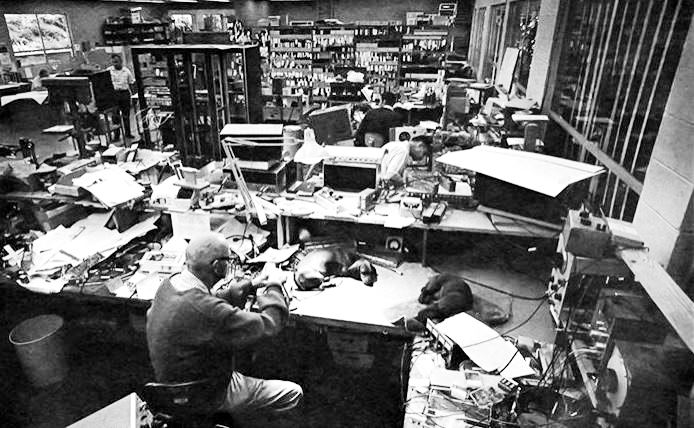 Hare would at times encourage differences in opinion. He wanted to ensure that the right way to do or approach something was arrived at. So, although he was often right, he would sometimes take a contrarian approach to what he believed was right just to draw out responses from those around him. He often did that with his engineering neighbor, Rorden. Bill would then have to make a logical case for what they were trying to do. Often the original track was confirmed. But sometimes a different and better path forward was realized. According to Bob Robertson, Hare in one meeting responded to a silent room by saying "Dammit, I'm paying you guys too much money to just sit there and agree with me." Hare was the first to admit that he was opinionated and difficult to work for, but many had their lives profoundly influenced by his tenets.
Hare would at times encourage differences in opinion. He wanted to ensure that the right way to do or approach something was arrived at. So, although he was often right, he would sometimes take a contrarian approach to what he believed was right just to draw out responses from those around him. He often did that with his engineering neighbor, Rorden. Bill would then have to make a logical case for what they were trying to do. Often the original track was confirmed. But sometimes a different and better path forward was realized. According to Bob Robertson, Hare in one meeting responded to a silent room by saying "Dammit, I'm paying you guys too much money to just sit there and agree with me." Hare was the first to admit that he was opinionated and difficult to work for, but many had their lives profoundly influenced by his tenets.
In pushing his troops to question the conventional wisdom they would often find that the discussion had gone full circle. When the same discussion points started to repeat Hare would often say we've been around the mulberry bush already. Rorden once quipped, why not build a revolving mulberry bush.
The group manufactured almost everything in house, including metal cases, printed circuit boards, even shipping cartons. Hare was always worried about customer service and if a piece of equipment was under warranty, even after the company started sending loners, if was not being repaired right away he demanded an explanation.
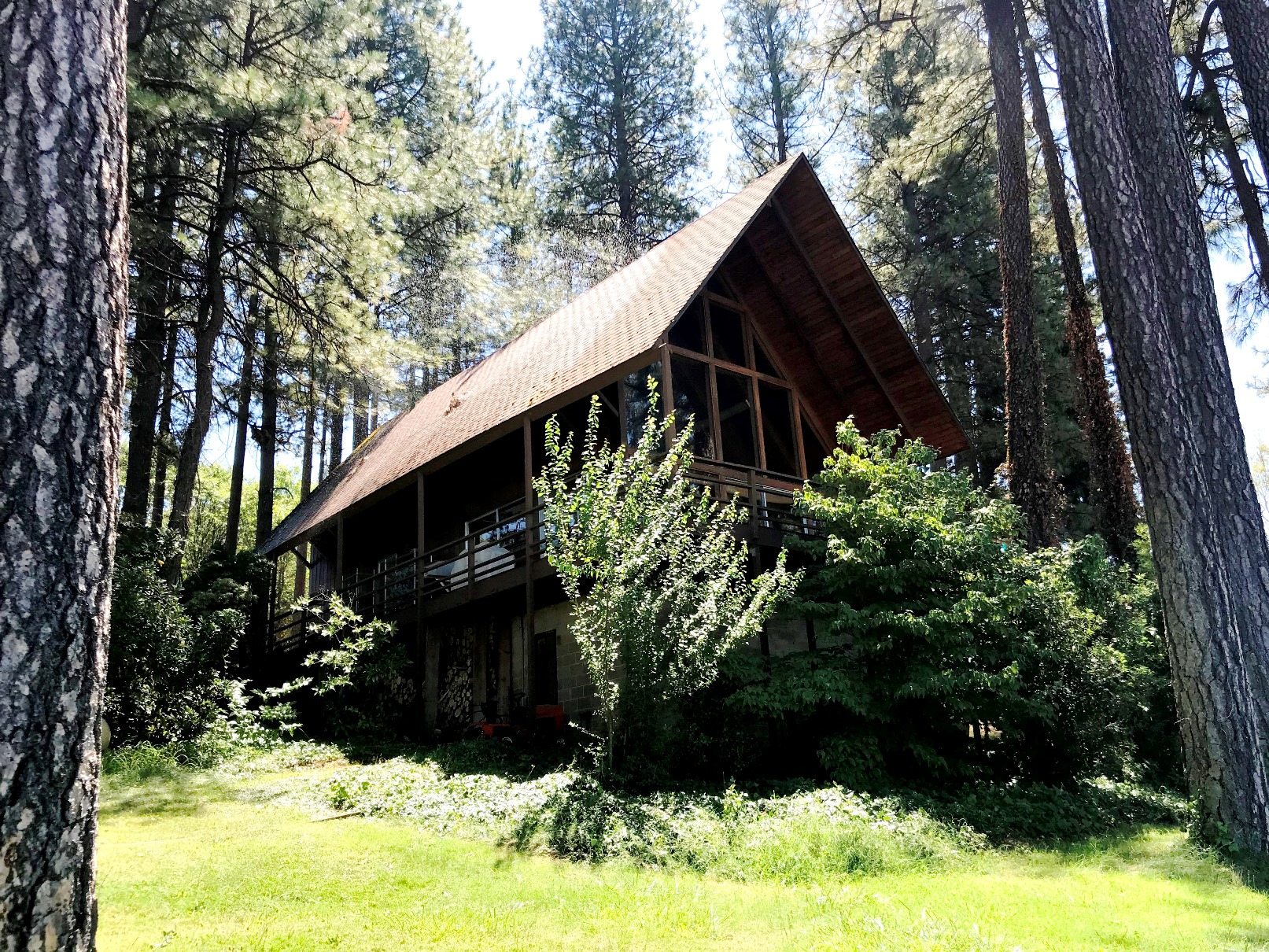 Hare was such a creature of habit that he got dressed in a certain order. Underwear, shirt, socks, shoes, and then pants. He would not change even after men's pants tapered narrow at the bottom. His wife, his third, had to find pants that would allow him to continue to dress in that order. First time Bob Robertson met Hare he was casually dressed in a short sleeve Sports shirt and khaki trousers. Quite a contrast to the white shirt, tie, and jacket corporate atmosphere he was used to.
Hare was such a creature of habit that he got dressed in a certain order. Underwear, shirt, socks, shoes, and then pants. He would not change even after men's pants tapered narrow at the bottom. His wife, his third, had to find pants that would allow him to continue to dress in that order. First time Bob Robertson met Hare he was casually dressed in a short sleeve Sports shirt and khaki trousers. Quite a contrast to the white shirt, tie, and jacket corporate atmosphere he was used to.
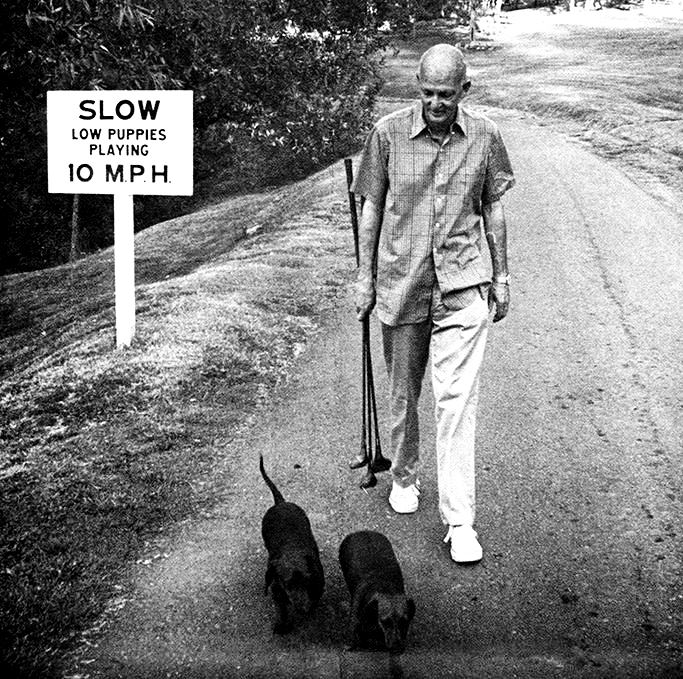 Hare and his wife had an A-frame house that was on top of a ridge on company property. The house had commanding views in three directions. He had two Dash hounds that usually went with him wherever he went, and he drove a five-year-old black Mercedes. Hare used a walking stick which was a battered four iron. Hare had a 6 foot plus frame. He had a well-worn but friendly oak swivel chair in his office. Outside his office he had two benches in an L shape, always cluttered with parts, soldering iron, small hand tools, an oscilloscope, and other test equipment. But he kept one clear space. It was for his grown-up Dachshunds, Itsy and Red. That space was for the "puppies" as he would refer to them. He would park both of them in the clear space when he was working at the benches. The "puppies" were the reason for the strict five-miles-an-hour speed limit on the property.
Hare and his wife had an A-frame house that was on top of a ridge on company property. The house had commanding views in three directions. He had two Dash hounds that usually went with him wherever he went, and he drove a five-year-old black Mercedes. Hare used a walking stick which was a battered four iron. Hare had a 6 foot plus frame. He had a well-worn but friendly oak swivel chair in his office. Outside his office he had two benches in an L shape, always cluttered with parts, soldering iron, small hand tools, an oscilloscope, and other test equipment. But he kept one clear space. It was for his grown-up Dachshunds, Itsy and Red. That space was for the "puppies" as he would refer to them. He would park both of them in the clear space when he was working at the benches. The "puppies" were the reason for the strict five-miles-an-hour speed limit on the property.
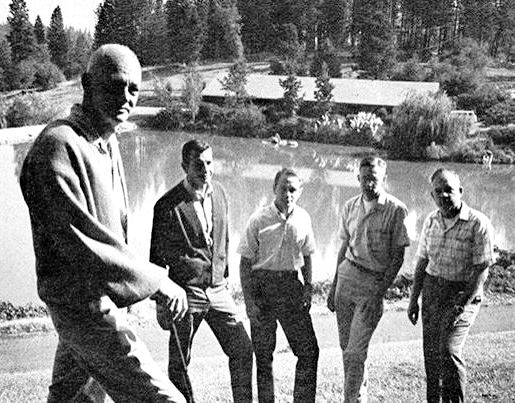 At 26 Bob Johnson was hired as a technician and given his first assignment, winding transformers. He had spent 4 years in the air force as a radar tech and worked a year at an electronics company before coming to Grass Valley. His second day at the company, Hare stopped and watched him winding transformers. Hare said he was too slow and that he should be able to do it faster. "Do you want quality or speed" was Bob's reply. "I want both!" Hare said. Bob survived and eventually went on to become the most senior employee in the company in terms of service. Bob became part of the after-hours recreation in the plant with Dr. Hare and Stephen Hare. Sometimes it was a putting game with coffee cans placed around the factory. All games had to include small wagers to satisfy the competitiveness of Hare. Sometimes it was targets shot at with pellet rifles at a steel rollup door. Once he brought out a .22. The next day it was realized that there were holes through that door.
At 26 Bob Johnson was hired as a technician and given his first assignment, winding transformers. He had spent 4 years in the air force as a radar tech and worked a year at an electronics company before coming to Grass Valley. His second day at the company, Hare stopped and watched him winding transformers. Hare said he was too slow and that he should be able to do it faster. "Do you want quality or speed" was Bob's reply. "I want both!" Hare said. Bob survived and eventually went on to become the most senior employee in the company in terms of service. Bob became part of the after-hours recreation in the plant with Dr. Hare and Stephen Hare. Sometimes it was a putting game with coffee cans placed around the factory. All games had to include small wagers to satisfy the competitiveness of Hare. Sometimes it was targets shot at with pellet rifles at a steel rollup door. Once he brought out a .22. The next day it was realized that there were holes through that door.
Bob was a good golfer and was always included at the Sunday foursome at Alta Sierra Country club. Occasionally Hare would invite Bob to play on a week-day afternoon, just the two of them. Once, when they were having their customary after round drink. Bob mentioned something about the Group. Hare abruptly told Bob to finish his drink and said nothing after that, including the trip back to the plant.
The next morning Bob was summoned to Hare's office and motioned over to sit on the couch. This was known as "couch time" by the employees. Hare chewed Bob out for mentioning Group business in public. Social time was not for discussing business, especially because you never knew who else would be listening. Hare would not break his own rule to reprimand Bob in public or even outside of the group's facilities. He waited until business hours the next day.
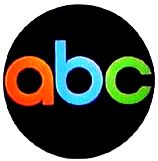
ABC's Help
In early 1964 Hartman took the new DA to New York City and showed it to CBS, which was not interested, but ABC New York was. Hans Schmidt of ABC spent a week evaluating it. Rorden and Hartman went to the NAB in Chicago that spring. The group, not being a member of the NAB as they could not afford it, set up a demo in their hotel room next store to the convention center at what was then the Hilton hotel. They lured attendees they ran into to come to their room and see the unit. In the next few months the company received orders for the model 700 and a new modified 705.
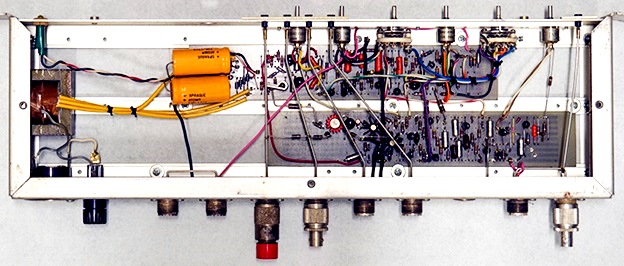

Vero Boards
Early Grass Valley Group products were constructed on Vero boards. Vero board was developed in the early 1960s by the Vero Precision Engineering Ltd. company and was a copper strip circuit board where cutting the copper strips would create the individual traces for the circuit. When printed circuit boards were eventually designed for the products they often simply copied the Vero board layout.
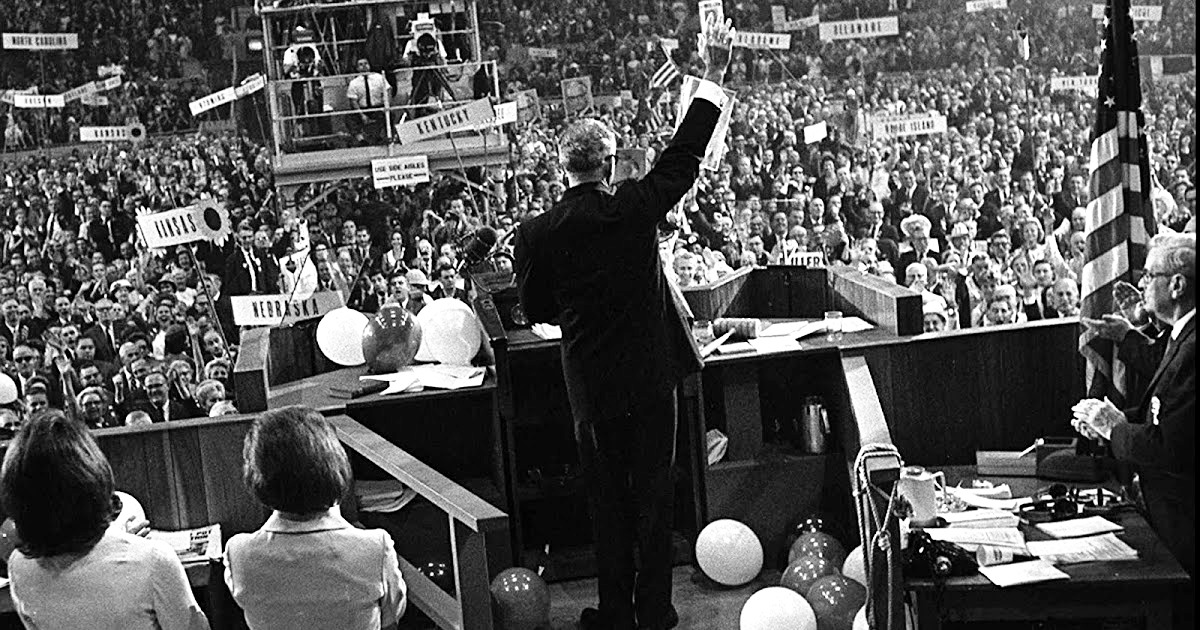
ABC's normal supplier of DAs and similar equipment was not going to be able to deliver the equipment needed for the upcoming 1964 Republican Convention from San Francisco's Cow palace, and Harry Jacobs called and said that if the group could deliver 30 DAs and ten proc amps, they would buy them. Hare, as already stated asked, "What the hell is a proc amp?" Hare had never heard of a processing amp but agreed to build 10 of them. He was told to call Frank Haney in New York and he would give them the specs. This all happened on a Monday. Tuesday afternoon Rorden and Hare went and bought a TV so they could test what they were doing. By Wednesday they had a working breadboard in a vice. They called up Jacobs and said to come see it. He showed up Friday and the group already had it in a case. ABC then gave them the order. All went well with the equipment at the convention. ABC became an important customer.
This ability to take an idea and transform it in short order into a shippable product was one of the Group's main assets early on. A couple years later an engineer from RCA called and said they wanted a license for the Model 700 DA. Hare said they were obsoleting the model line and that he told the RCA engineer to just go ahead and copy it, he didn't care. Hare explained to the RCA guy, that is where the Group had the advantage over RCA. The Group saw a need and simply made it in very short order. RCA had to get one or more committees to approve an idea, then design the circuit, send it through drafting, assign part numbers to all the components, make requisitions to purchasing, and it would be two years before the idea is shippable. Bill Rorden once said that they discovered there was more ignorance in the video business than in the audio business, and the Group proceeded to take advantage of it.
Even into 1965 the company still had no sales department, nor did it do any advertising. At that year's NAB convention GV joined the NAB and had a low-cost booth that had a modest display. It was enough that orders increased over the next few months. It was at this time that the rise of UHF took off, and so the customer base was increasing. The competition was still tough, with RCA offering just about everything a broadcaster needed.
GVG did not even have a drafting department. New products and anything needed to build, and test products were done with informal documentation, and not blueprints. Rorden and Hare could produce prototypes in days, or at most a few weeks. From their early background with transistors they knew that the mainframe computer industry became the largest user of transistors. The type of transistors that these key players like IBM used, GVG used because the more that are produced ensured that those would be the most reliable.
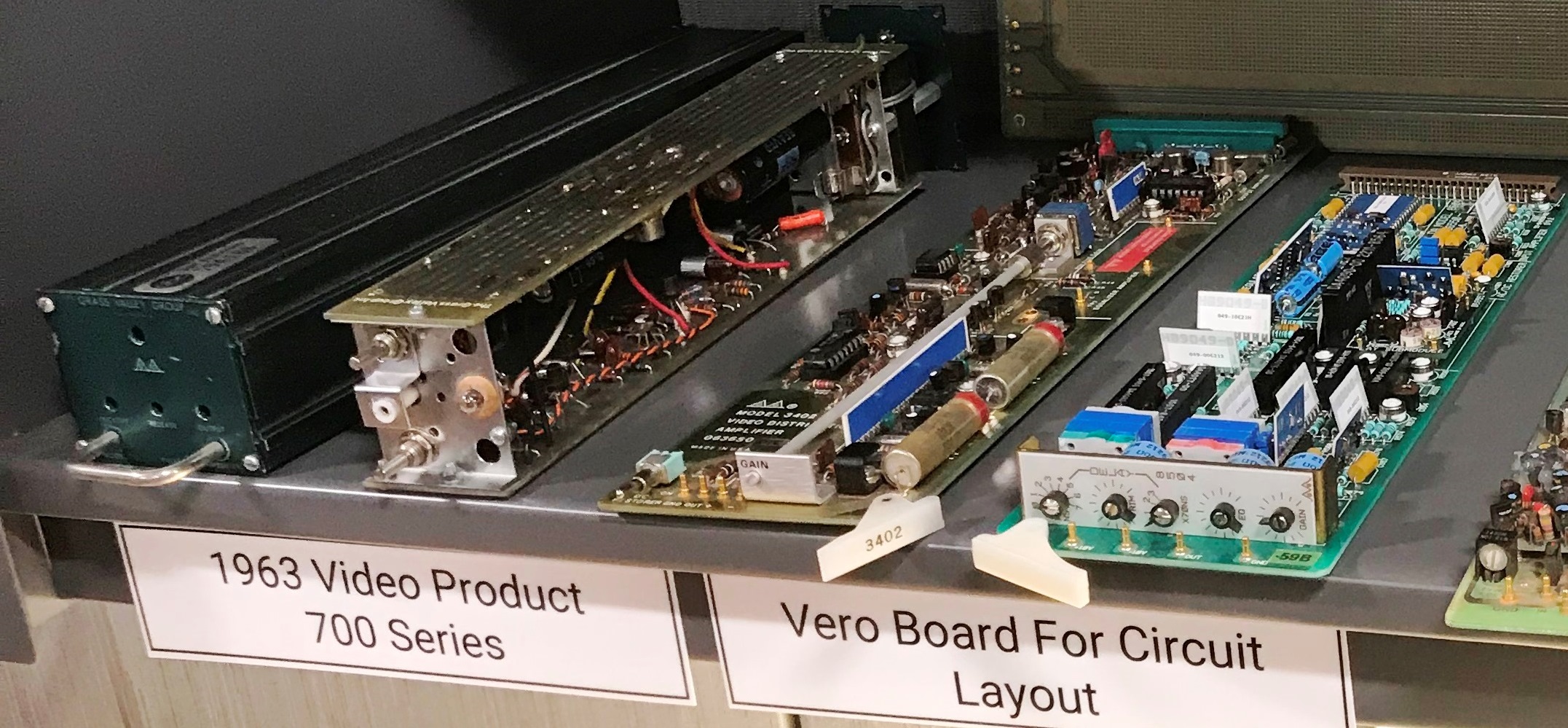
Now a Video Company
Early Grass Valley video products
Apart from the video DAs and Processing Amps, the majority of the first 70 of its products were never produced to take business from another company. In this way they did not have to compete head to head early on, and thus staying clear from the hoofs of their larger competitors. They would innovate and create new markets. Their developed products were based on the needs of engineers working for the networks in San Francisco and Los Angeles. As television was evolving new problems arose and the solution often involved new ideas. GV had an advantage in that Rorden, and Hare could take these new ideas and turn them into products in very short order.
At one-point Hare thought GV was charging too much for a piece of equipment, called a Sync Generator (what Farnsworth and Zworykin were working on early on in TV's development). So GV gave all who had bought one a $500 credit. GV had a philosophy of not charging too much for equipment. They took the cost of producing a piece of gear and doubled it. If that amounted to what the customers were willing to pay, they offered it. If not, they simply did not produce them.
By 1966 orders were coming in faster than they could fulfill them. Bob Johnson, Stephan Hare, Bill Rorden were working every Saturday to keep up. Hazel Hare made almost daily trips to the Sacramento airport in a station wagon filled with boxes of equipment. This would soon be taken over by a dedicated driver and van. That year the ABC Television Network bought 37% of their products sold.
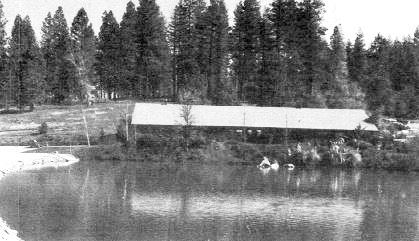
First GVG Building on site - Building 1
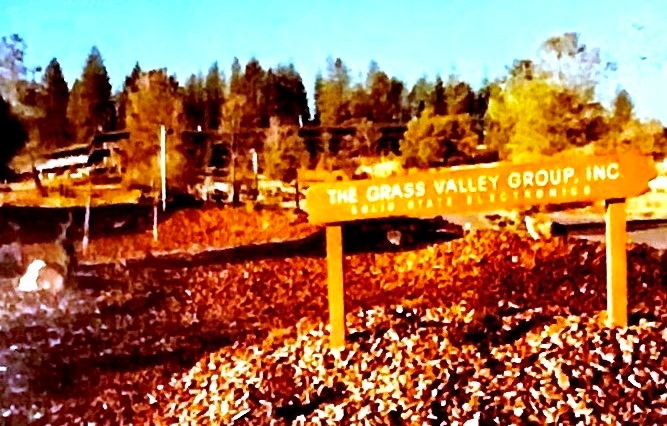
The group now had the money to landscape the Bitney Springs property. Joe Ruess, an area landscaper, and nursery owner was given the task. He naturalized Iris and Daffodils. In the coming years, the entrance to the plant became known as Daffodil Hill every spring by the employees. The company also planted a garden every spring with corn, green onions, carrots, tomatoes, peppers, and summer squash. They also planted peach, apple, apricot, and Black Mission fig trees. The fig being Hare's favorite. There were grape vines that bordered the plot, possibly because of Hare's childhood recollection of his father's vineyards.
Hare hated to see any life-form die, from insects, mice, to the many rattlesnakes that called the property home. He never wanted to personally see any die. Even though he once lost a dog to a snakebite. If there was a rodent or bug problem, it was expected to be taken care of out of his sight.
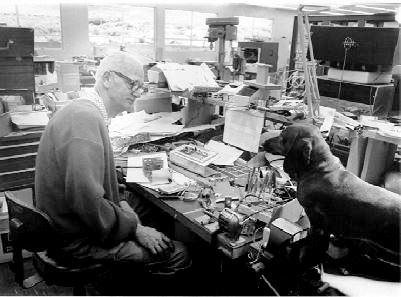
The Bitney Springs site always faced a fire danger. Dr. Hare once said that if there was ever a fire that came through and took out the trees that he would have to move as he would not be able to stand the desolation. Much of the property had Manzanita on it. If ignited it burns very hot and is difficult to extinguish. They kept a gasoline powered pump with attached water hose at the lake near the main building. GV's maintenance crew spent part of their daily schedule clearing fire lanes and breaks through the brush to minimize the spread of fire if it should erupt. They even created another pond to increase the amount of water available to fight a fire.
Most of California, the Sierra foothills included, have a Mediterranean climate where the winters are wet, and the summers are dry. Most of the rain happens in the winter, and often an entire summer will see no rain. The rain that does occur in the summer is usually due to thunderstorms, with the accompanying lightning and the resulting fire hazard. The state's nickname, the "Golden State" came as much from the dead grass covering the hills in the summer, and the golden poppies that rise in the spring, as to the discovery of gold in 1849. That said, there is a closed mine on the Britney Springs property.
By 1966 the Group had grown substantially. Sales doubled over the year before, and net profit increased fivefold, and the company's net worth tripled. Many television facilities would historically build their entire facility with all RCA equipment, as that company made most of the technical equipment that a broadcaster would need, from cameras, all the way through the food chain to transmitters, and even the antennas that were mounted at the top of the tower. By-the-way, those antennas where not like the ones that dotted most roof tops back then, but monsters that could weigh 10 to 15 tons. That was because of the mass of metal that was required to handle the massive RF power emitted by them. The mass was needed not so much for the RF, but the heat that was part of the byproduct of radiating the signal out towards the horizon.
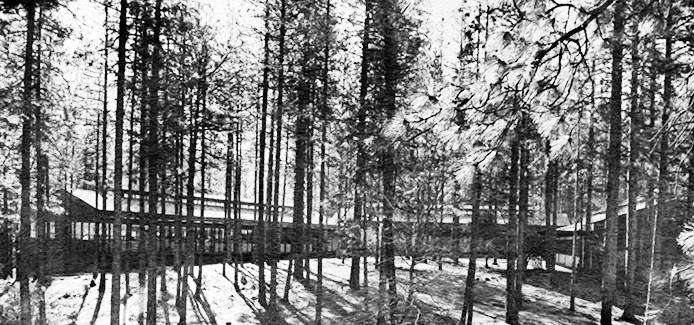
Building 3 - Carefully nested among the trees
Hare resided here
Now more television stations were specifying GV gear sprinkled in with the RCA, GE, and other large vendors when equipping a station. The volume of product being sold and produced had increased to a point where the Group needed to consider building a second building. Since Hare did not want to take trees out of the current property, he put an option on an adjacent property that was an open field once used for cattle grazing. By the end of the year the Group owned that property and promptly set up to create a building identical to the first, mainly to save time as orders were increasing and lead times were getting longer.
Business grew enough that Hare did not want to accept government sales, especially when the State Department wanted to order more telephone gear that the Group had provided when times were much tougher for the company. They now had far more lucrative items to produce. It was not that the Group would not take an order for equipment from government agencies, if it was a standard off-the-shelf product, with standard off-the-shelf options, then it would be accepted.
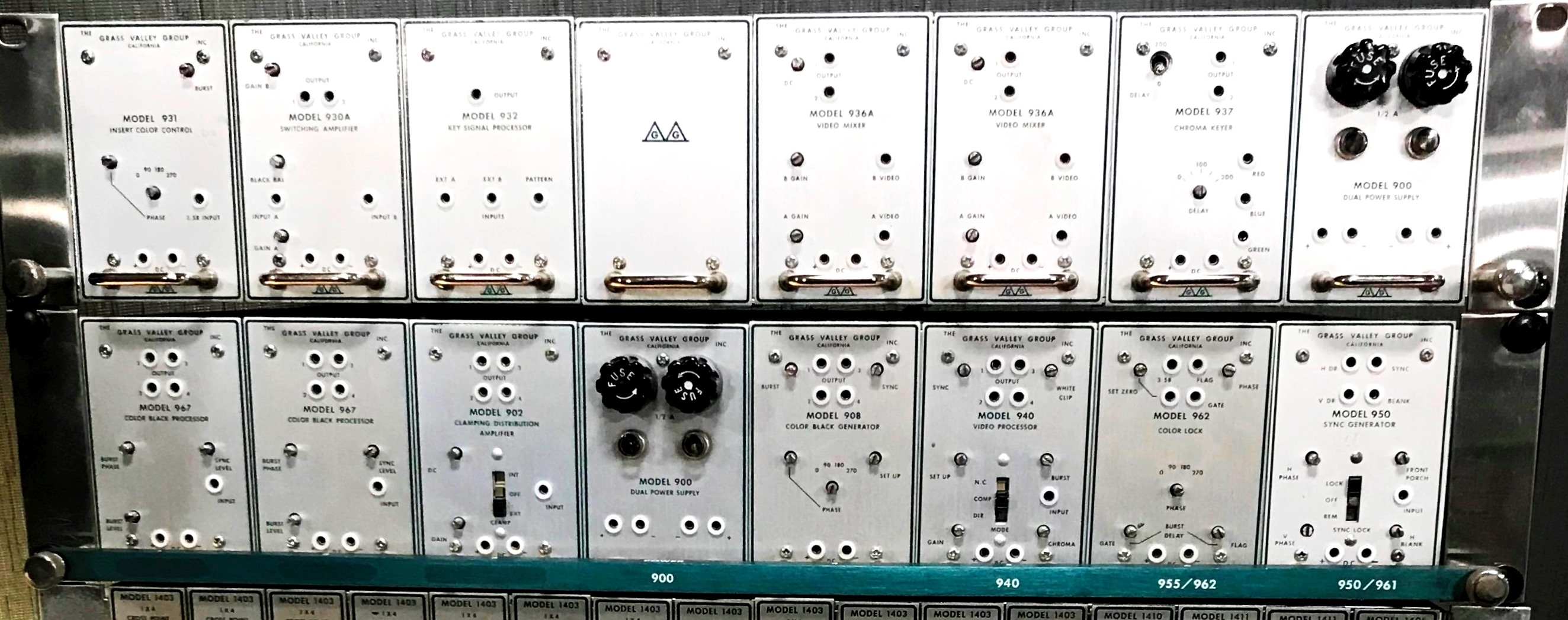
900 Modules - not much to look at, but they led to big things
These modules (eight in a frame) can be thought of as building blocks. Either to process video in various ways in a television facility, or as we will see shortly blocks to make a product that would define the Group.
Also, in 1966 the model 700 DA was redesigned and became the model 900. The 900 became a staple in broadcasters equipment racks for the next 20 years. With increased success the Group showed up at NAB in 1967 in a professionally designed, albeit modest, display booth. Orders were strong enough that Hare was worried that the Group might have trouble filling the coming orders in a reasonable amount of time. To anticipate the fulfillment requirements from sales, a production manager was hired for the first time. Also, for the second time in a year the circuit board assembly or "stuffing" department was increased.
The group was now to a point where they could afford to purchase real video monitors from the industry standard at the time, Conrac, instead of buying consumer TV sets and modifying them to work as video monitors, a process known as "jeeping." But the company still had no sales department, even though the company was making a 21% net profit after taxes at that point.
In 1967 Hare decided he wanted to take the company public to increase the capital available for growth, but to also lower the tax rate the company was occurring because of retained earnings. More capital would allow for more retained earnings. It would allow for easier recruiting of engineering talent as the company could now offer stock options. It was also at that point, mainly for appearances, that an affiliated sales company was formed with Si Krinsky as its president, with him getting 20% of the sales company stock. Krinsky was a manufactures rep, who represented a number of similar companies as their salesman. Since he already knew GV and could sell its products, although he was initially reluctant, he was eventually convinced to concentrate on one company, Grass Valley.
1967 was a banner year with sales and net profit up 47% and 66% over 1966. Sales came in at $1.365 million, the first year they broke the million mark. The company went public at $10/share. It allowed the company to offer stock options to attract engineering and management talent for future growth. It would also make it easier for the growing company to acquire other companies.
Moving up the food chain: Video Production Switchers
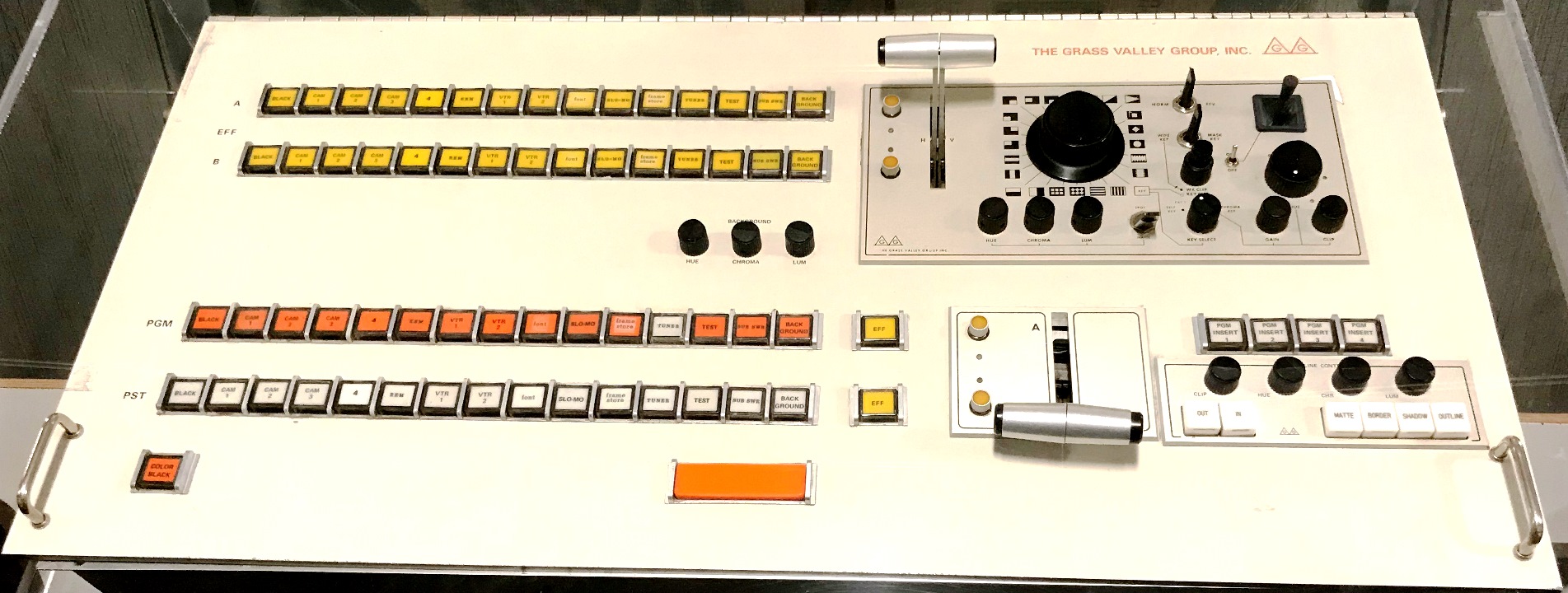
Control Panel
for Grass Valley's
First Video Switcher
1400
In December of 1966 Hare went to Palo Alto and hired three engineers: Robert Cobler, Jerry Sakai, and Bill Barnaham. Cobler came to work from CBS, where he was in charge of putting together their first color studio. "I was offered a job at The Group mostly because I was the only guy familiar with some of the equipment they wanted to manufacture," Cobler said. The company he said, "was getting pressure from the sales company to make switchers, so that's what we did."
Switchers, or video switchers, or as the British say, "vision mixers" became huge for the company as we will see in the book. The Group became the dominant player in video production switchers introducing their first in 1968. These are devices that allow all the layers of graphics, effects, and a myriad of sources to be integrated into a complex mosaic of video. Oh yeah, this is all done in real time while the newscast, sporting event, or entertainment show is happening. Let us introduce this piece of gear that became so important and central to the company.
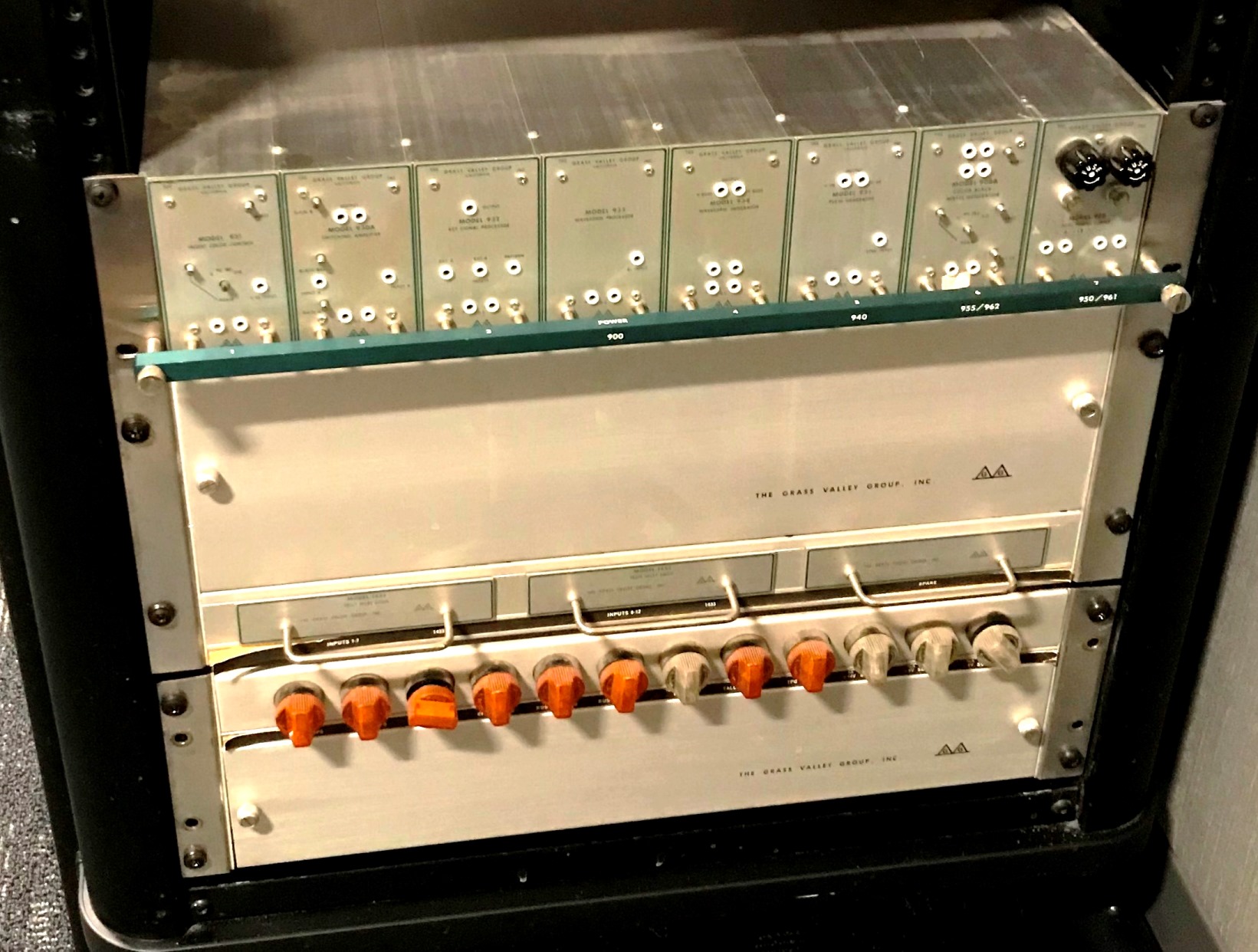
The actual 1400 electronics that the control panel controlled
As you can see those 900 modules came into play in creating the Groups first switcher.
A video production switcher has historically generally consisted of two components, an electronics chassis, or tub as it is sometimes called, that has most of the electronics, and a control panel, that since the 60s has looked like something that should be a prop in a space mission control scene. In fact by the mid 1970's the group had enough of the high-end video switcher market that one of the props used to destroy Princess Leia's home planet of "Alderaan" in the first Star Wars film, was a video
'fader bar'
on the next generation of Grass Valley switchers, the 1600 video production switcher, which was introduced in 1973.
The person who sits at the control panel is usually called the "technical director," or TD for short. The reason for the title, was at the dawn of television, equipment was unstable, and the FCC had many rules as to what could be aired, not only content wise, but technically also. This was because the electronics in the TV receivers of the day did not have a lot of processing power and it did not take much wrong with the signal before sets would not work well, and viewers would complain to the FCC. So the TD was the final arbiter as to what went to air, and it was the switcher that selected what combination of video made up the final program montage. Today that is no longer so but the title lives on.
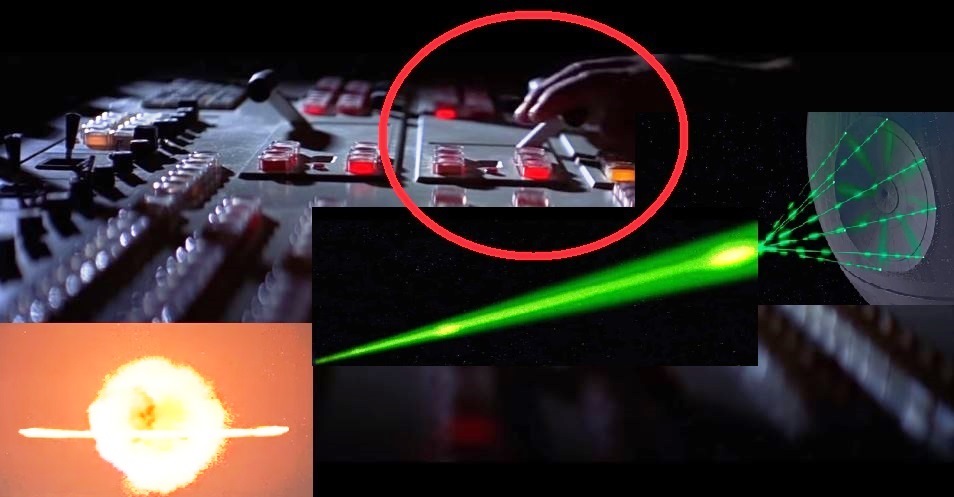
This is not to say that the person who sits there today is not skilled, they are and must be, but not with the technical expertise that TDs once had. Today switchers have grown so capable, and complicated that not all people are able to occupy that position, and not all are equal in skill set. It has been compared to flying a plane, or even playing the piano. Using the flying a plane correlation, most pilots can keep the wings level and do simple maneuvers. Only a few are any good at doing acrobatics. The same with the switchers. Many claim most users only use 25 percent of its capability. The virtuosos are in high demand.
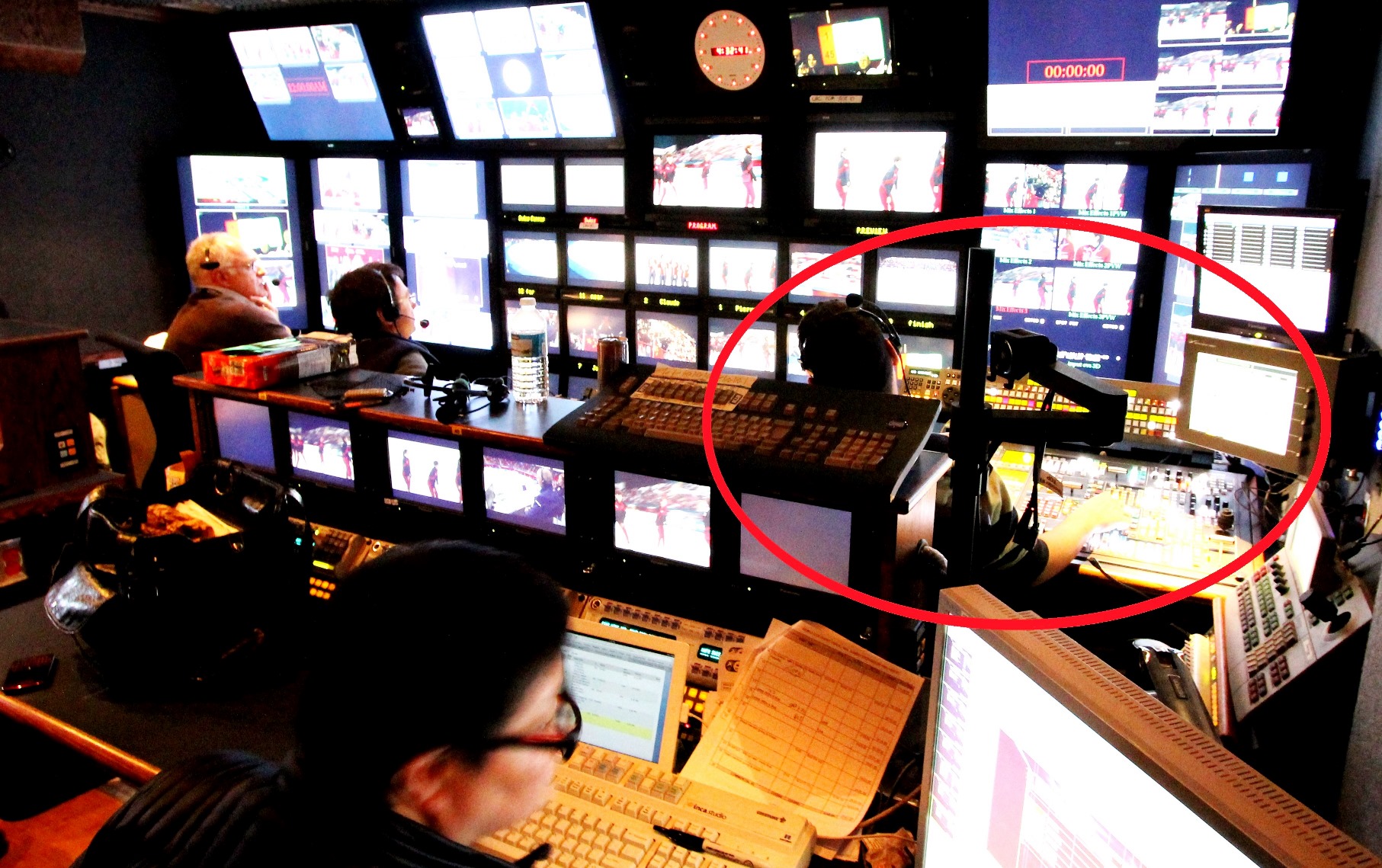
TD at the switcher control panel in a modern production truck
Person to his immediate left is the director, and then the producer
The layout of the control panel has always been rows of buttons, where each row seems to have the same labeled pushbuttons. But there is a method to all the madness as they are color coded in groups of two to four rows. The top group might be white, the next group of two to four might be yellow, then orange, etc. The bottom group is usually red. Each group allows for a set of layers and mosaics to be created. The elements put together in one set of rows can then all be layered on top another group and so on. So, the result can be quite complex. The whole control panel represents a trickle down effects factory where a TD might setup a split image in the top group, and then add a background in the second group, and then lay a banner graphic over everything in the third row.
The bottom line is that all the buttons allow the TD to make changes very quickly as a program or event unfolds and it allows them to see at a glance how the "freight train" so-to-speak is coming together. The TD does this under the direction of the shows director who calls out the effects and camera cuts and dissolves. The director is under the supervision of the producer who owns the vision and content of a show and helps guide the director to make that happen. The final result is that the integration of all the sources into layers of video, graphics, and other effects. All in real time.
The 1400 switcher was introduced at the 1968 NAB. By mid-year the company had received requests for quotes amounting to over a million dollars and had firm orders for five switchers. Switchers were not cheap devices that, depending on the options, could easily break $200,000. Over the year's switchers had shipped with price tags of over $500,000.
Grass Valley did not invent the switcher, they had formidable competition waiting. Of course there was RCA, along with other established vendors with names like CDL, and Vital. What made GV think they could compete, besides the fact that they had competed in other, albeit simpler areas. First, a lot of people in the industry wanted features that were not widely available yet, and GV had the audacity to think they could provide a more capable product where the desired features came standard. Also with the DAs and proc amp products that they already had, they realized that they had many of the internal electronic infrastructure required already covered.
But where they really made their mark was they thought they could make a superior control panel with a more ergonomically human interface. Which they did. The tactile feel of the individual buttons on the control panel had a more positive and smoother feel. Grass Valley patented a couple aspects of those new switchers, and soon TDs started referring to the Grass Valley look and feel of their control panels.
Cobler said the key was superb engineering. "Reliability was the factor," recalled Cobler, who stayed with the company 25 years. "Our switchers worked right out of the box. It was a plug-in, and you didn't even need a screwdriver." Switchers up until then were notorious for needing lots of setup before they were usable and did not work "out-of-the-box." Vital and RCA were notorious for switcher reliability. Switchers were vital, no pun intended, to the operation. While losing a camera would hurt the show, losing the switchers would shut it down. It was not uncommon for users of RCAs commonly used TS-40 switcher to refer to the prefix as "Tough Shit!"
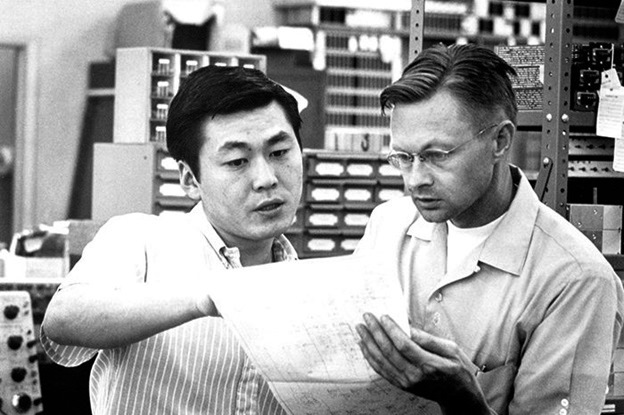
Jerry Sakai and Bill Rorden
Hare put Cobler in charge of engineering and design of the switcher product line. Jerry Sakai became the production manager and was tasked with fixing a production bottleneck with circuit boards that didn't pass test early on, but growth was such that three more buildings were added in 1969. The buildings on 120 acres placed amongst the trees looked more like a college campus than an industrial park. By 1970 half of sales were for video switchers. For a long while after that GV dominated the switcher market.
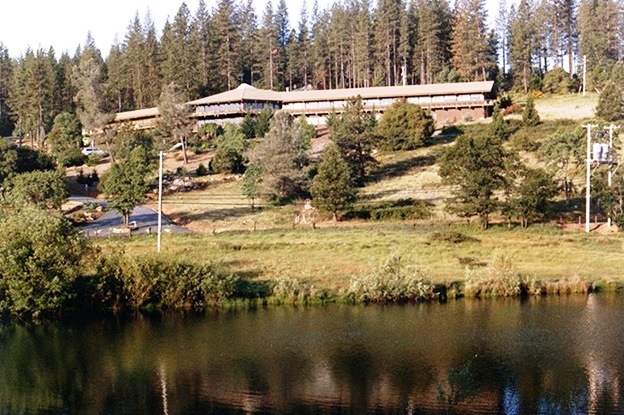
Building 4
GV simply kept adding refinements and features faster than anyone else could. New special effects were added, and a new integrated circuit was used in the video switchers mixing circuitry that eliminated the need for studio technicians to make periodic and tedious adjustments.
Growth did come with a setback in 1969. The small company, the "we're in this together" culture faded somewhat when the production and maintenance workers were organized by IBEW, and when they were unable to reach a wage agreement the workers went on strike in August. Replacement workers were hired, and production continued. After months of no agreement the union filed a claim with the NLRB that the company was not bargaining in good faith. The NLRB ruled against the union, and it eventually abandoned its efforts to obtain a collective bargaining agreement with the group. Hare never quite thought the same of the rank and file from then on.
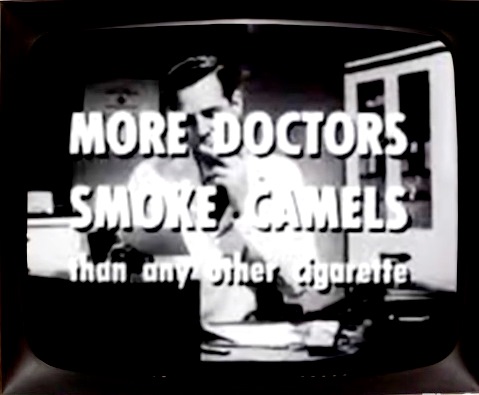
Financially on the map
On January 19th, 1970, the company's stock was listed on the American Stock exchange with the symbol GVG, as up until then it was an over the counter stock. The rest of the year was not that positive for the company as besides a sluggish economy and concerns in the television industry about what the approaching January 1st, 1971, ban on cigarette smoking might do to ad revenue, the industry was cautious in investing in capital equipment. While the group still made a profit, it was not what the previous year's was.
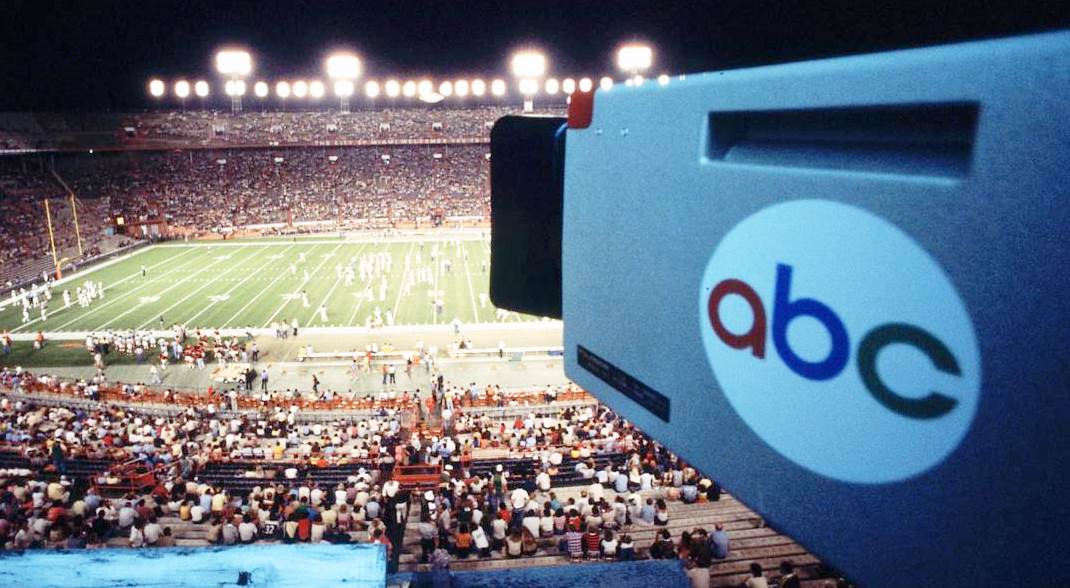
"ABC liked everything about our switchers," quoting Jerry Sakai, "but they were a little nervous about this little company we had out in the boondocks." But none-the-less ABC continued to be a major customer of the Group, and in ways looked to the company as their engineering lab. While NBC obviously had RCA, and CBS had there renowned CBS Labs, ABC had a small research and engineering group that paled in comparison to the other two. And as we have seen earlier ABC was as innovative as anyone.
In 1970 Roone Arledge struck again with something thought foolish at first. Although CBS had done a few Monday night NFL games, as had NBC, with a few Monday Night AFL games, neither network was interested in regular MNF. Rozelle approached ABC, which was also reluctant, but he threatened to sign with Hughes Sports Network. ABC, fearing that its weak Monday night lineup would prompt many ABC affiliates to carry the game, agreed to air them. The stroke of genius as we discussed earlier, was that Arledge turned it into a spectacle with drama, story, and new strange announcing format, which became a must see event.
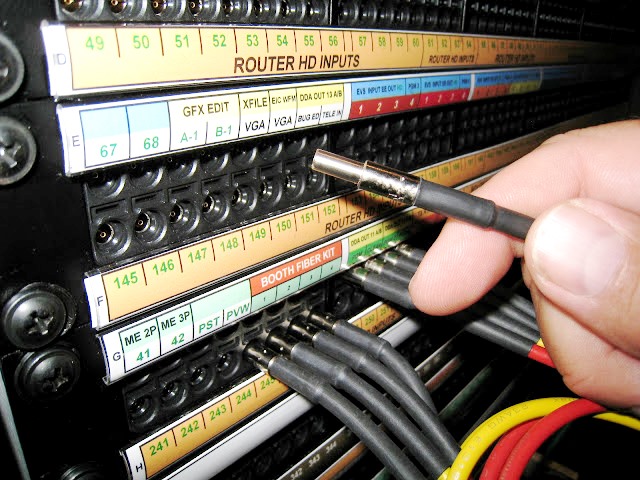
Patch panel
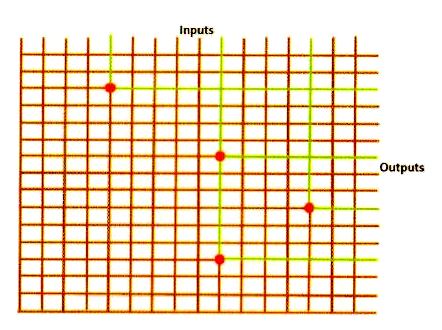 Later in the 70s, but indicative of ABC and Grass Valley mutual symbiosis, Jules Barnathan, VP of Engineering of ABC, another visionary as we mentioned earlier, had an idea for a new product and talked extensively with Rorden and then traveled out to meet with him and Hare. His idea was what is known as a video/audio routing switcher. He wanted something that would allow as many as 60 output video and audio feeds to select any of 100 video and audio inputs. Up until that time if you wanted to do that it was done with manual patching like you see in old phone operator stations. To do that required 6,000 electronic switches, or crosspoints as they are called, for video and another 6,000 for audio. It occupied eight full sized equipment racks. It cost $525,000. It was the first of its kind. It did not come from CBS Labs, or RCA, it came by taking an idea from ABC and making it a reality in Grass Valley.
Later in the 70s, but indicative of ABC and Grass Valley mutual symbiosis, Jules Barnathan, VP of Engineering of ABC, another visionary as we mentioned earlier, had an idea for a new product and talked extensively with Rorden and then traveled out to meet with him and Hare. His idea was what is known as a video/audio routing switcher. He wanted something that would allow as many as 60 output video and audio feeds to select any of 100 video and audio inputs. Up until that time if you wanted to do that it was done with manual patching like you see in old phone operator stations. To do that required 6,000 electronic switches, or crosspoints as they are called, for video and another 6,000 for audio. It occupied eight full sized equipment racks. It cost $525,000. It was the first of its kind. It did not come from CBS Labs, or RCA, it came by taking an idea from ABC and making it a reality in Grass Valley.
As the 70s started GV made its first presence at the International Television Symposium in Montreux, Switzerland. That is NAB for the world. In 1971 Sales offices were opened in six major cities, and in 1972 the company reached $4,658,000 in sales. The milestone then was that no one customer contributed more than 5% to sales, and this was the first year the group paid a dividend to stockholders. In 1973 GV introduced its second generation of switcher, the 1600 at NAB. The electronic architecture was totally new, and the switcher was an order of magnitude more capable than the 1400. This new offering also refined the control panel interface that had won over so many TDs. As we will see in the book, it was the control panel, and human nature that made GV switchers so entrenched. In 1972 sales were $4.7 million, with earnings of $1.066 million, and total employment was 130. Outside suitors took note.
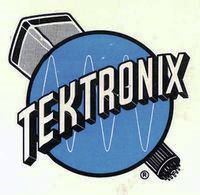
Tektronix
Company logo in 1973
1973 marked the first ownership change of many to come for the company. This first marriage was to Tektronix. Under the merger plan ironed out, approximately one share of Techtronic stock was issued for every three shares of Grass Valley Group. This involved approximately 500,000 Tektronix shares. Culture, direction, and inertia were about to change.
Under things to come, the following
switcher
dam near killed the company!
1984 Promotion company video
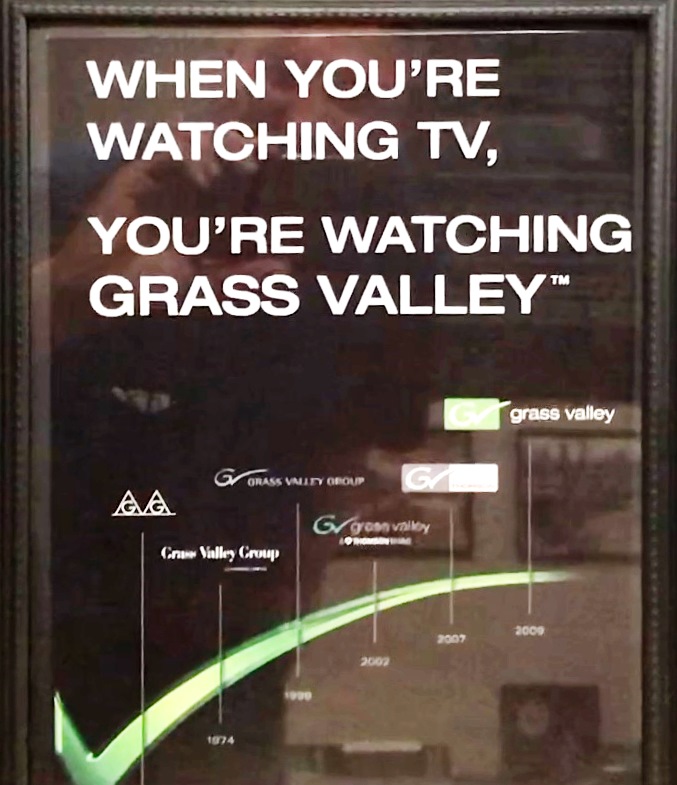
Still true to this day!

![]()



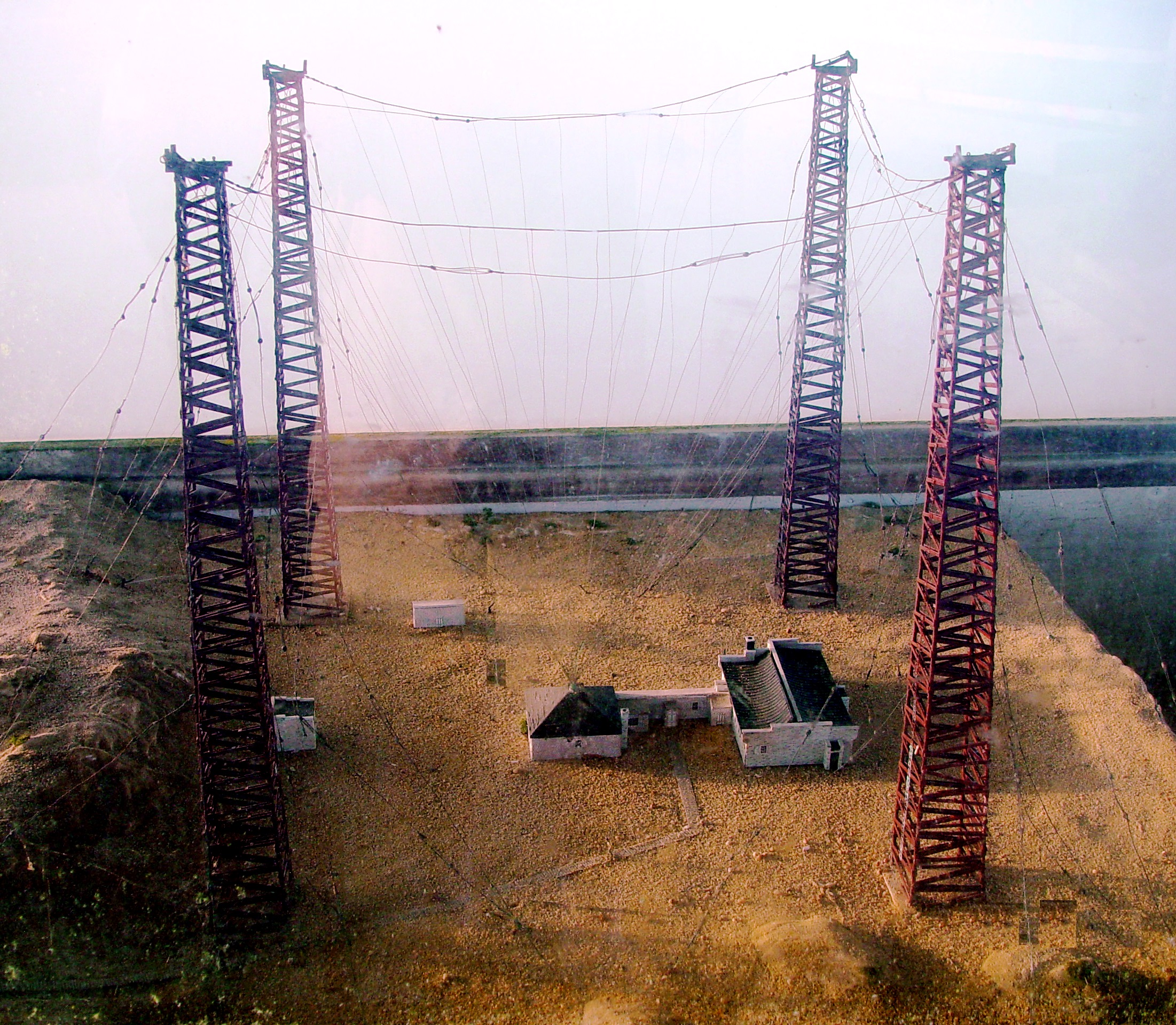







 Early RCA Radio Broadcasting Receiver
AKA: "Music Box"
Early RCA Radio Broadcasting Receiver
AKA: "Music Box" In July of 1926 AT&T and RCA signed an agreement in which, for one million dollars, the Bell system turned over its radio facilities (including station WEAF in NYC) to RCA and withdrew from broadcasting. It also gave up its rights to manufacture receiving sets to RCA. In return RCA agreed to use the Bell wires exclusively and not compete with the telephone company for telephone business.
In July of 1926 AT&T and RCA signed an agreement in which, for one million dollars, the Bell system turned over its radio facilities (including station WEAF in NYC) to RCA and withdrew from broadcasting. It also gave up its rights to manufacture receiving sets to RCA. In return RCA agreed to use the Bell wires exclusively and not compete with the telephone company for telephone business.









 Armstrong served in the Signal Corps during World War I, initially commissioned as a captain and left as a major. During both world wars, Armstrong gave the US military free use of his patents. In 1934, he received an appointment as a Professor of Electrical Engineering at Columbia, a position he would hold the remainder of his life.
Armstrong served in the Signal Corps during World War I, initially commissioned as a captain and left as a major. During both world wars, Armstrong gave the US military free use of his patents. In 1934, he received an appointment as a Professor of Electrical Engineering at Columbia, a position he would hold the remainder of his life.



 Radio on the beach! The radio was a wedding gift to him and his wife Marion. Many radios ran on batteries back then, a bank of batteries. The term B+ for the main voltage found in electronic gear came from battery voltage before internal power supplies took over.
Radio on the beach! The radio was a wedding gift to him and his wife Marion. Many radios ran on batteries back then, a bank of batteries. The term B+ for the main voltage found in electronic gear came from battery voltage before internal power supplies took over.


 In 1946, WEAF changed its call sign to WNBC and became the flagship station of the NBC Red network (more on that in a bit). This station is now known as WFAN (AM) as GE, which bought RCA and NBC sold off its radio operations in 1988. WFAN which already existed took over WNBC's frequency (660 KHz) and vacated its old one.
In 1946, WEAF changed its call sign to WNBC and became the flagship station of the NBC Red network (more on that in a bit). This station is now known as WFAN (AM) as GE, which bought RCA and NBC sold off its radio operations in 1988. WFAN which already existed took over WNBC's frequency (660 KHz) and vacated its old one.
 Soon NBC formally divided its programming into two networks, called the Red and the Blue. On January 1, 1927, they went into separate operations. WEAF originated the Red Networks programming, while WJZ originated Blue's. It is claimed that the two networks got their names from the color of the patches used by AT&T long lines to route the programming out to the network.
Soon NBC formally divided its programming into two networks, called the Red and the Blue. On January 1, 1927, they went into separate operations. WEAF originated the Red Networks programming, while WJZ originated Blue's. It is claimed that the two networks got their names from the color of the patches used by AT&T long lines to route the programming out to the network.





 CBS started on January 27, 1927, as the United Independent Broadcasters network. It was started in Chicago by New York City talent agent Arthur Judson. Three months later the Columbia Phonograph Company, manufacturers of Columbia Records, invested in it. The network's name became the Columbia Phonographic Broadcasting System. The network's original flagship station was WOR in Newark. The network had 15 affiliates. The network lost money, especially because of the high rates AT&T charge to use its landlines. By the end of 1927, Columbia Phonograph wanted out.
CBS started on January 27, 1927, as the United Independent Broadcasters network. It was started in Chicago by New York City talent agent Arthur Judson. Three months later the Columbia Phonograph Company, manufacturers of Columbia Records, invested in it. The network's name became the Columbia Phonographic Broadcasting System. The network's original flagship station was WOR in Newark. The network had 15 affiliates. The network lost money, especially because of the high rates AT&T charge to use its landlines. By the end of 1927, Columbia Phonograph wanted out.















 Farnsworth excelled in science in high school. In high school he started contemplating a television system of his design and asked his science teacher for advice. One of the drawings that he did on a blackboard for his chemistry teacher was recalled and reproduced for a patent interference case between Farnsworth and RCA later.
Farnsworth excelled in science in high school. In high school he started contemplating a television system of his design and asked his science teacher for advice. One of the drawings that he did on a blackboard for his chemistry teacher was recalled and reproduced for a patent interference case between Farnsworth and RCA later.

















































































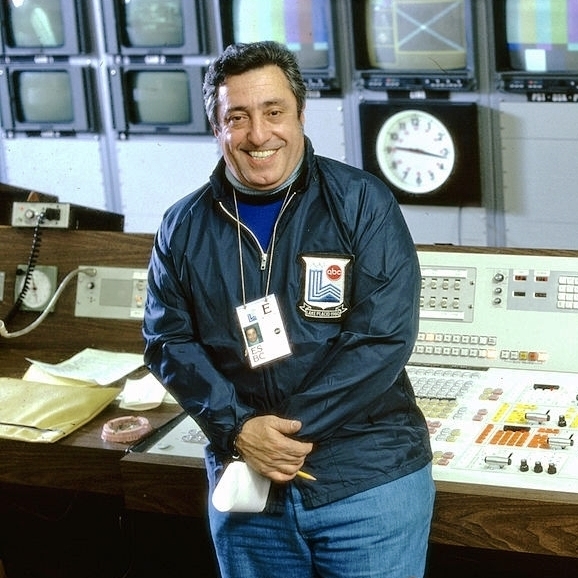





































.jpg)


















 None-the-less 1965 seemed to be a tipping point for color. At the start of the year there were just under 3,000,000 color TV sets in the U.S., which was almost double the number the year before. By the end of the year the number stood at 4,500,000. NBC claimed, as others agreed, that their color programming gave them a rating advantage. Many who had color TVs tended to view a show that was aired in color over one that was not. All but two shows on NBC were aired in color, one show used extensive black and white stock footage, and the other, "I Dream of Jeannie," had extensive special effects for the time that was considered too expensive to do in color. At the beginning of 1965 CBS had three programs per week in color, and ABC, was actually ahead with about eight programs a week. By the end of that year CBS surpassed ABC with 50% of their programming in color, to ABC's one-third.
None-the-less 1965 seemed to be a tipping point for color. At the start of the year there were just under 3,000,000 color TV sets in the U.S., which was almost double the number the year before. By the end of the year the number stood at 4,500,000. NBC claimed, as others agreed, that their color programming gave them a rating advantage. Many who had color TVs tended to view a show that was aired in color over one that was not. All but two shows on NBC were aired in color, one show used extensive black and white stock footage, and the other, "I Dream of Jeannie," had extensive special effects for the time that was considered too expensive to do in color. At the beginning of 1965 CBS had three programs per week in color, and ABC, was actually ahead with about eight programs a week. By the end of that year CBS surpassed ABC with 50% of their programming in color, to ABC's one-third.






































 The Ampex VR-1000 was the first of Ampex's line of 2 inch Quadruplex videotape recorders. Crosby Enterprises was Ampex's West Coast representative until 1957. Crosby became one of the richest men in the history of show business. He had investments in real estate, mines, oil wells, cattle ranches, racehorses, music publishing, baseball teams, and television. He made a fabulous fortune from the Minute Maid Orange Juice Corporation, in which he was a principal stockholder. He had come a long way in his life. While always a gifted singer, who could not read music, he squandered that talent early on with partying, drinking, and even an arrest. When William Paley, head of CBS first heard his voice he wanted the network to hire him. Network executives were reluctant, but at Paley's insistence they did. Crosby managed to cloister his shortcomings and demons for most of his life. He had more number one hits in his life than Elvis and the Beatles. For 15 years he was a top movie box office draw. In 1945 Life magazine declared that he had made more money than any entertainer in history. His passion for golf greatly swayed the trajectory of broadcasting for 20 years.
The Ampex VR-1000 was the first of Ampex's line of 2 inch Quadruplex videotape recorders. Crosby Enterprises was Ampex's West Coast representative until 1957. Crosby became one of the richest men in the history of show business. He had investments in real estate, mines, oil wells, cattle ranches, racehorses, music publishing, baseball teams, and television. He made a fabulous fortune from the Minute Maid Orange Juice Corporation, in which he was a principal stockholder. He had come a long way in his life. While always a gifted singer, who could not read music, he squandered that talent early on with partying, drinking, and even an arrest. When William Paley, head of CBS first heard his voice he wanted the network to hire him. Network executives were reluctant, but at Paley's insistence they did. Crosby managed to cloister his shortcomings and demons for most of his life. He had more number one hits in his life than Elvis and the Beatles. For 15 years he was a top movie box office draw. In 1945 Life magazine declared that he had made more money than any entertainer in history. His passion for golf greatly swayed the trajectory of broadcasting for 20 years.








 This was at a time when engineers still used slide rules. Forget about today's hardware description languages, or earlier Spice circuit simulation, or more ancient programable calculators, or any calculators. This was not even the dark ages of modern system design, nor even the iron, or bronze age. This was the tin age. While electronics had progressed, the tools to design, build, and test were rudimentary at best.
This was at a time when engineers still used slide rules. Forget about today's hardware description languages, or earlier Spice circuit simulation, or more ancient programable calculators, or any calculators. This was not even the dark ages of modern system design, nor even the iron, or bronze age. This was the tin age. While electronics had progressed, the tools to design, build, and test were rudimentary at best.














